Can Mine Train Roller Coasters Be High Intensity Parkitect
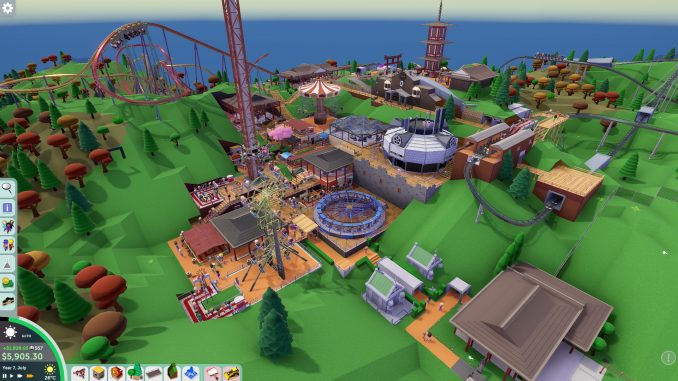
In this guide I have included diagrams of the various in-game menus, interfaces, build menus, etc. as well as some helpful tips and keyboard shortcuts (UI stands for User Interface (Menus, Information displayed on the screen, etc.)). If you only need information on one thing, feel free to use the guide index to the right (this guide has a lot of sections, so if the section you want is further down the index it may not be visible until you scroll down a bit). This guide is meant for people who are new to the game, but those who have been playing for a while may find some useful information as well. For example, did you know that if you hold left alt. while moving colours in colour palettes, the colour you moved will be copied, rather than swapped? If you have no idea what I was talking about in that last sentence, see the Brush tab section of this guide. If I have left any important information out, or something I have stated is incorrect, please let me know in the comments.
MAIN MENU
What you see when you start the game up.
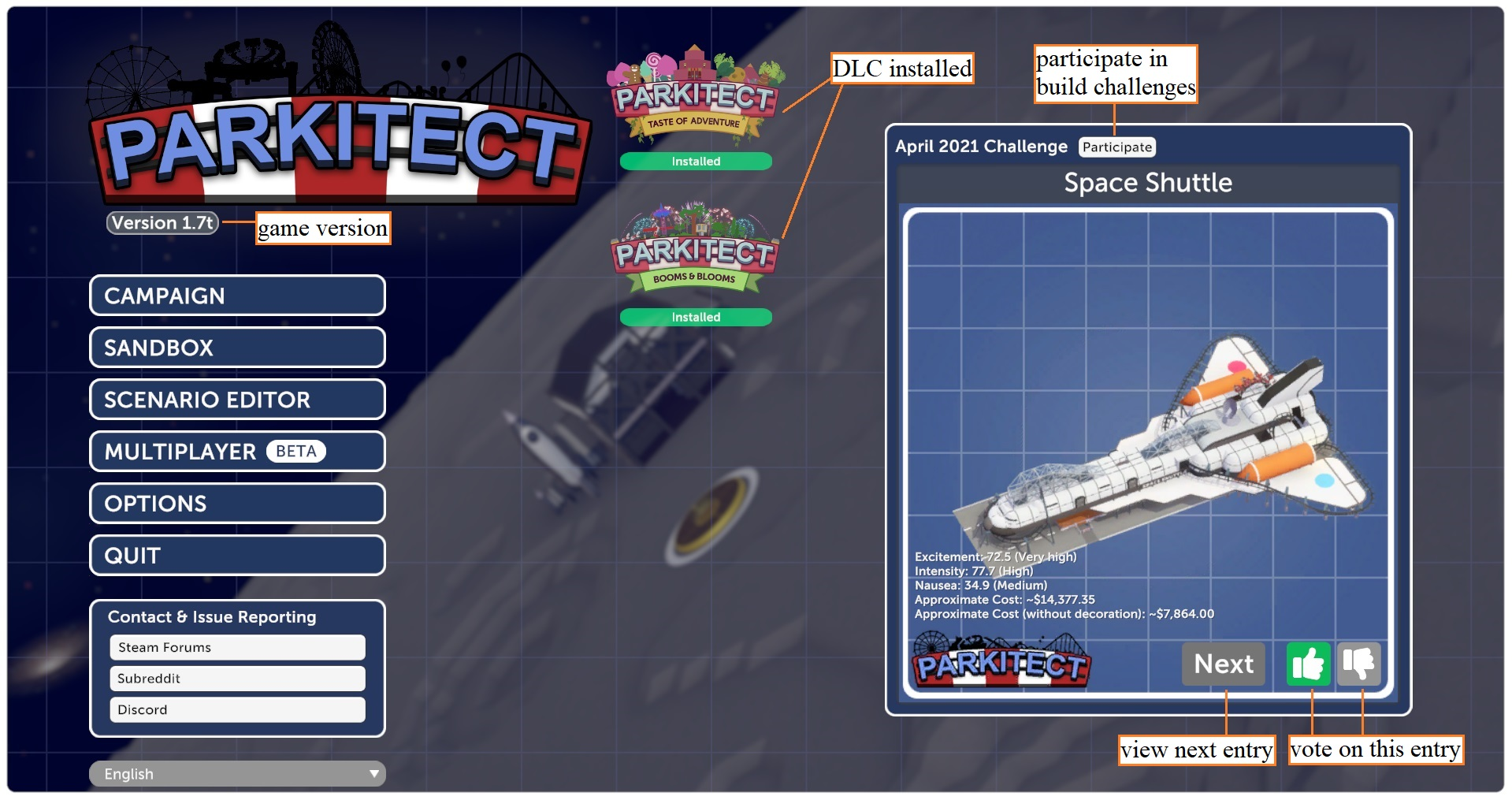
.
Campaign
Clicking 'CAMPAIGN' in the main menu will hide the main menu, revealing the campaign map. Each circle on the map is a scenario, which when completed, will reveal the next scenario (sort of like Super Mario Bros). Completing the optional goals in a scenario will turn its circle gold. The first scenario is the tutorial.
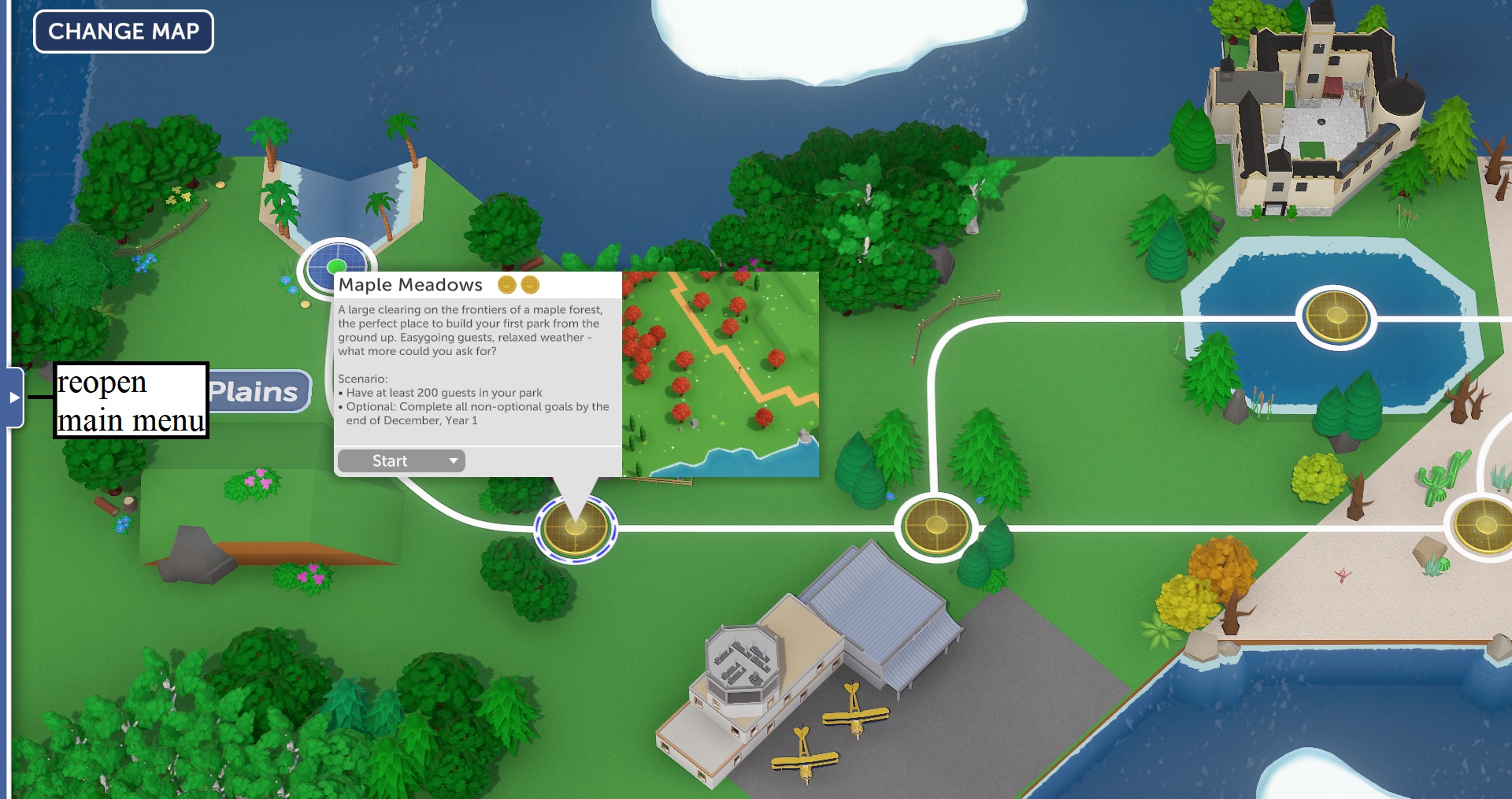
In the picture above, I have clicked on the scenario 'Maple Meadows'. Clicking that little down arrow to the right of where it says 'Start', brings up an option to start it in multiplayer. There will also be an option to resume one of your previous saves if there are any.
Once you complete a scenario, it becomes available to play in sandbox mode. You cannot use most mods in scenarios opened from this map. To use mods in these scenarios, you must open them in sandbox mode from the main menu, not by clicking on them on this map.
Clicking the 'CHANGE MAP' button at the top-left of the screen will take you to the Taste of Adventure scenario map (if you own the Taste of Adventure DLC).
Sandbox

Clicking on 'SANDBOX' in the main menu allows you to either start a new park or load one of your savegames.
________________________________________________________________
New Park
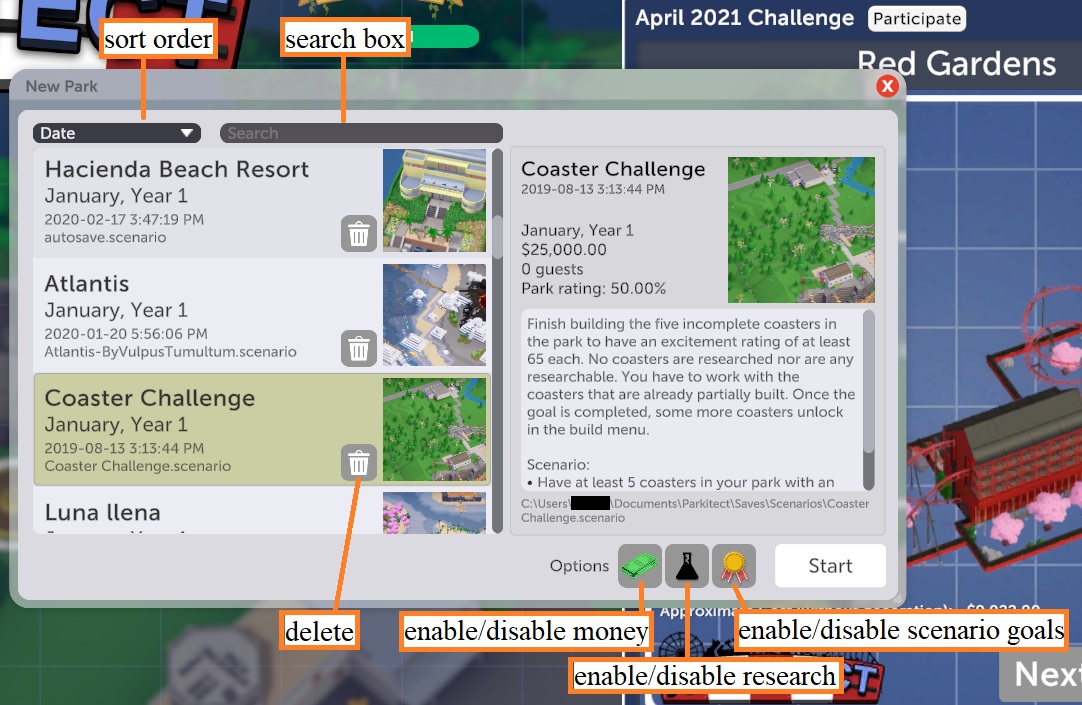
Clicking 'NEW PARK' brings up a window with all parks available to play in sandbox mode. Clicking on one brings up information about it including starting money, a short description, and the scenario goals (if it has goals).
Immediately to the left of the button that says 'Start' there are three buttons that allow you to enable/disable money, research, and scenario goals before playing (in the picture, research has been disabled, while money and goals are still enabled). Disable all three for a true sandbox experience.
Once a campaign scenario is completed, it will be available to play here. All parks started from here allow you to use mods if you wish.
________________________________________________________________
Load Park
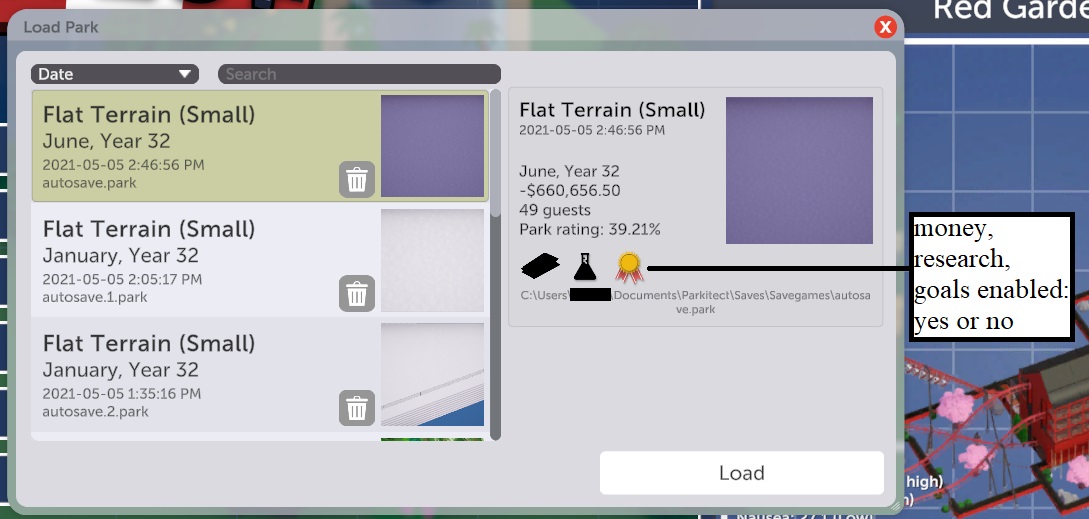
load one of your previous saves. Note the icons reminding you of whether or not you enabled money, research, or goals.
Scenario Editor

Gives you options to either edit a scenario (one you have made, one you downloaded, or a campaign scenario that you have completed), or create one. See the scenario editor section near the end of this guide for more information about the scenario editor.
Multiplayer

Click here to go to the multiplayer lobby.
________________________________________________________________
Join
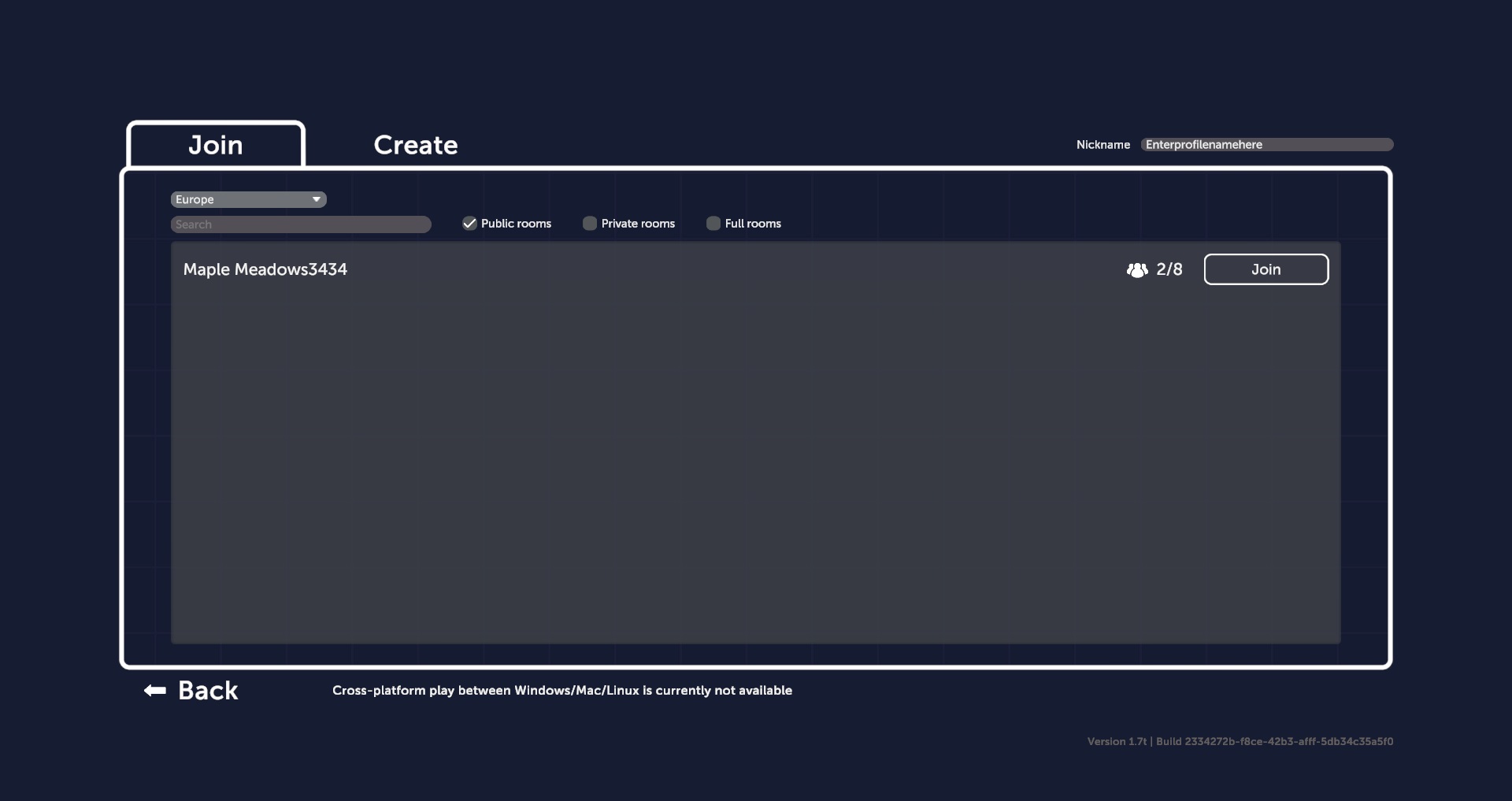
If there aren't any public rooms available, try creating your own, or change the region.
You can also tick boxes to show private and full rooms. I'm not sure how private rooms work because I didn't want to bug other users testing it out for this guide, but I think it means that the creator of the room can choose whether to allow others to join on a case-by-case basis.
________________________________________________________________
Create
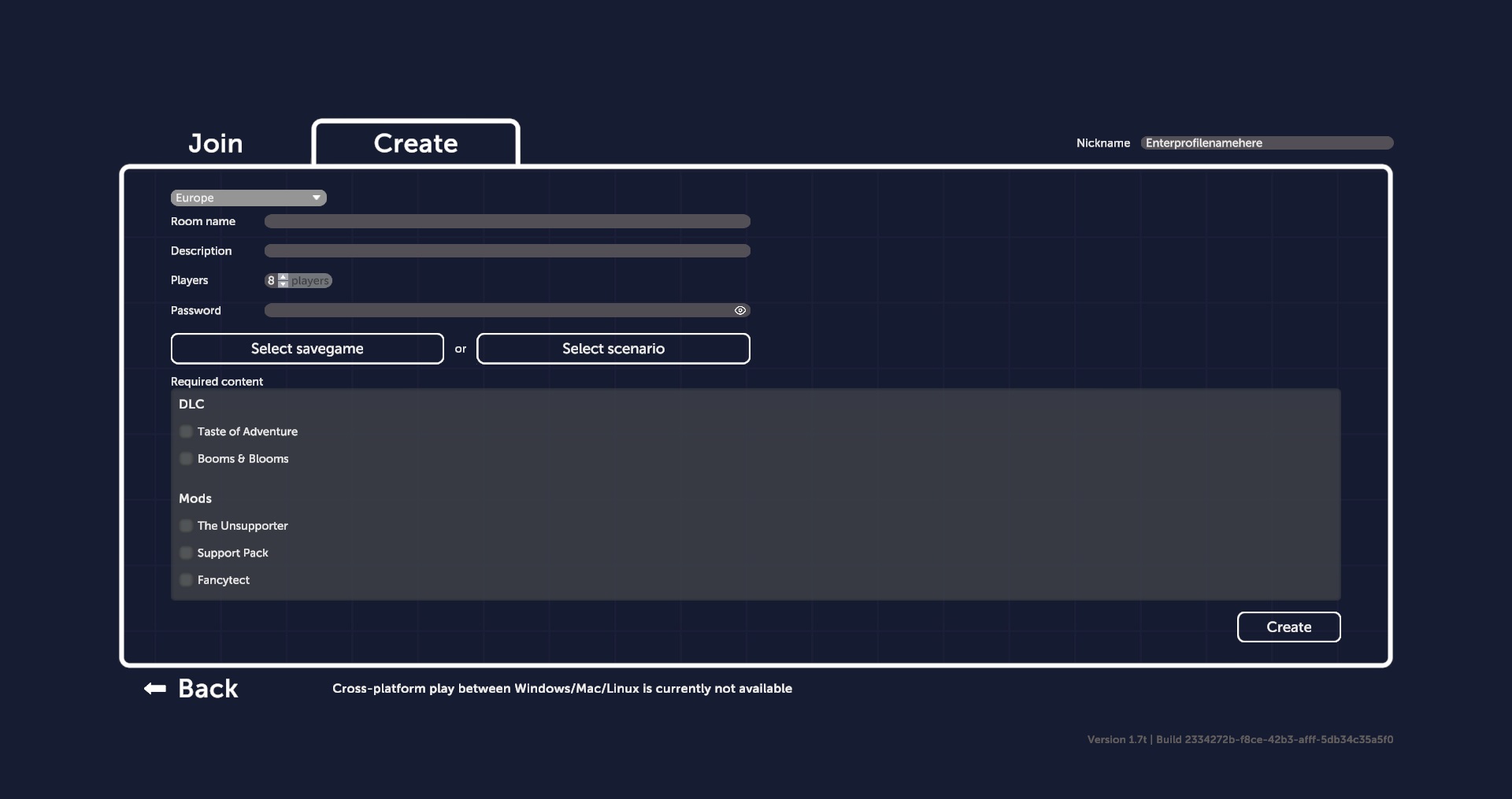
When creating a multiplayer room, from top to bottom the options are:
- set the region
- doesn't matter where you live, you can set it to any of the options
- for some reason most people set it to Europe or Asia
- enter a room name which will appear in the multiplayer lobby
- perhaps make it the name of the park being played
- enter a short description
- set the max number of players
- set a password (possibly for private rooms?)
- select one of your savegames or a scenario to play in
- set what DLC and mods will be available and required to play in your park
- any mods you have subscribed to on steam workshop will be available to select
Options

The game settings. See the 'Settings' section of this guide for more information.
Quit
Click 'Quit' in the main menu to exit the game.
Contact & Issue Reporting
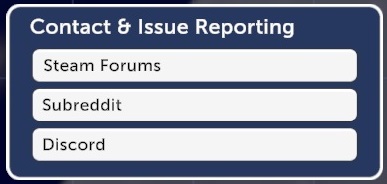
If you encounter a bug, error, or crash, feel free to use one of these options to report it to the developers. If a red error message window pops up in-game, its message will be copied to your clipboard, meaning that you can start a discussion thread in steam, right click in the text field, select 'paste', and then post the discussion for the developers to see all the information in the error message.
Language
![]()
Set the language the game uses. As of writing this the options are:
- English
- simplified Chinese
- traditional Chinese
- Korean
- German
- Spanish
- French
- Italian
- Dutch
- Portuguese – Brazil
- Russian
Build Challenges
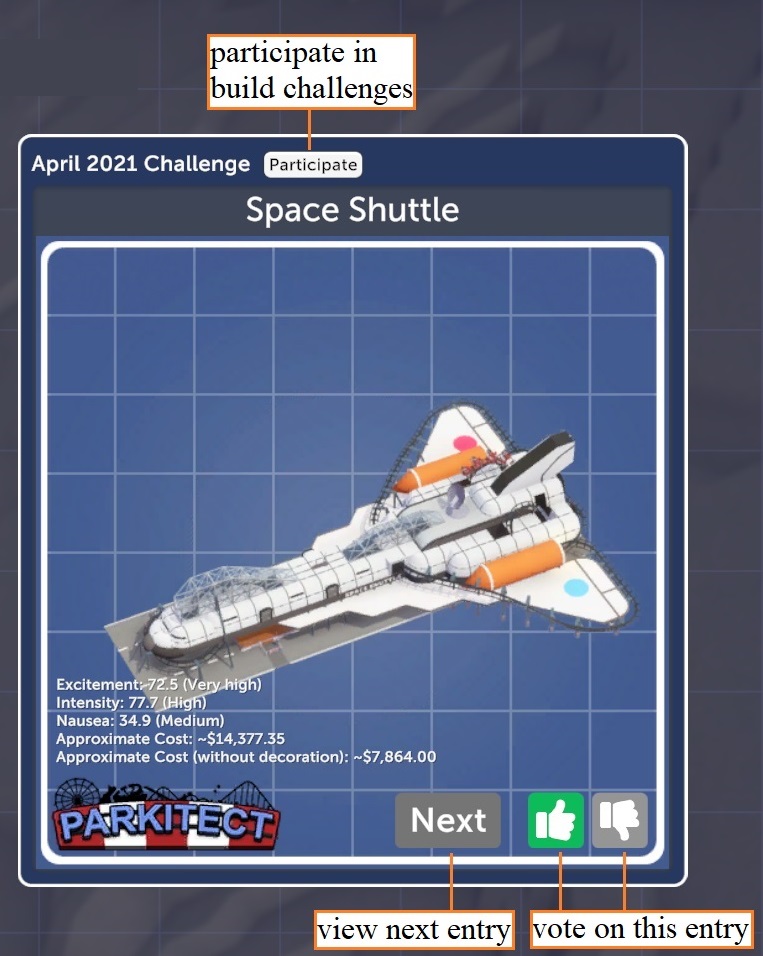
Every month there is a build challenge available here. The objective of the challenges is to build and decorate (a) certain ride(s) specified by the challenge within a limited space and with a limited budget. This window will show other people's entries for you to vote on, and at the conclusion of the challenge, the highest rated blueprints are included in the game (challenges usually conclude at the end of the month, but the devs can be a little tardy sometimes). You can also vote on entries from within steam workshop by up or down voting them.
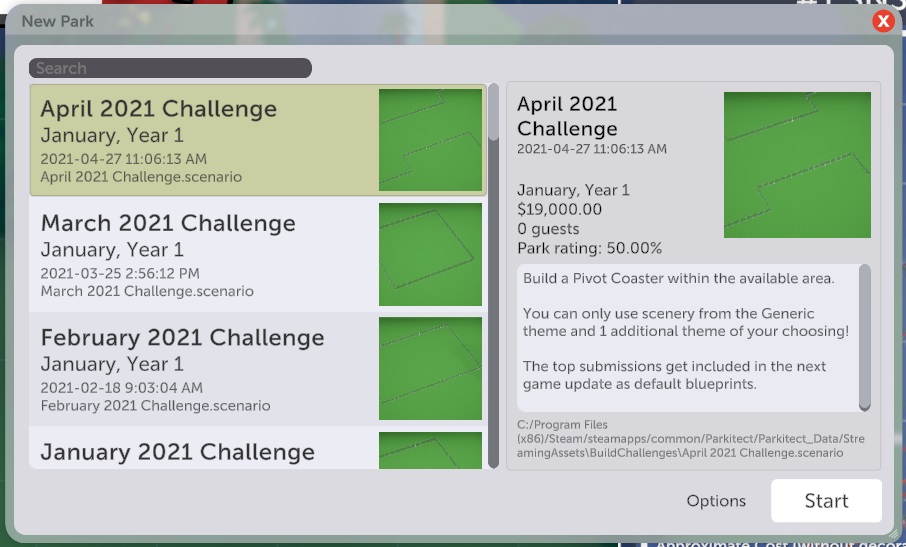
If you click on the 'participate' button, this window will come up. The option at the top of the list is the current challenge. You can open up challenges from previous months, but they have already concluded, and blueprints submitted from them cannot win.
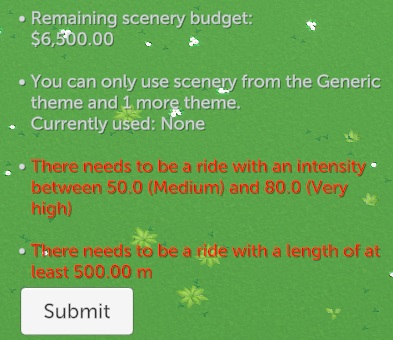
Within the build challenge, everything works the same as normal gameplay (which I will go into later in this guide).
There is usually a limited amount of money that can be spent on scenery in addition to the overall budget, and you are usually limited to using scenery from the generic theme and one additional theme of your choosing. There may also be other requirements, such as the ride needing to have an intensity between x and y for example.
Clicking the 'submit' button will save everything in the build challenge area as a blueprint and submit it to steam workshop for other people to see and vote on it.
PARK INFORMATION SUMMARY IN LOWER LEFT CORNER OF THE UI
This section is about the display in the lower left corner of the screen, which shows you some basic information about your park.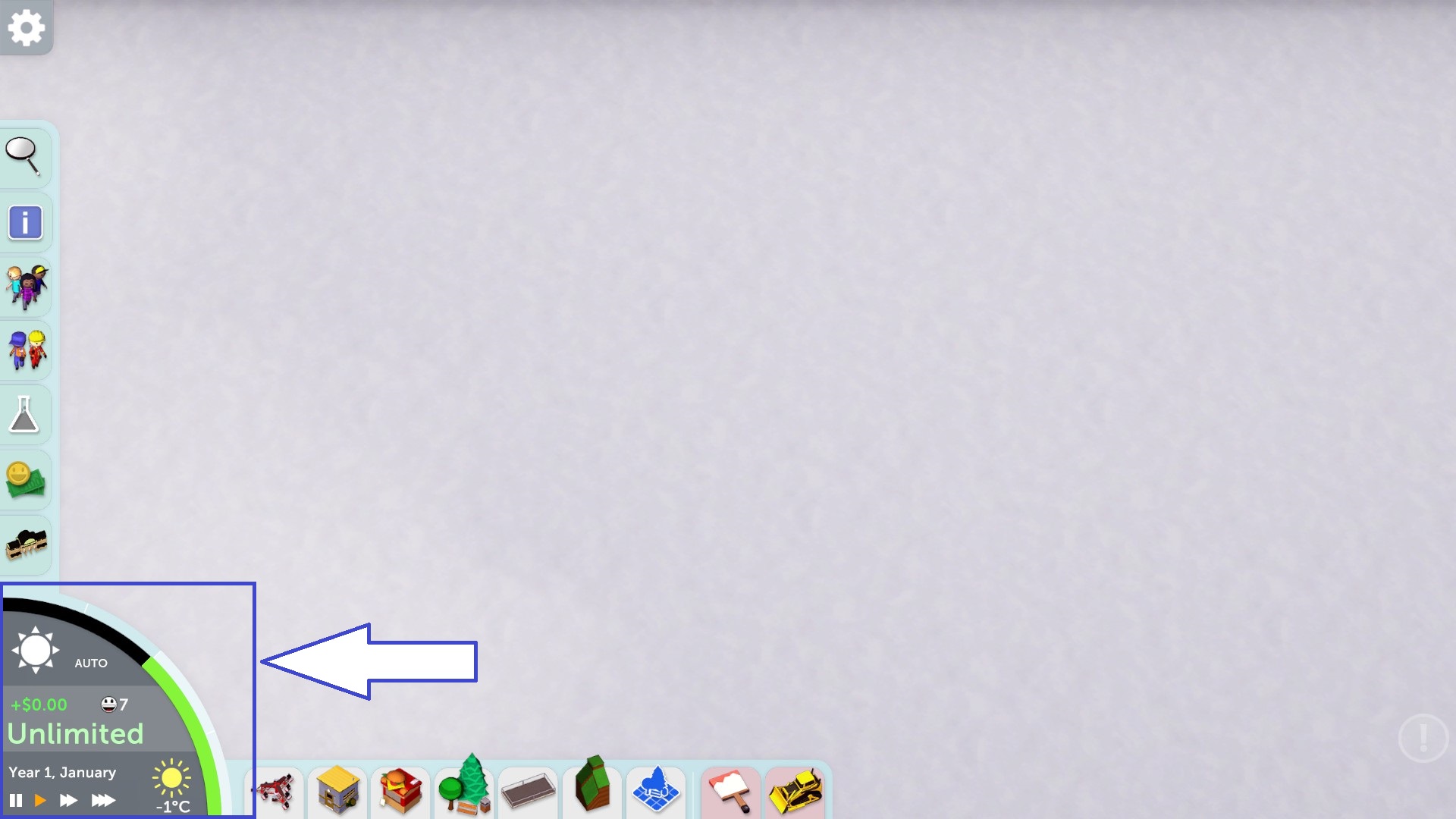
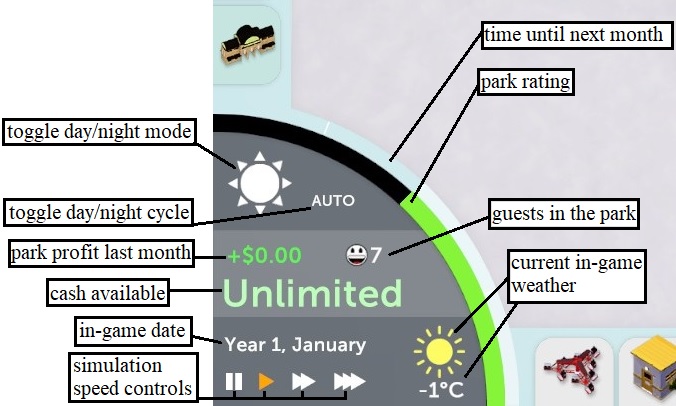
- click to toggle between night and day
toggle day/night cycle:
- click to toggle automatic day/night cycle
park profit last month:
- previous month's net income
- hover over it to show financial information available in the finance tab
- click on it to open the finance tab (see the finance tab section of this guide for more information)
cash available:
- how much money you have available to spend
- in sandbox parks with unlimited money (such as the one in the diagram) it simply says "unlimited"
- hover over it to show actual money amount in sandbox
in-game date:
- the in-game date
- pay attention to this when playing scenarios with timed objectives
simulation speed controls:
- click these to change the speed at which time passes in-game
- in the diagram it is set to play
- simulation speed can also be changed by pressing 0-3 on the keyboard
- 0=pause
- 1=play (normal speed)
- 2=fast forward
- 3=faster fast forward
time until next month:
- curved progress bar that shows time remaining until next in-game month
- hover to show real-life minutes and seconds remaining
- look closely and see it is divided into four parts
- park expenses are paid when the bar hits these dividing lines and at the end of the month
- this is useful to know when short on cash
- the in-game weather only changes at these lines
- park expenses are paid when the bar hits these dividing lines and at the end of the month
park rating:
- a curved bar indicating the park rating
- higher rating indicates that guests like your park
- hover for more detailed information
guests in the park:
- total number of guests in the park
current in game weather:
- weather influences guests in many ways
- some rides and shop products are more popular in hot weather, others in cold weather
- rides that are covered with roofs, located underground, or naturally offer rain protection because of their design will be more popular when it is raining
- rides without rain protection will be less popular when it is raining
- during thunderstorms rides with any parts exposed to rain will first stop admitting passengers, then stop operating once all passengers are off until the storm has passed
- temperature units can be changed in the settings
OPTIONS
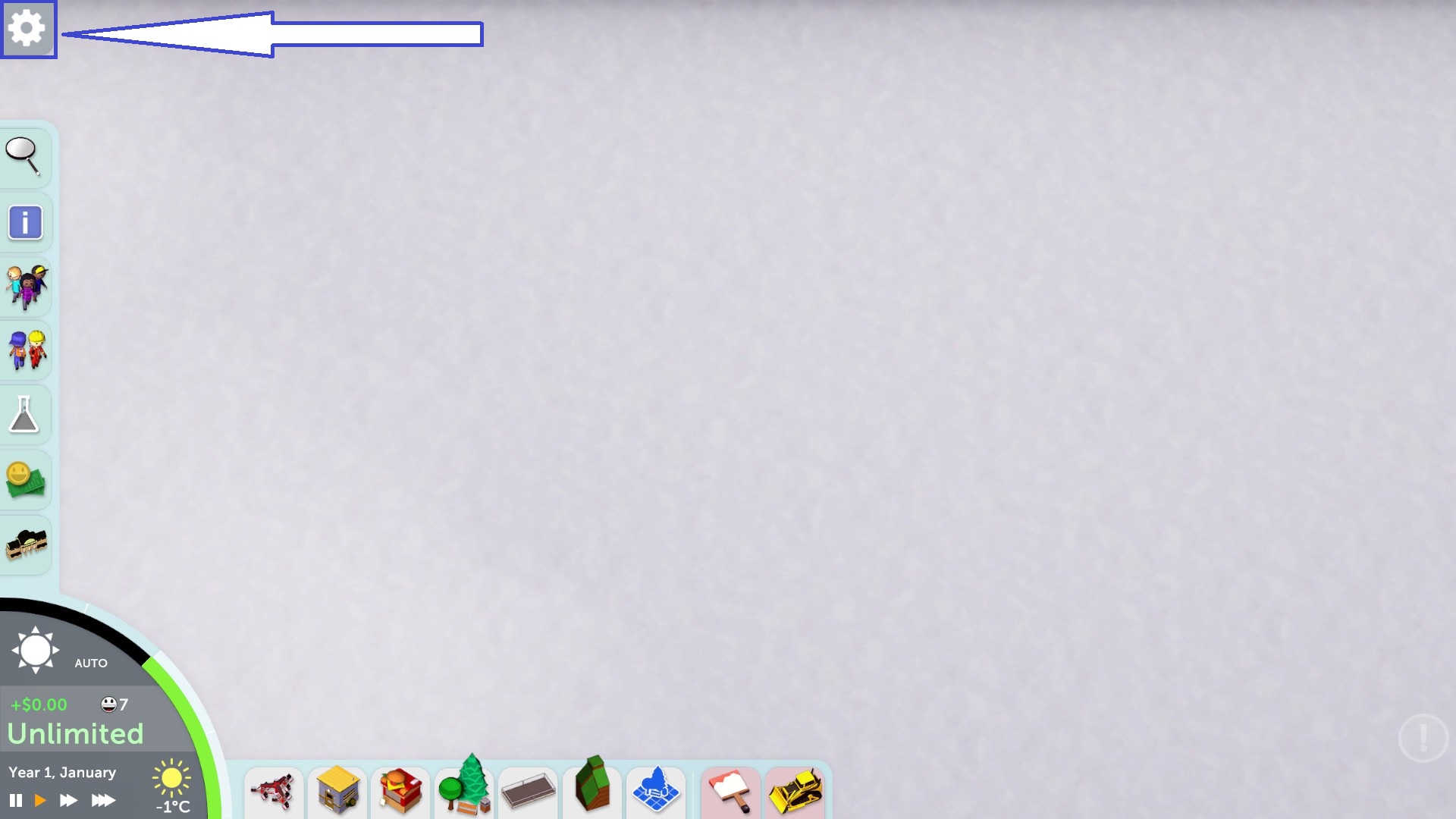
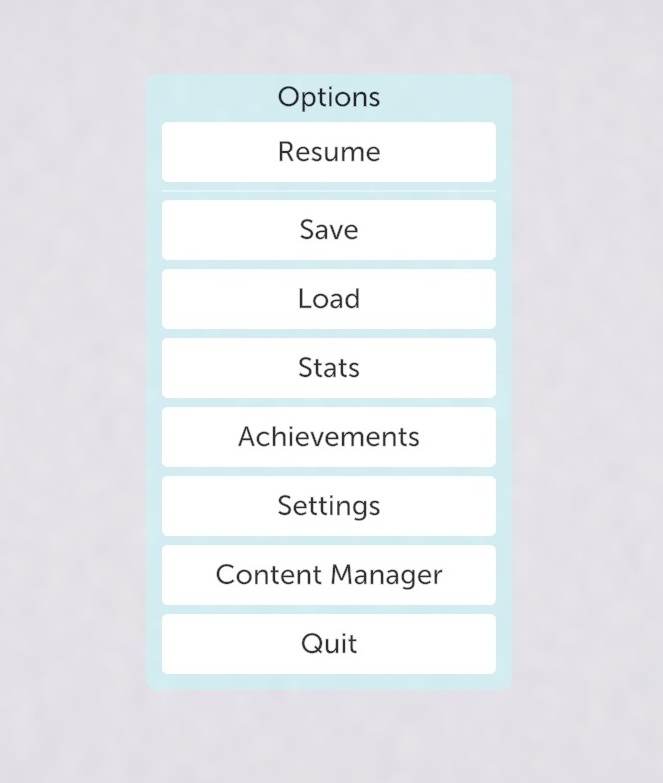
- closes the menu and resumes the game
Save:
- allows you to save the park you currently
have open
Load:
- allows you to load a previously-saved park
Stats:
- shows your various total statistics going back to when you first played the game
Achievements:
- shows steam achievements you have earned and your progress toward earning them
Settings:
- adjust various settings
- see the settings section of this guide for more information
Content Manager:
- allows you to manage your blueprints, savegames, etc.
- see the content manager section of this guide for more information
Quit:
- exits to the main menu
SETTINGS
General
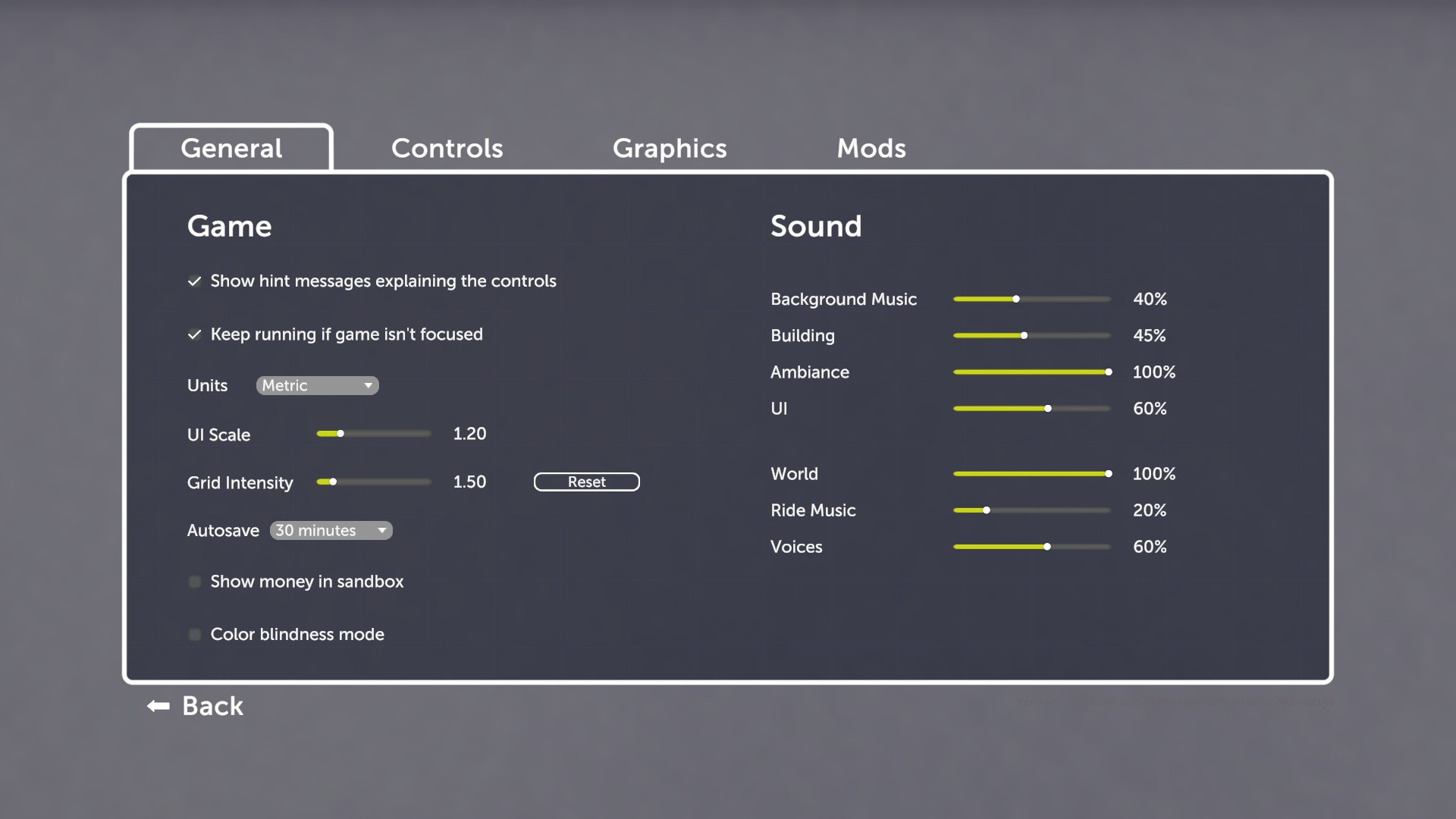
________________________________________________________________
Game Settings
- enables a box in the top-right corner of the screen that shows basic keyboard shortcuts while building
Keep running if game isn't focused
- the game won't pause if it is minimized or you are doing anything outside of the game (eg. using an internet browser)
Units
- allows you to change between metric (°C, m, etc.) and imperial (°F, ft., etc.) units
UI Scale
- slider to change the size of the UI
- this slider is sensitive, adjust carefully
- you may want to adjust it depending on what resolution you are using
Grid Intensity
- slider to adjust how subtle grid lines are when the grid is visible
Autosave
- change how frequently the game autosaves your park
- prevents loss of progress in the event of crashes or unexpected computer shutdowns
- autosaves can be loaded just like regular savegames
- new autosaves eventually overwrite old ones
Show money in sandbox
- will show how much money you have in sandbox parks with money restrictions disabled rather than showing "unlimited"
- with this option disabled you can still see how much money you have by hovering over the word "unlimited"
- you can still continue spending all you want if it is negative and you will never go bankrupt
Color blindness mode
- changes the colours used in the decoration visualizations so they are easier to differentiate for people with red/green colourblindness
________________________________________________________________
Sound Settings
- change the volume of music that plays when zoomed out, paused, or while custom building track rides and coasters
Building
- change the volume of sounds that play when placing things (deco objects, track segments, etc.)
Ambiance
- change the volume of ambiant sounds (thunder, rain, birds chirping, etc.)
UI
- change volume of sounds that play when clicking UI buttons
World
- change the volume of ride music, voices, and other sounds generated by park objects, rides, etc.
Ride Music
- change the volume of music that plays from rides when a music track is selected in a ride's UI
Voices
- change the volume of guest voices
- doesn't affect screams on coasters
Controls
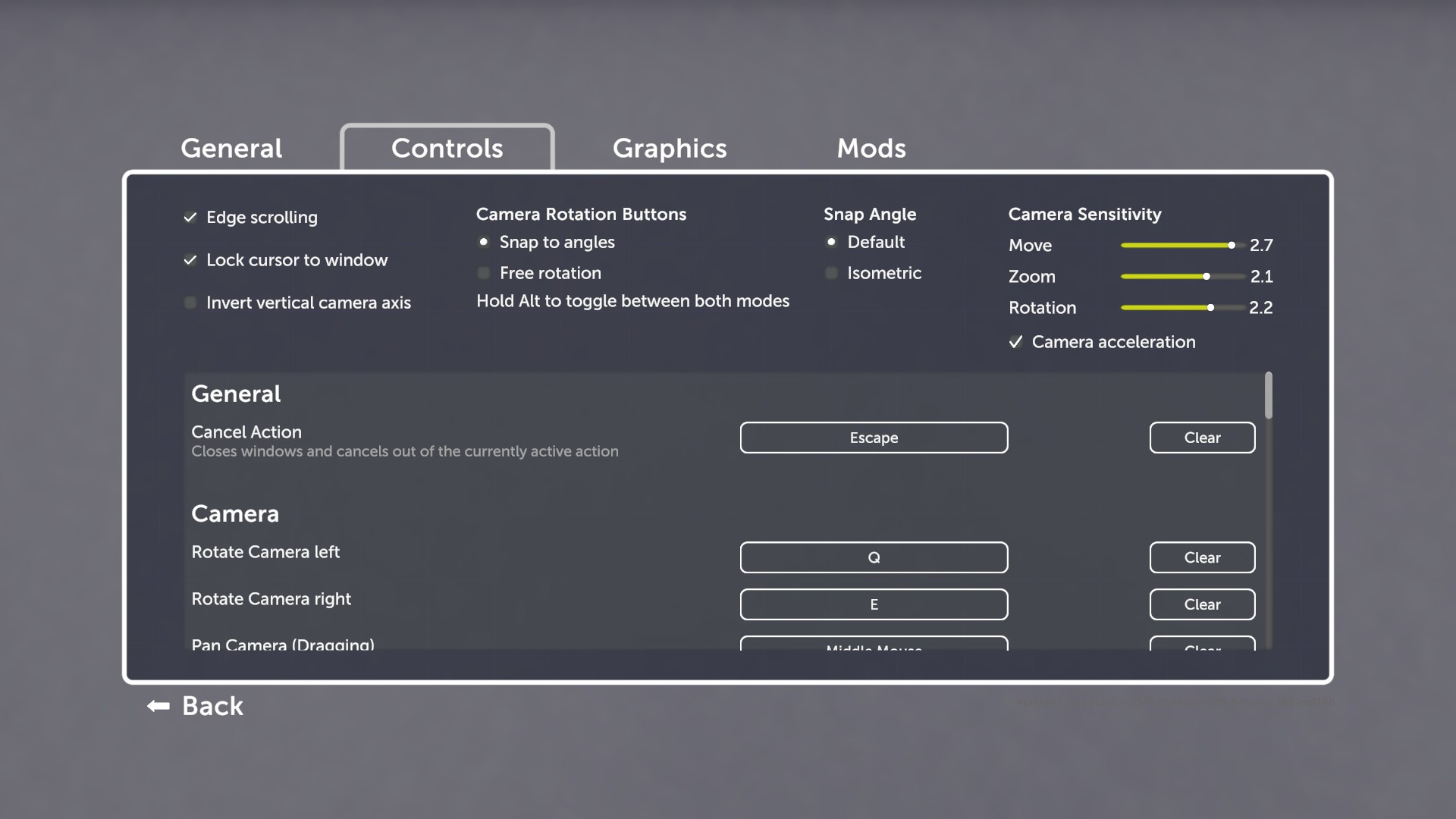
Edge scrolling
- allows you to move around the map by moving the cursor to the edge of the screen
- you can also use the WASD or arrow keys with or without edge scrolling enabled
Lock cursor to window
- keeps the cursor in the game window when playing in windowed mode
Invert vertical camera axis
- changes which way the camera moves when holding left alt + middle mouse button and moving the cursor up and down to change the vertical view angle
Camera Rotation Buttons
- Snap to angles
- restricts camera rotation to four angles
- rotate the view by pressing 'Q' and 'E'
- Free rotation
- allows free, smooth rotation of the camera
- rotate the view by holding 'Q' and 'E'
- hold left alt to temporarily use free rotation when snap to angles is selected and vice-versa
Snap Angle
- change the angle the camera snaps to when snap to angles is selected
Camera Sensitivity
- Move
- change how fast the camera moves around when edge scrolling or using the WASD keys
- Zoom
- change how fast the camera zooms in and out
- Rotation
- change how fast the camera rotates when using free rotation
- Camera acceleration
- camera movement accelerates when moving it in one of the three previous ways
Changing Keybindings
- the lower part of the controls sub-tab is for changing keybindings
- this means for example you can change what keyboard keys rotate the screen
- to change which keyboard keys do what, click on a button next to a function you wish to rebind (eg. Rotate Camera Left) with a key that is currently assigned (Q), and press a new key on the keyboard (eg. T)
- from now on pressing that key in-game will perform that function
- a warning message pops up if that key is already assigned
- press reset to revert to default
Graphics
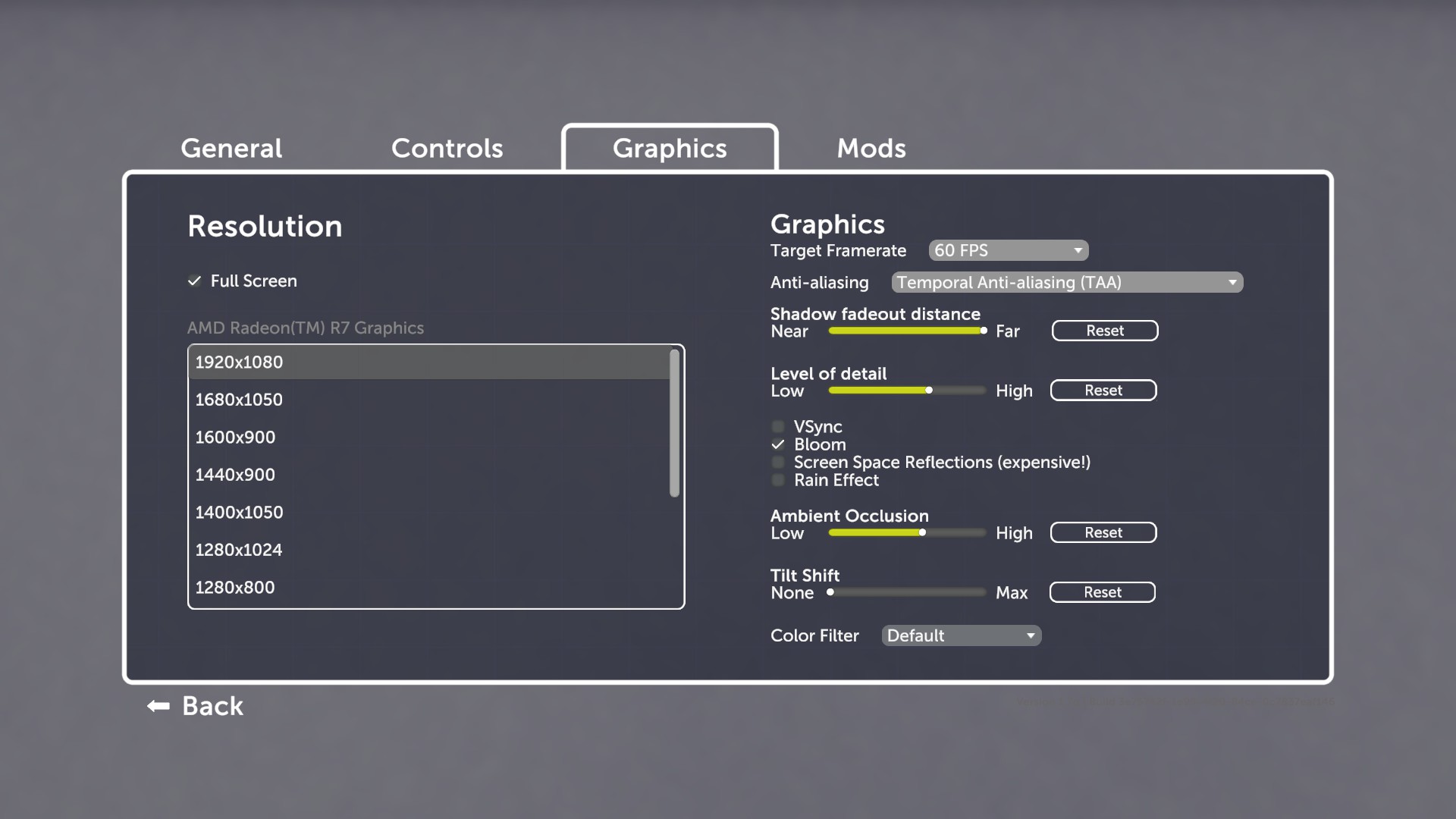
- tick Full Screen to enable full screen (when un-ticked the game will run in windowed mode)
- below the full screen tick box it shows what graphics card the game is running on (in my case AMD Radeon(TM) R7 Graphics)
- below this you can select different resolutions
- some are meant for monitors with different aspect ratios and black bars will appear at the sides or top and bottom of the screen if the selected resolution doesn't fit your monitor
- running with lower resolutions (lower down the list) will likely improve performance but lower picture quality
Target Framerate
- caps the framerate (FPS) that the game can run at
- higher framerate = smoother animations
- usually should be left at default
- 30 FPS can extend laptops battery life
- uncapped will make the game render as fast as it can on your graphics card (likely maxing out your graphics card at 100% utilization
Anti-aliasing
- smooths out jagged (pixely) edges of objects
- there are three options
- Temporal/TAA (best quality)
- Fast-Approximate/FXAA (better performance)
- no anti-aliasing (best performance)
Shadow fadeout distance
- change zoom distance at which shadows disappear
- all the way left turns off shadows completely
- all the way right shadows render at any distance
- slide left to improve performance in sunny weather
Level of detail
- set texture detail level of objects
- slide left for better performance
- at lower values small objects may be invisible when zoomed out a bit
VSync
- syncs the game framerate with the refresh rate of your monitor, to reduce tearing
- turn off for slightly better performance
Bloom
- adds a glowing effect to well lit objects
- turn off for slightly better performance
Screen Space Reflections
- adds subtle reflections in some circumstances
- turn off for better performance
Rain Effect
- whether or not rain is visible
- disable for better performance during rain
Ambient Occlusion
- shades certain areas to create illusion of depth
- slide all the way left for better performance
Tilt Shift
- adds blurring effect to certain locations on screen to create a "tabletop model" effect
- I hate it, but some people might like it, especially for screenshots when used right
- slide all the way left for better performance
Color Filter
- some colour filters to change the look of the game
- default
- desaturated (less vibrant colours)
- 1800 (black and white)
SETTINGS– cont.
Mods
- shows a list of mods you have
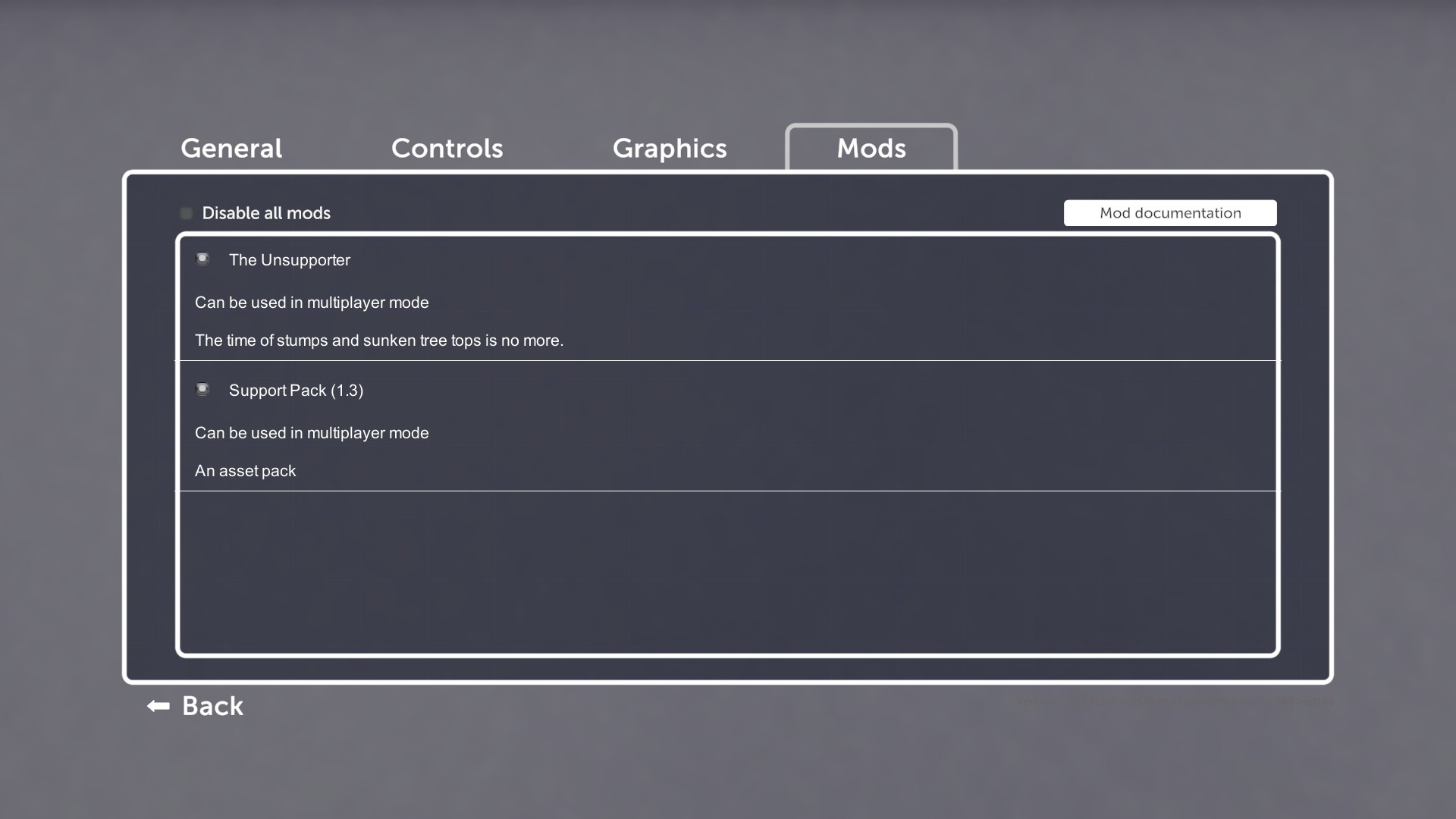
- you can disable all mods by ticking "disable all mods"
- each mod has its own tickbox to disable/enable it
- pressing mod documentation opens up a wiki on creating mods
- 3D modelling software experience is strongly recommended before making mods, otherwise you are in for a world of frustration
CONTENT MANAGER
Allows you to manage blueprints, scenarios, savegaves, and mods that you have created or downloaded from the steam workshop. I only show the blueprints sub-tab, because the scenarios, savegames, and mods sub-tabs work in exactly the same way.
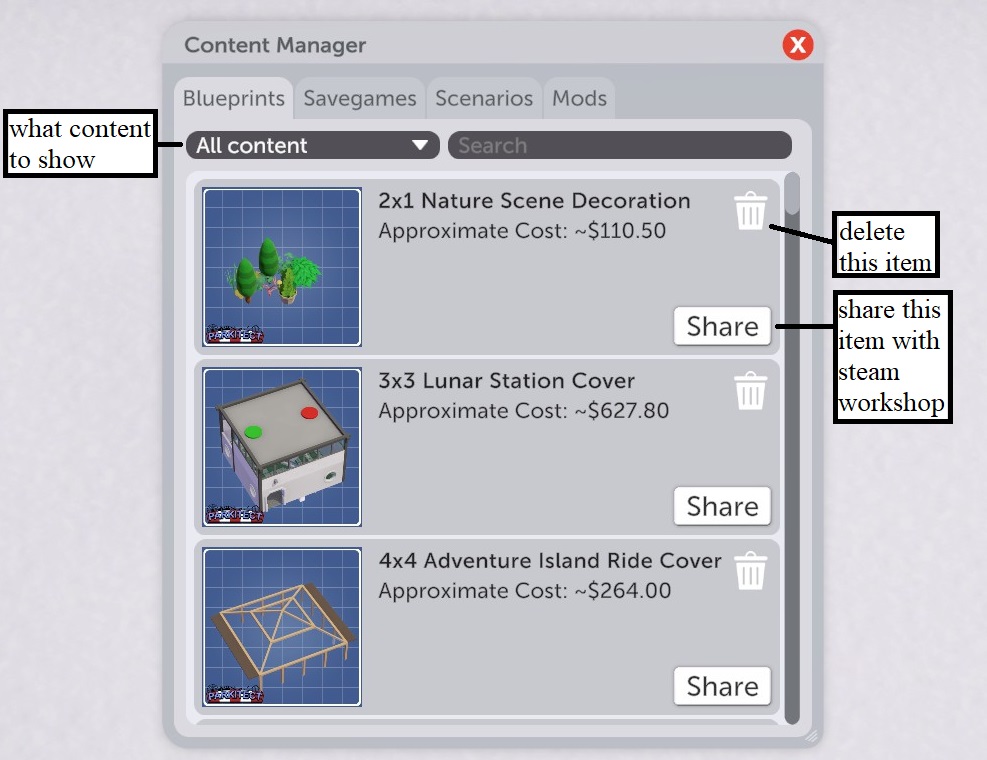
what content to show:
- allows you to choose whether to show all content, own content, or subscribed content
- own content will exclude things you have subscribed to in the steam workshop
- subscribed content will exclude things you created
- content that ships with the game isn't shown in the content manager
delete this item:
- click to delete this item
- if the item is subscribed content, clicking this will unsubscribe you from it
- if it is your own custom content, it will be deleted from your computer
- if you have previously shared the item with steam workshop, deleting it here won't delete it from the workshop (to do that you have to go to its page on the workshop)
share this item with steam workshop:
- share your beautiful creations with everyone on steam workshop
- clicking this will bring up a small window that allows you to enter a description of your item that will appear on its workshop page
- once you share it, the steam overlay will open and show your item on the workshop
- now anyone on steam can download and use your item be clicking the green "subscribe" button on its workshop page

Viewing subscribed items on steam workshop:
- for subscribed items, this button opens its workshop page
- subscribed items cannot be shared
VIEWS AND VISUALIZATIONS TAB
Click the magnifying glass to access this tab. It is useful for hiding certain in-game objects in order to better see what you are doing, as well as some useful heat maps.
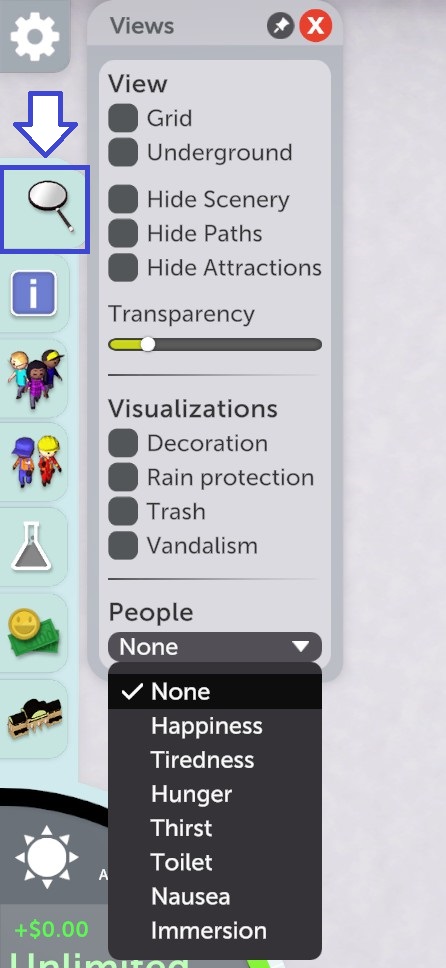
- click to always show the grid on the terrain
- activates automatically when building anything that snaps to the grid or when holding left alt while placing deco objects
that can be placed off-grid
Underground:
- allows you to see through the terrain
- useful for seeing underground objects
- keyboard shortcut: "C"
- activates automatically when building underground
Hide Scenery:
- hides decoration objects such as walls, trees, props, etc.
- useful for building things that are inside of buildings or otherwise blocked from view by scenery objects
- any deco object you place while this view is active will remain visible until the view is deactivated
- keyboard shortcut: "V"
Hide Paths:
- hides all paths
- keyboard shortcut: "B"
Hide Attractions:
- hides all rides
- keyboard shortcut: "N"
Transparency:
- a slider to change how transparent hidden scenery, paths, and rides are
Decoration:
- opens a heat map showing how well decorated paths are
- green indicates good decoration
- scenery is a source of good decoration
- grey indicates no decoration
- red indicates bad decoration
- sources of bad decoration include any staff facilities, staff paths, toilets, first aid rooms, litter, and vandalized objects
- hovering over a path tile with bad decoration will highlight sources of bad decoration that are visible from that path tile
- green indicates good decoration
- the game uses sightlines to generate a deco score for each tile of path, so sources of bad decoration can be blocked from view with walls, fences, trees, etc.
- most objects that appear opaque will block bad views
- some walls and objects included with mods don't work
- Better decoration increases the immersion stat of guests, which causes them to stay in the park longer and therefore spend more money
Rain Protection:
- highlights paths, rides, and track segments that are protected from rain
- roofs provide rain protection to things underneath them
- some roofs included in mods don't work
- anything built underground is protected from the rain
- some rides are always protected from the rain because they include roofs in their designs (eg. carousel)
- roofs provide rain protection to things underneath them
- guests will often refuse to ride rides when it is raining if the ride is not protected
- guest's happiness stat will fall faster when walking on paths that are exposed to rain
- umbrellas can be purchased by guests at umbrella shops that negate this effect on paths
Trash:
- highlights paths that have litter or puke on them
- guests happiness stat falls when walking on gross paths
- lots of litter means you probably need more janitors (see the staff tab section of this guide for more information) or trash bins
- guests can puke into trash cans, but this will cause them to fill up faster and thus require emptying by janitors more often
- anytime a guest (Houston Astro) vandalizes a trash can that has garbage in it, that garbage will be deposited on the path
Vandalism:
- highlights paths that have a vandalized object on them
- any path deco object except for path signs can be vandalized by guests
- the happiness stat of guests falls when walking near vandalism
- lots of vandalism indicates that either the guests are unhappy, there aren't enough security guards to catch vandals, there aren't enough mechanics to repair vandalized objects, or a combination of the three (see the guests section of this guide for more information on why guests vandalize)
People:
- various heat maps that show information about guests stats
- if a guest is green, that stat of that guest is good
- red means it is bad
- there is more information about guest stats in the guests section of this guide
OVERVIEW TAB
Contains some useful information and allows you to manage some things from a central location.
Attractions
This section of the tab shows you information about rides in your park. All rides in the park will be listed here.
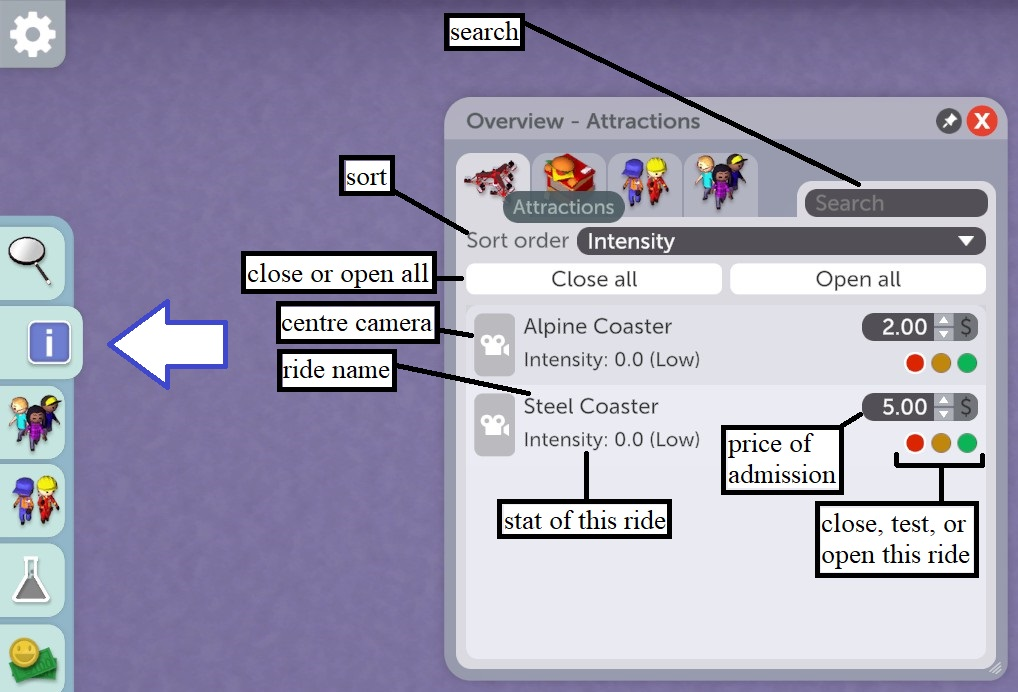
search:
- a search box
- useful for finding a certain ride if there
are a lot of rides in the park
- useful for finding a certain ride if there
sort:
- sort order
- there are many sort options
- alphabetical
- profit last month
- useful for finding underperforming
rides
- useful for finding underperforming
- total profit
- satisfaction
- excitement rating
- intensity rating
- nausea rating
close or open all:
- close or open all rides in the park at once
centre camera:
- Centres the camera on this ride
ride name:
- click on it to bring up this ride's management window
stat of this ride:
- information about this ride corresponding to the sort order
price of admission:
- the price of admission for this ride
- there are three ways to change it
- click on the number and type in a new number on your keyboard
- click on the number and scroll the mouse wheel
- click on the two tiny arrows to the right of the number
close, test, or open this ride:
- buttons to close, test or open this ride
- red closes the ride
- yellow puts the ride into test mode
- green opens the ride
- some rides can't be tested and will only have buttons for opening and closing
Shops
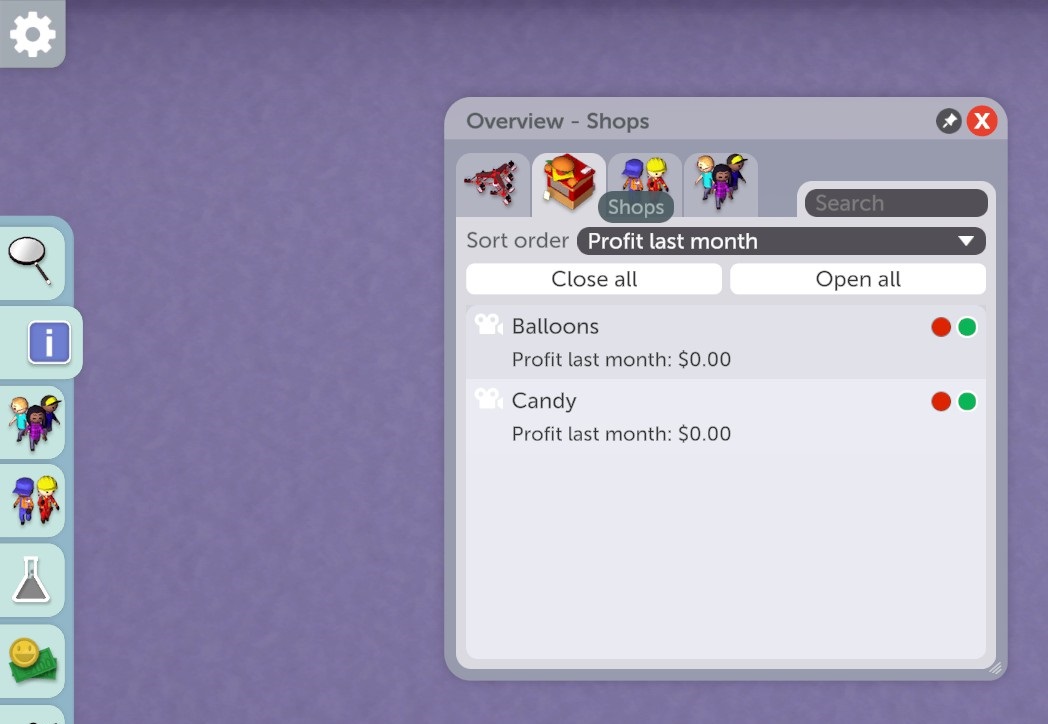
This section of the tab shows information about shops in your park. All shops in the park will be
listed here, including toilets and first aid rooms. This is fairly similar to the attractions part of the overview tab that I just covered (but with shops instead of rides) so I won't go into further detail.
Employees
This section of the tab shows information about employees in your park. All janitors, haulers, mechanics, security guards, and entertainers in the park will be listed here.
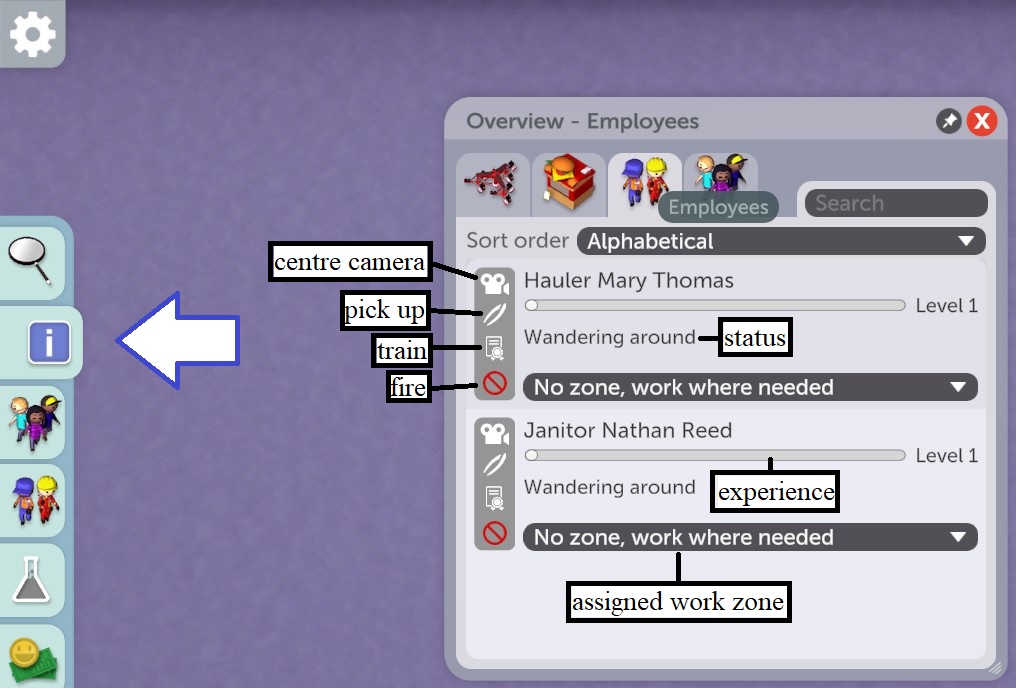
centre camera:
- centres the camera on this employee
pick up:
- allows you to pick up this employee and drop them somewhere else in the park
train:
- train this employee to level up their skill level
- only works if there is a staff training room in the park
- their skill level will also increase just from doing their normal routines
fire:
- fire this employee
status:
- status of this employee (what they are doing)
experience:
- shows the skill level of this employee
- the bar represents how much progress this employee has made toward the next skill level
- more skilled employees complete tasks faster and need to rest less frequently
assigned work zone:
- allows you to change what zone this staff member is assigned to
- see the employees tab section of this guide for more information about staff zones
Guests
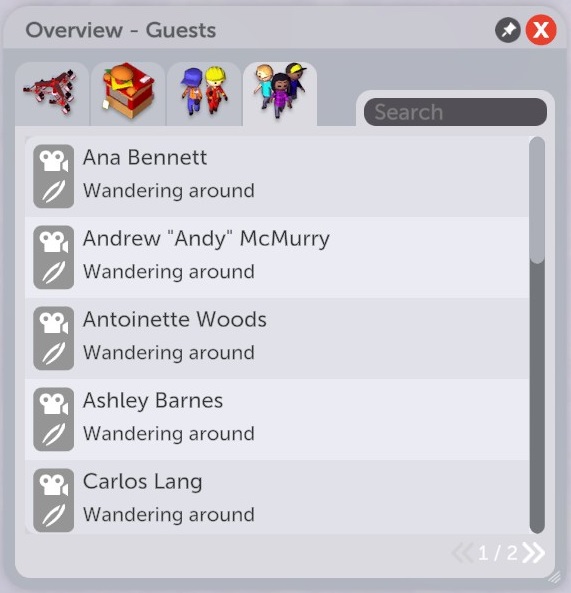
This section of the tab lists every guest in the park.
- not to be confused with the Guests Overview tab, which I cover in the next section of this guide
- if there are enough guests in the park, there will be buttons at the bottom right of the window that look like this: "<<1/2>>" as shown in the picture to the left
- this means that there are two pages to look through
- will also happen with the attractions, shops, and employees sections of the tab, if you build enough rides or shops, or hire enough employees
- "1" indicates you are looking at the first page
- "2" indicates that there are two pages (can increase to 3,4,etc. with more guests)
- press << or >> to view previous or next page
The functions in this section of the overview tab are similar to the employee section of the tab (which I just covered), so I won't go into further detail.
GUESTS OVERVIEW TAB
This tab contains lots of useful information about what guests are doing, thinking and how they are feeling.
Average Stats
This sub-tab shows the average stats of all guests in the park.
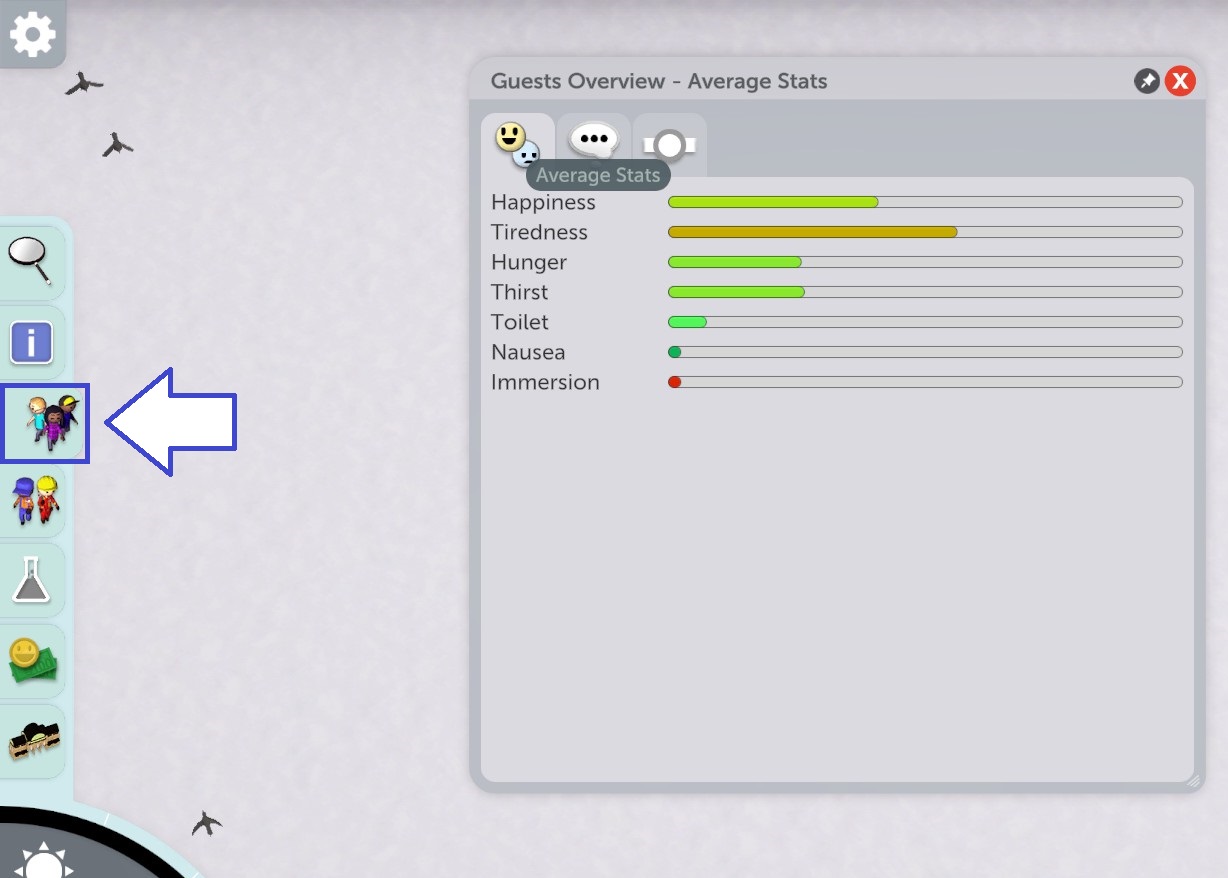
Happiness
- self explanatory
- guests gain happiness from riding rides, consuming some foods, and having nice thoughts (eg. Great scenery, Wooden coaster was a really good deal, etc.)
- they lose happiness gradually and when having bad thoughts (eg. This path is disgusting, I'm not paying that much for a soft drink from soft drinks, I want to get off Mr. Bones' Wild Ride, etc.)
- happiness drains more slowly when their immersion stat is high (more on immersion in a bit)
- happiness drains faster when any of the the other stats are high (other than immersion)
Tiredness
- also self explanatory
- increases when guests are walking around
- decreases when guests are sitting on benches
- one of the easiest problems to solve; just place benches everywhere, especially near ride exits and food or drink shops
Hunger and Thirst
- increase gradually
- decrease when consuming food and/or drinks purchased at shops
Toilet
- increases when consuming food or drink
- decreases when using a toilet (hopefully)
Nausea
- increases when riding rides (especially rides with a high nausea rating), and after consuming tainted food or drink (food sold from a shop can be tainted if the shop is dirty, see the shops section of this guide for more information)
- decreases gradually over time when not riding rides and when puking
- decreases much faster when inside a first-aid room
Immersion
- when this stat is high, happiness drains more slowly and guests will stay in the park longer
- increases when guests are walking on path tiles with a high deco score or when riding rides with a high deco rating
- decreases when walking on paths or riding rides with a low or bad deco rating
- decreases when they see employees resting on benches or carrying resource crates
Thoughts
This sub-tab shows everything that guests are thinking about. It is very useful for finding out what is wrong with your park (eg. a lot of people thinking "this path is disgusting", means you probably need more janitors or trash cans). Clicking on a thought will make icons appear around the park showing where people are having that thought (eg. expect a lot of "I feel sick" thoughts near the exits of high nausea rides).
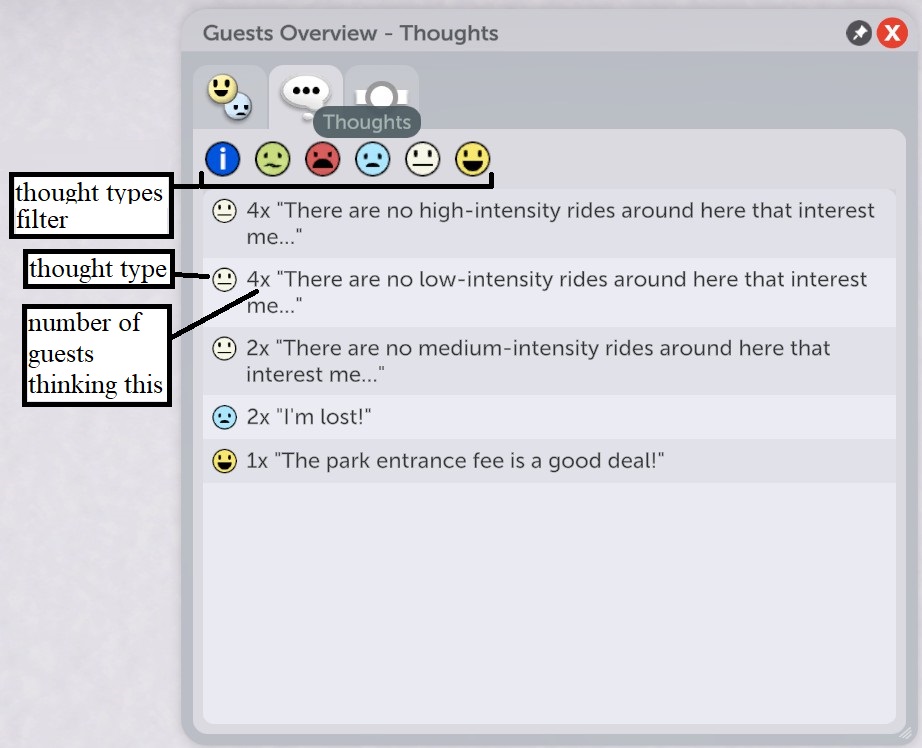
thought types filter
- allows you to filter out certain types of thoughts
- from left to right:
- guest movement (eg. "I want to go on Wooden Coaster!")
- nausea related (eg. "I feel sick.")
- angry (eg. "I'm not paying that much to go on carousel!")
- sad/sort of angry (eg. "I hope Gravitron is worth the long queue time.")
- neutral (eg. "Time to go home!")
- happy (eg. "I had a great time!")
thought type
- a small symbol next to each thought showing what effect it has on guests (eg. angry thoughts decrease guests happiness, guest movement thoughts mean the guest(s) are heading towards whatever attraction or shop that is mentioned in the thought, etc.)
number of guests thinking this
- the number of guests in the park that have recently had this thought
Actions
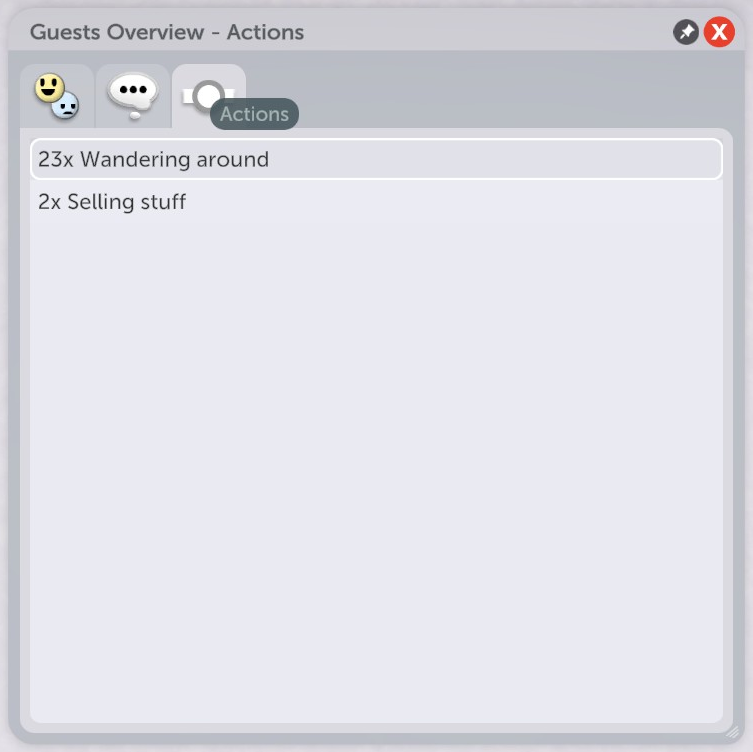
Shows the status of guests in the park (what they are doing), and how many guests are performing each action. In the picture to the right, 23 guests are wandering around, and two are selling stuff (vendors in shops show up here for some reason).
GUESTS
This section is about the information window that pops up when you click on a guest. It has five sub tabs. From left to right these are:
- Info
- Thoughts
- Inventory
- Experiences
- Stats
Info
This sub tab contains some semi-anecdotal information about this guest as well as a few management options.
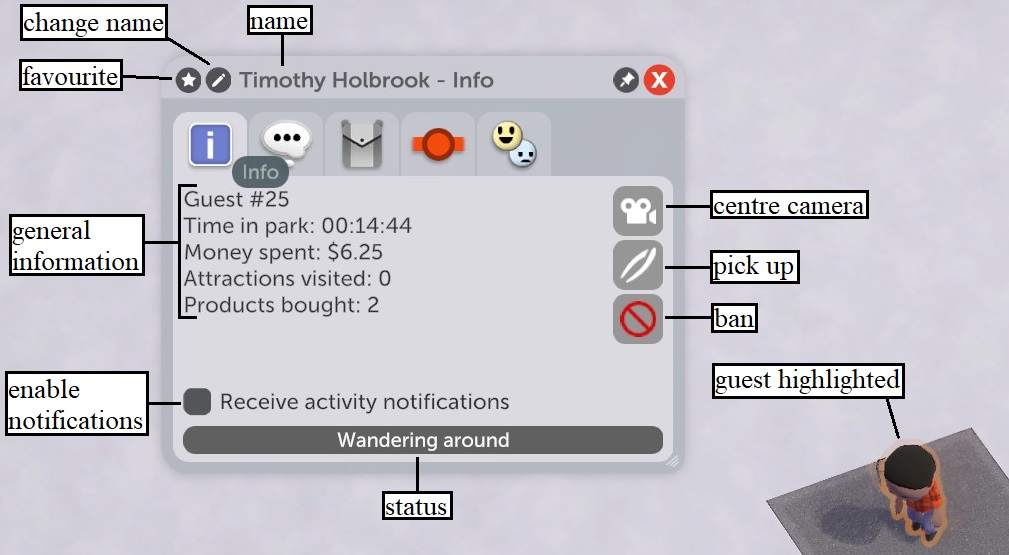
name
- this guest's name
- some guests have a nickname (eg. Sebastian "Sebioff" Meyer)
- some of Parkitect's early Kickstarter supporters and developers have special guests named after them
change name
- rename a guest
- clicking will bring up a small window allowing you to enter a first name, nickname, and last name
favourite
- add a star to the left of this guest's name wherever it appears
- favourited guests will be at the top of the guest list in the overview tab
general information
- some information about this guest
- Guest #
- the guest in the screenshot was the twenty-fifth to enter the park
- Time in park
- the amount of real world time that has passed since this guest stepped through the entrance of the park adjusted for simulation speed (putting the game into fast-forward or pause will respectively speed up or stop the speed at which the amount of time in the park increases)
- guests usually don't stay more than two hours, even if they are satisfied
- if they leave after less than an hour, they likely weren't satisfied with the park
- the amount of real world time that has passed since this guest stepped through the entrance of the park adjusted for simulation speed (putting the game into fast-forward or pause will respectively speed up or stop the speed at which the amount of time in the park increases)
- Money spent
- the total amount of money this guest has spent at your park (including the entrance fee)
- Attractions visited
- the number of times this guest has gone on rides
- repeat rides of the same attraction are counted, meaning if a guest rides the same ride twice, it will say 'Attractions visited: 2'
- Products bought
- how many items this guest has purchased at shops
- Guest #
enable notifications
- ticking this will make a notification trigger whenever this guest does something (enters a queue line, buys an ice cream, etc., see the notifications section of this guide for more information about notifications)
status
- what this guest is currently doing
centre camera
- centre the camera on/go to this guest
pick up
- pick up/move this guest (and drop them in water or lava if you want)
ban
- ban this guest from the park
- the guest will immediately start walking towards the park exit and leave
- useful for getting rid of vandals if your security can't keep up (look for bandanas)
guest highlighted
- the guest that was clicked on to bring up this window
- when a guest's window is open, they are surrounded by an outline the same colour as their shirt
Thoughts
This sub tab contains a list of this guest's past thoughts in chronological order. Clicking on a thought in this list will centre the camera on the location of its occurrence.
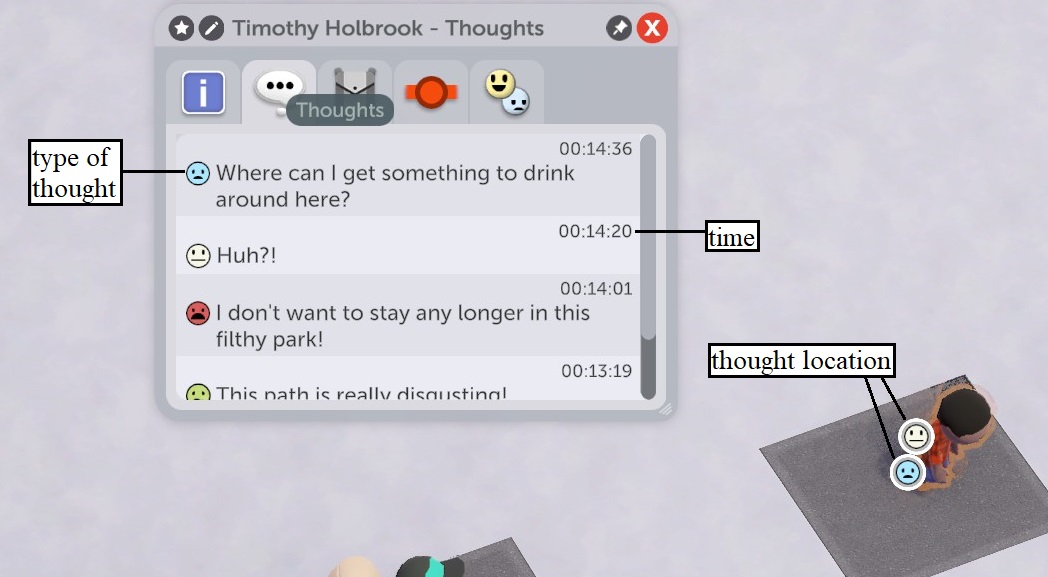
type of thought
- there is a small icon next to each thought to show what type of thought it is
- there are six types of thoughts:

- guest movement (blue circle with 'i' in the middle)
- guests have these thoughts when they decide they want to do something (eg. "I want to go on Carousel." indicates that this guest began heading to this ride when they had this thought)
- nausea or cleanliness related (green queasy face)
- thoughts related to gross things (eg. "This path is disgusting.") or feeling nauseous (eg. "I feel sick.")
- angry (red angry face)
- thoughts about things that are angering this guest (eg. "I want to get off of Mr. Bones' Wild Ride!")
- these thoughts decrease a guest's happiness stat
- sad/disappointed (light blue sad face)
- thoughts about things that are mildly upsetting to this guest (eg. "This hot dog from Hot Dogs is a bit overpriced.")
- these thoughts slightly decrease a guest's happiness stat
- neutral (face with neutral expression)
- thoughts about things that don't affect a guest's stats but may affect them in other ways (eg. "There are no high intensity rides around here that interest me…" indicates that this guest wants to ride high intensity rides but can't find any)
- happy (yellow happy face)
- thoughts about things that increase this guest's happiness stat (eg. "This hot dog from Hot Dogs is really worth the money!")
- guest movement (blue circle with 'i' in the middle)
- there are six types of thoughts:
time
- the time at which a thought occurred
- measured by the amount of time that had passed since the guest entered the park (this "Huh?!" thought occurred 14 minutes, 20 seconds after this guest entered the park)
thought location
- these icons will appear around the park when a guest's thoughts sub tab is open to indicate where in the park this guest was when thoughts occurred
- hovering over these icons will show what the thought was
Inventory
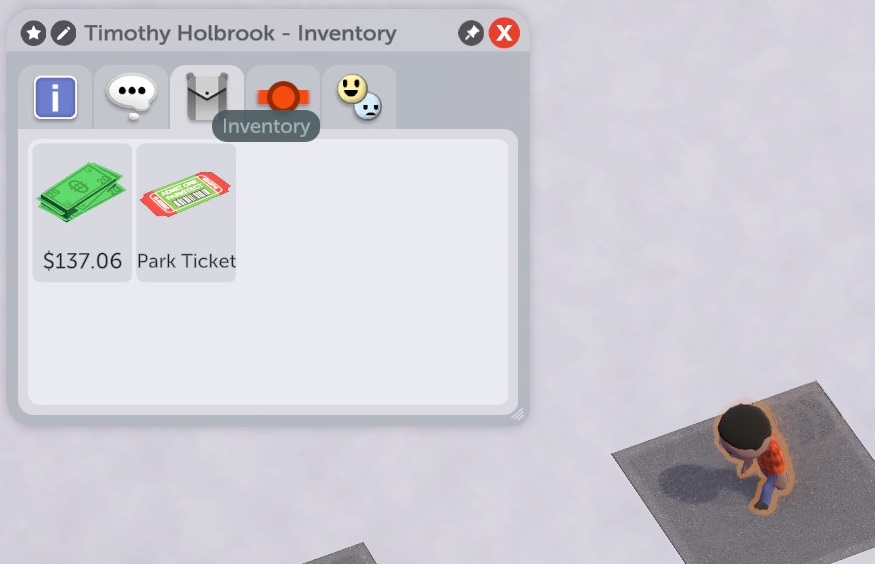
This sub tab shows all items that this guest is carrying. This includes how much cash they have left, their park ticket, coupons from marketing campaigns, souvenirs they bought, as well as food, drinks, and garbage from these. Hovering over an item will show some additional information about it, such as where it was purchased.
Experiences
This sub tab lists everything this guest has done in the park in chronological order. Clicking on an item in this list will centre the camera on the location of its occurrence. Similar to the thoughts sub tab, each item on the list shows when it occurred by how much time had passed since the guest entered the park.
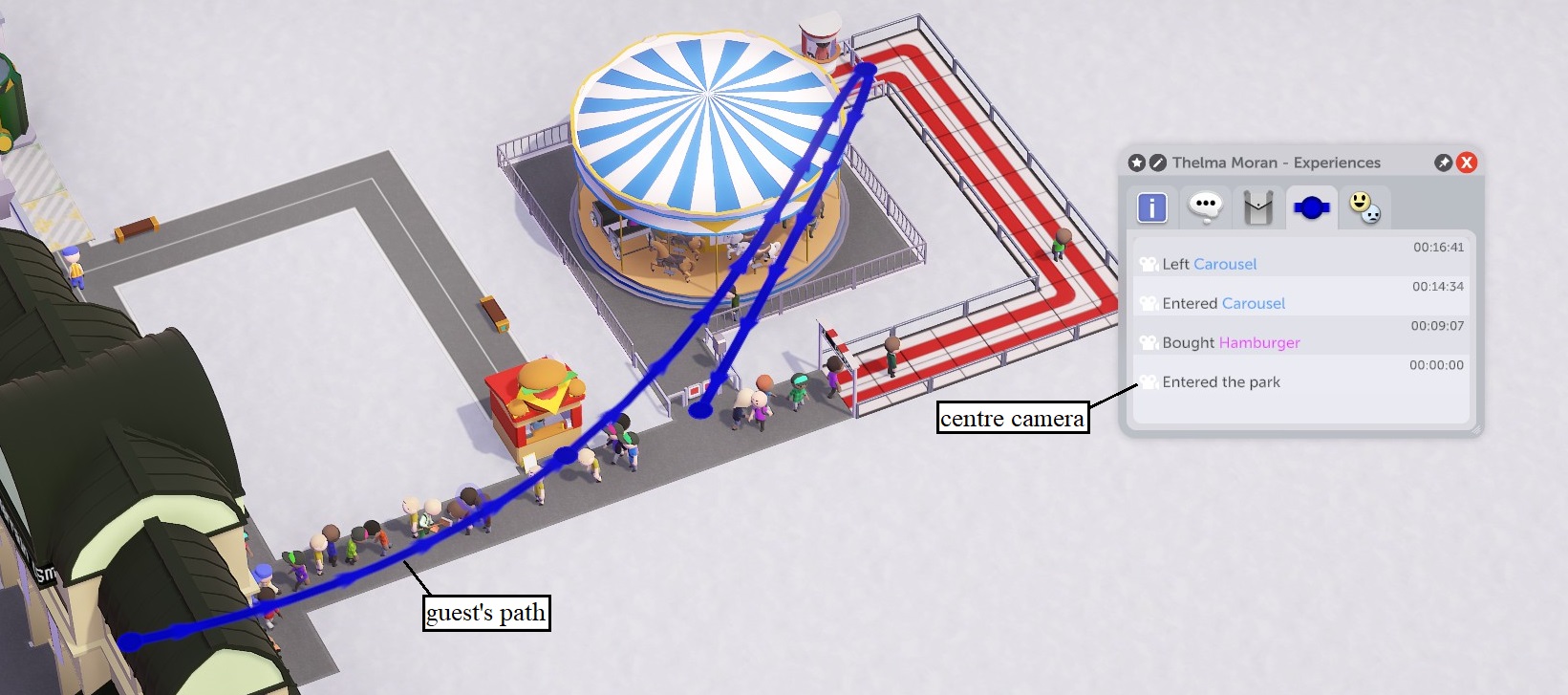
As you can see in this picture, when this sub tab is open a solid line appears in the park generally showing the path this guest has taken. Along it are points at locations where the guest did something (bought hamburger at that burger shop, entered the carousel, etc.). Hovering over these points will bring up a tool tip showing the same information about this action that is shown in the list.
GUESTS– cont.
Stats
This sub tab shows detailed statistics about this guest.
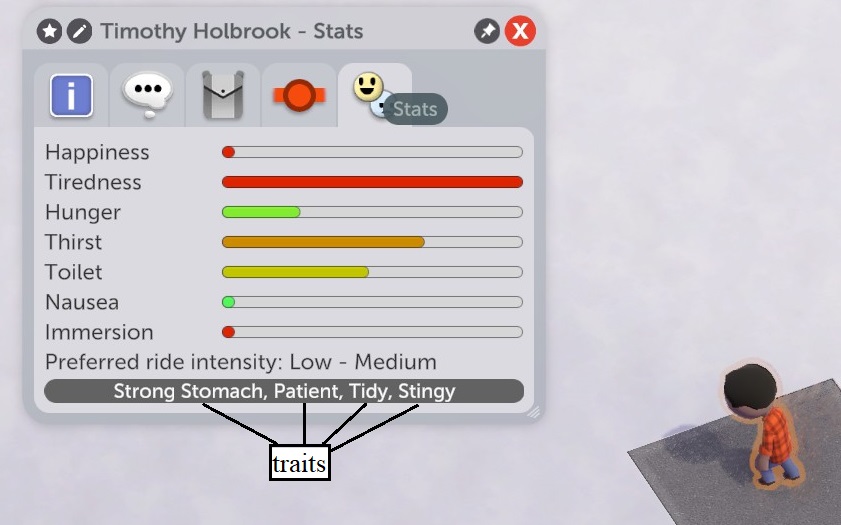
*If you have already read the Guests Overview section of this guide you can scroll down to the information on preferred ride intensities and traits.
Happiness
- guests gain happiness from riding rides, consuming some foods, and having nice thoughts (eg. Great scenery, Wooden coaster was a really good deal, etc.)
- they lose happiness gradually and when having bad thoughts (eg. This path is disgusting, I'm not paying that much for a soft drink from soft drinks, I want to get off Mr. Bones' Wild Ride, etc.)
- happiness drains more slowly when their immersion stat is high (more on immersion in a bit)
- happiness drains faster when any of the the other stats are high (other than immersion)
Tiredness
- increases when guests are walking around
- decreases when guests are sitting on benches
Hunger and Thirst
- increases gradually
- decreases when consuming food and/or drinks purchased at shops
Toilet
- increases when consuming food or drink
- decreases when using a toilet (hopefully)
Nausea
- increases when riding rides (especially rides with a high nausea rating), and after consuming tainted food or drink (food sold from a shop can be tainted if the shop is dirty, see the shops section of this guide for more information)
- decreases gradually over time when not riding rides and when puking
- decreases much faster when inside a first-aid room
Immersion
- when this stat is high, happiness drains more slowly and they will stay in the park longer
- increases when they are walking on path tiles with a high deco score or when riding rides with a high deco rating
- decreases when walking on paths or riding rides with a low or bad deco rating
- decreases when they see employees resting on benches or carrying resource crates
Preferred ride intensity
- this guest will prefer rides that fall within this range
- they will still ride rides outside of this range, but not as often
traits
- special traits that influence this guest's behaviour and stats
- the traits are:
- patient
- more willing to wait in long lines, takes longer for them to start complaining about waiting in queues
- impatient
- less willing to wait in long lines, takes less time for them to start complaining about waiting in queues
- generous
- willing to spend more money on things, less likely to complain about high prices
- stingy
- willing to spend less money on things, more likely to complain about high prices
- tidy
- less likely to drop garbage on paths
- litterer
- more likely to drop garbage on paths
- cheerful
- their happiness stat increases faster and decreases more slowly
- grumpy
- their happiness stat increases slower and decreases more quickly
- strong stomach
- their nausea stat increases more slowly when riding rides
- weak stomach
- their nausea stat increases more quickly when riding rides
- vandal
- frequently vandalize park objects
- guests never enter the park with this trait, but several random guests in your park will gain this trait when a vandal event happens
- when a vandal event happens, a notification will appear that says "a group of vandals are roaming the park"
- having more security guards decreases the chance of this happening
- you will want to get rid of these guests
- there are three ways to deal with them:
- making sure you have enough security guards to catch them and ban them from the park
- manually banning them as shown earlier
- killing them by drowning or other nefarious means
- there are three ways to deal with them:
- patient
STAFF TAB
This is where you can hire and manage park employees.
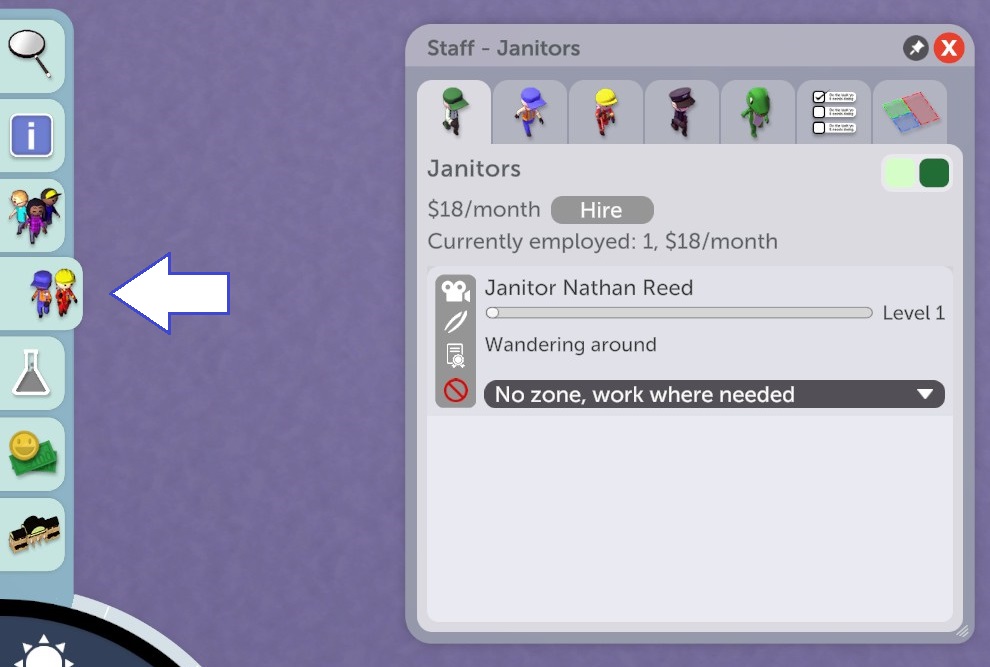
There are seven sub-tabs:

from left to right:
- janitors (currently open)
- sweep up litter and vomit
- empty trash cans
- clean shops and toilets
- haulers
- deliver resource crates to shops
- mechanics
- maintain rides
- fix broken down rides
- repair vandalized objects
- security
- catch and ban vandals
- decrease the chance of a vandal event occurring
- entertainers
- increase the happiness of nearby guests
- tasks
- zones
Janitors, Haulers, Mechanics, and Security
These four sub tabs function exactly the same. In the diagram the janitors sub tab is open.
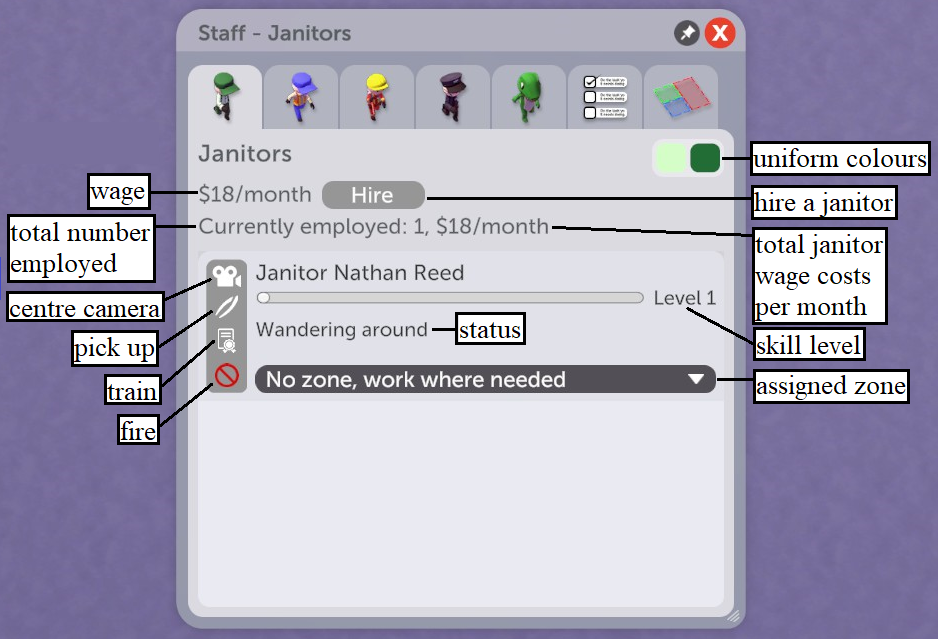
wage
- the cost per month for each employee of this type
- janitors cost $18/month
- haulers cost $16/month
- mechanics cost $45/month
- security guards cost $24/month
total number employed
- the total number of this employee type in the park
centre camera
- centre the camera on (go to) this employee
pick up
- manually pick up (move) this employee
train
- send this employee to a staff training room to increase their skill level
- you need to place a staff training room in your park for this to work
- employees with a higher skill level will complete tasks faster and won't need to rest in a staff room as often
fire
- fire (get rid of) this employee
status
- what this employee is currently doing
uniform colours
- change the uniform colours for all employees of this type (see the brush tab and custom colours section of this guide for more information)
hire a janitor
- hire a single employee of this type (in this case a janitor)
total janitor wage costs per month
- the total cost per month for all wages for this employee type in the park (in this case janitors)
skill level
- how skilled this employee is
- as previously stated, generally a higher skill level means faster task completion and fewer breaks
- progress bar indicates progress toward next skill level
- increases whenever an employee completes a task
assigned zone
- what zone this employee is assigned to (more on the zones sub tab later in this section)
- displays 'no zone, work where needed' when they aren't assigned to a zone
Entertainers
The entertainers sub tab works the same as the previous four, but with two exceptions related to costumes they can wear.
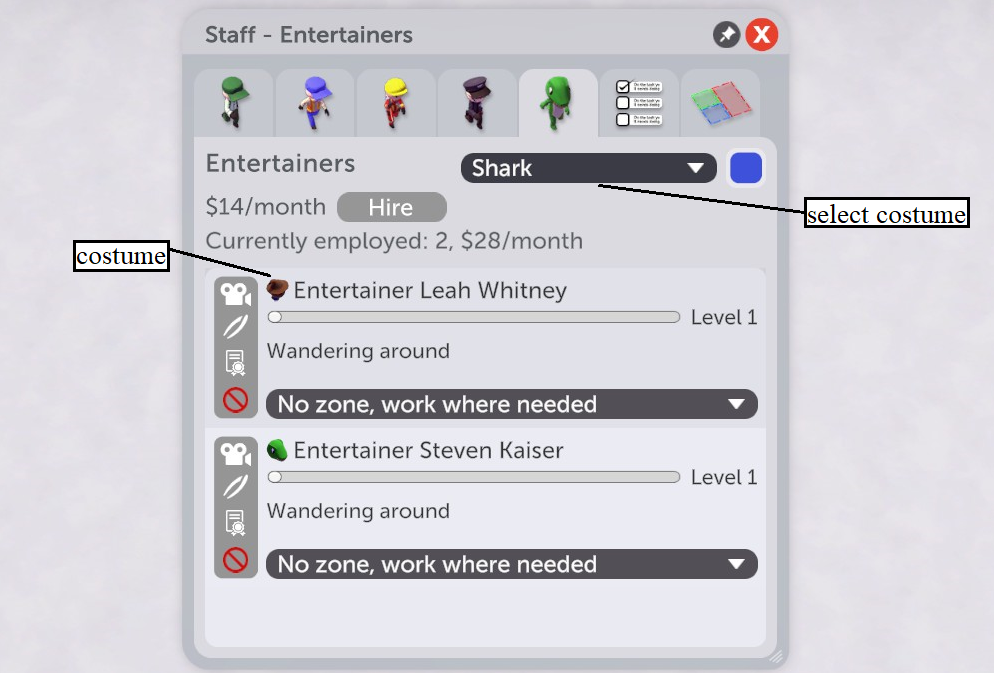
costume
- a small icon showing the type of costume this entertainer is wearing
select costume
- choose what type of costume you want the next entertainer you hire to wear
- choices are raptor, shark, robot, scarecrow, and knight
- costume can't be changed after hiring
- changing uniform colours in this sub tab only affects entertainers in your park that are wearing the costume type that is currently selected
Tasks
A list of tasks that need to be completed by park staff. Only larger tasks such as cleaning a shop or maintaining a ride will show up here. Smaller things such as sweeping paths or catching vandals are done when a suitable employee is nearby and won't show up here.
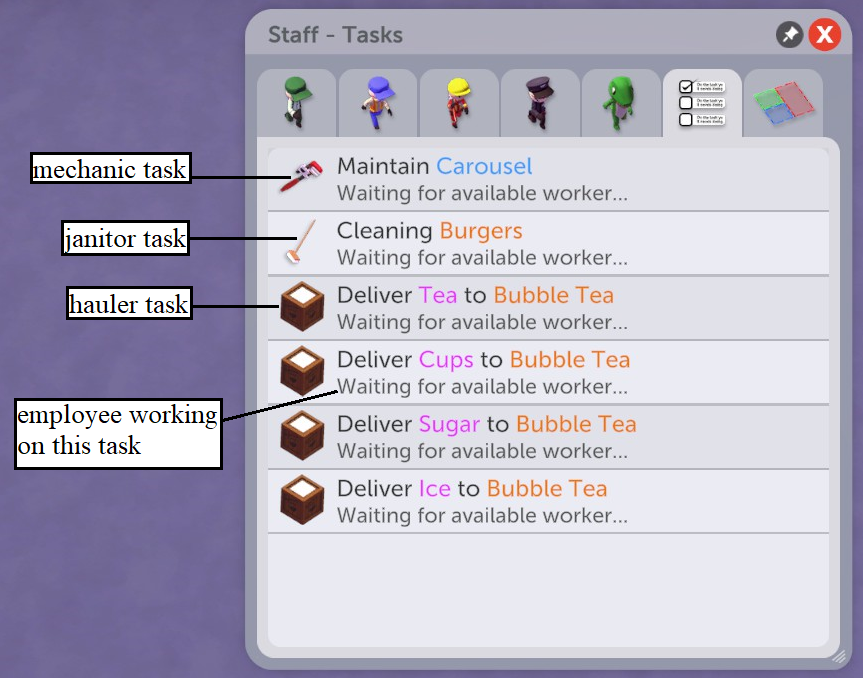
mechanic task
- this task must be done by a mechanic
- indicated with a wrench icon
janitor task
- this task must be done by a janitor
- indicated with a broom icon
hauler task
- this task must be done by a hauler
- indicated with a crate icon
employee working on this task
- the employee currently working on this task
- if none are available, it will say 'waiting for available worker…'
- if a task goes uncompleted for at least ten minutes it will say 'waiting for available worker since x minutes…' indicating how long it has gone uncompleted
- a notification will be triggered at ten minute intervals as long as this task is incomplete (see the notifications section of this guide for more information about notifications)
- if this is happening it means you probably need more of this employee type
- if a task goes uncompleted for at least ten minutes it will say 'waiting for available worker since x minutes…' indicating how long it has gone uncompleted
Zones
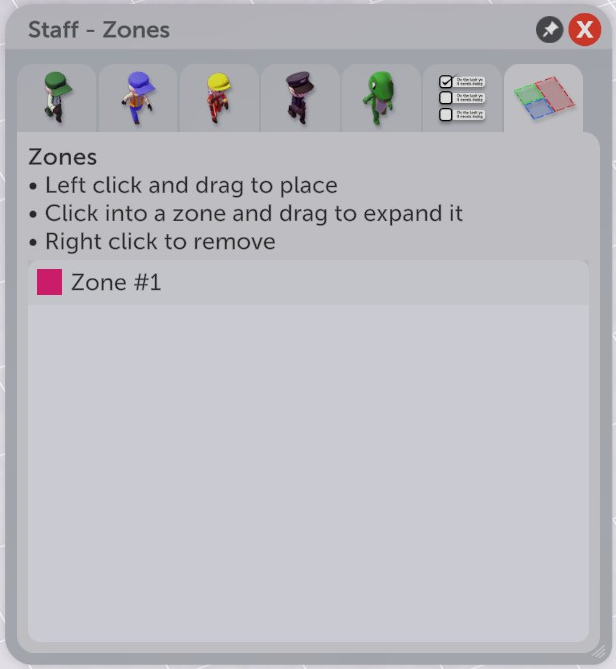
The place to create and manage staff zones. Zones should always be used in larger parks to use employees more efficiently. Otherwise, you may get situations where all three janitors in your park are in one corner of the park, while a busy food court at the other side of the park is full of trash. This sub tab lists all zones in the park. Clicking on one of them will open that zone's information window. Creating zones is easy. While the zones sub tab is open:
- left click on the terrain and drag to place a zone
- left click inside an already created zone and drag to extend that zone
- right click and drag to remove zones
STAFF
This section is about the window that pops up when you click on an employee in the park. It has five sub tabs:
- Info
- Tasks
- Thoughts
- Inventory
- Stats
Info
This sub tab has some general anecdotal information about this employee and some ways to manage them.
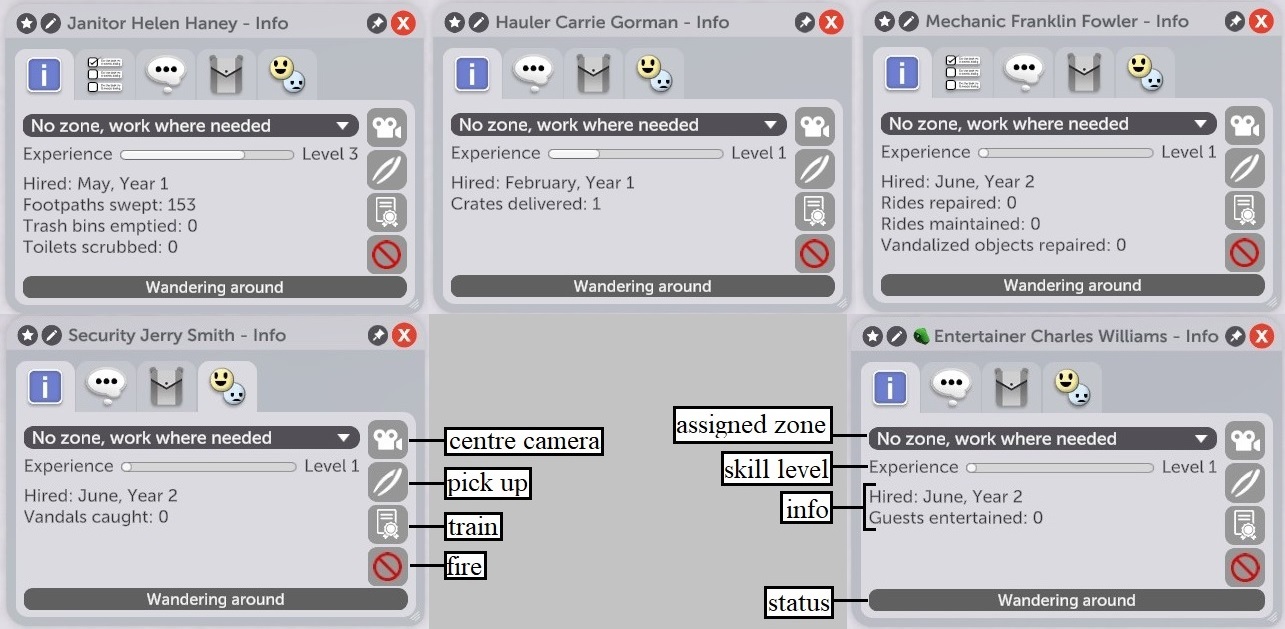
*Most of this has already been covered in the Staff Tab section, so if you already read that feel free to skip to tasks.
centre camera
- centre the camera on (go to) this employee
pick up
- manually pick up (move) this employee
train
- send this employee to a staff training room to increase their skill level
- you need to place a staff training room in your park for this to work
- employees with a higher skill level will complete tasks faster and won't need to rest in a staff room as often
fire
- fire (get rid of) this employee
assigned zone
- what zone this employee is assigned to
- displays 'no zone, work where needed' when they aren't assigned to a zone
skill level
- how skilled this employee is
- a higher skill level means faster task completion and fewer breaks (more on these perks in a bit)
- can't go higher than ten
- also displayed in the stats sub tab
- progress bar indicates progress toward next skill level
- increases whenever an employee completes a task
info
- just some anecdotal information about this employee
status
- what this employee is currently doing
Tasks
This sub tab allows you to exclude certain tasks from an employee's duties (eg. unticking 'empty trash bins' for a janitor will prevent that janitor from emptying trash bins, but they will continue sweeping paths and cleaning shops).
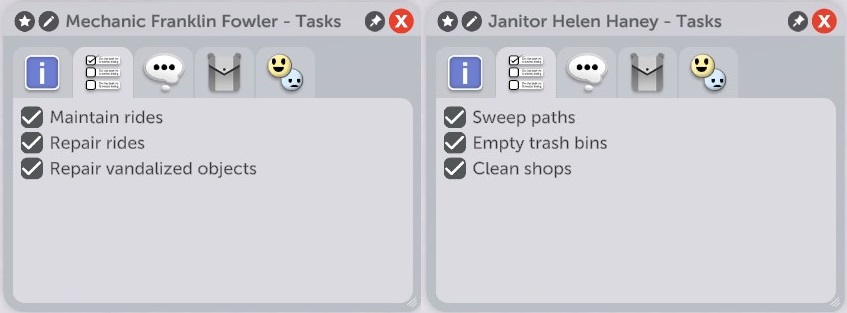
Only janitors and mechanics have this sub tab because all the other employees only perform one task, thus making this sub tab useless for them. (Why would you want a hauler that doesn't haul crates?)
Thoughts
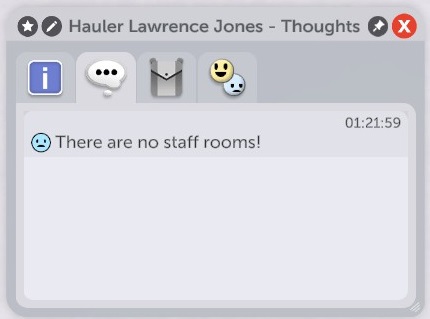
This sub tab shows thoughts that this employee has had. It doesn't really serve much of a purpose unless there are no staff rooms, in which case you will see complaints about that here. Staff happiness isn't simulated in this game though, so as long as there are benches for them to sit on, they will be able to rest (Although guests don't like seeing employees resting on benches, and it takes about twice as long for them to regain their energy vs. resting in a staff room). Each thought also shows when it occurred, based on how much time had passed since they were hired.
Inventory
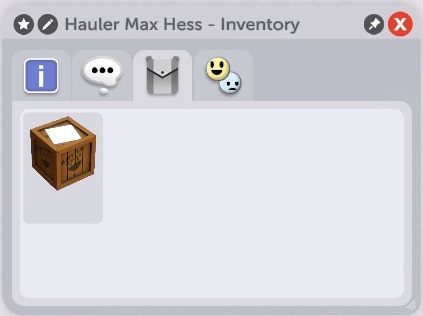
This sub tab doesn't really serve a purpose either, other than to show that a hauler is carrying a crate or a janitor a trash bag (which you can clearly see in-game anyways). It will also show if an employee is wearing glasses, in case that interests you.
Stats
This sub tab shows some useful information about this staff member related to their energy, skill level, and benefits from their skills.
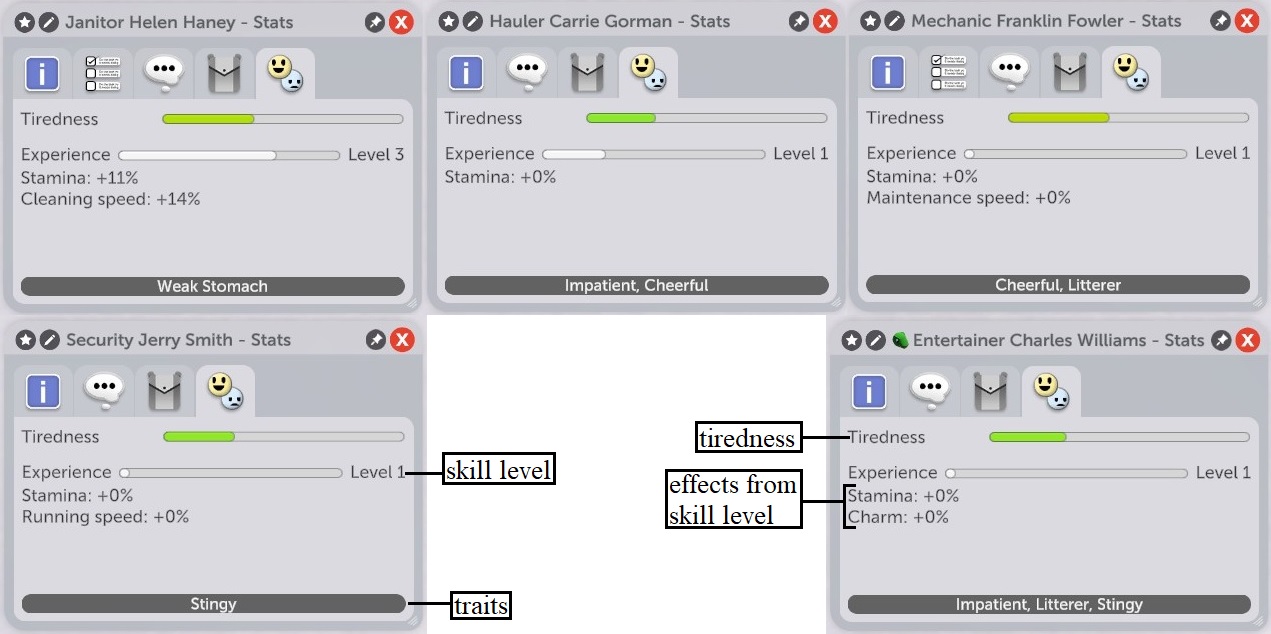
skill level
- shown in this sub tab as well as the info sub tab for some reason
traits
- just like guests, employees also have traits; employee traits are irrelevant however
tiredness
- employees will not be able to complete any tasks when this bar is full
- increases gradually and when completing tasks
- decreases while resting in a staff room or sitting on a bench
- rate of decrease is about twice as fast in staff rooms vs. benches
- guests don't like seeing employees resting on benches
effects from skill level
- the positive effects from this employee's skill level are shown here
- as an employee's skill level increases, these boosts do too
- stamina
- applies to all employees
- employee tiredness increases more slowly, meaning they will need fewer breaks
- cleaning speed
- only applies to janitors
- sweeping up trash and cleaning shops takes less time
- emptying trash bins is unaffected
- maintenance speed
- only applies to mechanics
- fixing and maintaining rides takes less time
- repairing vandalism is unaffected
- running speed
- only applies to security guards
- allows them to run faster, increasing their ability to catch vandals
- charm
- only applies to entertainers
- increases the happiness boost given to nearby guests
- stamina
RESEARCH TAB
This tab allows you to research and unlock new rides and scenery objects and complete market research to learn more about your guests. It has two sub tabs, one for researching rides and scenery, and the other for doing market research. Information about the research team(s) is shown here.
Research
This sub tab allows you to hire up to two research teams to research new rides and scenery objects. Unless you are playing on a sandbox park with research disabled, a park will always start with one team with the option to hire an additional one for $5000.
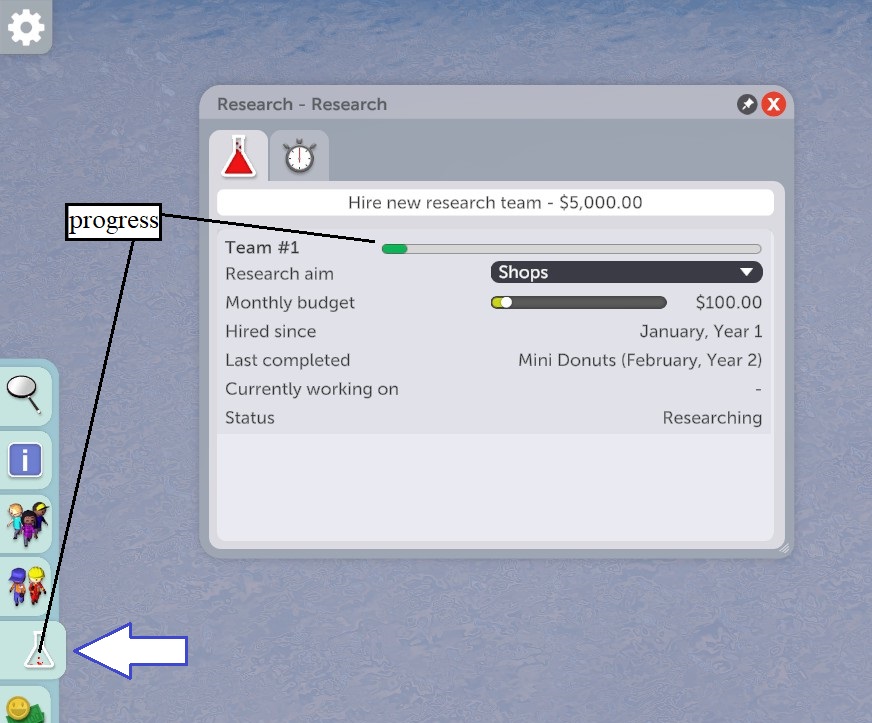
progress
- progress toward project completion is shown as a green progress bar beside each research team
- progress is also represented by how full the erlenmeyer flask on the UI is
- if a second team is hired, this will show the progress of the second team
- once a project has completed, these indicators reset and a new project is automatically started
Research aim
- click to choose what you want this team to work on (calm rides, coasters, decorations, etc.)
- any research projects already underway and in later stages will continue, unaffected, until they are completed
Monthly budget
- slider to set how much money you wish to spend per month on this research team
- more money spent will mean faster project completion, with decreasing returns for each additional dollar spent (which means spending $200/month won't double research speed vs. $100/month)
- anything over $500/month is mostly wasted money
- this also means that two teams with budgets of $100/month will complete more projects over time than one team with a $200 budget
Hired since
- the in-game date this team was hired
- because the first team is already hired at the start of a game, it will always say January, Year 1 for team #1
Last completed
- what was last researched by this team, with the date of its completion in brackets
Currently working on
- what this team is working to unlock (eg. steel coaster, sci-fi walls, etc.)
- doesn't become known until the later stages
Status
- what stage this project is in; the stages are:
- Gathering ideas
- Researching
- Planning (this is when Currently working on becomes available)
- Designing
- Producing (the worked on item is unlocked at the end of this stage)
- Cleaning up research lab (essentially a cool down period between projects)
Market Research
This sub tab allows you to survey guests in your park to figure out some things about them.
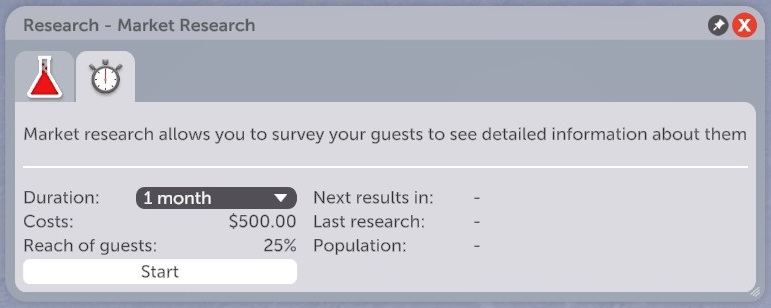
Before clicking the button that says 'start' to begin, you can select the duration of the market research
- 1 month
- reaches 25% of guests and costs $500
- 2 months
- reaches 50% of guests and costs $750
- 3 months
- reaches 75% of guests and costs $875
Once market research is started, it will show how much time in in-game months until it is completed as well as a progress bar. Once research is completed, it will show how much time has passed since, and how many people the survey reached. Also the results will come up at the bottom of the tab…
________________________________________________________________
Results: Satisfaction
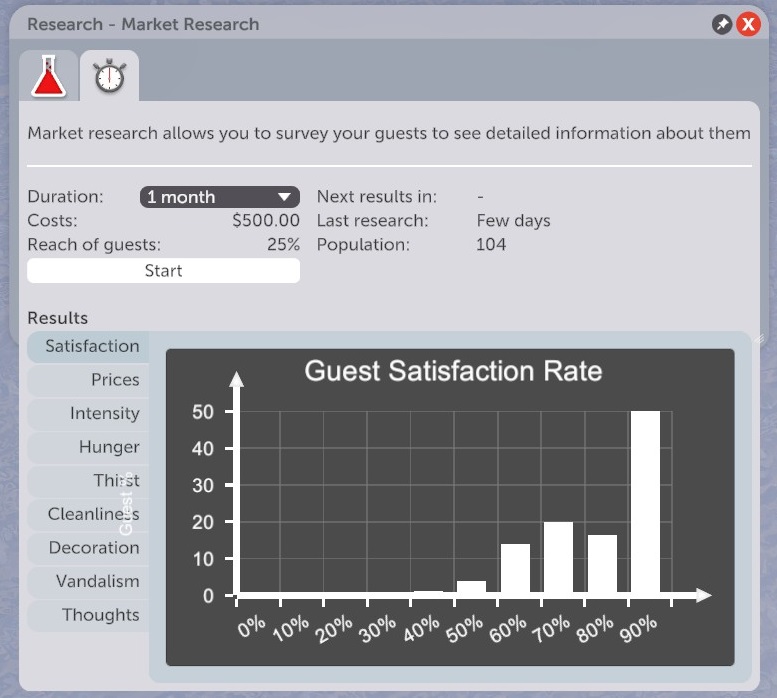
How satisfied surveyed guests are with the park overall. As you can see, a survey I just did reached 104 guests, and they are all shown on this graph based on how satisfied they were.
- 50 guests were at least 90% satisfied
- 17 were at least 80% satisfied
- 20 were at least 70% satisfied
- 14 were at least 60% satisfied
- 4 were at least 50% satisfied
- 1 was at least 40% satisfied
- nobody was less than 40% satisfied
- 50+17+20+14+4+1=104
More satisfied guests will stay in the park longer and spend more.
________________________________________________________________
Results: Prices
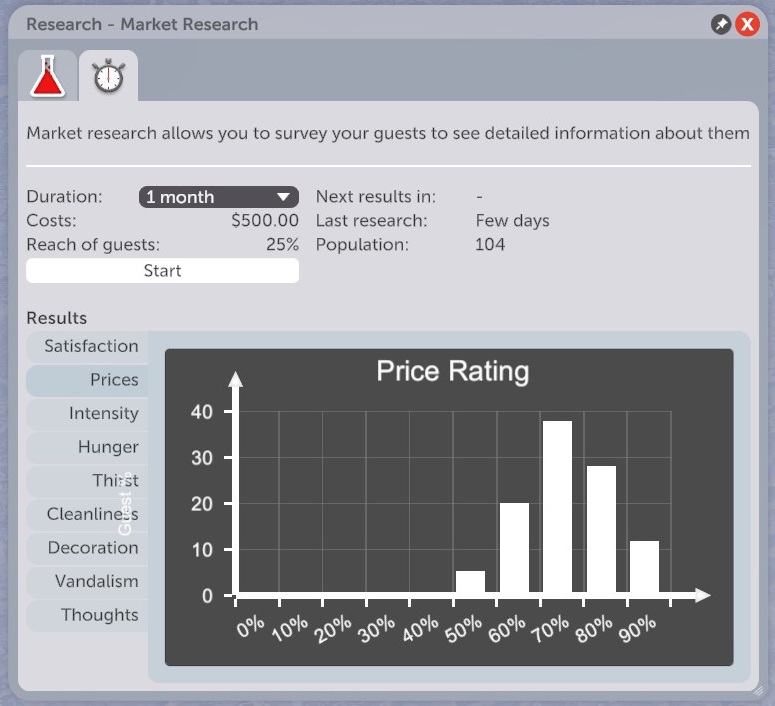
How satisfied surveyed guests were specifically with prices in the park.The graph shown here is probably about where you want these values to be. If there are lots of guests that aren't very satisfied with prices than it might be wise to lower some prices around the park. Look for things that the guests are thinking are too expensive or vice-versa (eg."I'm not paying that much for a burger!", "Carousel is a really good deal!", etc.).
________________________________________________________________
Results: Intensity
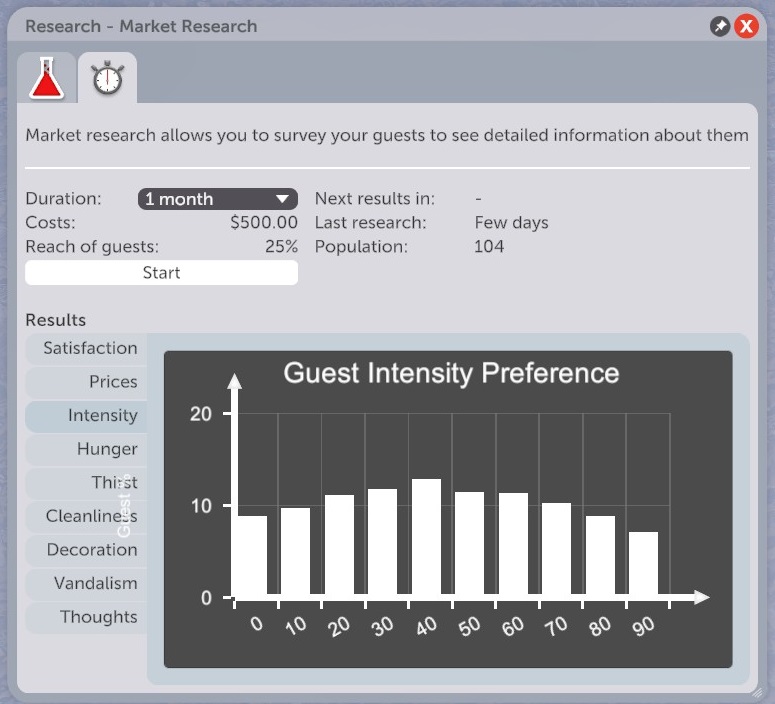
Shows the ride intensity preferences of surveyed guests. This is the most useful graph here, because the intensity preferences of guests vary from park to park. This graph can inform you of what kind of rides to focus on. According to this graph, the intensity preferences of guests in this park are slightly skewed in favour of lower intensities, but mostly balanced. If they were skewed more heavily in one direction or another, it would be smart to build more rides to satisfy those guests.
________________________________________________________________
Results: Hunger
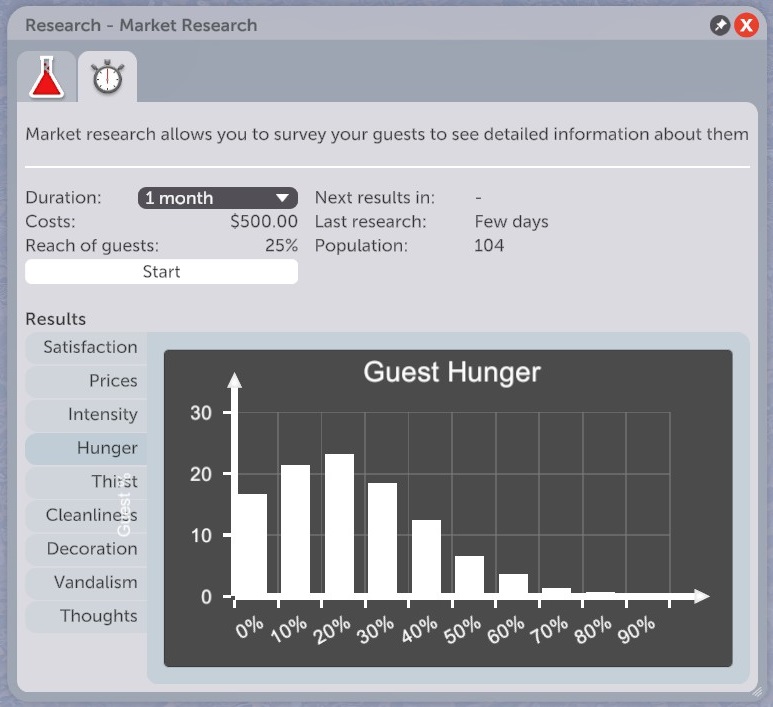
Shows how hungry surveyed guests are. If lots of guests are over 50% hungry, you probably need more food stalls. Guests get hungrier faster in some parks than in others.
________________________________________________________________
Results: Thirst
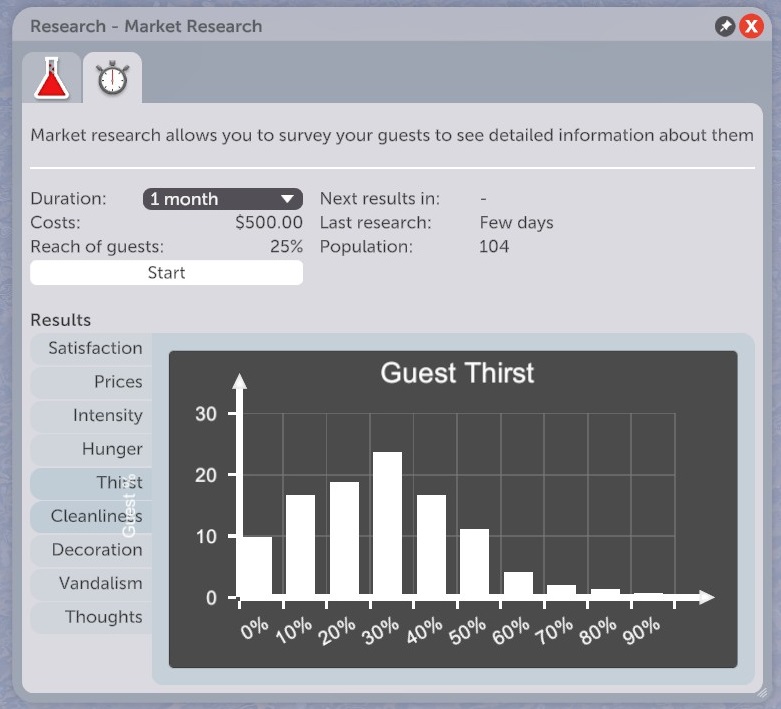
Shows how thirsty surveyed guests are. If lots of guests are over 50%, you probably need more drink stalls. Guests get thirstier faster in some parks than in others.
________________________________________________________________
Results: Cleanliness
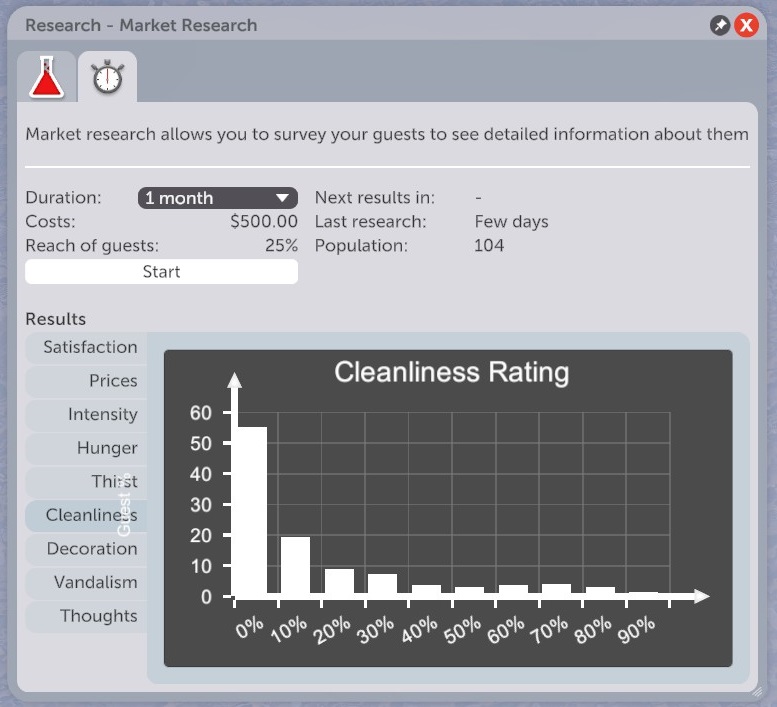
Shows how satisfied surveyed guests are with the cleanliness of your park. The park shown in the screenshot is terrible. Most guests should be above 80%, otherwise you probably need more janitors.
________________________________________________________________
Results: Decoration
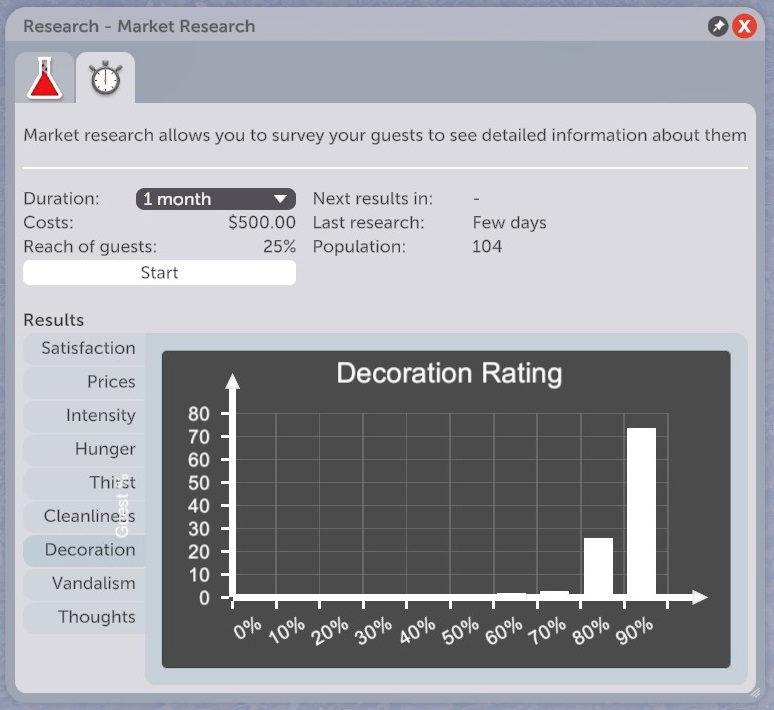
Shows how satisfied surveyed guests are with the decoration level in your park. In a well decorated park, most guests should be above 80%.
________________________________________________________________
Results: Vandalism
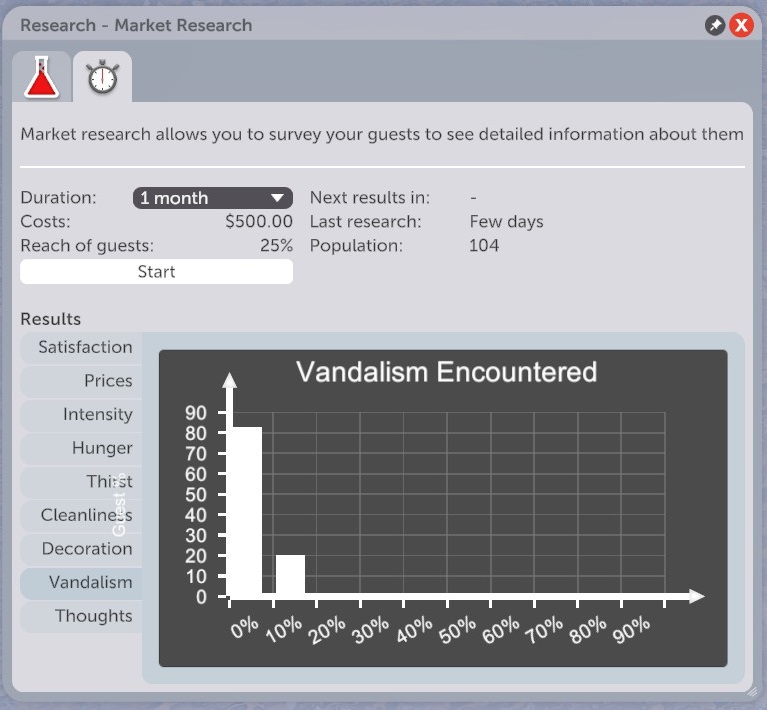
Shows how much vandalism was encountered by surveyed guests. Most guests should be below 20%, otherwise you may need more security and/or mechanics.
________________________________________________________________
Results: Thoughts
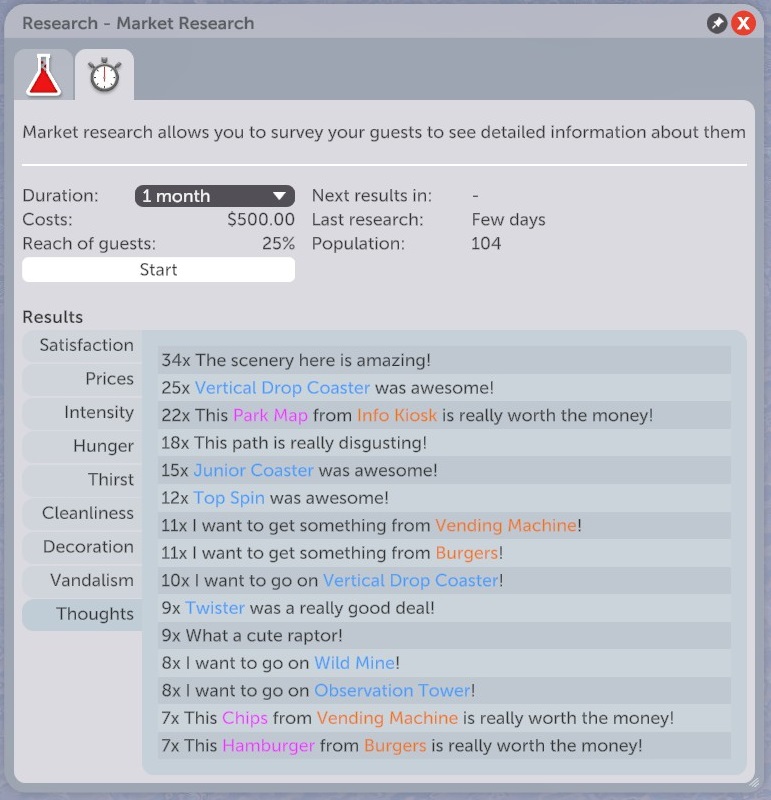
Shows thoughts that surveyed guests have had. The 34x beside the "Great scenery!" thought doesn't mean 34 guests had that thought, but rather that that thought happened 34 times among the 104 guests surveyed, because some guests might have thought it more than once.
FINANCE TAB
This tab contains lots of useful information regarding the financial health of your park. It also allows you to take out loans and run marketing campaigns. It has four sub tabs: finances, graphs, loans, and campaigns.
Finances
This sub tab contains a detailed monthly financial summary of the park's revenues and expenses.
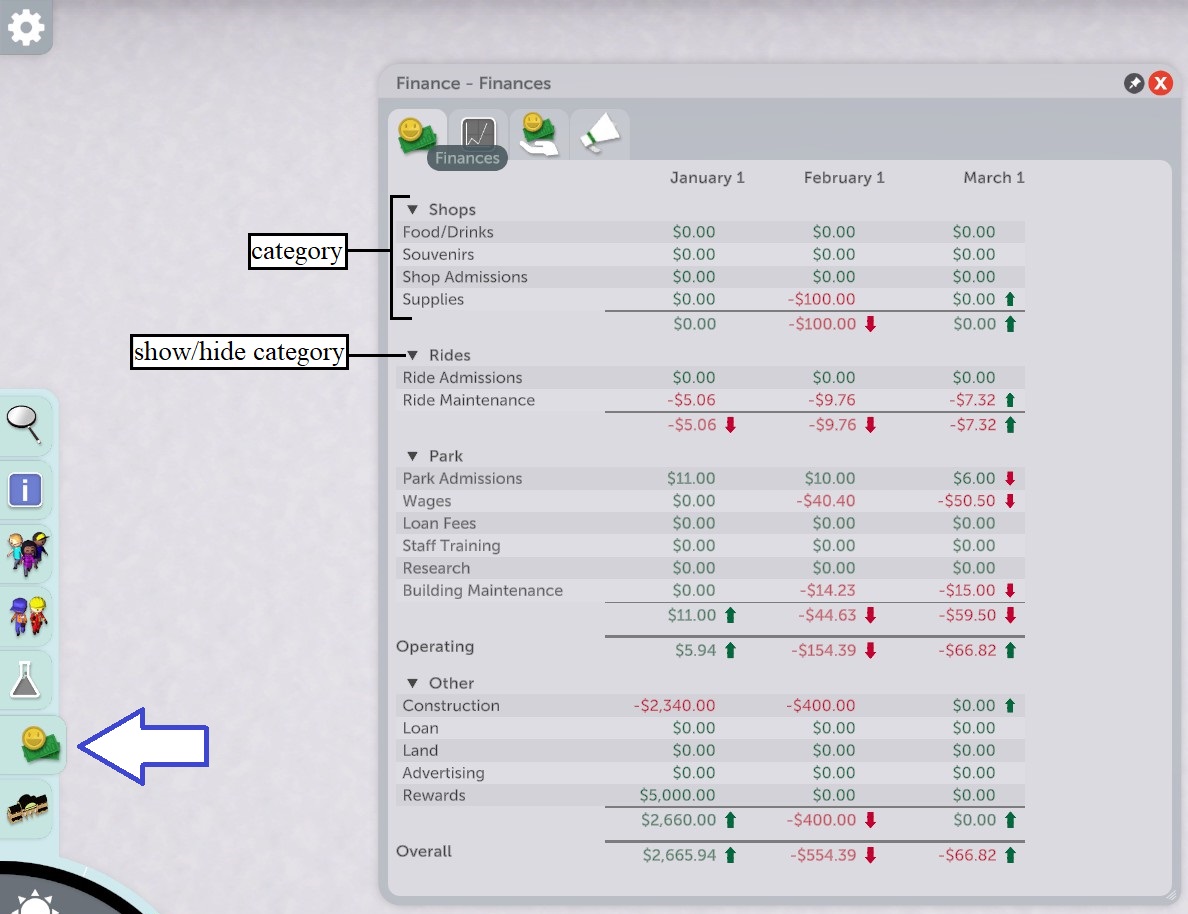
The current in-game month is shown at the right (in this case, March, Year 1). You can scroll to the left in the window to view more previous months (if there are any). Net expenses are shown in red with a '-' sign next to them, while net profits are green. Also there will be small green-up or red-down arrows next to the numbers to show an increase or decrease in profits respectively vs. the previous month. As you can see, profits/expenses are divided into four categories. At the bottom of each category the net profit from all the things in that category is shown. If the category is hidden, only this number will show. The first three categories represent operating expenses and profits. These profits and expenses represent monthly revenue and expenses gained passively from rides, shops, staff, etc. Underneath these operating categories the total net operating profit of the park is shown. The fourth category is related to one-time cash infusions or expenses (eg. loans, rewards, construction costs, etc.). At the bottom, the grand total of all profits and expenses is shown.
________________________________________________________________
Shops

Food/Drinks
- gross profit from selling food and drink items in shops
Souvenirs
- gross profit from selling souvenirs in shops
- includes park maps, umbrellas and on-ride photos
Shop Admissions
- gross profit from charging for toilets and first aid rooms (gross kind of works both ways here)
Supplies
- costs of purchasing stock for shops
- costs are applied whenever a shop orders more product (when a resource crate appears at the deliveries building or in a depot)
________________________________________________________________
Rides

Ride Admissions
- gross profit from guests paying for rides
Ride Maintenance
- costs associated with ride upkeep
- these costs are fixed monthly and unrelated to mechanics doing maintenance, which doesn't cost anything
________________________________________________________________
Park

Park Admissions
- profit from guests paying the park entrance fee
Wages
- costs of park staff salaries
Loan Fees
- interest paid on outstanding loans (more on loans in a bit)
Staff Training
- costs from training staff in the staff training room
Research
- costs from research teams and market research
Building Maintenance
- costs from maintaining staff facilities, depots, trash chutes, and shops
________________________________________________________________
Other

Construction
- costs from building rides, placing shops, deco objects, etc.
- refunds from deleting previously placed or built objects
Loan
- money added from loans
- money subtracted from repaying loans (not interest)
Land
- money spent on land purchases
Advertising
- money spent on marketing campaigns
Rewards
- money rewarded from completing scenario objectives
Graphs
This sub tab shows graphs for monthly profit, park rating, and population (guests in the park).
Finances
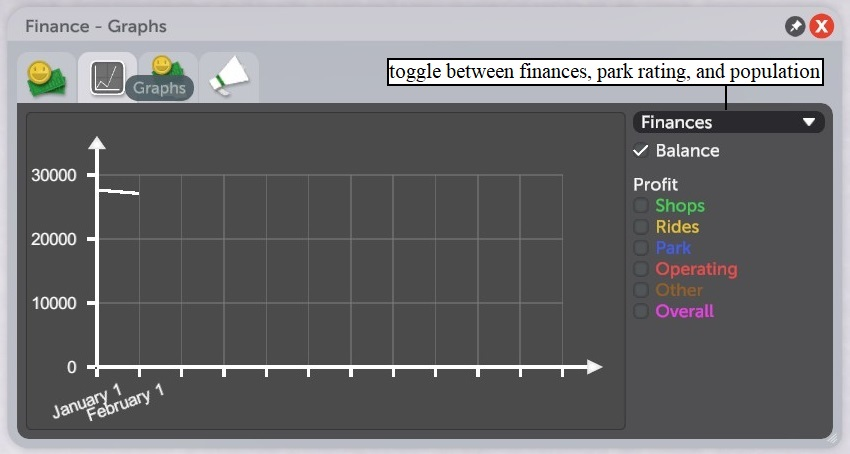
Show trends of your balance (how much money you have to spend) as well as the net profit of some of the things I discussed earlier. Tick one of the tick boxes on the right to show its line on the graph. Currently shown in the picture is the park balance, which dropped slightly in January and is now around $27 000.
________________________________________________________________
Park Rating

Show park rating trends. The graph in the picture is showing the overall park rating, which is holding steady between 85% and 90%.
________________________________________________________________
Population
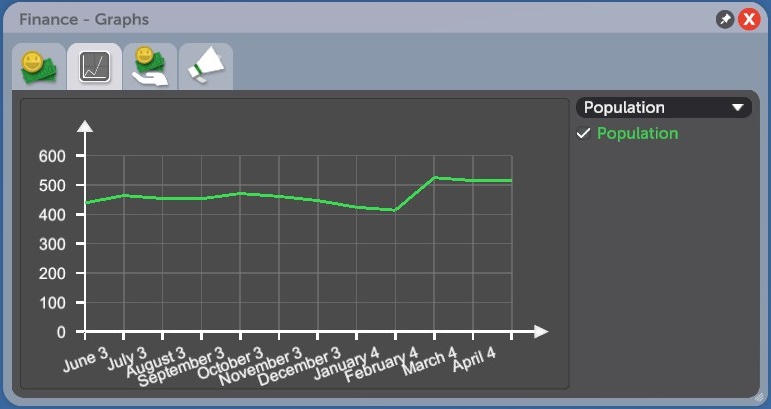
Show guest count trends. This graph shows that the guest count is holding steady just above 500 after a small rise in February, Year 4.
Loans
This sub tab allows you to take out and manage loans. In some scenarios loans are disabled. If that is the case, this sub tab will be blank. It shows a list of four loans of different amounts. Loans are not automatically repaid over time, and will continue to cost money every month until they are manually repaid.
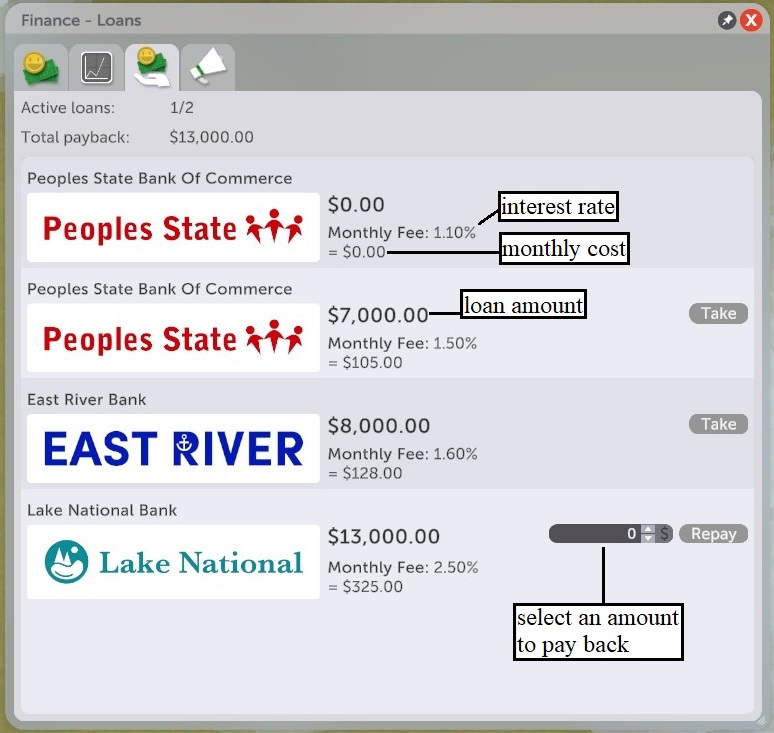
The loan at the top has been recently repaid, and the one at the bottom is active. To take out a loan, simply click the button that says 'take' on one of the loans.
Active loans
- how many loans that you have taken out and not repaid
- you can't have more than two loans active at the same time
Total payback
- total amount of money you owe
interest rate
- percentage of the loan's value that must be paid every month that this loan is active
monthly cost
- monthly cost calculated from the interest rate
loan amount
- this loan's value (how much money you get when you take out this loan, and how much you have to pay to pay it back)
select an amount to pay back
- click here to pay back part or all of this loan
- select an amount to pay back; can be done by:
- clicking and scrolling the mouse wheel
- clicking and entering a number on your keyboard
- clicking those tiny arrows to the right of the amount
- then press enter on your keyboard or click 'repay'
- select an amount to pay back; can be done by:
- the monthly cost of this loan will be recalculated once part of this loan is repaid (eg. if $3000 were repaid, the remaining amount would be $10 000, and the monthly fee would now be $250.
FINANCE TAB– cont.
Campaigns
This sub tab allows you to run advertising campaigns for your park or individual attractions.

Starting a campaign
ad type
- click to choose whether you want to run a(n):
- attraction advertisement campaign
- the selected ride will have an increase in customers while the campaign is active
- shop advertisement campaign
- the selected shop will have an increase in customers while the campaign is active
- park advertisement campaign
- more guests will show up at the park entrance while this campaign is active
- useful for meeting guest number related scenario goals
- free ride voucher campaign
- offer vouchers for one free ride on a selected ride
- the selected ride will have an increase in customers while the campaign is active
- cheaper than the attraction advertisement campaign, but guests with vouchers don't have to pay for their first ride on the selected ride, often resulting in temporarily reduced profit for the selected ride, unless the selected ride was already running well below capacity
- free shop product voucher campaign
- offer vouchers for one free product from a selected shop
- selected shop will have an increase in customers while the campaign is active
- cheaper than the shop advertisement campaign, but guests with vouchers don't have to pay for their first purchase from the selected shop, often resulting in temporarily reduced profit for this shop
- free park entrance voucher campaign
- more guests will show up at the park entrance while this campaign is active
- useful for meeting guest number related scenario goals
- cheaper up front than a park advertisement campaign, but will often cost more in the long run from lost park entrance fees
- attraction advertisement campaign
select attraction
- for shop or ride related campaigns, click this, then click on a shop or ride you wish to be the subject of this advertising campaign
length
- choose how long you want an advertising campaign to last
- longer campaigns mean a longer duration of positive effects but cost more
- length options vary depending on the ad type
medium
- click to select the medium in which to run this ad
- options are:
- flyers
- bus stops
- radio
- billboards
- social media
- television
- options further down the list cost more but are more effective
- this doesn't apply to voucher campaigns
focus
- shows what will be advertised once a campaign is ready to begin
cost
- how much this campaign will cost up front
________________________________________________________________
Running Campaigns
time remaining
- time remaining before this in-progress campaign ends
- shown as in-game months remaining and a progress bar
________________________________________________________________
Ended Campaigns
effectiveness
- how effective this expired campaign was
- higher percentages mean it was more effective
PARK INFO TAB
Contains some information and statistics about the park, what guests opinions are of it, and information about scenario goals. There are five sub tabs: State, Park Rating, Opinions, Statistics, and Goals.
State
This sub tab is where you can change the park entrance fee (if the scenario allows), and open or close the park. Scenario goals are also shown.
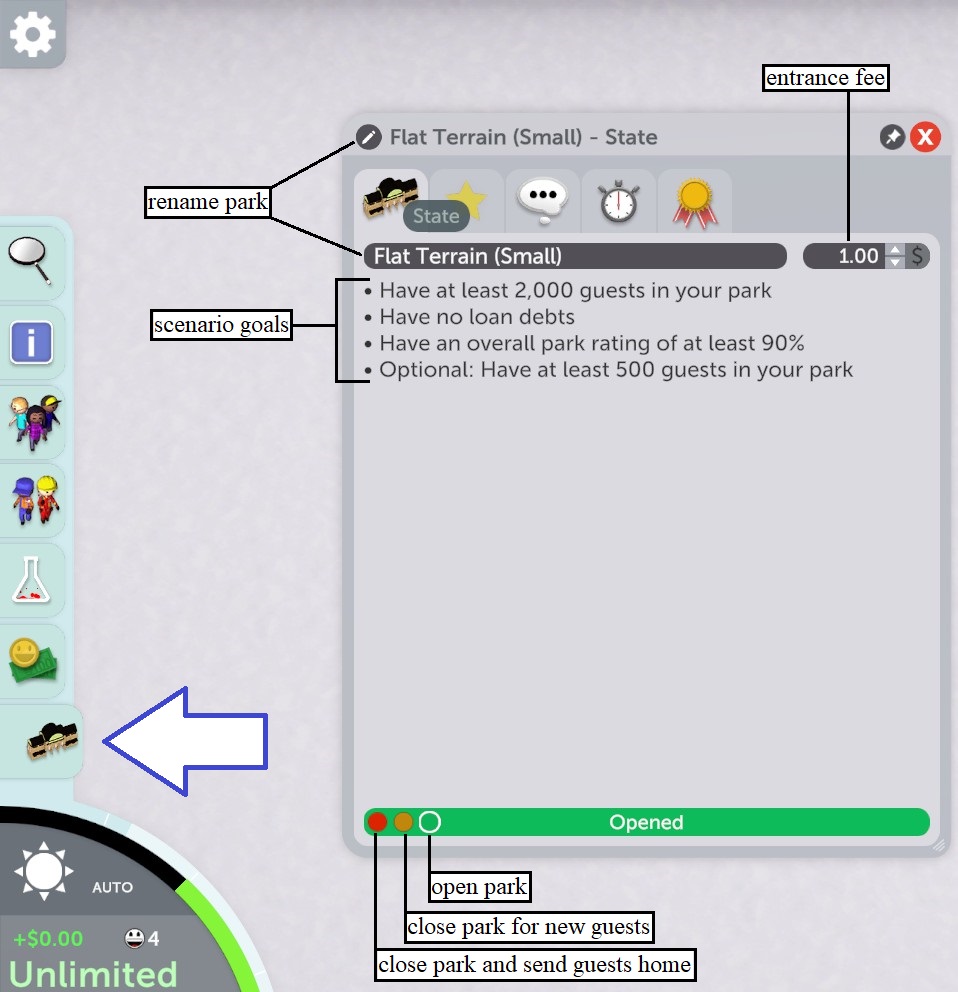
entrance fee
- click here to adjust how much guests have to pay to enter the park
- can be adjusted three ways:
- click on the number and scroll the mouse wheel while hovering over it
- click on the number and type in a new one on your keyboard
- click on the tiny arrows next to the number
- can be adjusted three ways:
- some scenarios don't allow you to charge an entrance fee
- if this is the case, this will be greyed out and locked at zero
- as you build more rides you will be able to charge more
- pay attention to what guests entering the park are thinking
- if some guests are thinking that the park entrance fee is a good deal, you can raise the price
- if some guests are refusing to pay the entrance fee and not entering the park, you should lower the price
- over time you will get better at figuring out how much you can charge
- general rule of thumb I go by is a $5.00 increase for each new flat ride or non-coaster track ride, and a $10.00 increase for each coaster
- this is only a loose guideline, you should still watch guests thoughts about the entrance fee
- general rule of thumb I go by is a $5.00 increase for each new flat ride or non-coaster track ride, and a $10.00 increase for each coaster
- it is a good idea to click on a few guests that haven't yet entered the park to see how much money they have, and then make sure not to charge more than this; otherwise, some guests won't be able to enter the park
- charging for ride admissions and entrance fee can get complicated
- charging more for ride admissions will make guests less willing to pay a higher entrance fee and vice-versa
- I recommend only charging for one or the other
- pay attention to what guests entering the park are thinking
rename park
- click either the little pencil icon or where it says 'Flat Terrain (Small)' (the park's name) in the dark grey area and enter a new one to change the name of your park
scenario goals
- the goals that must be achieved to complete this scenario
- some scenarios also have a short description here
- more information is shown in the Goals sub tab
open park
- click the green circle to open the park (the park in the picture is currently open)
close park for new guests
- click the yellow circle to close the park for new guest arrivals, but allow guests already in the park to stay
close park and send guests home
- click the red circle to close the park for new arrivals and force all guests in the park to leave
Park Rating
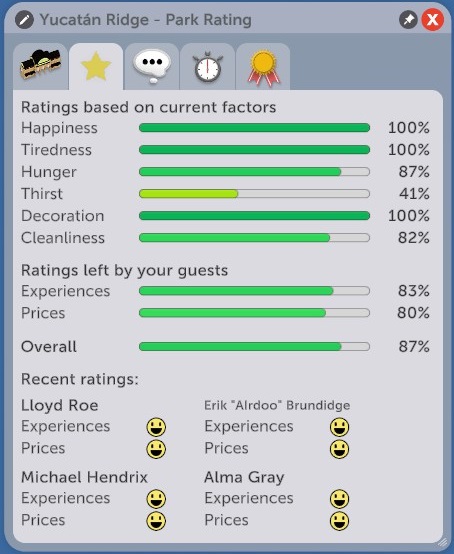
This sub tab shows factors affecting the park rating. This is important, because a higher park rating means that more guests will be attracted to the park.
________________________________
Ratings based on current factors
These are the six main factors that affect the park rating. As you can see, these are:
- Happiness (currently at 100%)
- Tiredness (currently at 100%)
- Hunger (currently at 87%)
- Thirst (currently at 41%)
- Decoration (currently at 100%)
- Cleanliness (currently at 82%)
According to these factors, many guests in this park are happy, very few are tired, most are satisfied with the food shop options, a lot are unsatisfied with the drink shop options, many think the park is well decorated, and many think that the park is clean. Placing more drink stalls would improve the thirst indicator (which is this park's biggest weakness), and thus increase the park rating.
________________________________________________________________
Ratings left by your guests
These ratings are affected by guests who have recently left the park. These ratings also affect the park rating. As you can see, these are:
- Experiences (currently at 83%)
- how satisfied guests are with the rides in the park
- guests will only be satisfied by rides that are within their intensity preference (eg. a guest that prefers low intensity rides will leave a bad experience rating if there are only high-intensity rides in the park)
- Prices (currently at 80%)
- how satisfied guests are with prices in the park
- if this is low you may want to look for complaints about high prices
According to these factors, many guests leaving this park are satisfied with the ride options and the prices in the park.
________________________________________________________________
Overall
This is the overall park rating. Essentially it is an average of the ratings based on current factors and the ratings left by your guests. A higher park rating means more guests will be attracted to the park.
________________________________________________________________
Recent ratings:
These are the four most recent experience and price ratings left by guests. A happy face indicates that a guest left a good rating, a neutral face indicates they were neither highly satisfied nor dissatisfied, and a sad face indicates they were dissatisfied. In the park shown in the picture, the four most recent guests to leave the park all left good price and experience ratings.
Opinions

This sub tab shows thoughts of guests in the park related to things that affect the park rating. There is also a bar at the top indicating the overall satisfaction of guests in the park. As you can see, this park's problem with a lack of drink stalls is also evident here, with thirteen guests thinking: "Where can I get something to drink around here?".
PARK INFO TAB– cont.1
Statistics
This sub tab shows various statistics about your park. Not all of these statistics are available in all scenarios; some may need to be researched. These statistics are divided into five categories: Guests, Employees, Attractions, Shops, and Money.
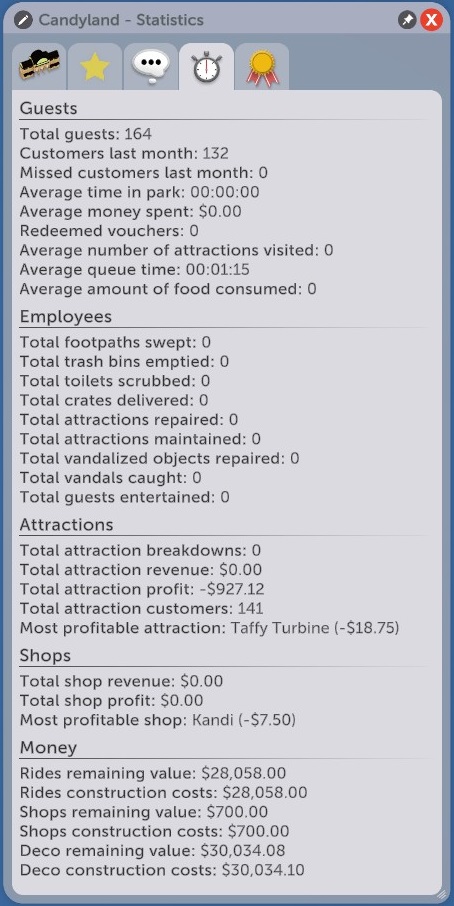
________________________________
Guests
Various guest-related statistics.
Total Guests
- total number of guests that have visited your park
- includes guests currently in the park
Customers last month
- total number of guests that entered the park last month
Missed customers last month
- total number of guests that appeared on the guest spawn point but didn't enter the park last month
- usually this is due to an entrance fee
that is too expensive
- usually this is due to an entrance fee
Average time in park
- the average amount of time that guests are spending in the park
Average money spent
- the average amount of money that each
guest is spending on your park during their visits
Redeemed vouchers
- total number of advertising campaign vouchers that have been redeemed by guests
Average number of attractions visited
- average number of rides each guest is going on during their visits
- includes repeat rides on the same ride
Average queue time
- the average amount of time guests are waiting in lines before riding rides
Average amount of food consumed
- the average number of food/drink items that are consumed by your guests during their visits
________________________________________________________________
Employees
Various statistics related to employees.
Total footpaths swept
- total number of times janitors have swept up litter or vomit
Total trash bins emptied
- total number of times janitors have emptied trash bins
Total toilets scrubbed
- total number of times janitors have cleaned toilets buildings
Total crates delivered
- total number of crates that have been delivered to shops by haulers
Total attractions repaired
- total number of times rides have been fixed by mechanics after breaking down
Total attractions maintained
- total number of times rides have been maintained by mechanics
Total vandalized objects repaired
- total number of times that vandalized path deco objects (benches, trash bins, etc.) have been repaired by mechanics
Total vandals caught
- total number of times that vandals have been banned from the park by security guards
- manually banning guests doesn't count towards this statistic
Total guests entertained
- total number of times that guests have gotten a happiness boost from entertainers
________________________________________________________________
Attractions
Various ride-related statistics.
Total attraction breakdowns
- total number of times rides have broken down
Total attraction revenue
- total gross revenue from rides
Total attraction profit
- total net profit from rides (total gross revenue minus expenses)
Total attraction customers
- total number of times guests have ridden rides
Most profitable attraction
- the ride in the park that has made the most money since it was built
- this ride's total profit is shown in brackets
________________________________________________________________
Shops
Statistics related to shops. Includes toilets, first aid rooms and ATMs.
Total shop revenue
- total gross revenue from shops
Total shop profit
- total net profit from shops (total gross revenue minus expenses)
Most profitable shop
- the shop in the park that has made the most money since it was built
- this shop's total profit is shown in brackets
________________________________________________________________
Money
Various statistics related to the value of items placed in the park.
Rides remaining value
- how much money you would get back if you deleted all rides in the park
- note that pre-built rides that come with a park or scenario count towards this number even though they don't give a refund when they are deleted
- a ride's value starts the same as what it cost to build, then decreases over time
Rides construction costs
- how much it cost to build all rides in the park
- includes pre-built rides
Shops remaining value
- how much money you would get back if you deleted all shops in the park
- note that pre-built shops that come with a park or scenario count towards this number even though they don't give a refund when they are deleted
- a shop's value starts the same as what it cost to build, then decreases over time
Shops construction costs
- how much it cost to build all shops in the park
- includes pre-built shops
Deco remaining value
- how much money you would get back if you deleted all deco objects in the park
- note that pre-built deco objects that come with a park or scenario count towards this number even though they don't give a refund when they are deleted
- the value of deco objects starts the same as what it cost to build, then decreases over time
Deco construction costs
- how much it cost to place all deco objects in the park
- includes pre-built deco objects
PARK INFO TAB– cont.2
Goals
This sub tab lists the objectives of the scenario or park, and your progress toward completing them.
There are main goals and optional goals. If the scenario you are playing is part of one of Parkitect's campaigns, then the main goals must be completed to advance in the campaign. The optional goals are meant to be an additional challenge, and are usually either an added restriction such as an optional time limit for completing the main goals, or an optional objective that grants a reward when completed. If applicable, each incomplete goal has its own progress bar to show how close you are to completing it. Each goal has a face icon indicating if it is complete/fulfilled (yellow smiling face), yet to be completed (neutral grey face), or can no longer be completed (blue sad face).
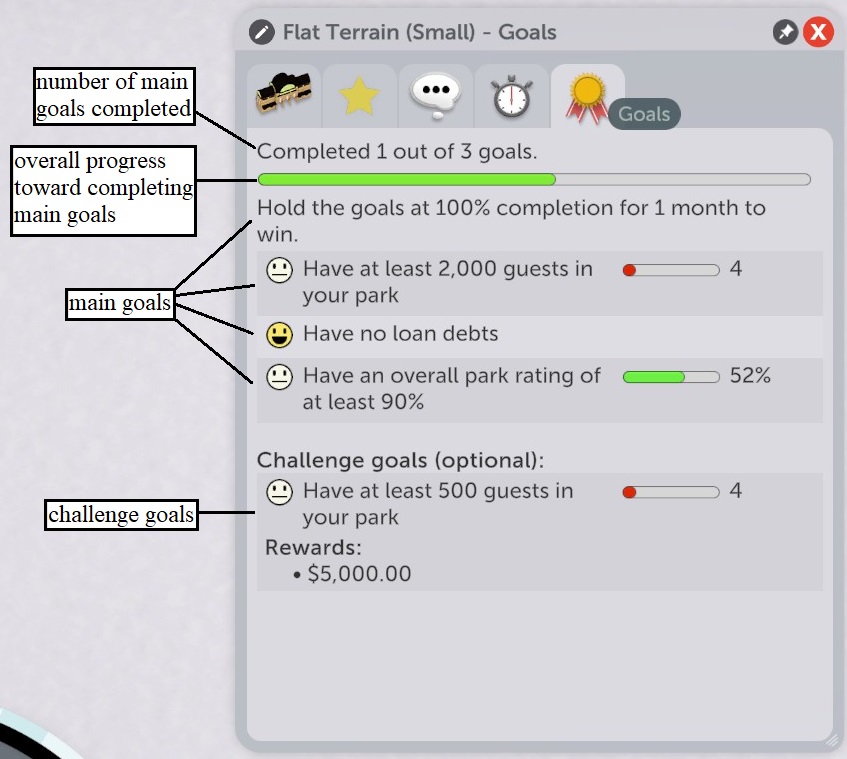
As you can see in the picture, this park has three main goals:
- Have at least 2000 guests in your park (there are only 4 guests currently)
- Have no loan debts (currently fulfilled, will become incomplete if you take out a loan)
- Have an overall park rating of at least 90% (park rating is currently 52%)
- there is also a requirement to hold the main goals at completion for one month
- this means that once these three goals are complete, a timer starts that lasts one in-game month
- if any of these three goals becomes incomplete while the timer is going, it will reset, and won't start again until they are all complete again
- while this timer is going, a large green progress bar will appear at the top of your screen to show its progress (whether this tab is open or not)
- this means that once these three goals are complete, a timer starts that lasts one in-game month
This park also has one challenge goal:
- Have at least 500 guests in your park (provides a $5000.00 reward when it is completed)
List of possible goals scenarios can have:
- Have at least x number of guests in the park
- Sell at least x number of park tickets
- park tickets are "sold" whenever a guest enters the park
- you don't need to charge an entrance fee for this to work
- Own at least x tiles of land
- you will have to buy land using the terraformer tab to achieve this (see the terraformer tab section of this guide for more information)
- Have at least x number of coasters in the park with an excitement rating of at least y
- remember that excitement ratings of coasters can fluctuate a little bit over time
- Have at least x number of coasters in the park with an intensity rating of at least y
- remember that intensity ratings of coasters can fluctuate a little bit over time
- Have a decoration rating of at least x%
- Have an experiences rating of at least x%
- this can be hard to maintain because it depends on the experiences of a few guests leaving the park
- make sure there are rides in the park with different intensity ratings so all guests are satisfied
- Have a cleanliness rating of at least x%
- Have a happiness rating of at least x%
- Have a price satisfaction rating of at least x%
- Have an overall park rating of at least x%
- Have no loan debts
- Have at least x amount of money
- Have an operating profit of at least x dollars per month
- Have a profit from rides of at least x dollars per month
- Have a profit from shops of at least x dollars per month
- No tracked ride blueprints
- you will have to custom-build all tracked rides (including coasters) yourself to achieve this
- a confirmation warning window will pop up if you try to build a tracked ride blueprint in a scenario with this goal
- blueprints that contain only scenery, flat rides, and shops are still safe to use
- this is always an optional goal
- No building while the game is paused
- you cannot place or build anything while the game is paused if you want to achieve this goal
- a confirmation warning window will pop up if you try to build while the game is paused in a scenario with this goal
- it is still safe to do anything other than building (changing prices, hiring staff, etc.) and you can still use the tools in the terraformer tab
- this is always an optional goal
- Complete all non-optional goals by a certain in-game date
- all campaign scenarios have this as an optional goal
- many scenarios also have a requirement to maintain all non-optional goals at 100% completion as I explained earlier
List of possible rewards for completing individual goals:
- Cash
- Unlock unresearched items for use
- Unlock unowned land for expansion of your park for free
RIDES TAB
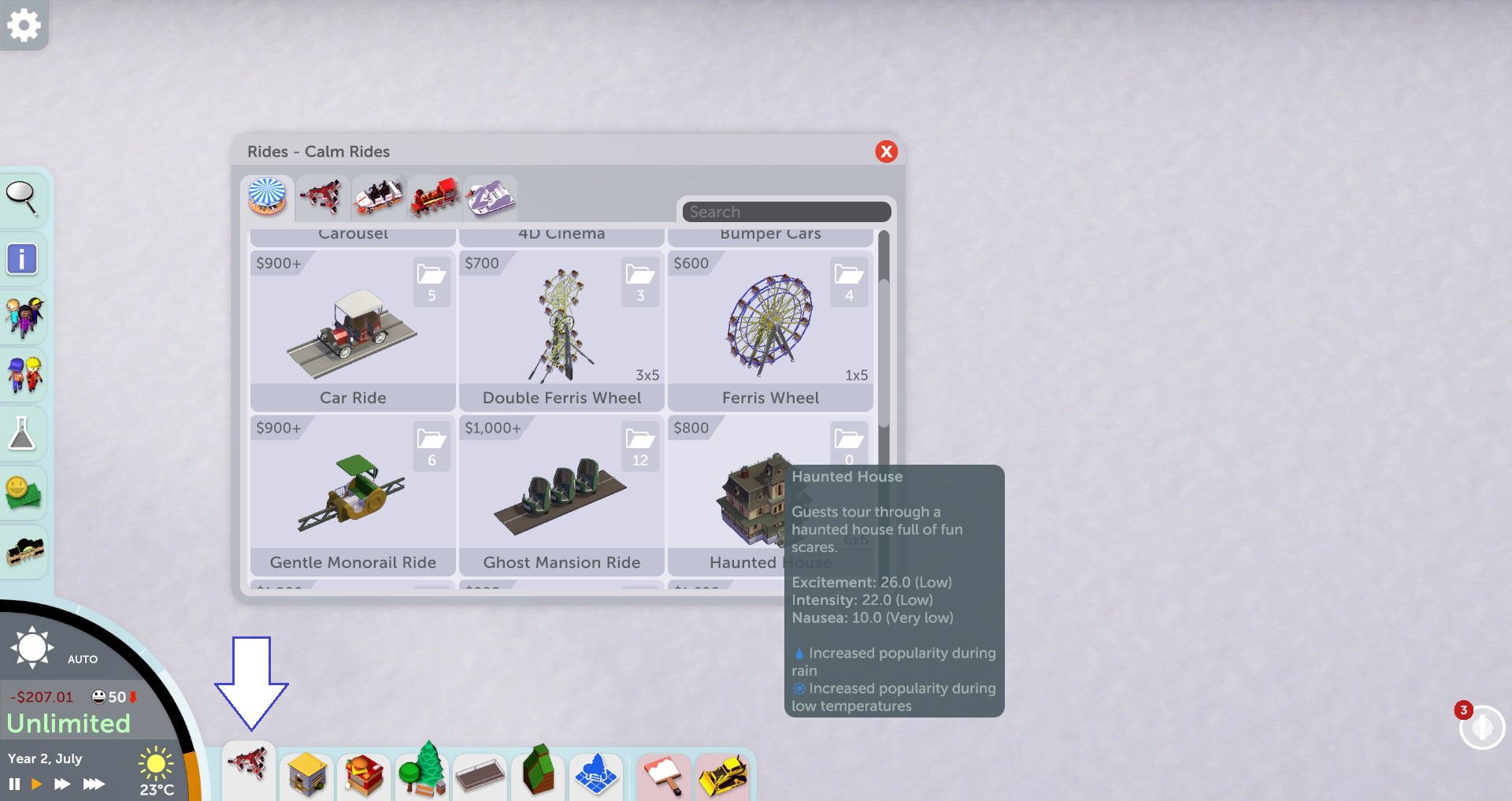
This tab is where you go to select a ride to build in your park. For more information about ride construction, see the ride construction section of this guide. It can also be opened with a hotkey (F1 by default). There are five sub tabs for the five different kinds of rides:
- Calm Rides
- Thrill Rides
- Coasters
- Transport Rides
- Water Rides
In addition, all rides are either flat rides, tower rides, track rides, or boat rides.
flat rides
- have a fixed footprint, size, and cost
- cost can increase slightly if the ride is placed higher than ground level or below ground
- have mostly fixed excitement, intensity, and nausea ratings
- these can be often be tweaked in the ride's settings
- examples: carousel, ferris wheel, twister, 4D cinema
tower rides
- similar to flat rides, but have a tower with a customizable height
- cost, excitement, intensity, and nausea increase as you make them taller
- examples: observation tower, gyro drop tower, elevator
track rides
- have a customizable track layout with dedicated station(s) for loading and unloading passengers
- excitement, intensity, and nausea ratings are variable depending on the layout
- examples: car ride, go carts, boat dark ride, log flume, all coasters, all transport rides except elevators
boat rides
- consist of an extendable station/dock placed on a body of water
- the body of water cannot be at a height level that ends with .25 or .75
- riders operate boats themselves and can move freely around the water body
- buoys and paths can be used to restrict where guests may go (buoys are available in the deco tab under props > water)
- have a fixed cost no matter how long the station is
- examples: paddleboats, bumper boats, rowboats
Calm Rides
These rides have low intensities and usually have low nausea ratings. Your parks should usually have a couple of these rides to cater to scaredy-cat guests who prefer lower intensities.
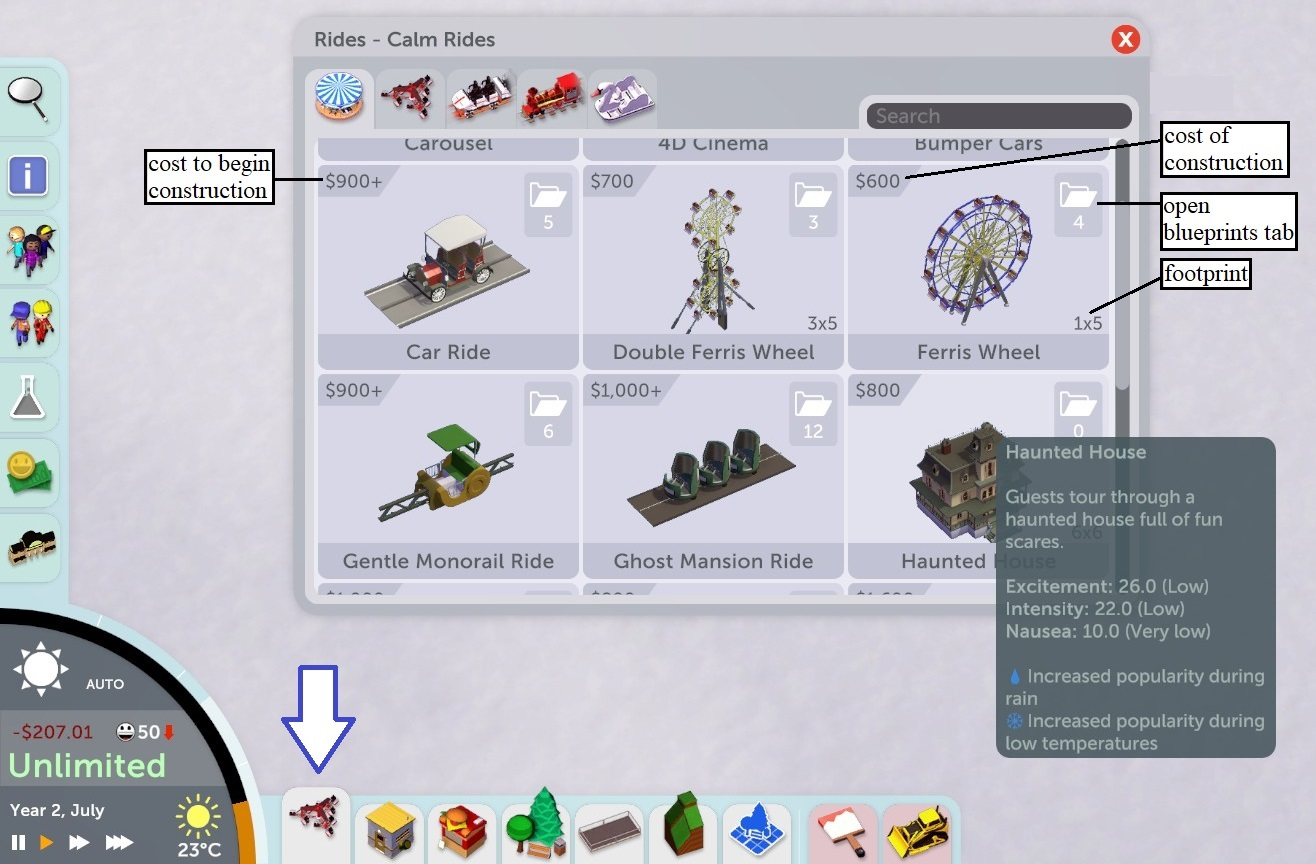
Hovering over a ride will show additional information about it (Haunted House is currently being hovered over). This information includes a brief description, excitement, intensity and nausea values (for flat and tower rides only), and if it is more popular in rain, high temperatures, or low temperatures. Click on a ride to build it.
cost to begin construction (prices with a '+')
- this is shown for track rides, and is only the cost of beginning construction
- this cost is assessed when placing the first piece of station for a new ride when custom building it
- the '+' after the price is to show that each track segment you build will cost extra
- even though boat rides have the '+', their cost is fixed.
cost of construction (prices without a '+')
- this is the cost of placing a flat ride or tower ride
- increasing the height of tower rides costs extra
open blueprints tab
- shows how many blueprints are available that contain this ride
- click to open up a section of the blueprints tab with all blueprints that contain this ride (see the blueprints tab section of this guide for more information)
footprint
- the length and width of a flat ride or tower ride's base
- some rides extend beyond their footprints while in operation (for example, the pirate ship ride swings two tiles beyond its footprint in either direction)
Thrill Rides
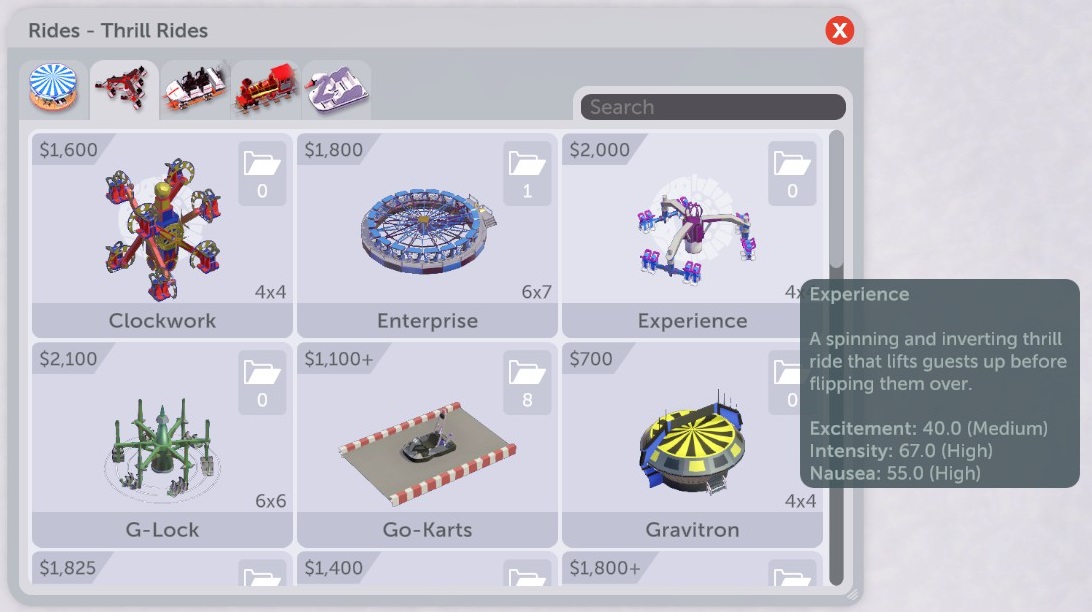
These rides are more intense and exciting than calm rides, and tend to have higher nausea ratings. Everything works the same as it does in the calm rides sub tab so I won't go into further detail.
Coasters
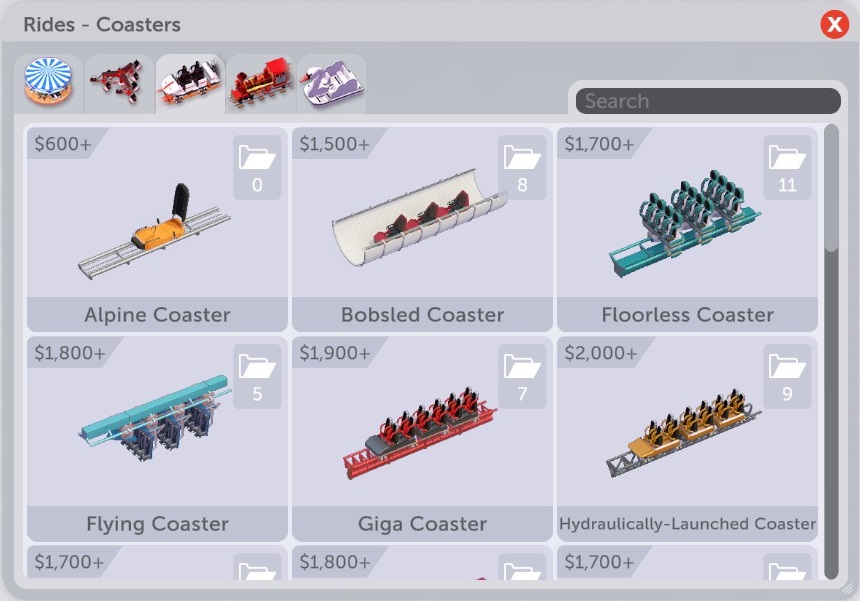
These rides come in all shapes and sizes. Some are good for low intensities, while others can be made with huge drops and/or inversions with high intensities. Coasters are the biggest money-makers and if you aren't building any you aren't going to be very successful. All coasters are track rides.
Transport Rides
\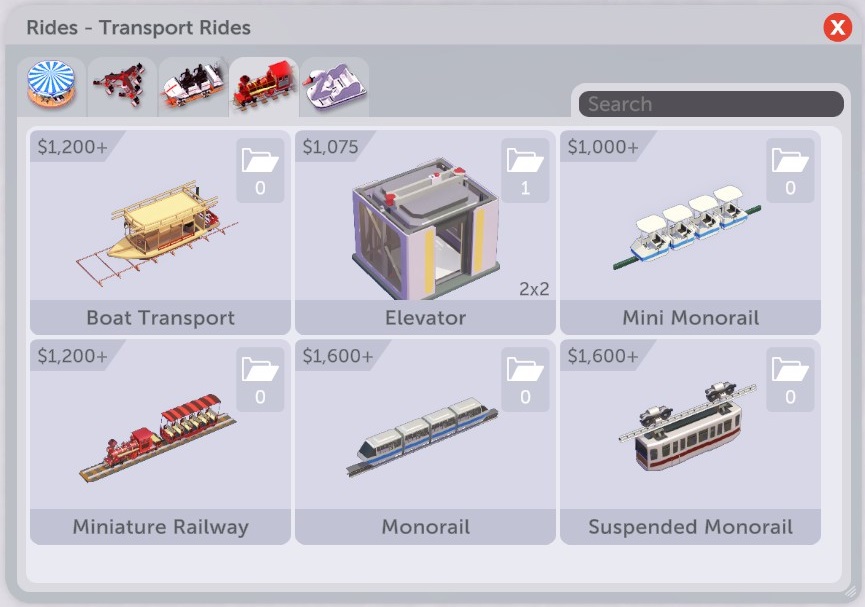
These rides are useful for moving guests around your park if you build them with multiple stations, or you can build them with only one station, in which case they will act as a calm track ride. Guests that are heading for a particular ride may use a transport ride to get there if it is convenient, or they may ride for fun. All transport rides are track rides except for the elevator, which is built like a tower ride but it has a second station platform at the top so that guests can use it to travel vertically from a lower part of your park to a higher part or vice-versa.
Water Rides
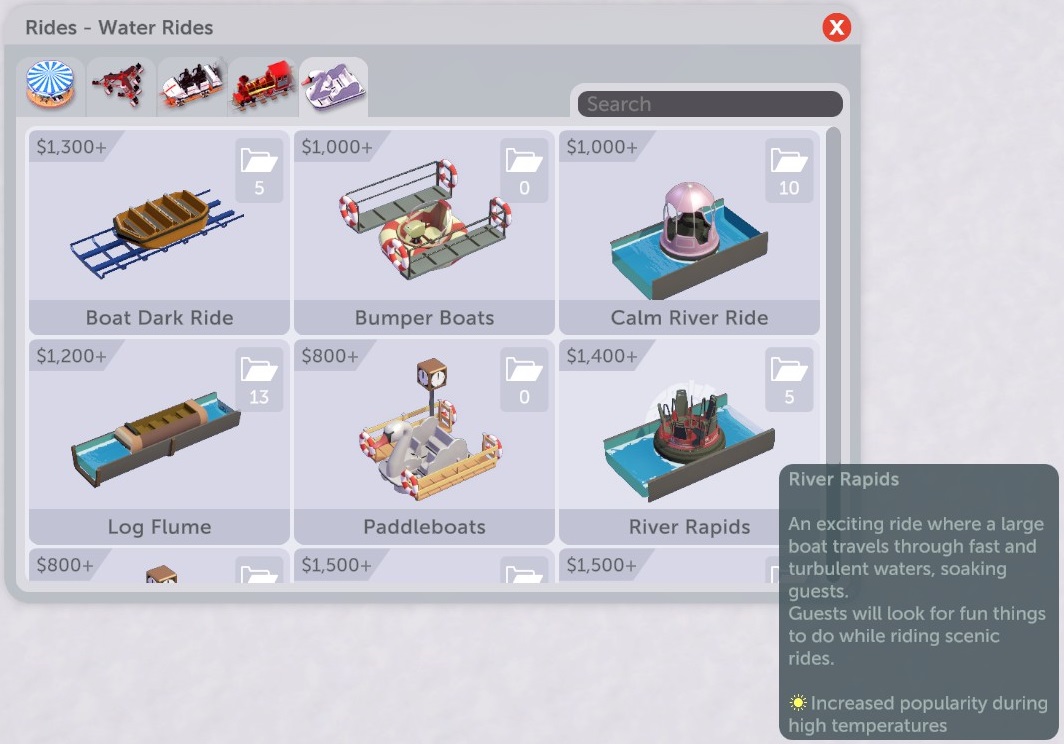
These are rides that involve water. Some are track rides with cars/boats that traverse a water channel or a track with watery sections. There are also boat rides such as the paddleboats. The submarines are essentially a calm track ride that can be built underwater in a water body. Many of these rides (especially the ones that get their riders wet) are more popular during periods of in-game warm weather.
RIDES
This section is about the window that pops up when a ride is clicked on. There are seven sub tabs:
- State
- Settings
- Statistics
- Graphs (track rides only)
- Revenue
- Opinions
- Tasks
State
This sub tab contains some information about the ride and some ways to manage it. The number of guests on the ride and the number of guests queuing is shown.
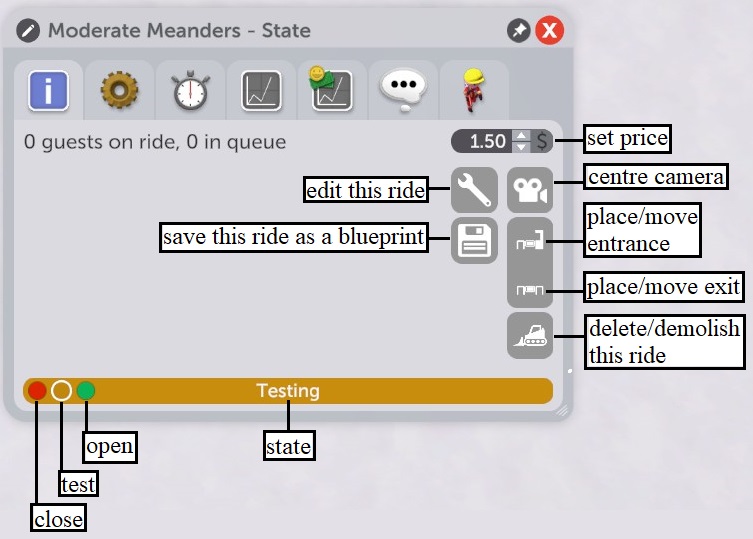
close/test/open
- use these buttons to close, test, or open the ride (the ride in the diagram is currently in testing mode)
- it is recommended to test a ride (especially a track ride/coaster) before opening it to ensure that it has good ratings and doesn't crash or get stuck
- your park rating will suffer if guests die in a crash
- some of the ride's settings can't be changed while it is open
- it is recommended to test a ride (especially a track ride/coaster) before opening it to ensure that it has good ratings and doesn't crash or get stuck
state
- whether the ride is open, testing, closed, or broken down is shown here
- if it is broken down, the reason for the breakdown will be shown here in brackets (struck by lightning, restraints stuck open, etc.)
edit this ride
- click to open up this ride's construction window to edit it (see the ride construction section of this guide for more information)
- only available for track rides
save this ride as a blueprint
- click this to save this ride as a blueprint
- once you save a ride, you can go into the blueprints tab and place it however many times you want in any park that has its ride type researched
- creating blueprints this way won't include any scenery with the ride
- to include scenery with a ride blueprint you will need to create a blueprint from within the blueprints tab (see the blueprints tab section of this guide for more information)
- this is only available for track rides; saving flat rides with scenery can only be done in the blueprints tab
set price
- the price of admission for this ride
- there are three ways to change it:
- click on the number and type in a new number on your keyboard
- click on the number and scroll the mouse wheel
- click on the two tiny arrows to the right of the number
- some parks don't allow charging for rides, in which case the price will be zero and greyed out
centre camera
- centre the camera on (go to) this ride
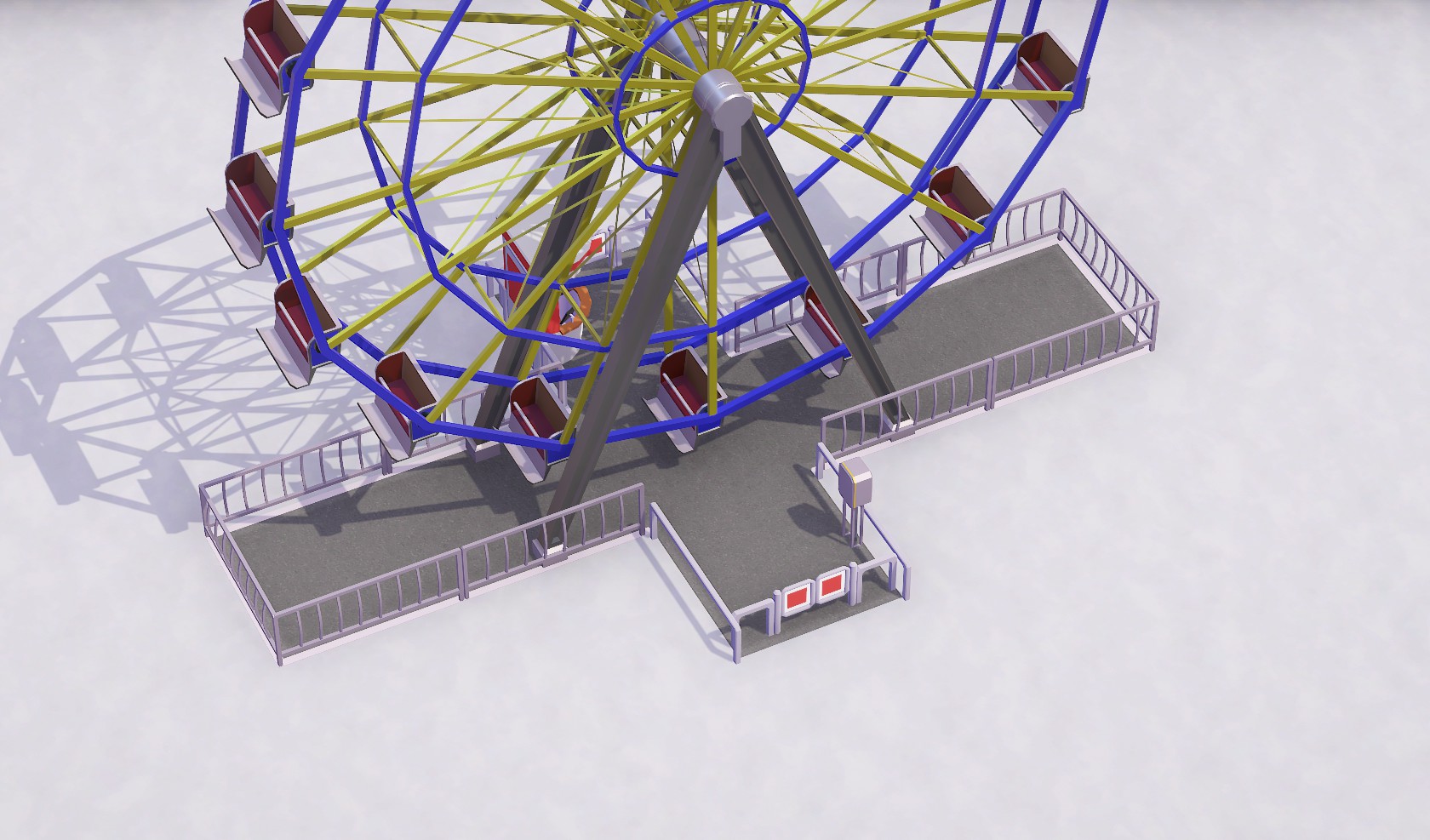
place/move entrance & place/move exit
- click to move or place the ride's entrance or exit
- placing the entrance and exit close to where riders get on and off of a ride will decrease loading times and thus increase the throughput of guests
- for track rides, only the placement of the entrance matters
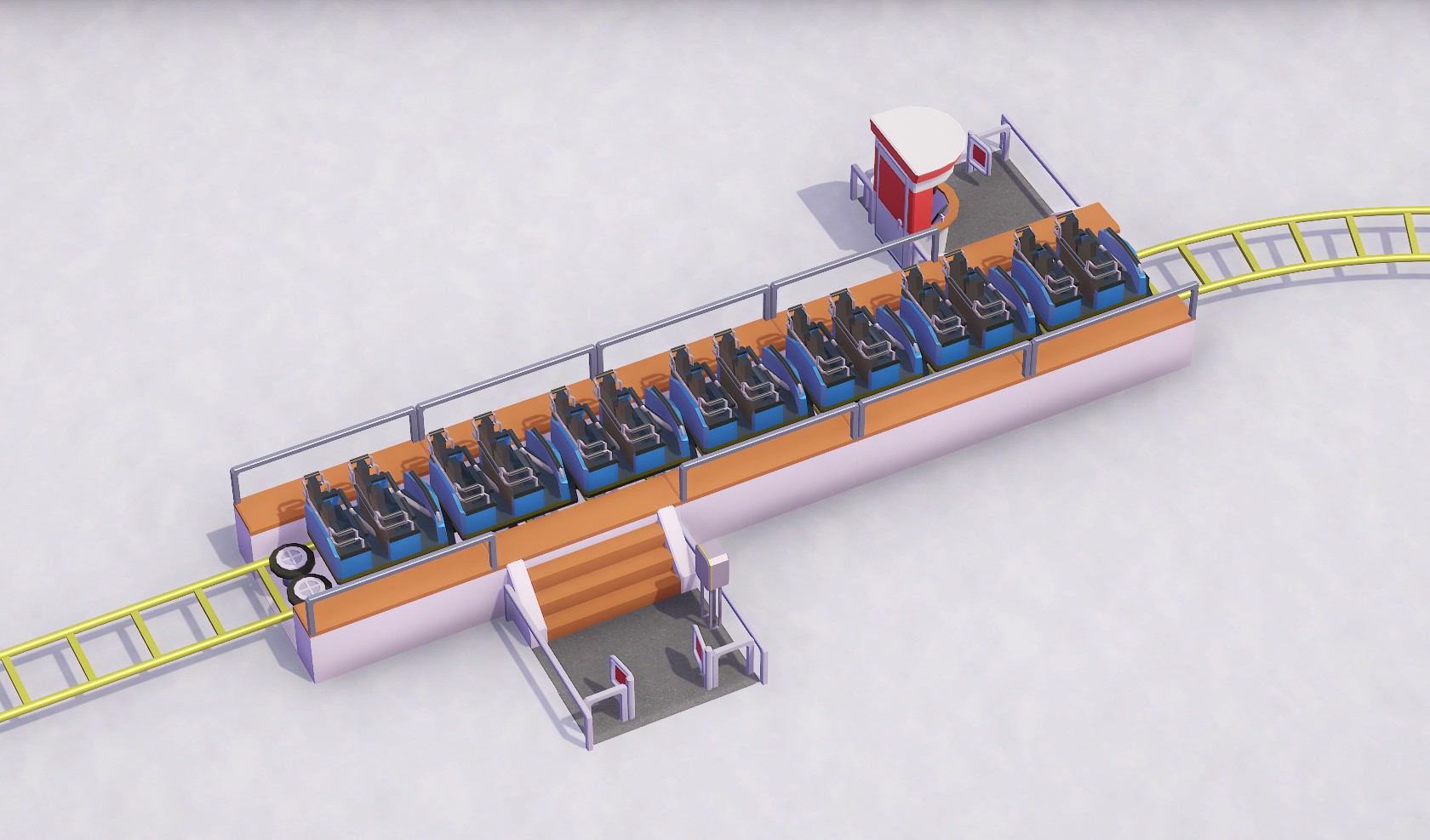
- In the pictures to the right, the entrance and exit are placed closest to where guests board the ferris wheel and for the wild mouse the entrance is placed where cars leave the station to minimize loading times
- for track rides, only the placement of the entrance matters
- if the entrance or exit hasn't been placed yet, they will already be selected and ready to place while this sub tab is open
delete/demolish this ride
- click to delete this ride and get a full or partial refund of its build cost, depending on how long ago it was built
- you will be asked to confirm before it is deleted
RIDES– cont.1
Settings
- safety influences how often rides break down
- track rides that break down can sometimes crash, especially if the breakdown is a brakes failure
Budget
- a slider to adjust how much money is spent maintaining this ride
- lowering the budget will decrease safety and lower the ride's monthly maintenance costs
Maintenance Interval
- how frequently mechanics will maintain (inspect) this ride
- breakdown repairs count as maintenance
- less frequent maintenance will decrease safety
- can be adjusted the same ways as prices: click and scroll the mouse wheel, click and enter a new number on your keyboard, or click the arrows to the right of the number
Last issue
- the cause of this ride's last breakdown (struck by lightning, restraints stuck closed, etc.)
Last maintenance
- time that has elapsed since this ride was last maintained by a mechanic
maintain ride
- click to immediately send a mechanic to maintain this ride
________________________________________________________________

Track Rides and Flat Rides: Operation
Some options related to loading and unloading and chainlifts.
Minimum Waiting Time
- how long each car/train will wait in the station before departing
- useful for spacing out trains on longer tracks
Maximum Waiting Time
- the maximum amount of time trains will wait in the station
Wait for
- how full trains should be before they depart the station
- Any
- train will leave the station as soon as the minimum waiting time is reached
- Any (Not Empty)
- train will wait until there is at least one passenger before departing
- Half Full
- train will wait until it is at least half full before departing
- Full
- train will wait until it is full before departing
- Any
- once the maximum waiting time is reached the train will leave the station even if this isn't met
Chainlift speed
- how fast trains are pulled up chainlifts
- only shown for track rides that use chainlifts
- also affects how fast trains are pulled along through stations and block brakes
________________________________________________________________

Track Rides and Flat Rides: Synchronized Stations
This is where you can synchronize this ride with another, meaning the two rides you have synced will depart from the station/start at the exact same time. This is especially useful when building racing coasters side-by-side. When you click 'Add', a button will appear that says 'Select station'. When you click 'Select station', your cursor will become a pipette. Then click on the station of the other ride that you want to sync with this one.
Additionally, many flat rides and tower rides allow you to set how many rounds the ride does. More rounds will increase the duration, excitement rating, intensity rating, and nausea rating. Boat rides have an option to set their duration here, but this should always be left at the default.
________________________________________________________________

Track Rides Only: Train Settings
There are three settings here. The first allows you to choose alternate train styles (in the picture to the right, a mini coaster is shown, and 'Mini Coaster Cars' is currently selected as the train style).
The other two settings are sliders that allow you to change how many cars long each train is as well as the total number of trains. How high you can change these settings depends on the type of ride and its design (the length of the station, and the number of block brakes). Some track rides only allow one car per train, in which case only the setting for the number of trains is shown.
In addition to these, for the powered coaster and go carts only there is also an option to allow the train/go carts to do multiple laps around the track.
RIDES– cont.2
Statistics
This sub tab contains lots of useful information about a ride.
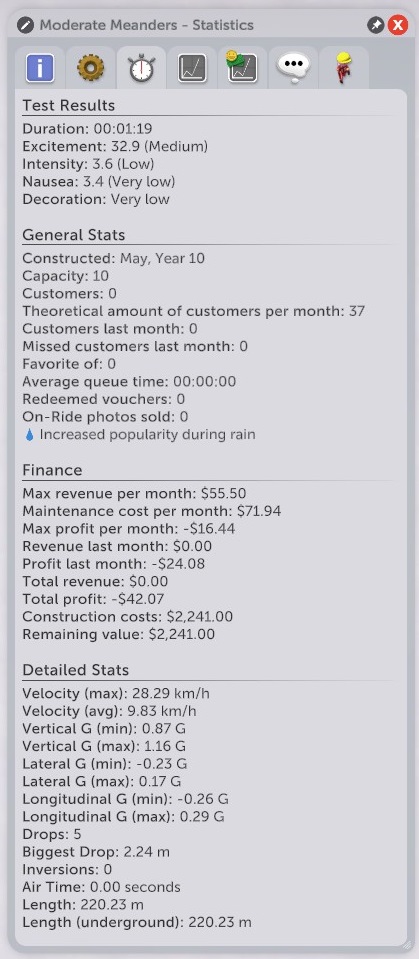
________________________________
Test Results
These are the most important statistics for rides.
Duration
- how long the ride lasts (the one in the
picture lasts 1 minute, 19 seconds) - this should always be between ~30 seconds and ~4 minutes
- rides that are too short will disappoint guests and they won't pay as much to
ride them - guests will become bored on rides that
last too long and start loosing happiness until the ride is over
- rides that are too short will disappoint guests and they won't pay as much to
Excitement
- basically an indication of how good the ride
is overalllow 0-29.9 medium 30-44.9 high 45-59.9 very high 60-74.9 extreme 75-94.9 ultra extreme 95+ - you can charge more for rides with a higher rating
- to figure out how much I can charge for coasters I divide the excitement rating
by 5 and round down (or multiply by 2
and then divide by 10, which can be
done in my head more easily)- this doesn't work for flat rides, so
for them I just add 1-2 dollars to the default price - this also only applies if you aren't charging a park entrance fee, which decreases how much guests are willing to pay for rides
- this doesn't work for flat rides, so
- to figure out how much I can charge for coasters I divide the excitement rating
Intensity
- indicates how violent or gentle a ride is
low 0-29.9 medium 30-59.9 high 60-79.9 very high 80-99.9 extreme 100-129.9 ultra extreme 130+ - different guests prefer different intensities
- high G-forces, inversions, and tall drops cause it to rise
- most guests will refuse to ride rides with extreme or ultra extreme intensities
Nausea
- rides with higher nausea ratings will cause guest's nausea stat to rise faster while riding
very low 0-14.9 low 15-29.9 medium 30-44.9 high 45-59.9 very high 60-74.9 extreme 75-89.9 ultra extreme 90+ - loosely correlated with intensity, but is calculated differently
- lots of spinning and quick direction changes cause it to rise
Decoration
- placing deco objects around a ride and its queue will increase this rating
- 'Amazing' is the highest deco rating
- a 'bad' rating means that a source of bad deco rating (staff room, toilet, etc.) is visible from the ride
- these can be hidden with deco or the terrain
- higher decoration ratings boost the excitement rating
- this effect is increased for rides that are meant to be decorated (rides that say "guests will look for fun things to do while riding scenic rides" while hovering over them in the rides tab)
________________________________________________________________
General Stats
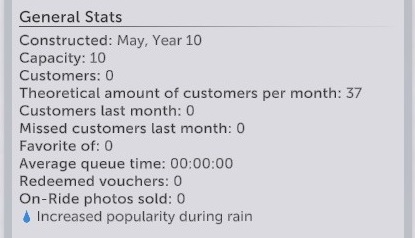
Some useful information and statistics about this ride, mostly related to guests.
Constructed
- the month and year when this ride was constructed in-game
Capacity
- maximum number of guests that can be on the ride at a time
- number of guests on-ride may briefly go above this during loading/unloading if previous passengers haven't yet made it to the exit when new passengers begin boarding
Customers
- total number of guests who have ridden this ride
- repeat riders are counted
Theoretical amount of customers per month
- approximate number of guests who could ride this ride over the course of one in-game month assuming there are no breakdowns and it is operating at capacity
Customers last month
- number of guests that rode this ride last month (including repeat riders)
- if it is much lower than the theoretical amount of customers per month, then this means that this ride isn't very popular or has some other problem (frequent breakdowns, exposed to rain in a rainy scenario, etc.)
Missed customers last month
- number of guests that would have ridden this ride, but couldn't because of some problem (ride was too expensive, it was raining, etc.)
Favorite of
- number of guests that have ridden this ride and consider it to be their favourite
- includes guests that have since left the park
Average queue time
- the average amount of time guests are waiting in line before riding
- this should be kept at less than 3-5 minutes, otherwise guests will get very unhappy while waiting and may decide not to ride at all
- to decrease wait times you can decrease the length of the queue path leading to the entrance, which shouldn't be able to hold more than twice the capacity of the ride for flat rides, or twice the capacity of a train for track rides (track rides with single cars that enter the station more frequently can have queue paths slightly longer than this)
- you may also be able to increase the throughput of the ride and thus decrease wait times by tweaking some settings in the settings sub tab of the ride
Redeemed vouchers
- total number of vouchers related to marketing campaigns that have been redeemed by guests for a free ride on this ride
On-Ride photos sold
- total number of on-ride photos of this ride that have been sold
- only displayed for track rides and there must be an on-ride photo camera placed somewhere along its track for the ride to sell on-ride photos
If a ride is more popular during rain, cold weather, or hot weather, this will be indicated here (the ride in the picture is more popular during rain). Building a ride underground or building a roof over it with deco roof pieces will make it more popular during rain, while some rides are already more popular during rain without this because they include roofs in their designs (eg. carousel). Rides with a fully enclosed design (eg. gravitron) are more popular in cold weather (open air rides that are built underground or within a building made of scenery pieces won't gain this perk). Water rides tend to be more popular in hot weather.
RIDES– cont.3
________________________________________________________________
Finance
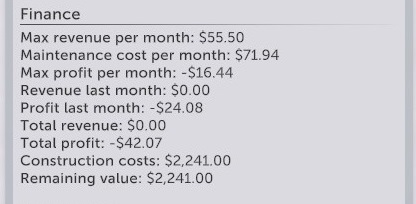
Some statistics of this ride related to its profitability among other things. In parks that only charge park entrance fee these aren't as relevant.
Max revenue per month
- maximum gross revenue this ride could make per month with its current admission price assuming no breakdowns and full loads
Maintenance cost per month
- the per-month cost of running this ride
Max profit per month
- max revenue per month minus maintenance cost per month for max net profit per month
- if it is negative, this ride will never be profitable without increasing its cost of admission or throughput of guests
- this can be mostly ignored in parks that only charge park entrance fee, but increasing ride throughput is never a bad thing
- if it is negative, this ride will never be profitable without increasing its cost of admission or throughput of guests
Revenue last month
- how much money this ride made from admissions last month
Profit last month
- revenue last month minus maintenance cost per month for net profit last month (the ride in the picture hadn't yet been open a full month, which is why its numbers are out of whack)
Total revenue
- total amount of money this ride has made over its lifetime not including maintenance costs
Total profit
- total amount of money this ride has made from admissions minus maintenance costs
Construction costs
- how much this ride cost to build
Remaining value
- how much you will be refunded if you delete this ride
- starts the same as the construction cost, then begins decreasing over time after a while
- pre-existing rides in scenarios never give a refund, even if they show a remaining value
________________________________________________________________
Detailed Stats
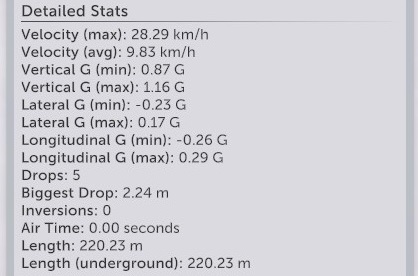
Detailed statistics related to G-forces and other things that affect the test results of track rides. These aren't shown for flat rides.
Velocity (max)
- the highest speed reached by the train as it travels around the track
Velocity (avg)
- the average speed of the train as it travels around the track
- physics nerds might say the average velocity of the train is zero because it ends up in the same place it started, but I guess the devs aren't physicists and don't know the difference between speed and velocity
Vertical G (min)
- minimum vertical Gs experienced on the ride
- on real life coasters, negative vertical Gs are what make you feel like you are being pulled out of your seat, while Gs between 1 and 0 make you feel partially to completely weightless
- experienced when the train is travelling over the tops of hills, through heavily outward banked turns, or slowly through inversions
- shouldn't be less than about -1.5, or the intensity rating may become a problem
Vertical G (max)
- maximum vertical Gs experienced on this ride
- on real life coasters, positive vertical Gs greater than 1 make you feel like you are being pushed down into your seat
- experienced when the train is travelling through the bottoms of drops, through inward banked turns, or quickly through loops
- shouldn't be more than about 5, or the intensity rating may become a problem
- as you can see, just as in real life, guests can handle higher positive than negative vertical Gs; keep this in mind while designing coasters
Lateral G (min)
- minimum lateral Gs (leftward pushing force) experienced on this ride
- experienced when the train is travelling through lightly banked right turns or bank angle changes
- shouldn't be less than -3, or the intensity rating may become a problem
Lateral G (max)
- maximum lateral Gs (rightward pushing force) experienced on this ride
- experienced when the train is travelling through lightly banked left turns or bank angle changes
- shouldn't be more than 3, or the intensity rating may become a problem
Longitudinal G (min)
- forces pushing riders forward
- experienced when the train hits brakes or is travelling downhill
Longitudinal G (max)
- forces pushing riders back into their seats
- experienced when the train is being launched at high speeds, or going up hills
Drops
- number of drops this ride has
- a drop is any section of track where the train is travelling downhill that is uninterrupted by level or uphill sections
- having more drops will increase the excitement rating
Biggest Drop
- the height of the biggest drop (the vertical distance from the top to the bottom, length of the drop is irrelevant)
Inversions
- number of times the train goes upside-down
- any spot where the track bank angle exceeds 90° count as inversions
- having more inversions will increase the excitement and intensity ratings
Airtime
- total duration of feelings of weightlessness on this ride
- accumulates when vertical g's are between -0.5 and 0.5
- usually occurs at the tops of hills and when the train travels slowly through inversions
- having more airtime greatly increases the excitement rating
Length
- total length of all track segments of this ride (segments not used by the train are still counted)
- longer tracks increase the excitement rating
Length (underground)
- total length of track that is covered by tunnel frames
- having underground sections increases the excitement rating
RIDES– cont.4
Graphs
This sub tab gives you access to several useful heat maps and graphs for this ride. It is only available for track rides. There are heat maps and graphs for all three types of g-forces, as well as airtime, velocity, and decoration rating.
________________________________________________________________
Vertical G-Forces
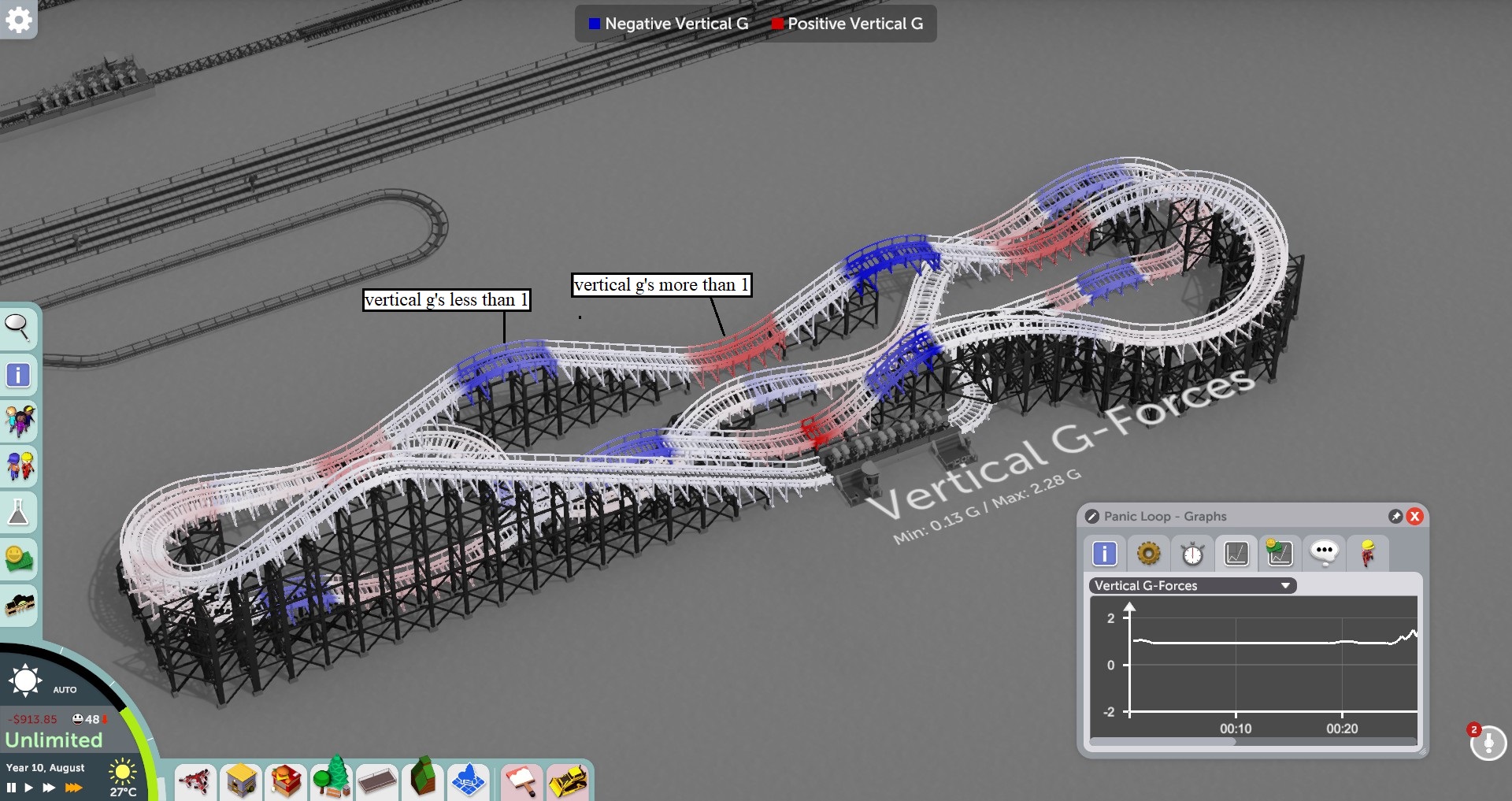
As you can see, vertical g's less than 1 occur at the tops of hills, while positive g's over 1 occur at the bottoms of hills. Hovering over sections of track will bring up a tool tip showing the exact values at that spot. If your coaster is too intense and has vertical g's of less than -1.5 or more than 5, then look for areas that are shaded the most blue or red respectively, and try smoothing out the track at that spot. Note that at the top of the screen it says that blue represents negative g's; vertical g's between 0 and 1 are considered negative, because 1 represents the downward force of gravity and is added to everything.
________________________________________________________________
Lateral G-Forces
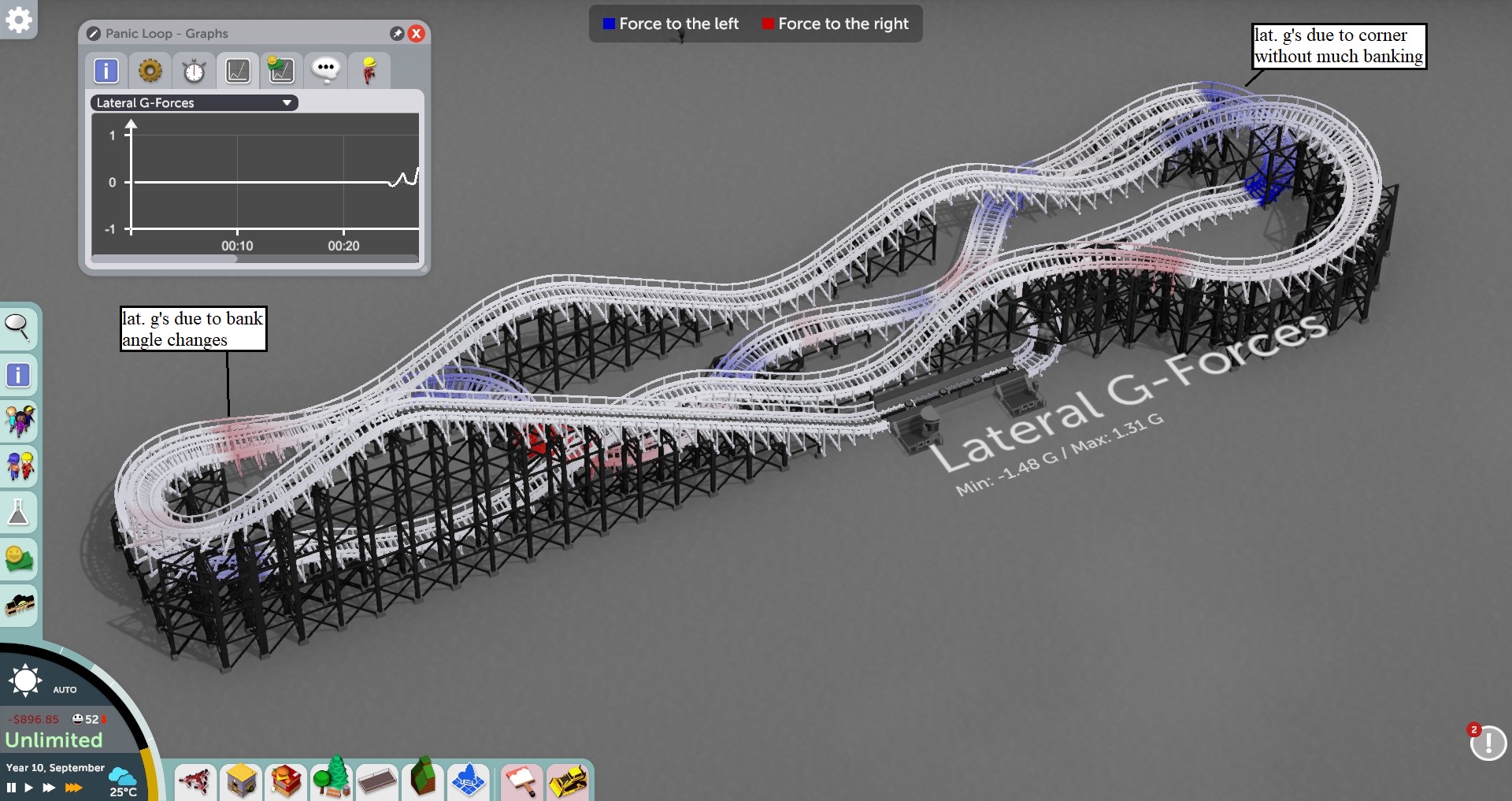
Blue represents leftward forces, while red represents rightward forces. The train will experience these forces while going through turns in the opposite direction and while going through twisted track (changes in bank angle). Hovering over sections of track will bring up a tool tip showing the exact values at that spot.
________________________________________________________________
Longitudinal G-Forces
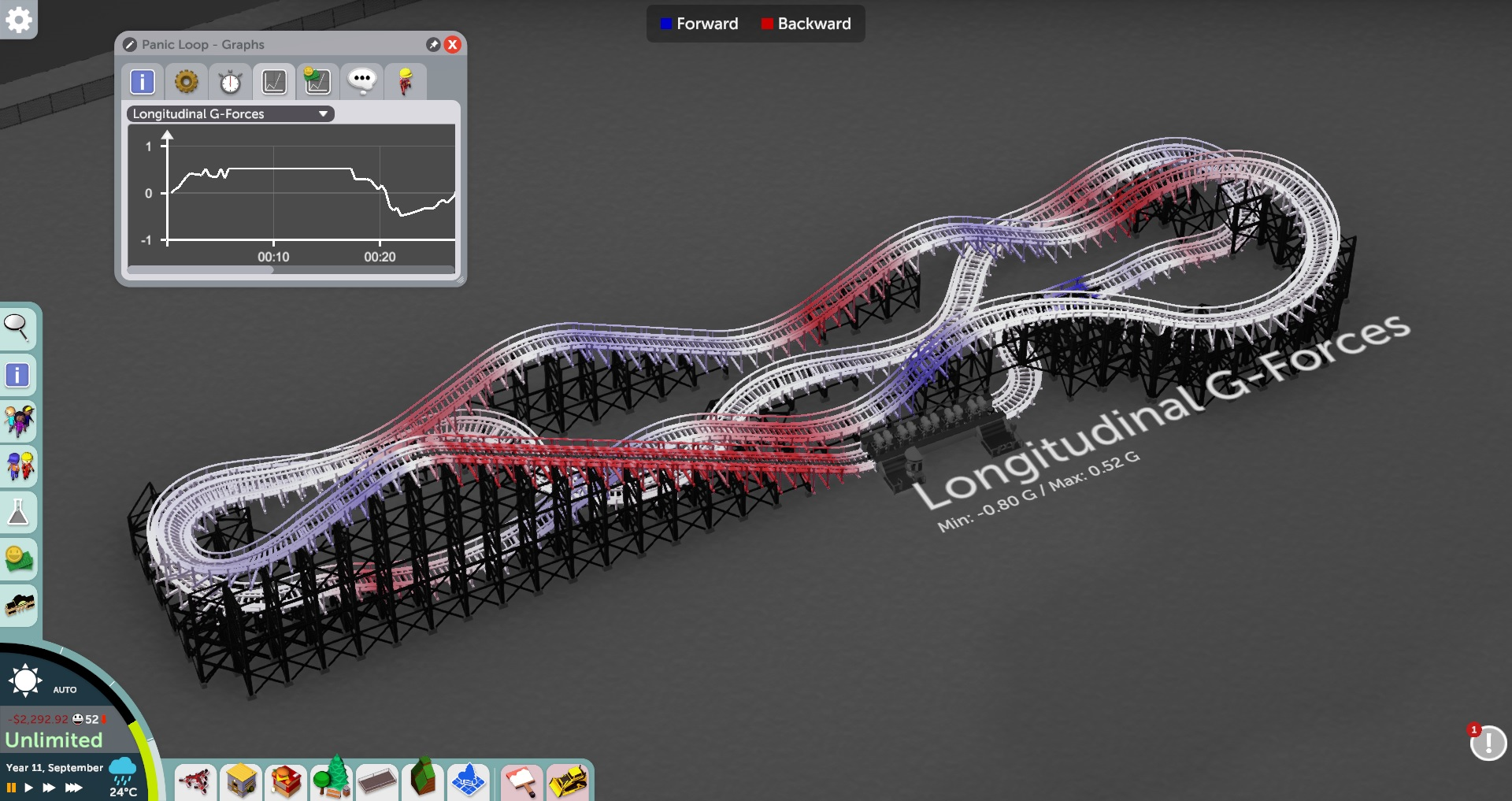
Blue represents forces pushing riders forward, while red represents forces pushing riders back into their seats. You usually don't have to worry about these forces. As long as you don't have sudden braking anywhere on the ride they aren't usually an issue. Hovering over sections of track will bring up a tool tip showing the exact values at that spot.
________________________________________________________________
Airtime
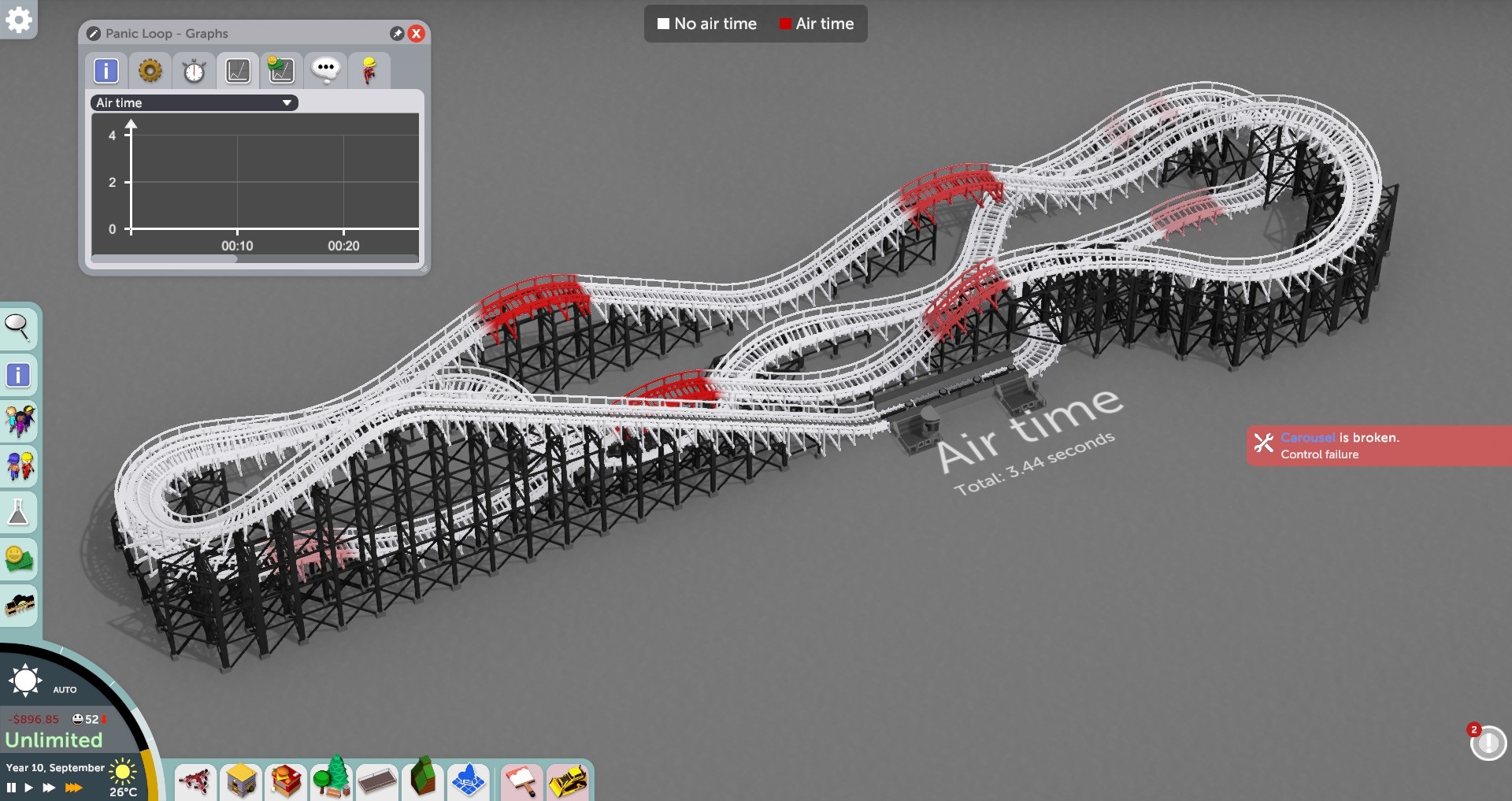
Areas that are highlighted red are areas that induce airtime. Airtime happens in areas where the vertical g's are between -0.5 and 0.5. Hovering over a the end of a section of track that has airtime will bring up a tool tip showing the amount of airtime from that section.
________________________________________________________________
Velocity
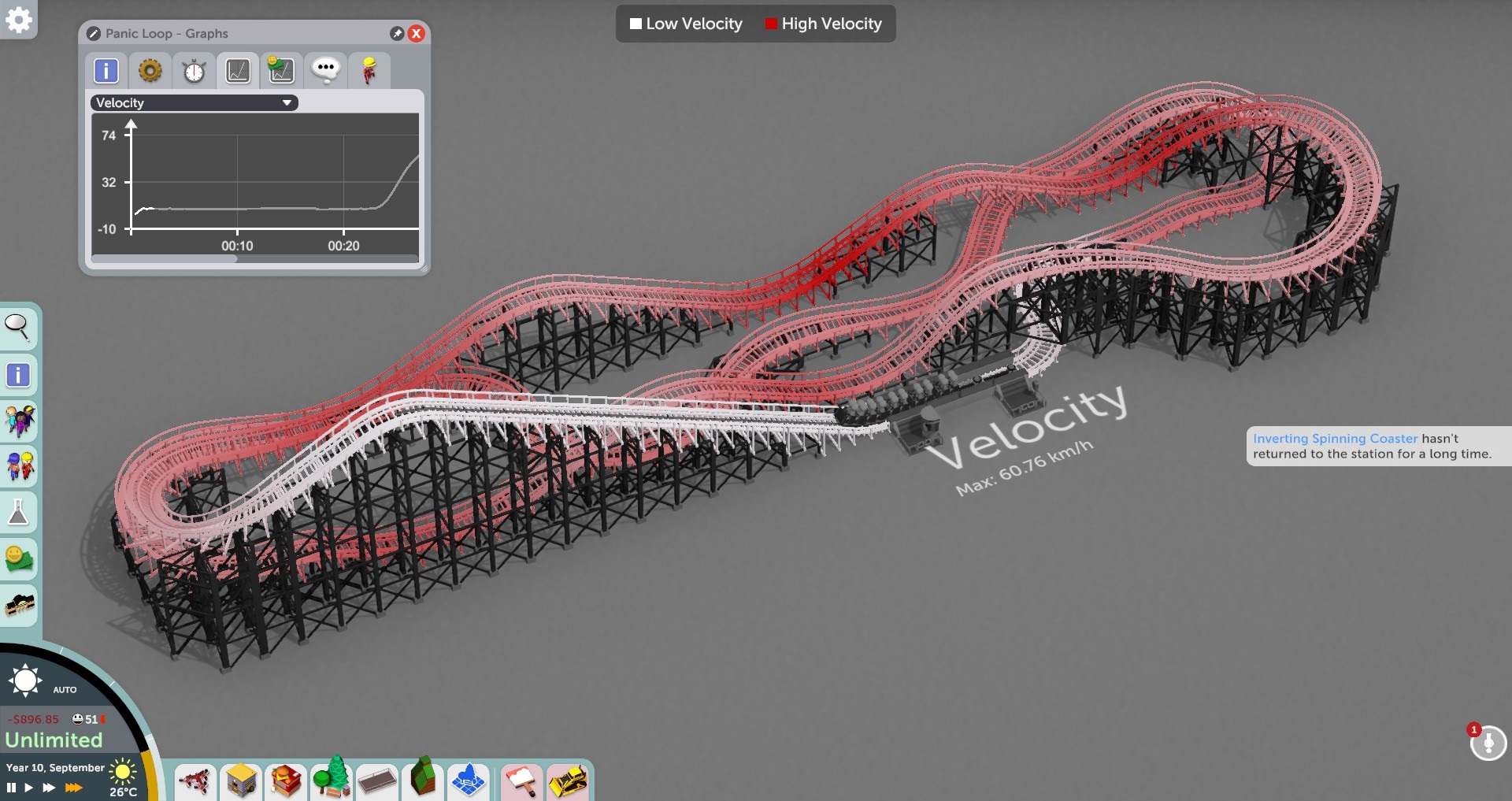
Darker shaded areas represent areas where the velocity is higher. Hovering over a section of track will bring up a tool tip showing the exact velocity of the train at that spot.
________________________________________________________________
Decoration Rating
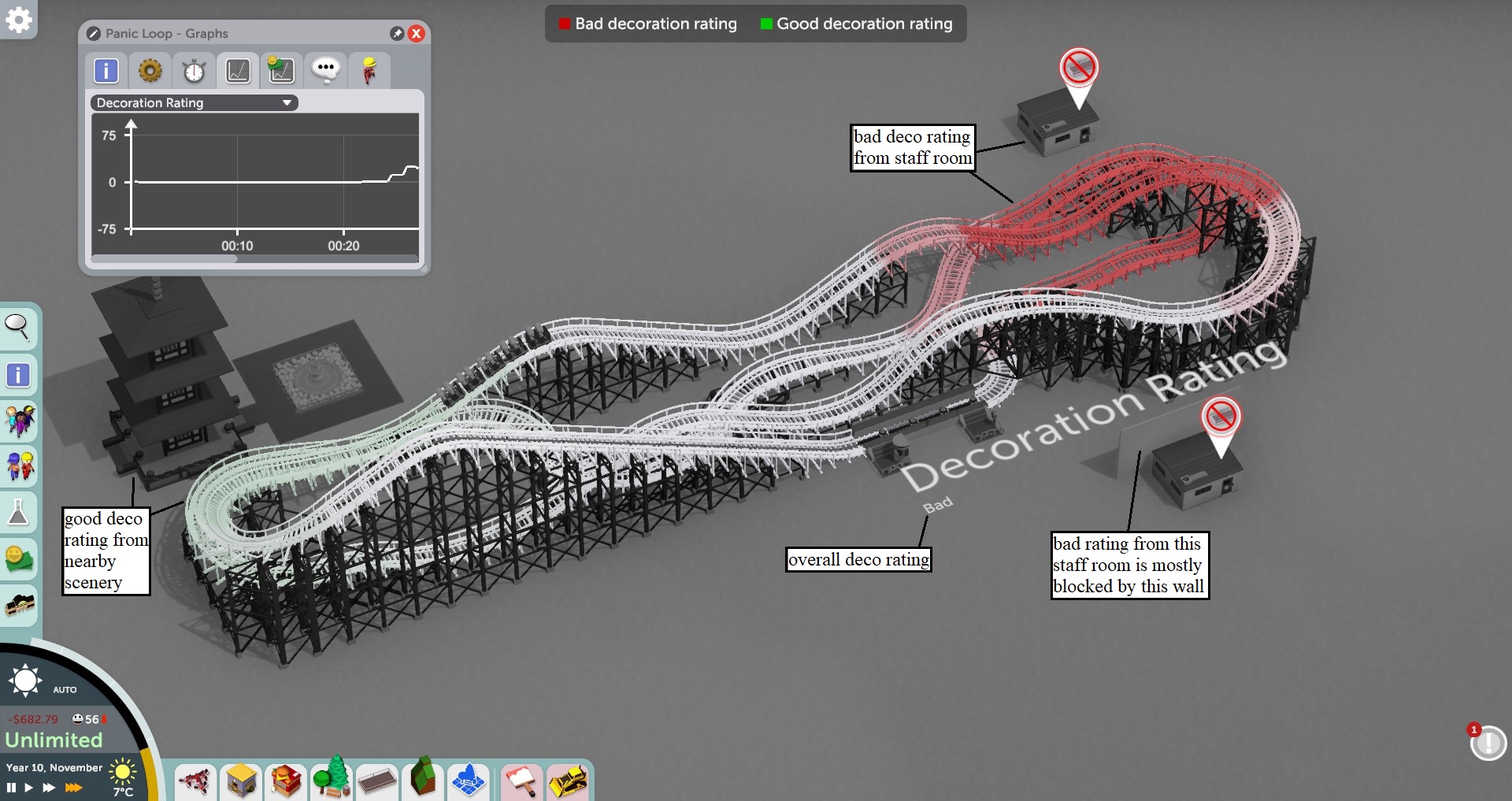
Just like with paths, green shaded areas represent areas with a good deco rating, white areas represent areas with little to no decoration, and red areas represent areas with bad decoration. The game uses sight-lines to determine the deco rating, and sources of bad deco rating can be blocked from view with scenery such as trees and walls, or by the terrain. Hovering over a section of track will bring up a tool tip showing the deco rating at that spot, represented as a percentage, with higher percentages representing a better deco rating.
Revenue
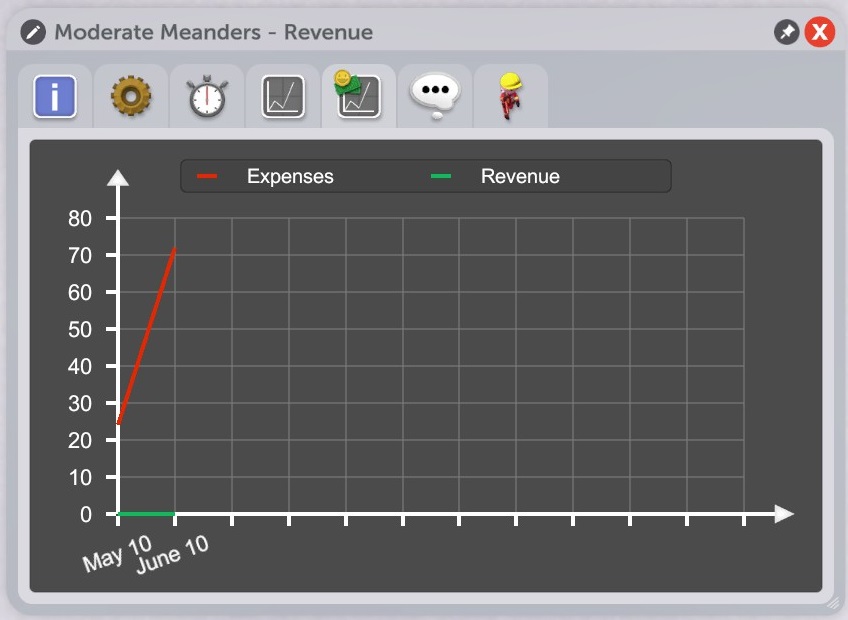
This sub tab has a graph that shows past revenue and expenses generated by this ride, divided into months. If the red line (expenses) is higher than the green line (revenue), that means the ride wasn't profitable that month. Hovering over one of the lines on the graph will show the exact number at that point. Expanding the window by clicking and dragging the lower right corner will make it much easier to read.
Opinions
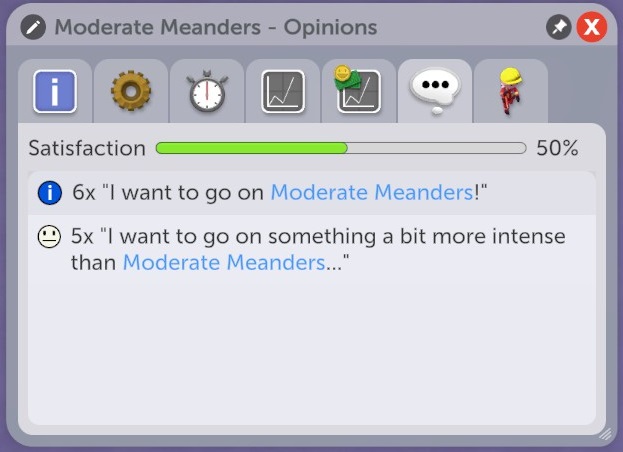
This sub tab shows thoughts guests are having about this ride, as well as a bar showing overall satisfaction. Look for negative thoughts to find problems with the ride. If guests are thinking that it is a good deal, then you can raise the ride's cost of admission.
Tasks
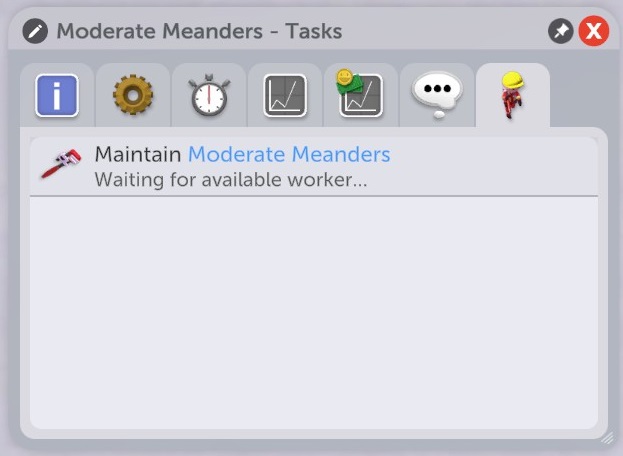
This sub tab shows all employee tasks related to this ride that currently need to be completed (maintaining or fixing the ride).
RIDE CONSTRUCTION
In this section I will go through the process of placing and building rides.
Placing
If you are building a track ride, you first need to place the first piece. To do this:
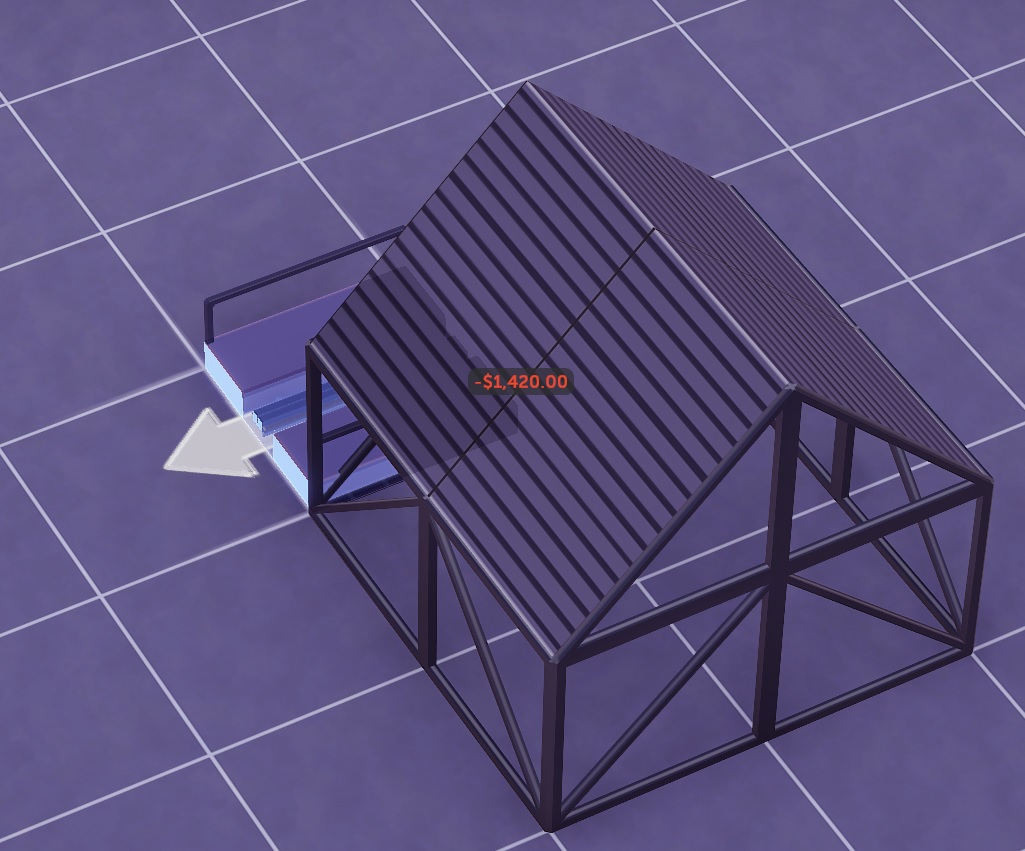
- open the rides tab
- click on the ride you wish to build
- a preview of what you are about to
place will now be attached to your cursor
- a preview of what you are about to
- decide where you want to place the first piece
- hold left shift and move the mouse up and down to change its height
- press left ctrl to snap its height to whatever you're cursor is currently hovering over
- in the picture to the right, if your cursor is hovering over that metal roof and you press left ctrl, it will snap up to the same height as the roof
- press spacebar to rotate it
- the first piece will always be a station platform piece
- click to place it
Placing the first piece of track is always more expensive than subsequent pieces. In the picture to the right, this cost is $1420.
This works the same when placing flat rides.
Track Builder

This is the window that pops up once you have placed the first piece of a track ride. Different ride types have different options available. Pictured is the track builder window for the steel coaster.
________________________________________________________________
Building Curves


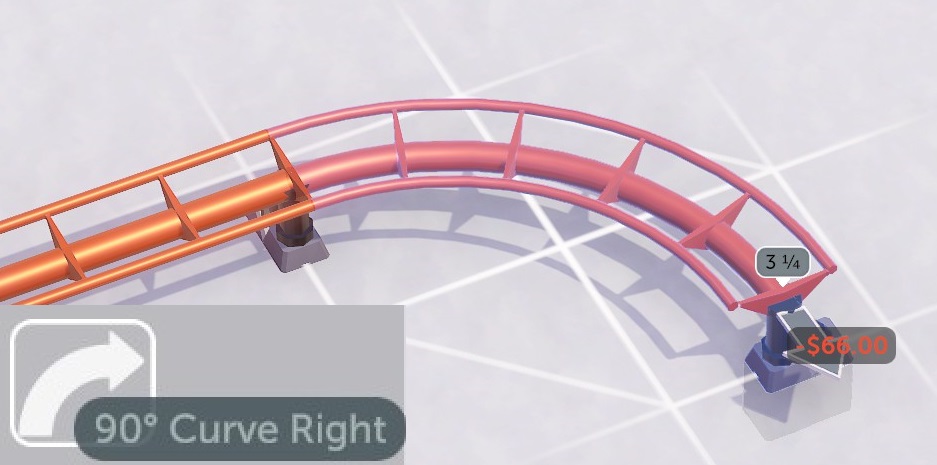
To build curves, click on one of these arrows to select that option, then click it again to build it.
In the picture to the right, the 90° curve right has been selected. Clicking it again will build that track for a cost of $66.
________________________________________________________________
Building Slopes


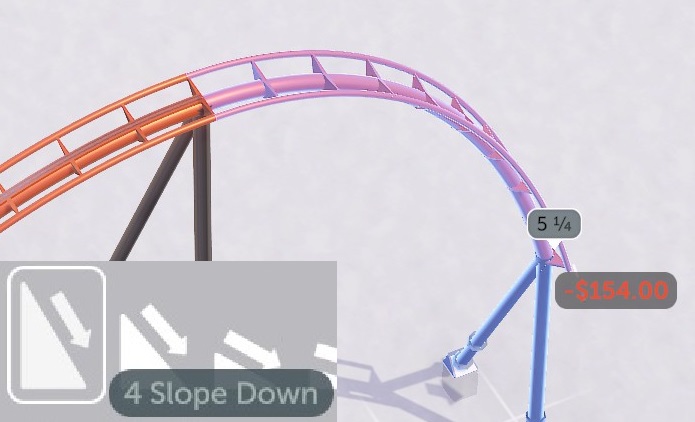
To build slopes, click on one of these slope options to select it, then click on it again to build it. What steepnesses are available depends on the ride.
In the picture to the right, 4 slope down has been selected. Clicking it again will build the track piece pictured for a cost of $154. For most tracks you can build sloping curves by having a 90° left or right curve selected and then selecting a slope (45° turns can't be sloped).
________________________________________________________________
Miscellaneous

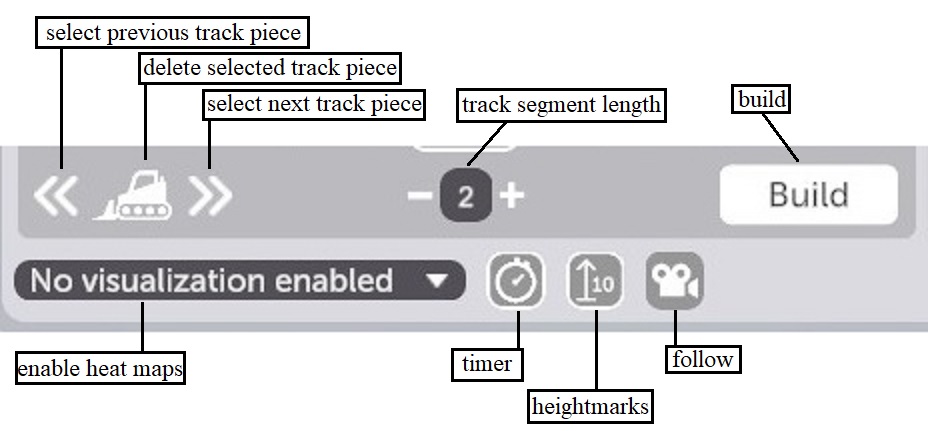
- click to select the track piece that comes just before the one you currently have selected
- you can also right click directly on any track piece to select it
delete selected track piece
- delete the track piece you currently have selected
select next track piece
- click to select the track piece that comes just after the one you currently have selected
track segment length
- change how long you wish the next segment you build to be
- can be done by:
- clicking the number and entering a new one on your keyboard
- clicking the '+' or '-'
- can be done by:

comparison of 90° right turns with lengths of 1, 2, and 3
- as an alternative to the previously mentioned methods, once you have selected a desired slope, curvature, etc., you can click this to build it
enable heat maps
- several heat maps/overlays are available while building
- options are:
- vertical g forces (forces up or down)
- lateral g-forces (forces from side to side)
- longitudinal g-forces (forces forward and backward)
- airtime (sections of track with vertical g's between -0.5 and 0.5)
- velocity (speed of the train)
- decoration (deco rating of each track segment)
- blocks (sections of the track divided by blocks (more on this in a bit))
timer
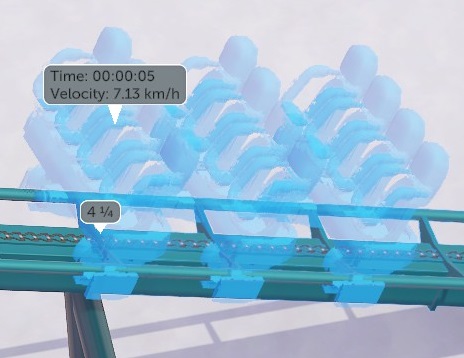
- enables a small tool tip that follows the
ghost car showing the ride's duration to that point as well as its speed
height marks
- enable/disable height marks which show the elevation of each segment of track when you hover over them

follow
- click to follow the ghost train
________________________________________________________________
Adjusting the Bank Angle of the Track

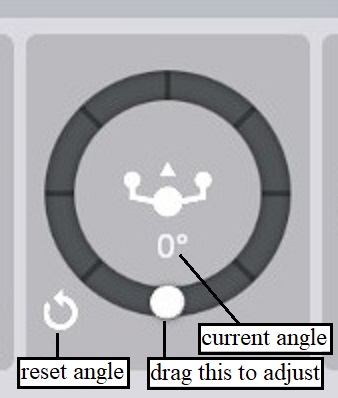
This is where you adjust the banking of the track. The white dot can be dragged around the circle to adjust the amount of banking, or you can scroll your mouse wheel while hovering over it. Clicking where it says 'reset angle' will reset the banking to 0°.
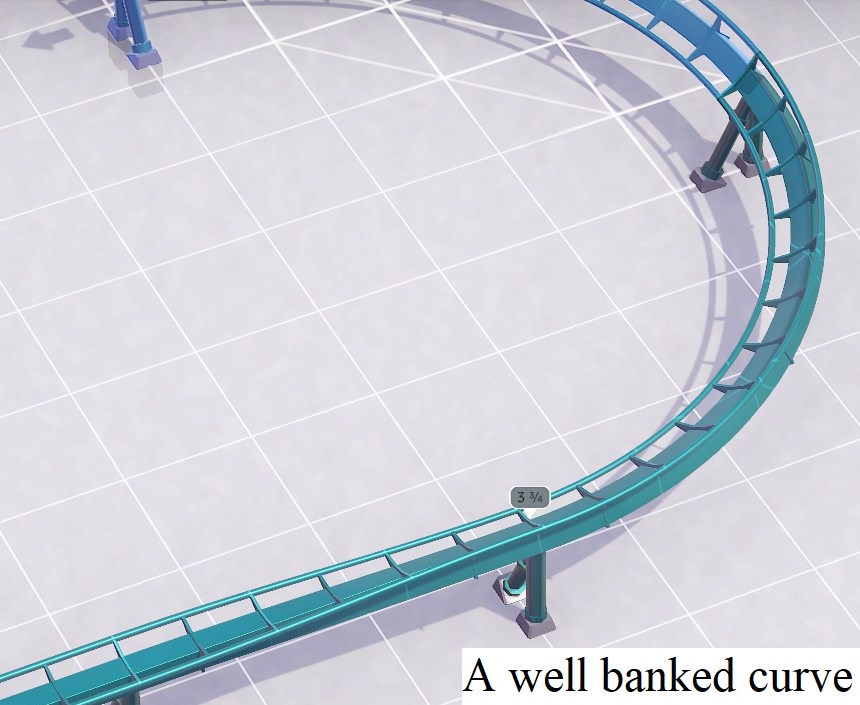
Turns where the train is travelling fast should usually have inward banking as is shown in the picture above.
This feature can also be used to make other neat track elements such as inline twists (by dragging the white dot all the way around, pictured below), over banked turns, etc.
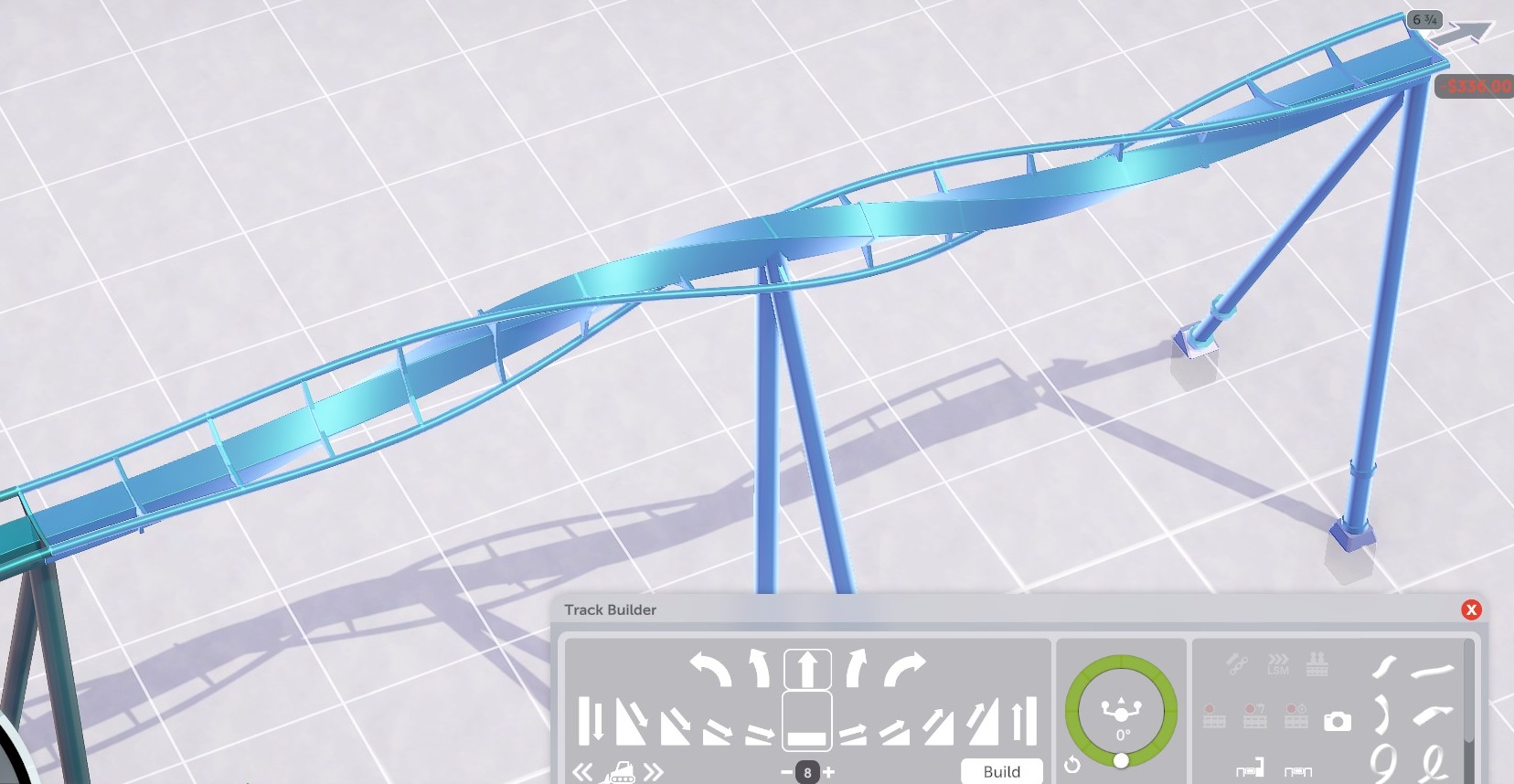
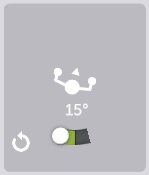
Some tracks have limitations on how much they can be banked. For example, the go carts (pictured left) cannot be banked more than 15°, while other tracks can't be banked at all, in which case the bank angle part of the track builder will be absent.
RIDE CONSTRUCTION– cont.1
________________________________________________________________
Other Track Options

These are various other options to customize the ride and add features to it. The options available here vary greatly between track types.
| Icon | What it does | What Track Rides it's Available on | Additional Notes |
 |
|
|
|
 |
|
|
|
 |
|
|
|
 |
|
|
|
 |
|
|
|
 |
|
|
|
 |
|
|
|
 |
|
|
|
| |
|
|
|
 |
|
| |
 |
|
|
|
 |
|
|
|
 |
|
|
|
 |
|
|
|
 |
|
|
|
 |
|
|
|
 |
|
|
|
RIDE CONSTRUCTION– cont.2
| Icon | What it does | What Track Rides it's Available on | Additional Notes |
 |
|
|
|
 |
|
|
|
 |
|
|
|
 |
|
|
|
________________________________________________________________
Special Track Pieces

Here you will find special track elements to improve your track rides such as loops, corkscrews, s-bends, etc. Most can be increased in size by adjusting the track segment length number as shown earlier.
| Icon | What it is | Image | What Track Rides it's Available on | Additional Notes |
 | S-bend (left) | 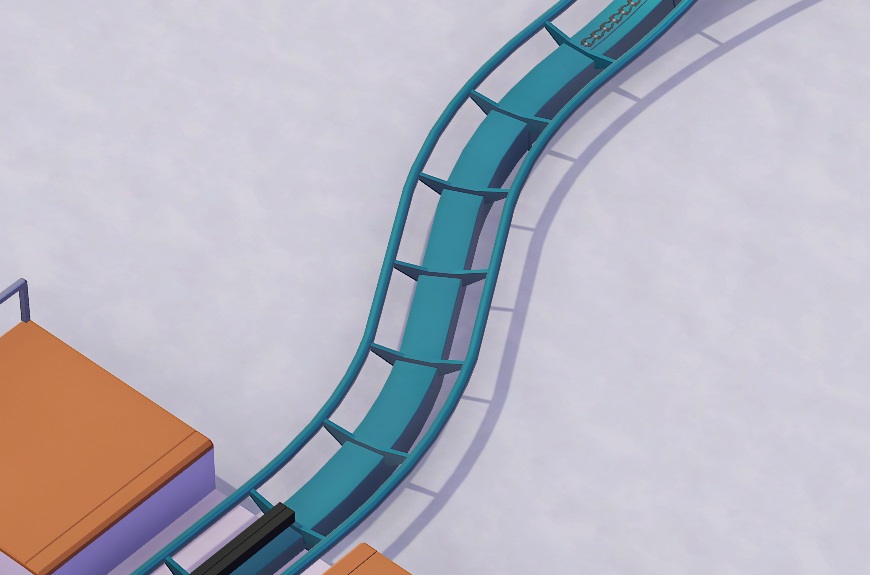 |
|
|
 | S-bend (right) | 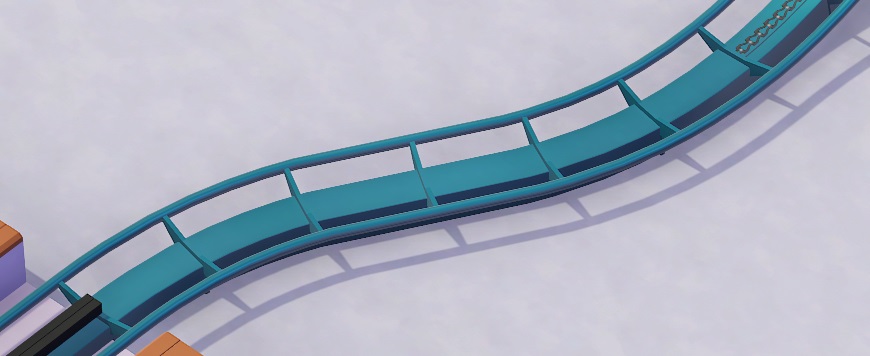 |
|
|
 | Corkscrew (left) | 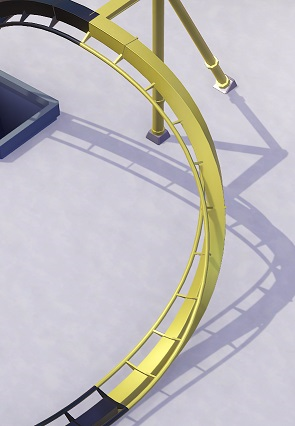 |
|
|
 | Corkscrew (right) | 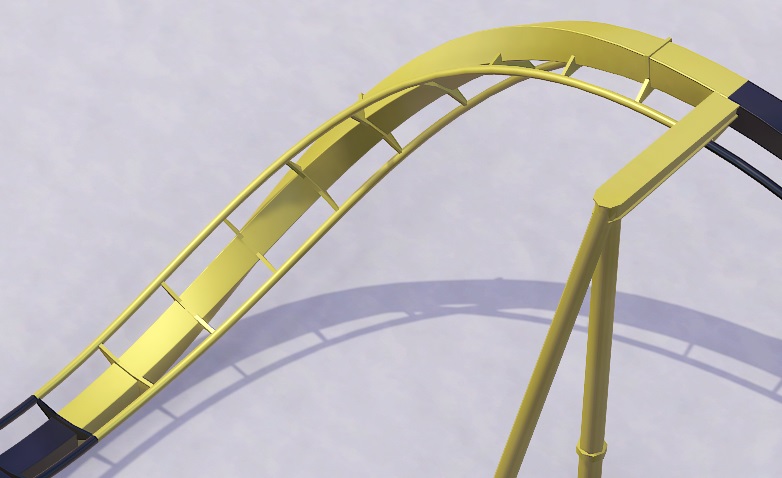 |
|
|
 | Loop (left) | 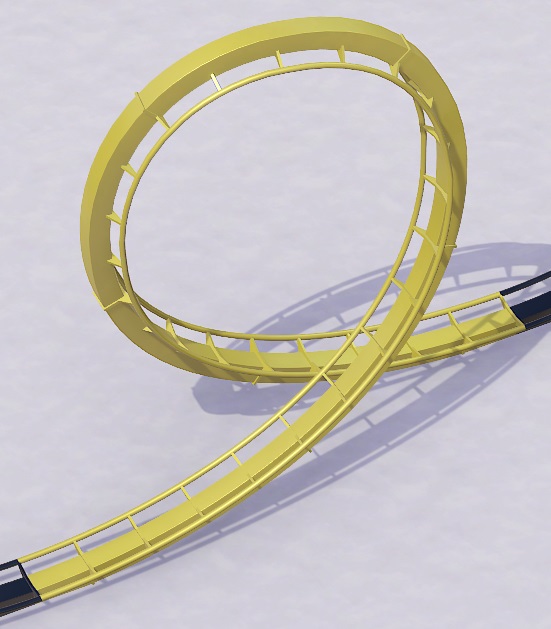 |
|
|
 | Loop (right) | 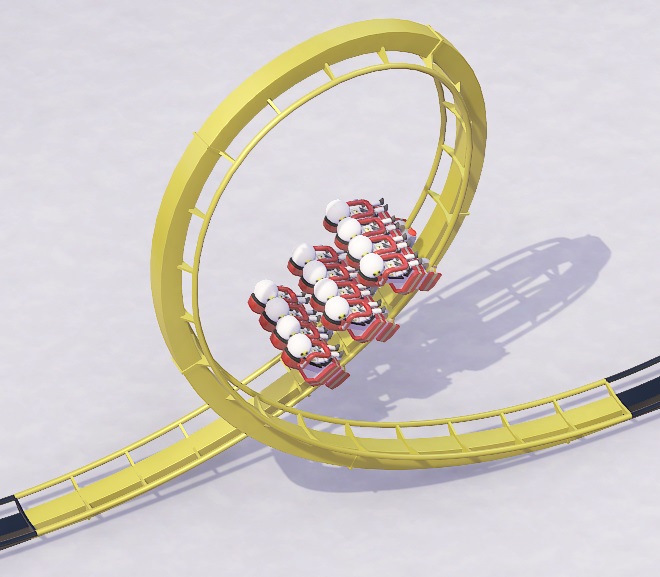 |
|
|
 | Half Loop (up) | 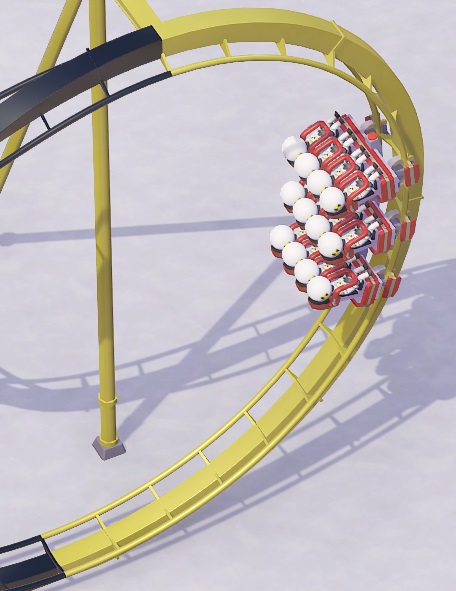 |
|
|
 | Half Loop (down) | 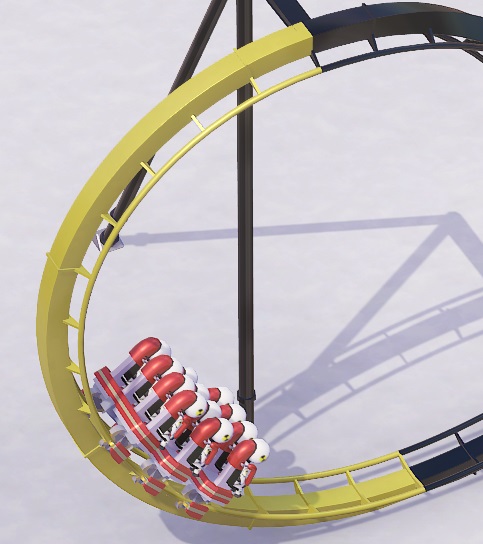 |
|
|
 | Half Helix (left) |  |
|
|
 | Half Helix (right) | 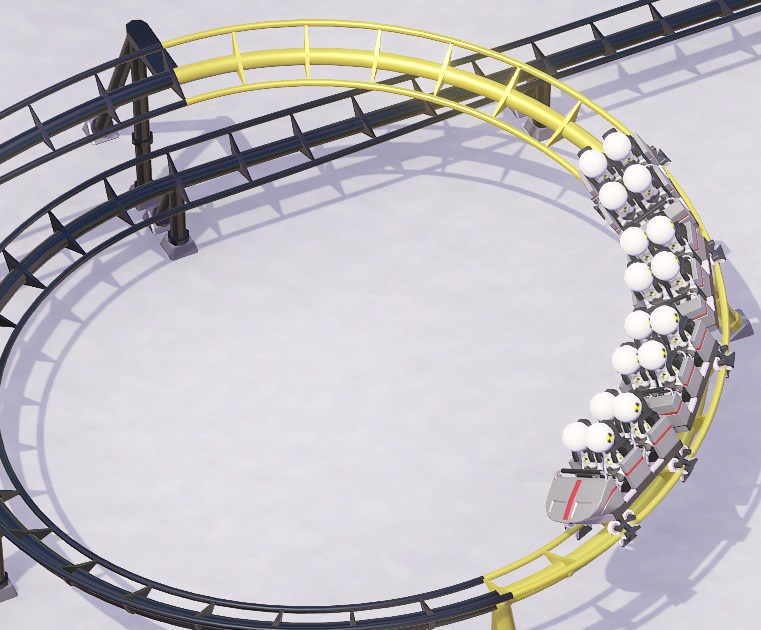 |
|
|
RIDE CONSTRUCTION– cont.3
| Icon | What it is | Image | What Track Rides it's Available on | Additional Notes |
 | Splash down | 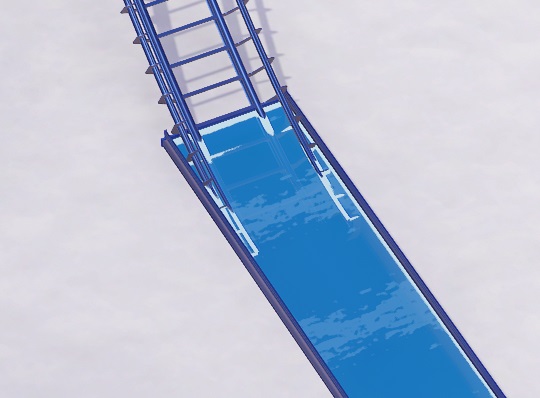 |
|
|
 | Turntable (left) | 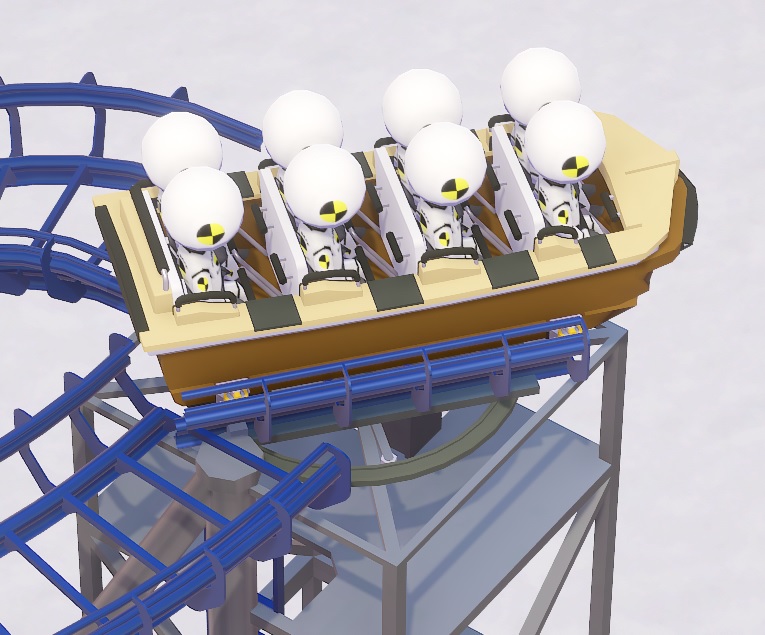 |
|
|
 | Turntable (right) | 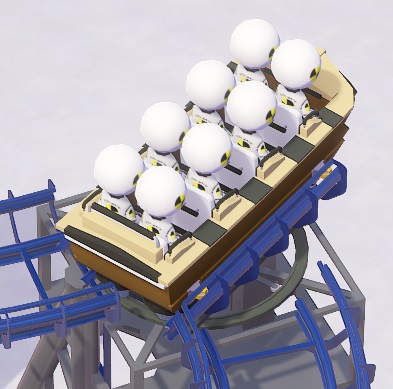 |
|
|
 | Hydraulic Launch System | 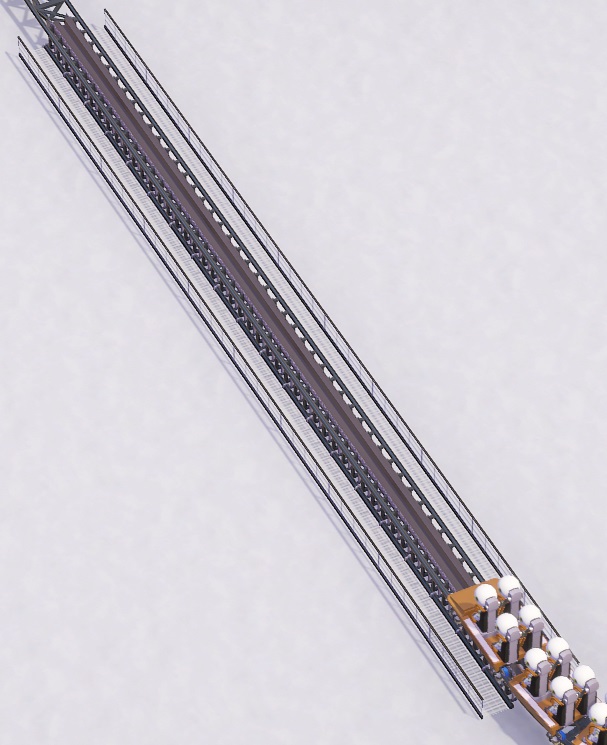 |
|
|
 | Switch Track (left) | 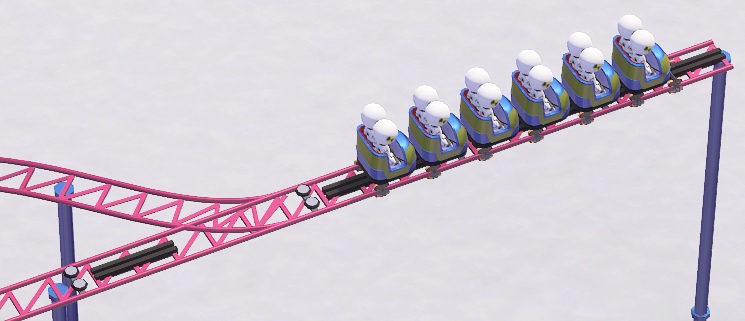 |
|
|
 | Switch Track (right) | 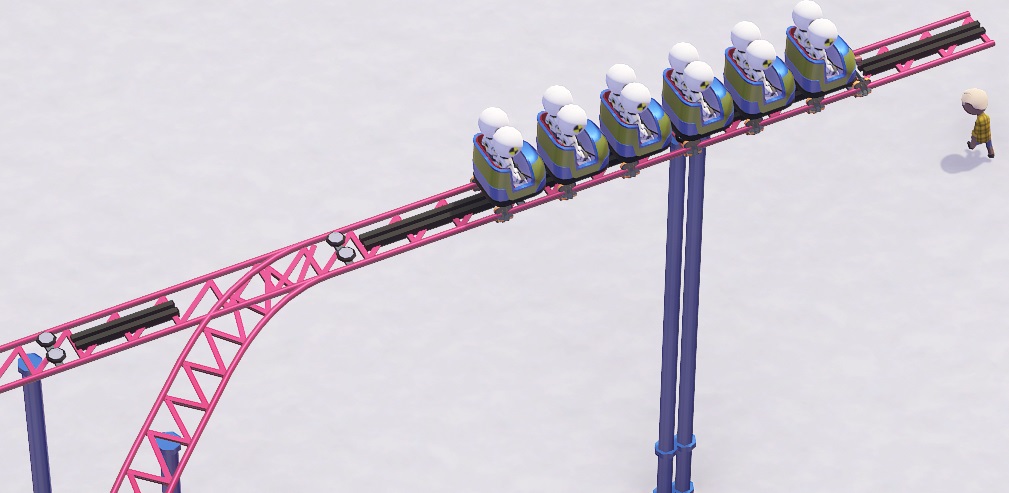 |
|
|
 | Elevator (up) | 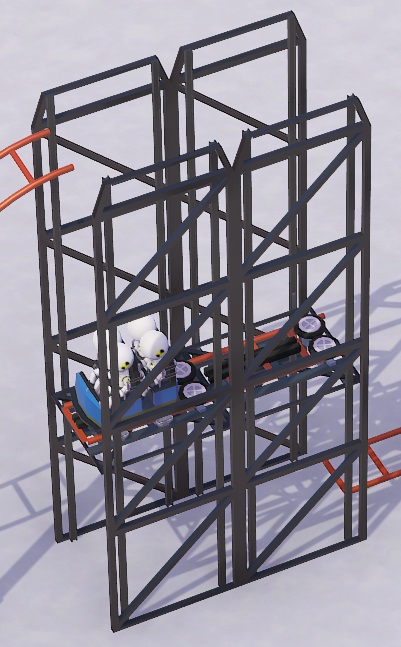 |
|
|
 | Elevator (down) | 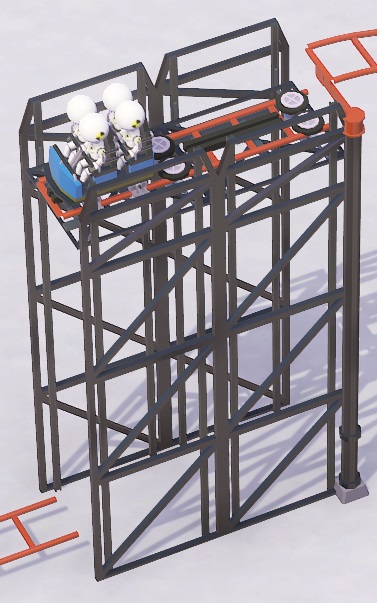 |
|
|
 | Beyond Vertical Drop | 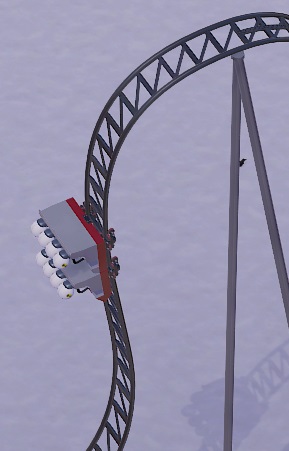 |
|
|
________________________________________________________________
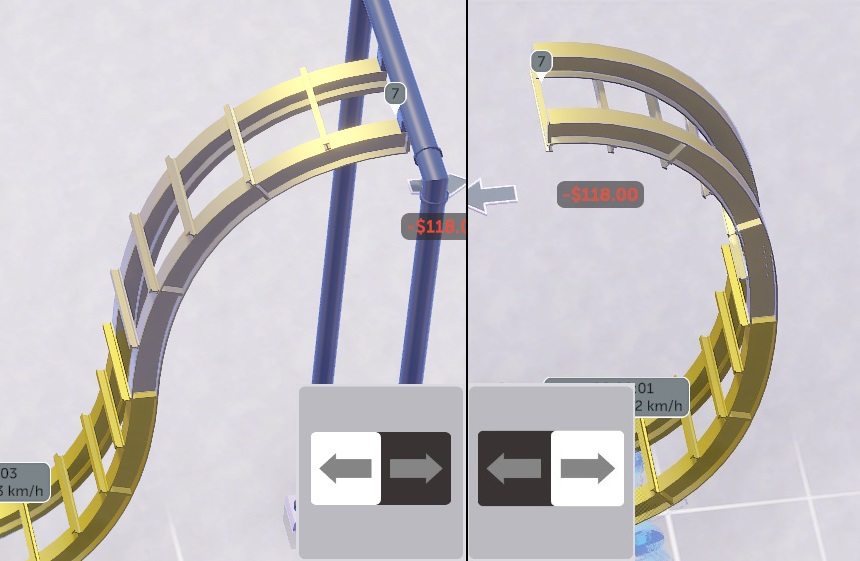
Unique to Vertical Spinning Coaster
The vertical spinning coaster has an option when building from vertically sloped track to change which way the track levels off. It appears in place of the bank angle selector as two arrows pointing in opposite directions. Pictured below is the same upward vertical track showing that you can build level track from it in either direction by clicking these arrows.
________________________________________________________________
Unique to River Rapids
In place of a bank angle selector, the river rapids ride has a slider that allows you to adjust the width of the channel.

PARK UTILITIES TAB
This tab is where you go to build staff rooms, staff training rooms, depots, and trash chutes. it can also be opened with a hotkey (F2 by default). It has two sub tabs: The first (shown below) is for selecting one of these four buildings to place. The second sub tab is for connecting depots and trash chutes to the park's main deliveries building using transport tubes.
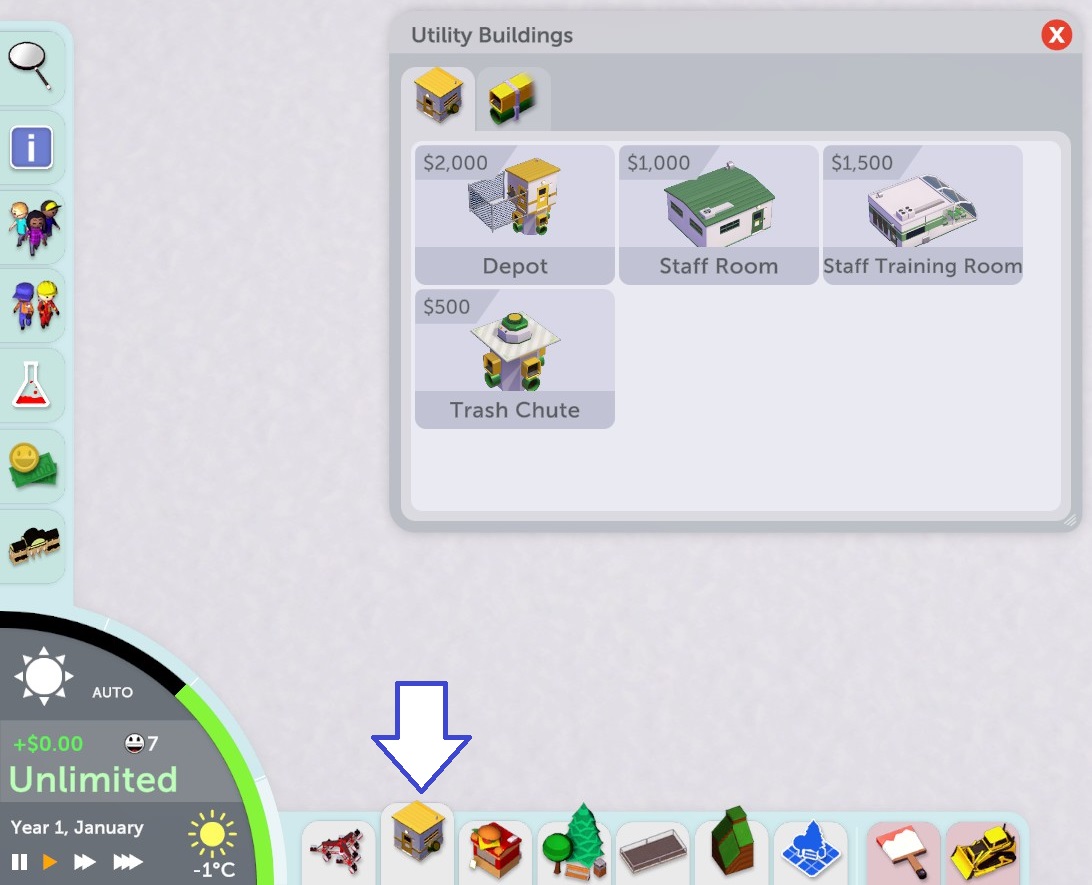
All of these buildings are a source of bad decoration rating and thus should be hidden from your guest's view with scenery such as trees or walls, or the terrain.
Transport Tubes
Depots and trash chutes won't work if they aren't connected to the deliveries building with transport tubes. Transport tubes have a bad decoration rating and should usually be built underground. When this sub tab is opened, all in-game scenery, rides, etc. will be hidden from view to allow easier viewing, however visibility of these things can be re-enabled from the views and visualizations tab or keyboard shortcuts ('V', 'B', and 'N') while building tubes (useful if an underground path or track is blocking placement).
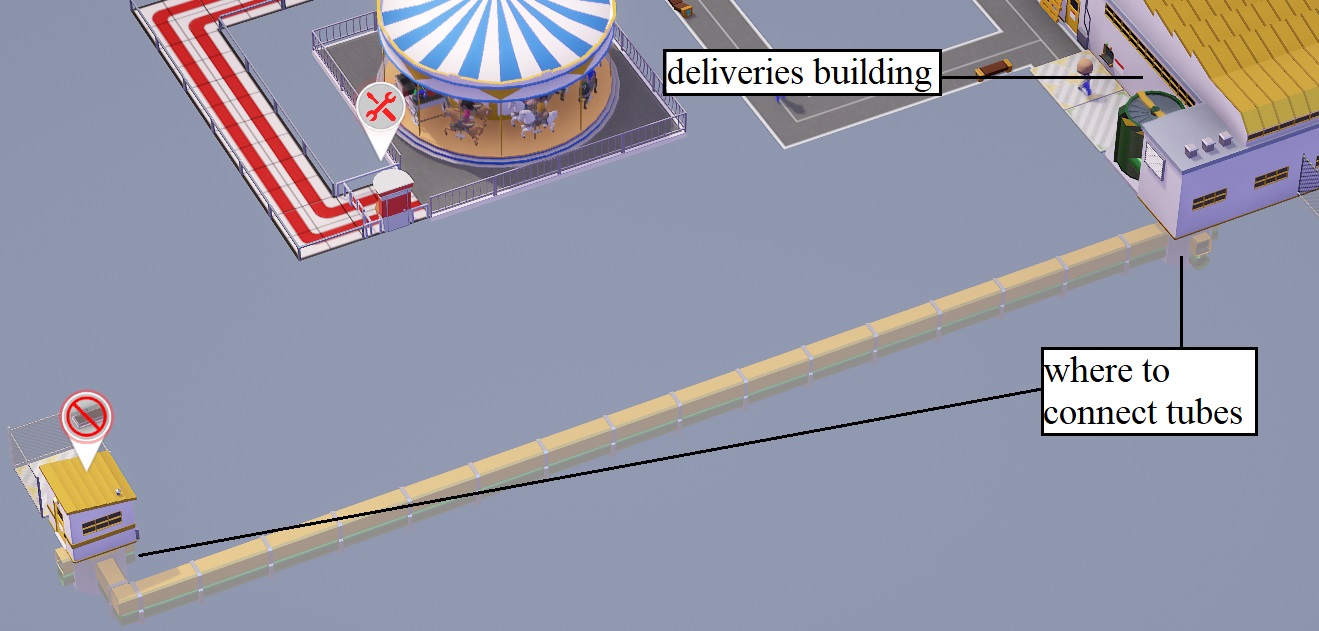
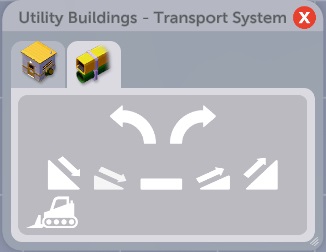
Building transport tubes is similar to building paths. They can be built one tile at a time by clicking on the slope options (from left to right: 1 slope down, 1/2 slope down, flat, 1/2 slope up, 1 slope up).
Clicking the leftward or rightward curved arrows will change the direction in which you are building.
Clicking the bulldozer icon will delete a piece.
Alternatively, you can simply click and drag in the game world to build a row of tubes all at once, or right click and drag to delete a row all at once.
________________________________________________________________
Strategy for connecting tubes
Many people have trouble lining up tubes and figuring out what height they are at. I use the following strategy when building them:
Build half slopes downward from each end (from the deliveries building and depot/trash chute) until you can't go down any further.

While hovering over the lowest piece you just built, press left Ctrl on your keyboard to lower your cursor to a height of zero. Alternatively, you can hold left shift and move your cursor down until it is at a height of zero.
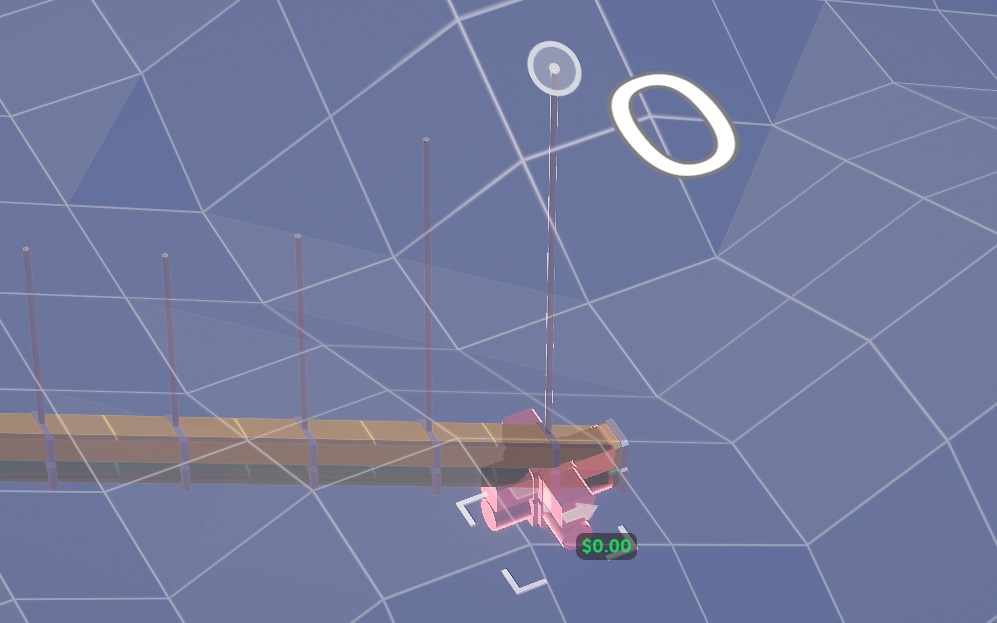
Press 'M' on your keyboard to switch to a bird's eye view. now you can click and drag to connect them from a 2D perspective.
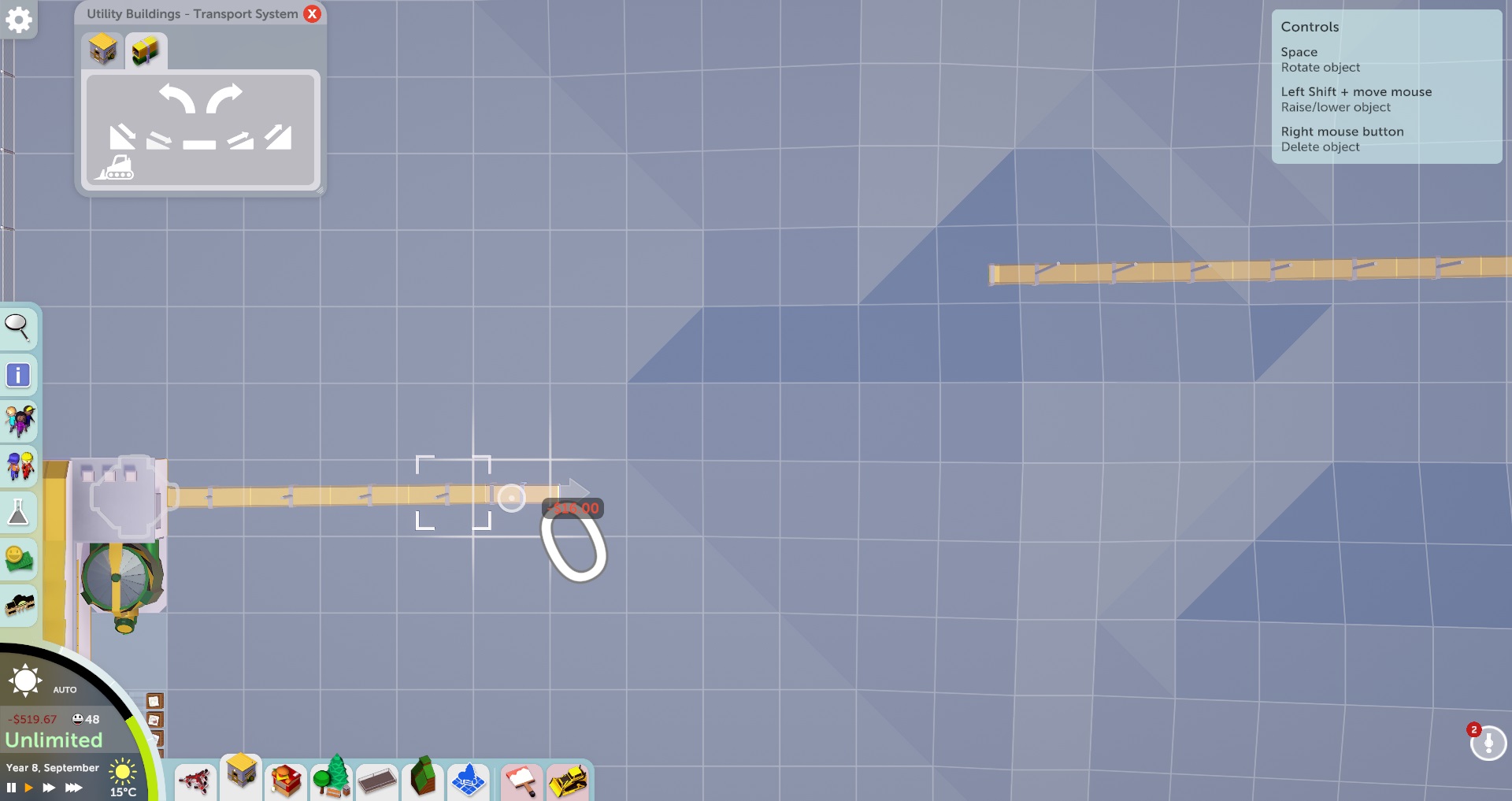
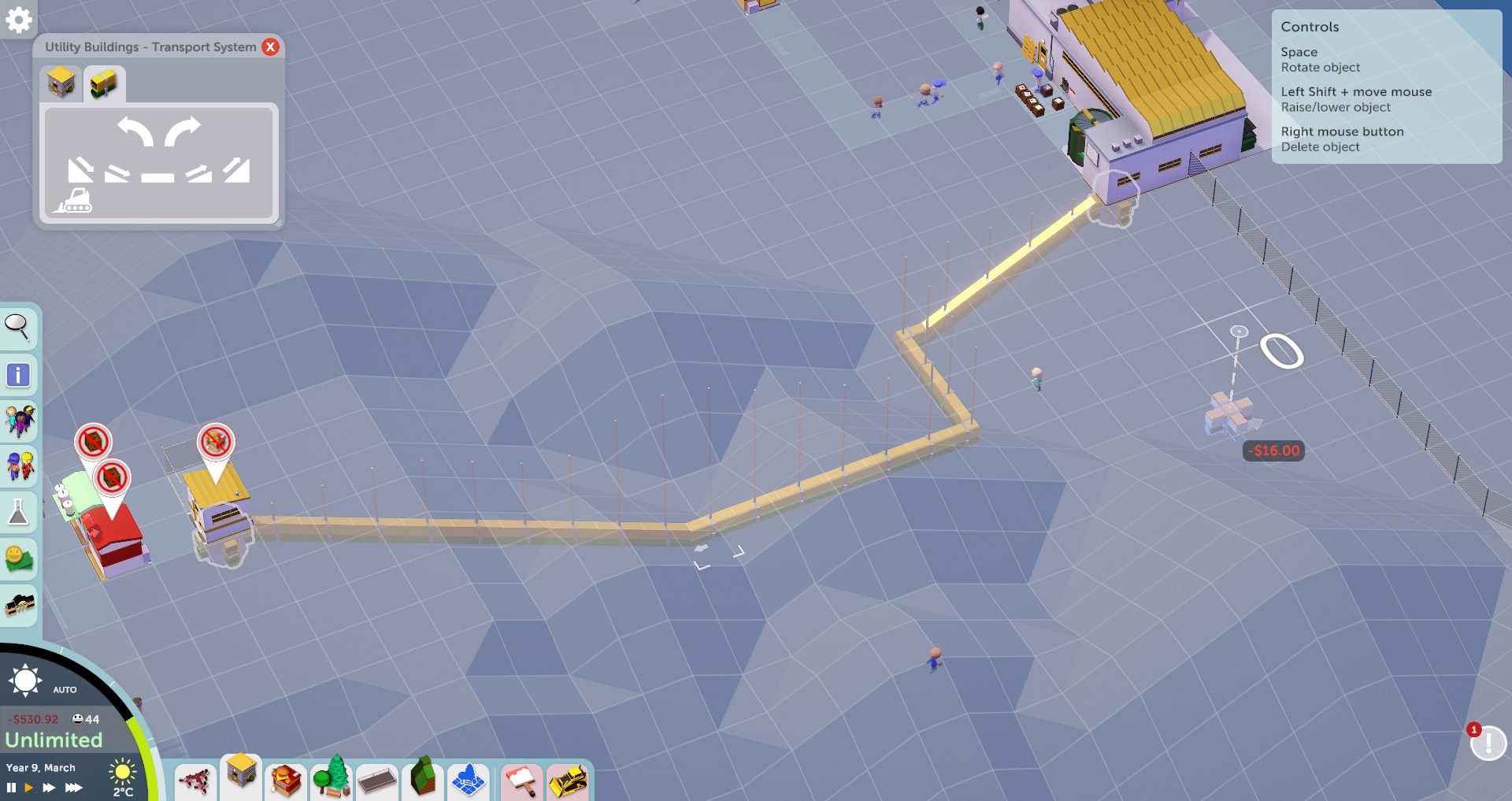
Using this strategy is slightly more expensive but much easier.
UTILITY/STAFF BUILDINGS
This section is about the windows that come up when clicking on staff rooms, staff training rooms, depots, and trash chutes.
Staff Room and Staff Training Room
The windows for staff rooms and staff training rooms are very similar. They each have two sub tabs:
- Info
- Statistics
________________________________________________________________
Info
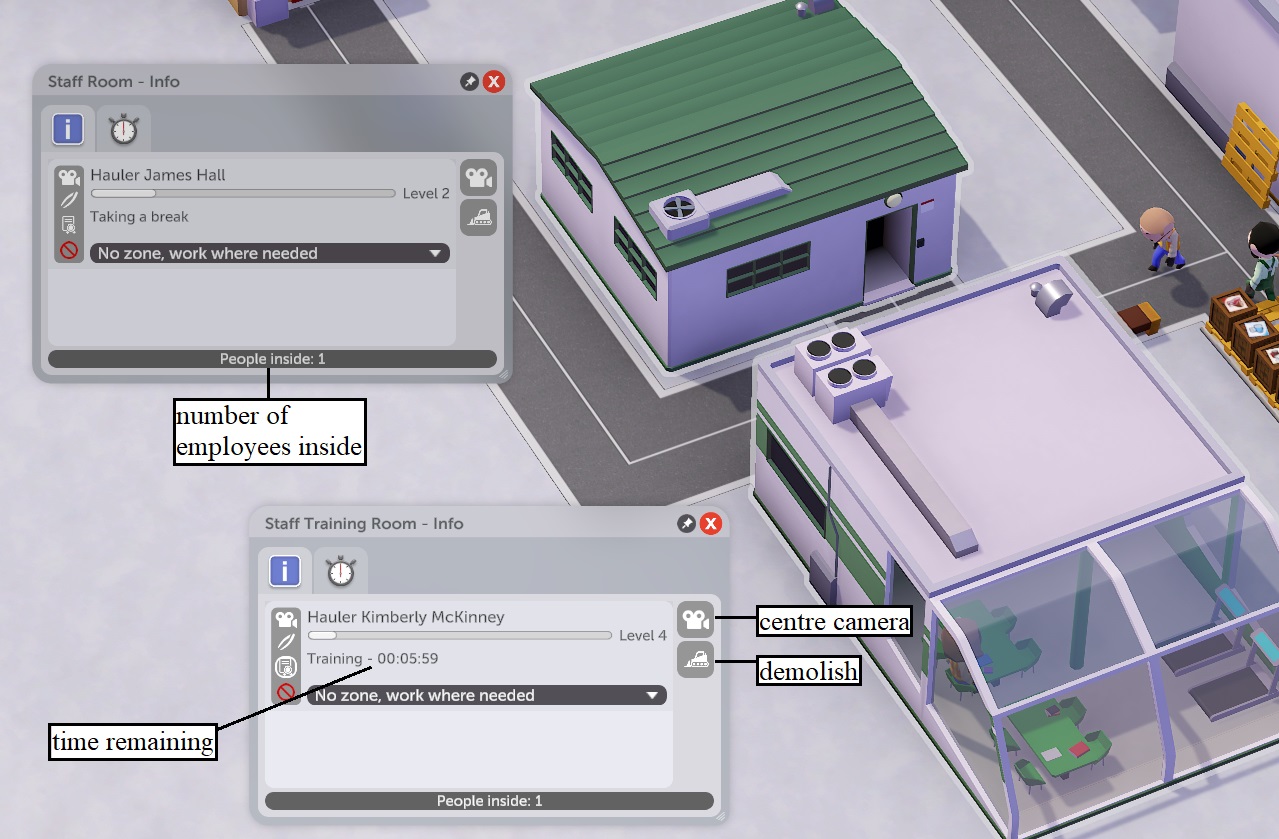
This sub tab lists all employees inside the building, and has buttons for centring the camera on, and demolishing the building. Staff training rooms have a capacity of ten employees. Staff rooms don't seem to have a capacity limit, or if there is one, it is much higher than you would ever need (I had 40 employees inside in a test).
________________________________________________________________
Statistics
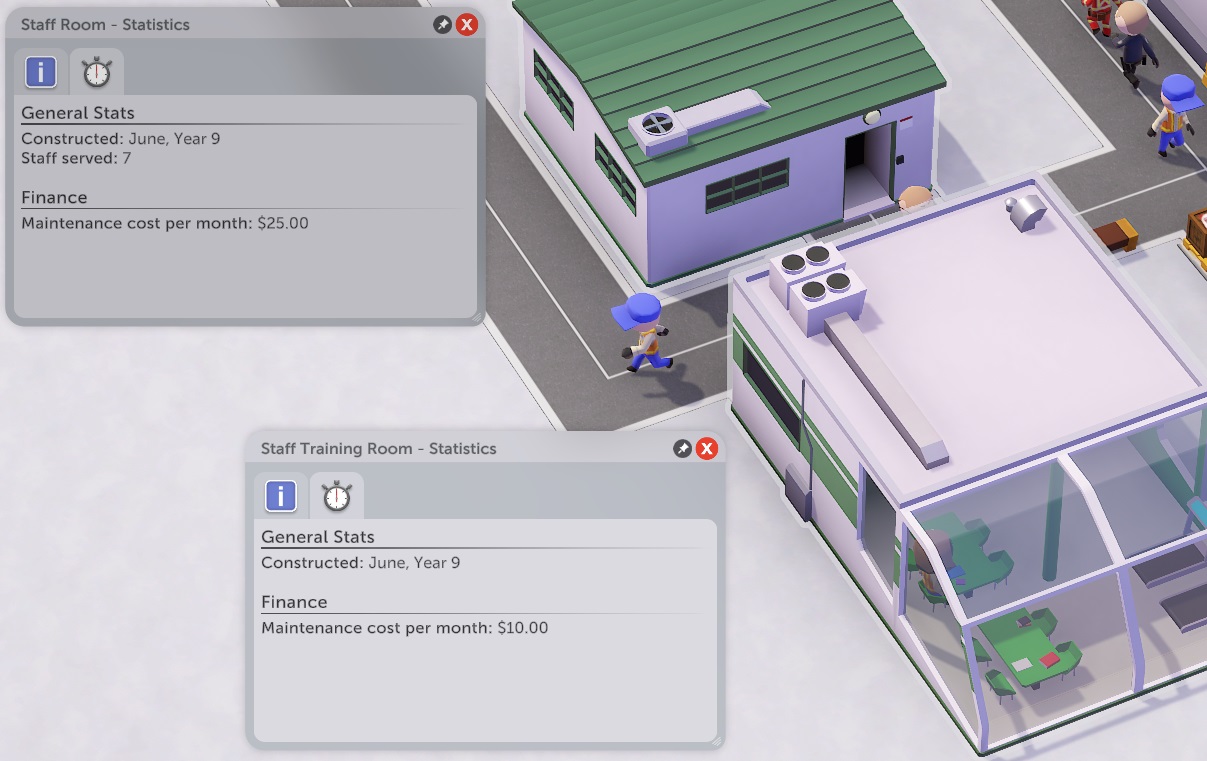
Just a couple anecdotal stats about this building: when it was constructed, and for the staff room only: how many employees have used it.
The maintenance cost per month is also shown here, which is always $25 per month for the staff room and $10 per month for the staff training room.
Depot
Depots are useful for supplying shops that are far away from the deliveries building. Janitors can also use them to drop off trash just like a trash chute. Remember that they must be connected to the deliveries building with transport tubes in order to function. The window for depots has two sub tabs:
- Settings
- Statistics
________________________________________________________________
Settings
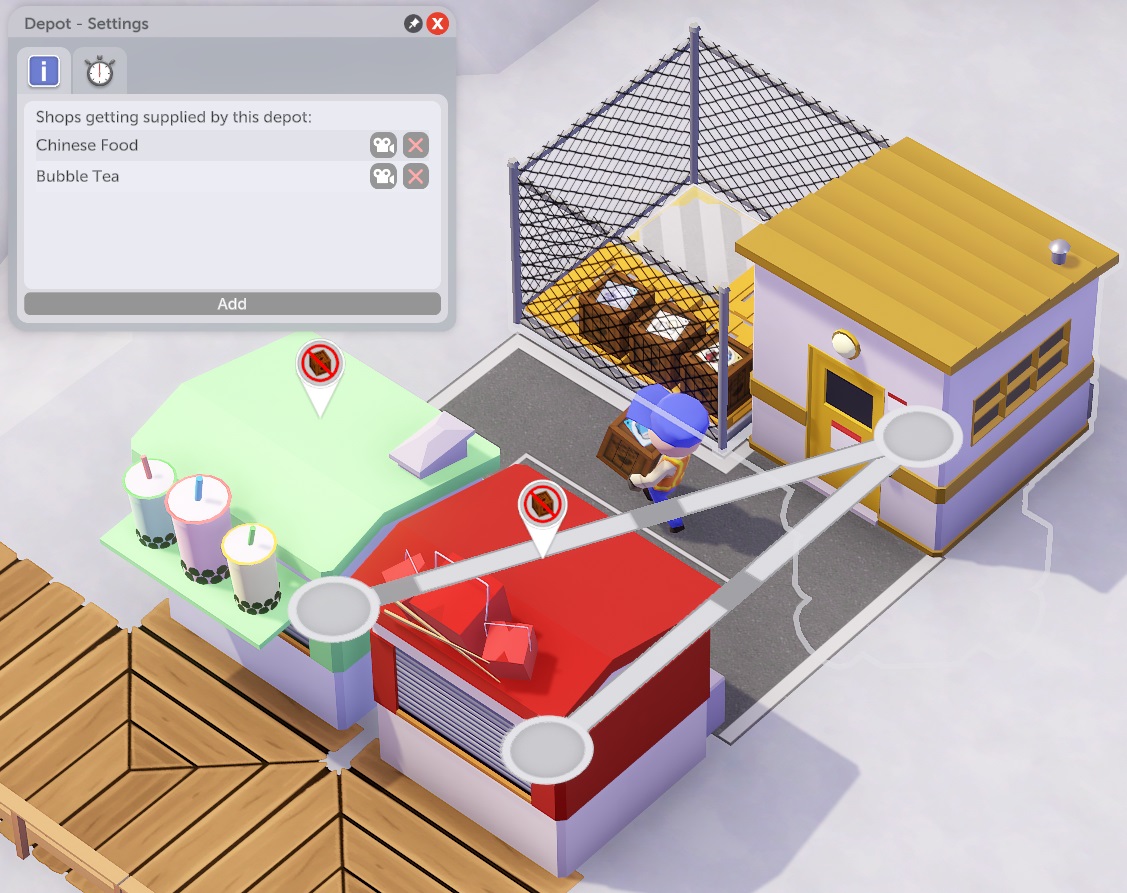
This is where you can select which shops get supplied by this depot. Shops that have been selected will be listed here and have grey lines connecting them to the depot. To select shops:
- click where it says 'Add'
- your cursor will now look like a pipette
- click directly on any shops you wish to be supplied by this depot
- haulers will now begin carrying crates from the depot to the shops
- make sure the depot is connected with paths to the front or back of the shops it is supplying
- all shops except for the vending machine can bee supplied from the back (as shown in the picture)
- guests don't like seeing haulers carrying crates, and this allows you to keep them out of view
To remove a shop from the depot, click the pink X to the right of it in the list. Clicking one of the camera icons will centre the view on that shop.
________________________________________________________________
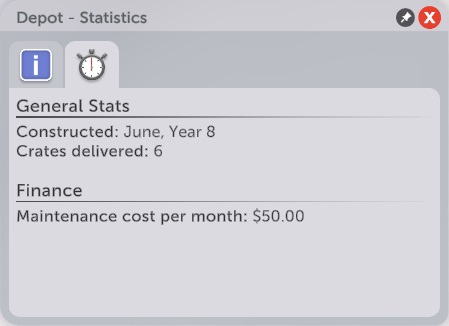
Statistics
Just some basic statistics:
- when it was constructed
- total number of crates that have been delivered from it
- maintenance cost per month (always $50)
Trash Chute
Trash chutes are useful in areas far away from the deliveries building or depots (they are cheaper to maintain than depots) so janitors don't have to walk long distances to drop off trash bags. They need to be connected to the deliveries building with transport tubes.
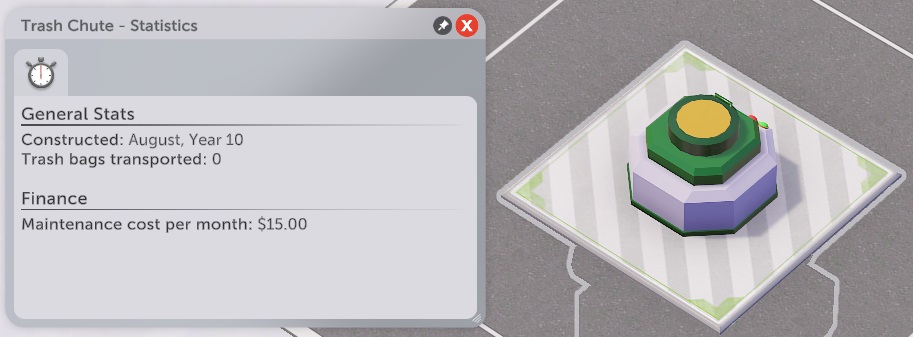
There isn't anything to manage with them. When clicked on they show three statistics:
- when it was built
- number of trash bags that have been dropped down it
- maintenance cost per month (always $15)
Funny things happen if a guest is dropped in it.
SHOPS TAB
This is where you go to build shops, info kiosks, cash machines, toilets, and first aid rooms. It can be opened from its button at the bottom of the screen or with a hotkey (F3 by default). When hovering over a shop, a tool tip will show how many of this shop already exist in the park, the maintenance cost per month of the building, and a list of the products sold at that shop and some information about them. All parks need shops, otherwise guests will quickly become hungry, thirsty, and and as a result, grumpy. And don't forget to place toilets! In the picture below, Soft Drinks is currently being hovered over.
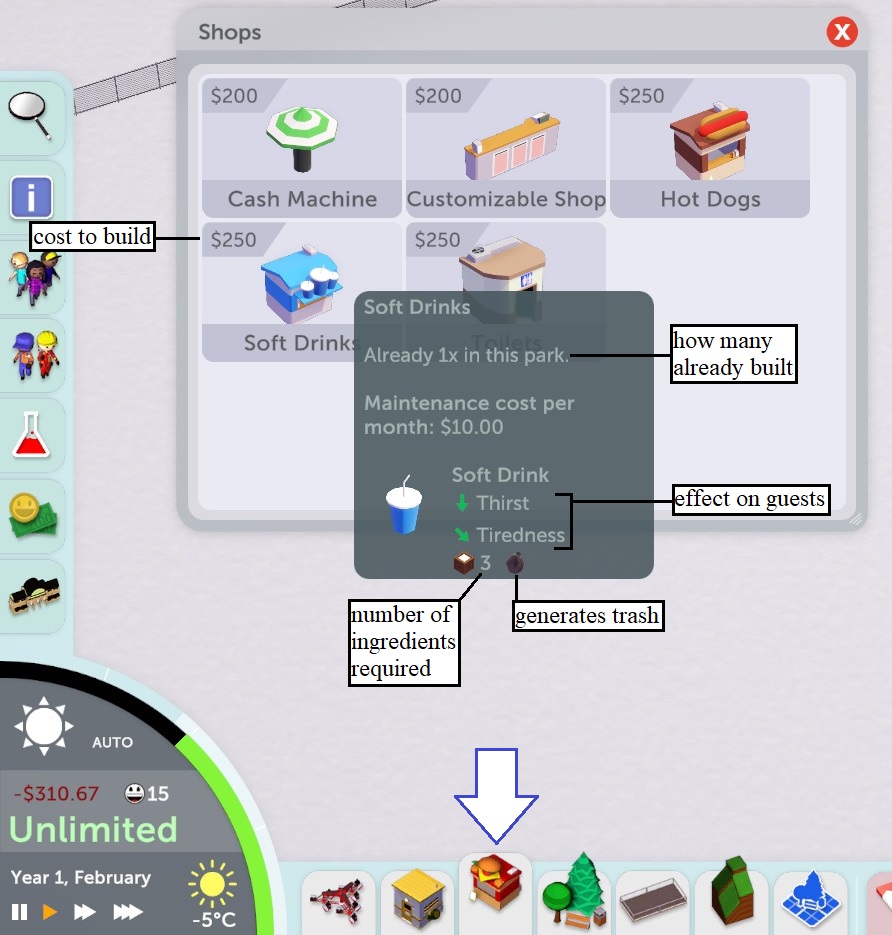
cost to build
- how much it costs to place this shop
- actual cost can be higher if it is placed elevated or below ground
- doesn't come pre-supplied, and supply crates will be ordered immediately when it is placed, which costs additional money
how many already built
- how many of this shop already exist in the park
- each shop you place causes a small increase in the number of guests attracted to your park, but this effect is decreased when there are multiple instances of the same shop in the park
effect on guests
- effects this shop's product has on guest's stats
- vertical up arrow means it greatly increases this stat
- diagonal up arrow means it increases this stat slightly
- diagonal down arrow means it decreases this stat slightly
- vertical down arrow means it greatly decreases this stat
- green arrow indicates positive effect
- red arrow indicates negative effect
number of ingredients required
- number of resource crates that must be delivered each time this product is restocked
- different products sold in the same shop often share some ingredients, in which case those ingredients don't need to be delivered separately
generates trash
- this symbol indicates that once a guest is finished with this product, they will have leftover trash to throw out either in a trash bin or on the ground if you don't have enough trash bins
not pictured: more popular in hot or cold weather
![]()
- some products are more popular in hot or cold weather, in which case they will have a sun or snowflake symbol respectively
Placing
To place a shop: click on it in the shops tab and a preview of it will now be attached to your cursor. Click to place it where ever you want.
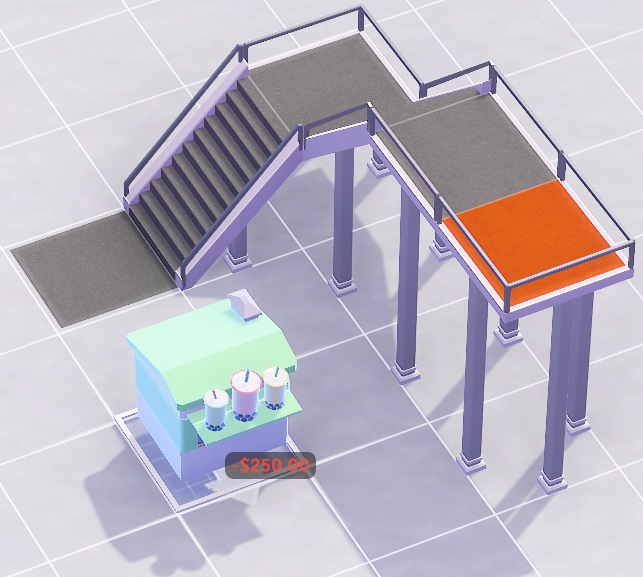
- hovering over a path will cause the shop to match the height of that path and appear adjacent to, and facing, it
- pressing left Ctrl while hovering over any in-game object (paths, deco, etc.) will cause the preview to snap to and stay at the height of that object
- in the picture to the right, hovering over
the orange path will cause the preview to match its height; pressing left Ctrl while doing so will lock the height of the
preview to the height of the orange path
- in the picture to the right, hovering over
- holding left shift while moving the cursor up and down will raise and lower the height of
the shop - tapping left shift will reset height snapping
- press space bar to rotate it
- once you have done this, this preview will no longer automatically rotate to face paths
SHOPS
This section is about the window that pops up when a shop is clicked on. It has six sub tabs:
- Info
- Inventory*
- Statistics
- Sales*
- Opinions
- Tasks
*these sub tabs are absent for toilets, cash machines, and first aid rooms
Info
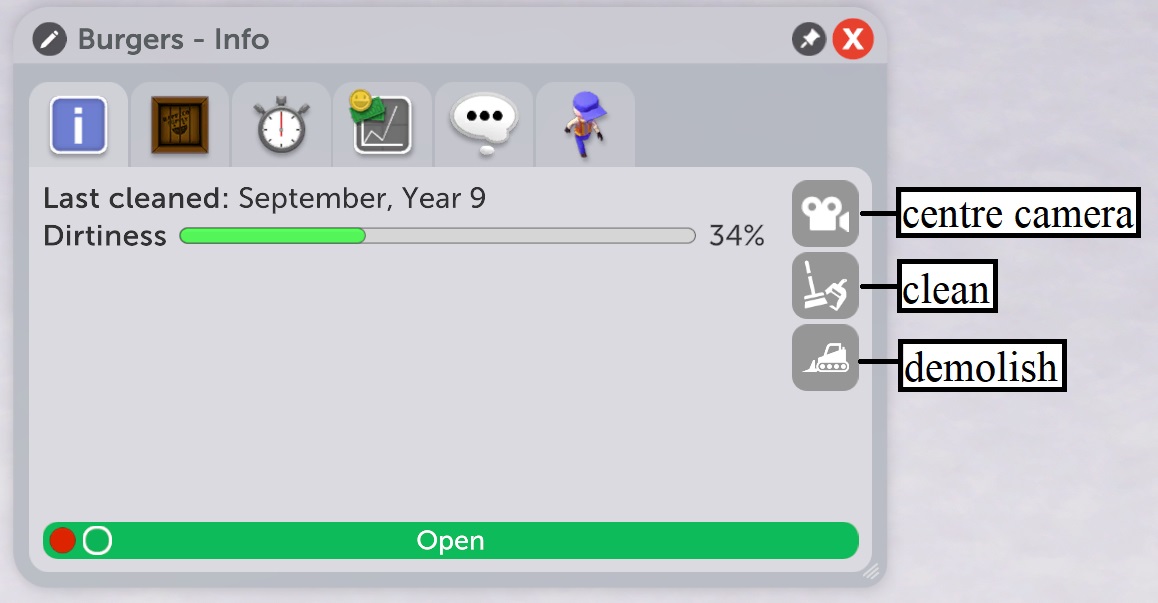
This sub tab contains information on when this shop was last cleaned by a janitor, as well as how dirty it is currently (food/drink stalls and toilets only).
- food/drink stalls that are dirty can give customers food poisoning (increasing their nausea stat to maximum)
- guests lose happiness from using dirty toilets
- shops are automatically cleaned when they reach 75% dirtiness
Clicking the red and green dots in the lower left will close and open the shop respectively.
Clicking where it says 'clean' will send a janitor to clean the shop immediately.
Toilets also have an option here to charge guests to use them, which I think is evil.
Inventory
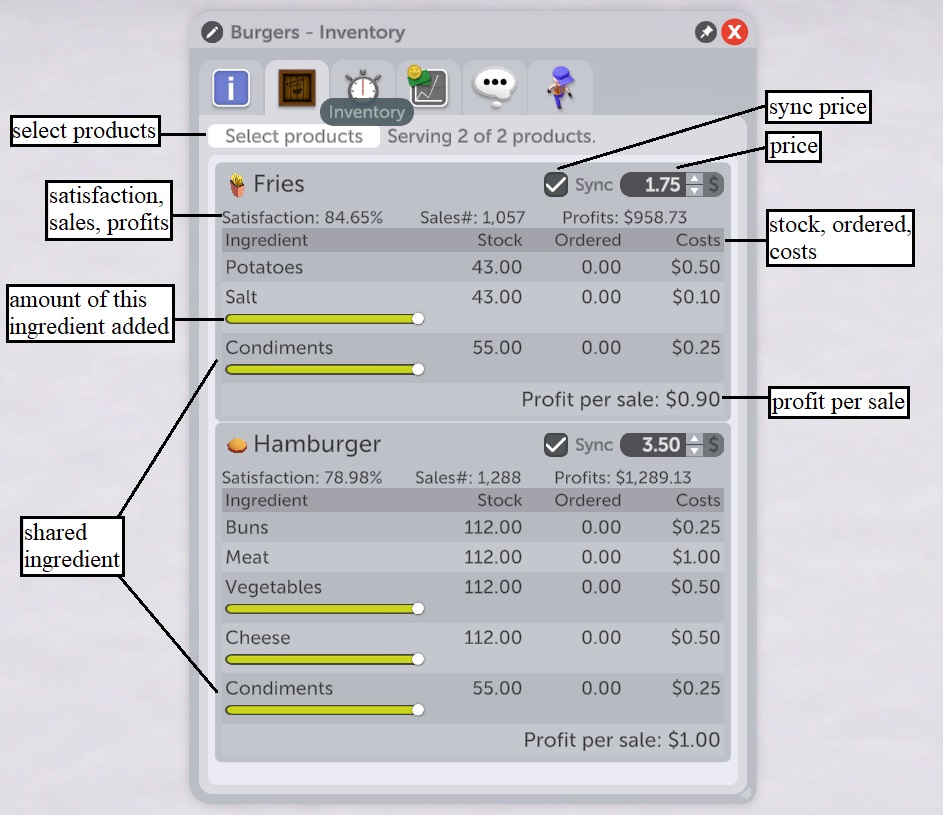
This sub tab contains information and options regarding items sold in the shop.
select products
- click here to select what products this shop should sell (eg. for this shop, I could deselect fries to make it only sell burgers)
satisfaction, sales, profits
- guests will be less satisfied with products that cost more or have some of their ingredients reduced
- sales is the total number of this product that have been sold from this shop
- profits is the total profit made from selling this item at this shop
amount of this ingredient added
- some ingredients allow you to decrease how much of it is used with a slider
- decreasing an ingredient will save money but decrease guest satisfaction
shared ingredient
- some ingredients are shared between multiple items at a shop, meaning that if this ingredient runs out, no products sold at this shop that use this ingredient will be available until it is restocked
sync price
- make this the price of this item in all shops in the park
price
- the price of this product
- there are three ways to change it:
- click on the number and type in a new number on your keyboard
- click on the number and scroll the mouse wheel
- click on the two tiny arrows to the right of the number
- rarely, some parks don't allow charging for shop products, in which case the price will be zero and greyed out
stock, ordered, costs
- stock is how much of an ingredient is currently stored in the shop
- ordered is how much stock has been ordered and is sitting in crates at the deliveries building or a depot waiting to be delivered to the shop by haulers
- costs is how much this ingredient costs for each of this product sold
profit per sale
- profit made each time one of this product is sold (customer's price minus costs of ingredients)
Statistics
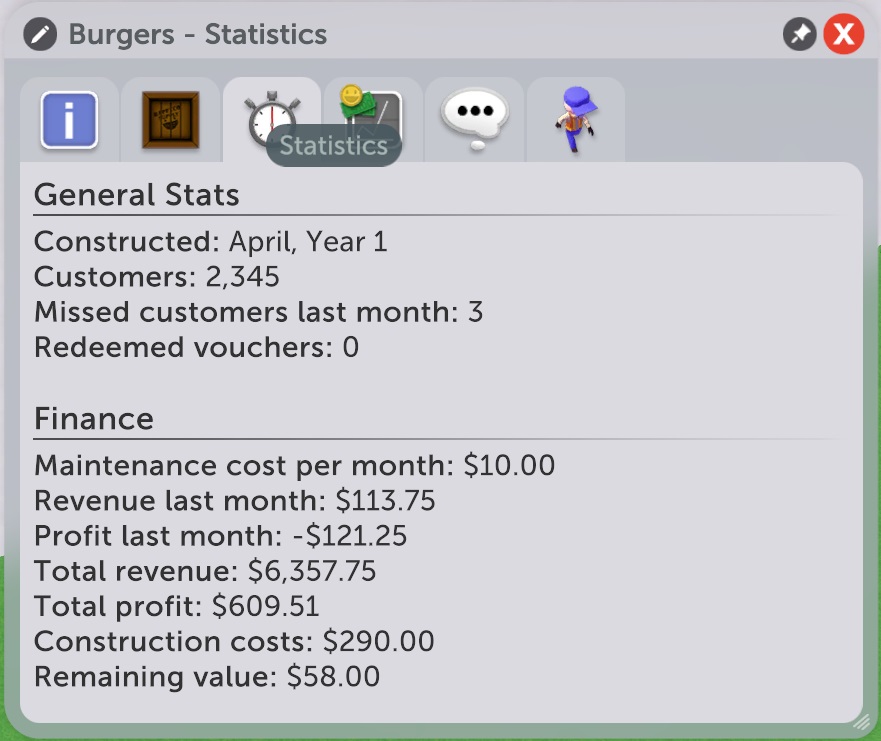
Some statistics about this shop.
________________________________
General Stats
Constructed
- in-game month and year when this shop was constructed
Customers
- total number products that have been sold or times that this shop has been used
missed customers last month
- number of guests that were going to use this shop but didn't because the product they wanted was out of stock or too expensive
redeemed vouchers
- number of vouchers related to marketing campaigns that have been redeemed for a free item from this shop
- not shown for toilets, first aid rooms, or cash machines
________________________________________________________________
Finance
Maintenance cost per month
- how much the building costs to maintain per month
- separate from costs associated with restocking ingredients
Revenue last month
- gross revenue of this shop last month
Profit last month
- net profit made from this shop last month when accounting for restocking and maintenance costs
Total revenue
- total gross revenue that this shop has made over its lifetime
Total profit
- total net profit made by this shop since it was built (not including initial construction cost)
Construction costs
- how much this shop cost to build
Remaining value
- how much money would be refunded if you deleted this shop
- starts the same as the construction cost then decreases slowly over time
Sales
This sub tab contains a graph allowing you to view past sales data of this shop. It is recommended to expand the window (as I did for the picture) to make it easier to read.
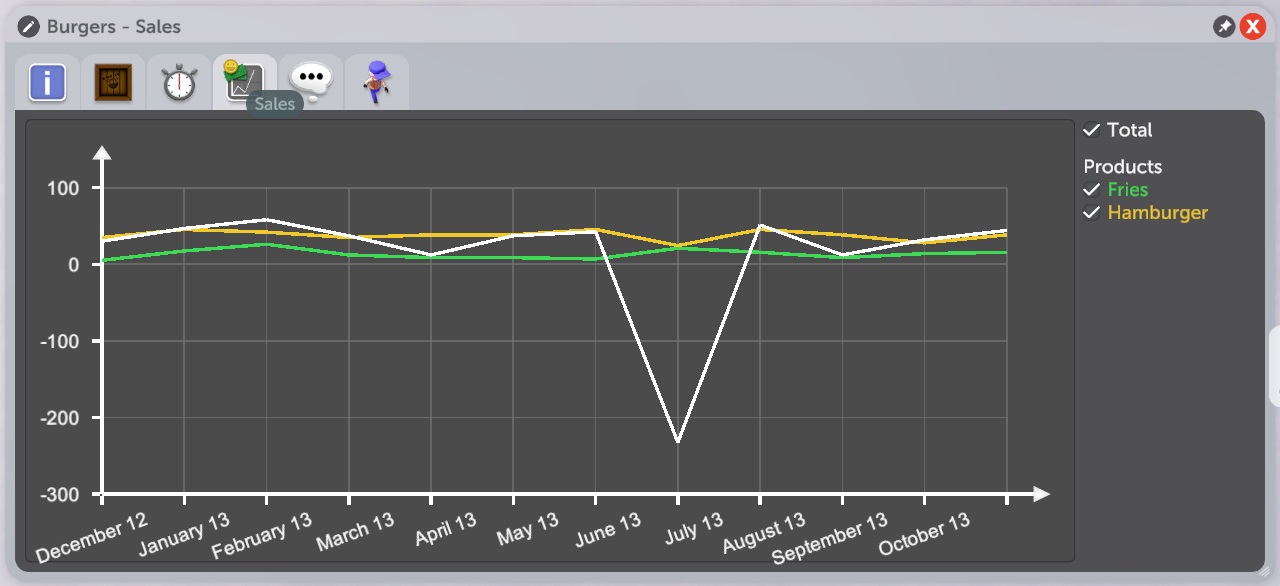
The white 'Total' line represents the profit of the shop for that month while the others represent the total number of that product sold in that month. That big dip in profits in June in the picture is because a bunch of product was ordered that month.
Opinions
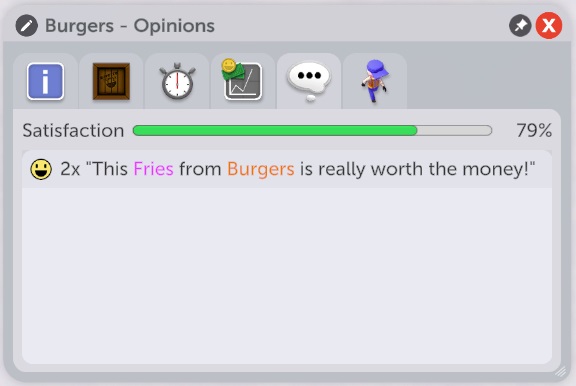
What guests are thinking about this shop. Watch out for thoughts about the prices: If lots of guests are thinking products are cheap, you can raise the prices; If many are thinking the opposite, you may want to lower prices. If you see thoughts about the shop being out of stock, you may want to hire more haulers or build another shop. For toilets, watch out for the thought "toilets is occupied". Toilets have a limited capacity, so you may need to build a second one to handle the demand. How satisfied guests are with this shop is also shown as a green bar at the top.
Tasks
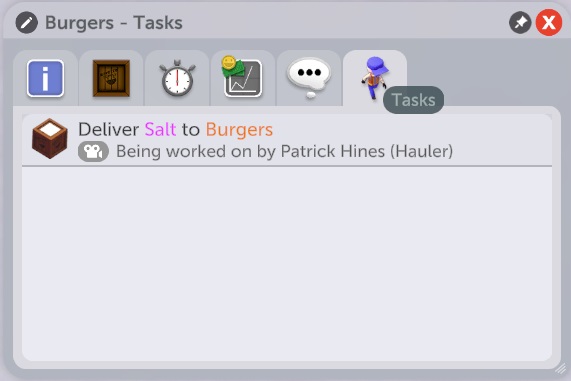
This sub tab shows tasks that are currently in need of completion by employees. Stocking tasks like the one in the picture to the right need to be completed by haulers, while cleaning tasks need to be completed by janitors. Clicking the small camera icon will centre the camera on the employee working on this task.
DECO TAB
This tab is where you go to find all sorts of decorations that can increase the beauty of your park and hide ugly things like toilets and staff rooms. It can also by opened with a hotkey (F4 by default). It has two sub tabs: one for regular deco objects, and another for path attachments.
Deco
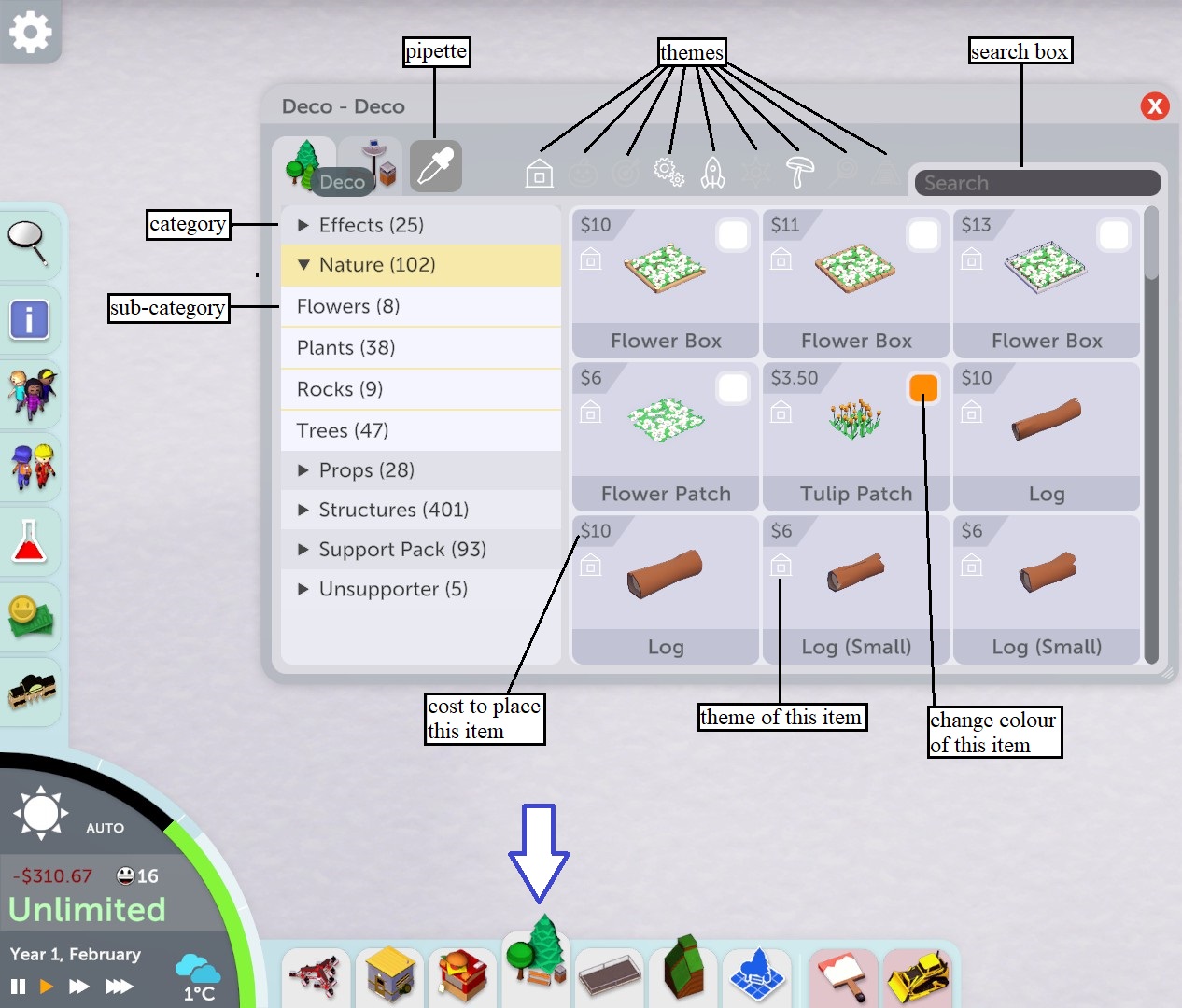
pipette
- can be used to copy most scenery objects placed in the park
- click on it to activate it (or use its hotkey ('P' by default)), then click on any scenery object in the park to immediately select that item in the deco tab
- selected item will have the same colours and size as the deco item in the park that was clicked on
- also the cursor will be snapped to the height of the piece that was pipetted
- easily one of the most useful tools in the game
themes
- with these icons, deco objects can be filtered by theme
- clicking on one of these icons will filter out all deco objects that match that theme
- right-clicking will filter out all other themes except the one right-clicked on
- if a theme is greyed out it means that no items from that theme are researched
search box
- type here to search for a specific scenery piece if you can't remember where it is in the deco tab
category
- all deco items are divided into categories
- clicking on a category will show all deco objects in it and reveal/hide its sub categories
- in brackets beside each category name is the number of deco objects available in it
- in the base game there are four categories:
- effects (fireworks, emitters, lights, etc.)
- nature (trees, plants, rocks, etc.)
- props (crates, statues, fountains, miscellaneous scenery, etc.)
- structures (walls, roofs, signs, structure details, etc.)
- installing deco mods may add additional categories (in the picture support pack and unsupporter are mods)
sub category
- within each category are several sub-categories allowing you to narrow down your search for deco pieces even more
cost to place this item
- how much it costs to place this object
- how much a deco object increases the deco scores of nearby rides and paths is loosely based on how much it costs, with more expensive items generally increasing deco scores more than cheap objects
theme of this item
- small icon showing what theme this object belongs to
change colour of this item
- many deco objects support up to four custom colours
- clicking on a colour will open the colour picker (see the brush tab and custom colours section of this guide for more information)
not pictured: change size
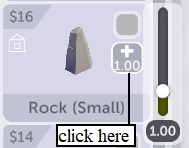
- some deco objects allow you to change their size
- to do this click where it says 'click here' in the picture to the right, then drag the slider that appears or enter in a new number
- there are also hotkeys for resizing selected objects
(numpad + and – by default)
- there are also hotkeys for resizing selected objects
- to do this click where it says 'click here' in the picture to the right, then drag the slider that appears or enter in a new number
- increasing an objects size increases its cost
- size of deco cannot be edited after it is placed
Path Attachments
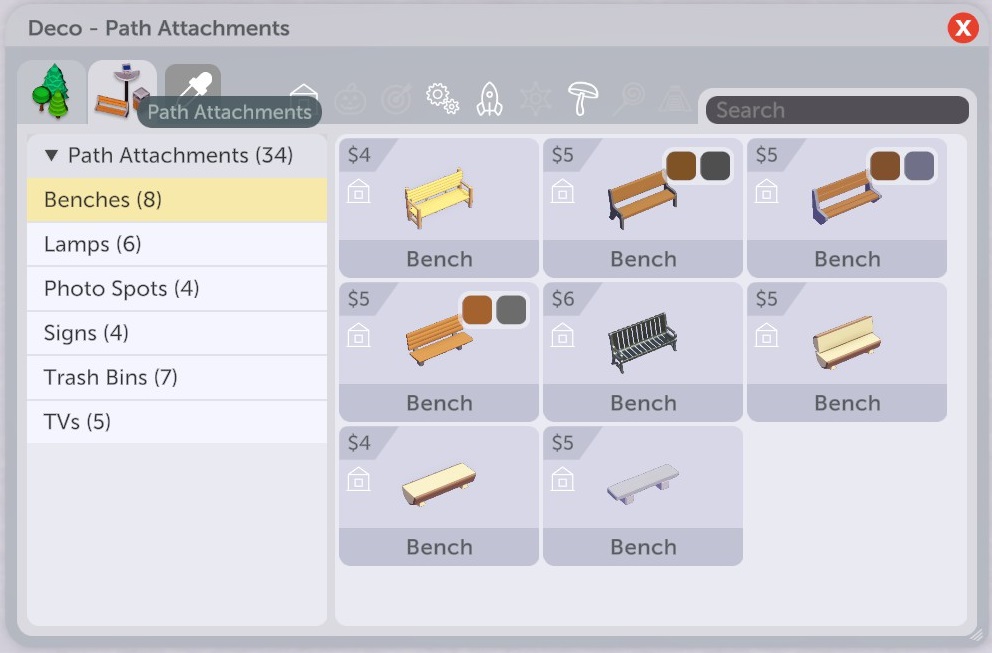
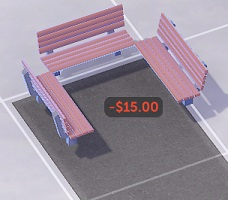
The deco objects in this section of the deco tab can only be placed along the edges of paths. Simply hover over a path with a path attachment deco object selected and the preview will snap to a spot on the path. Each tile of path has four spots (one for each of its sides) to place a path deco object. Path attachments do not contribute to deco ratings, but they are important for other reasons. Benches and trash cans specifically should be placed all around your park to give guests places to rest and throw out garbage respectively. Hold down shift while placing to place path deco objects on all available spots on a path tile at once as shown in the picture to the right.
Interactable Deco Objects
Deco objects that can be clicked on to show information or manage/customize them.
________________________________________________________________
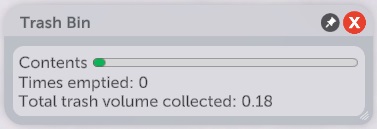
Trash Bins
Trash bins can be clicked on to show how full they currently are, how many times they've been emptied, and the total trash volume it's collected since it was placed.
________________________________________________________________
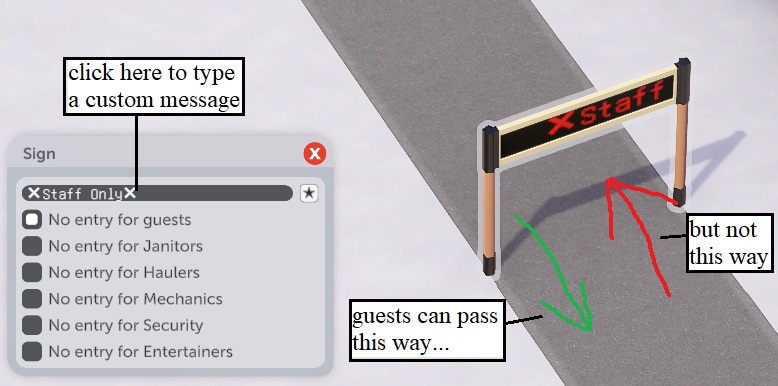
Path Signs
Path signs can be used to block access for guests or certain kinds of employees to certain areas of your park by clicking on them and ticking boxes as shown in the picture to the right. Or you can just make them say anything you want.
________________________________________________________________

3D Text Signs
The 3D text signs included in the taste of adventure DLC can be customized before placing, or after by clicking on it.
________________________________________________________________
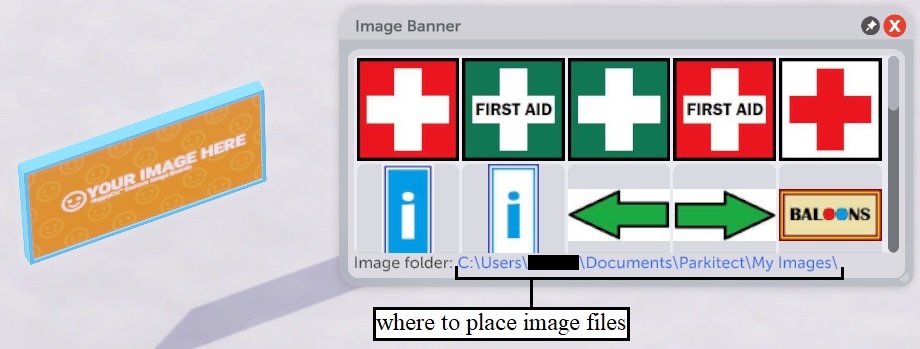
Custom Image Signs and Flags
Custom images can be put on them by clicking on them and selecting from images you have added to the file location shown (you can click on the blue text to go directly to it, then maybe pin it to quick access in file explorer so you can easily find it when saving custom images). Make sure all custom images you create have aspect (width:height) ratios of 1:2, 1:1, and 2:1, as these are the only sign sizes available in-game.
________________________________________________________________

Speakers
The speakers included in the Booms and Blooms DLC can be clicked on to change what music track they play as well as their volume. Clicking on the blue text will open the file location in which to place mp3 files if you want to listen to your own music instead of Parkitect's music.
________________________________________________________________
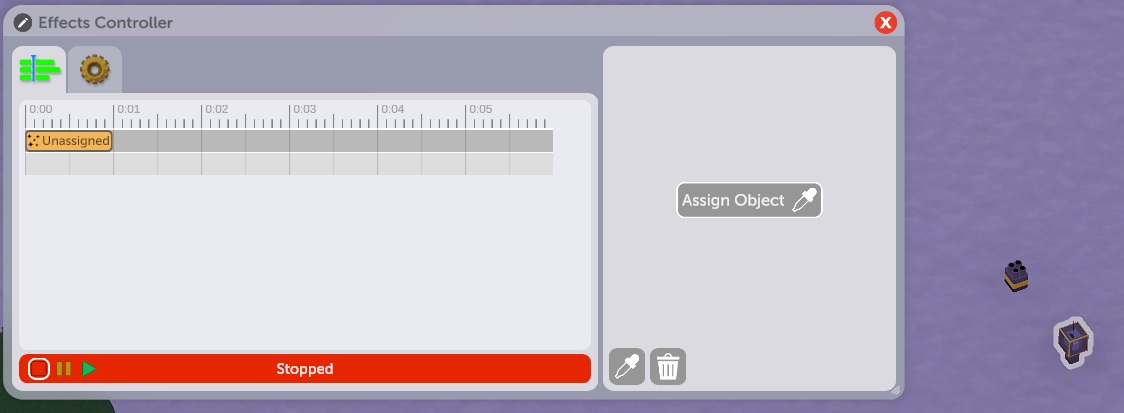
Effects Controller
See the effects controller section of this guide for more information.
Placing
While placing scenery pieces:
- once you select a scenery piece in the deco tab, a preview of what you are about to
place will now be attached to your cursor - hold left shift and move the mouse up and down to change its height
- tap left shift to reset height snapping
- press left ctrl to snap its height to whatever in-game object you're cursor is currently hovering over
- press spacebar to rotate it
________________________________________________________________
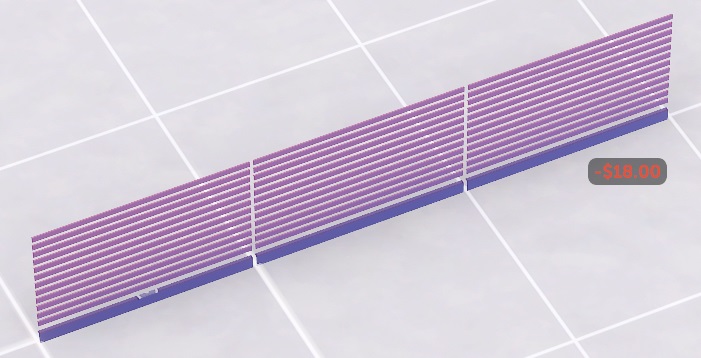
Fences
When building fences from the fences sub-category, you can click and drag to place several in a row all at once. Also, fences will adjust to the slope of the terrain or any path they are adjacent to.
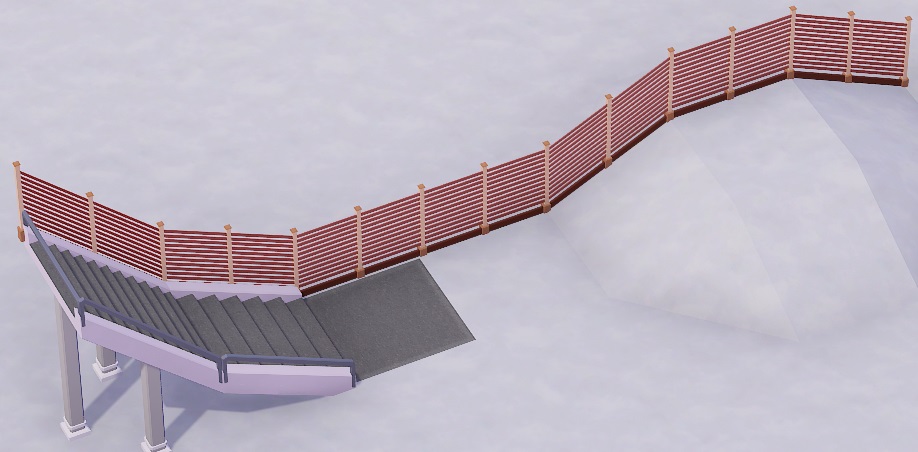
________________________________________________________________
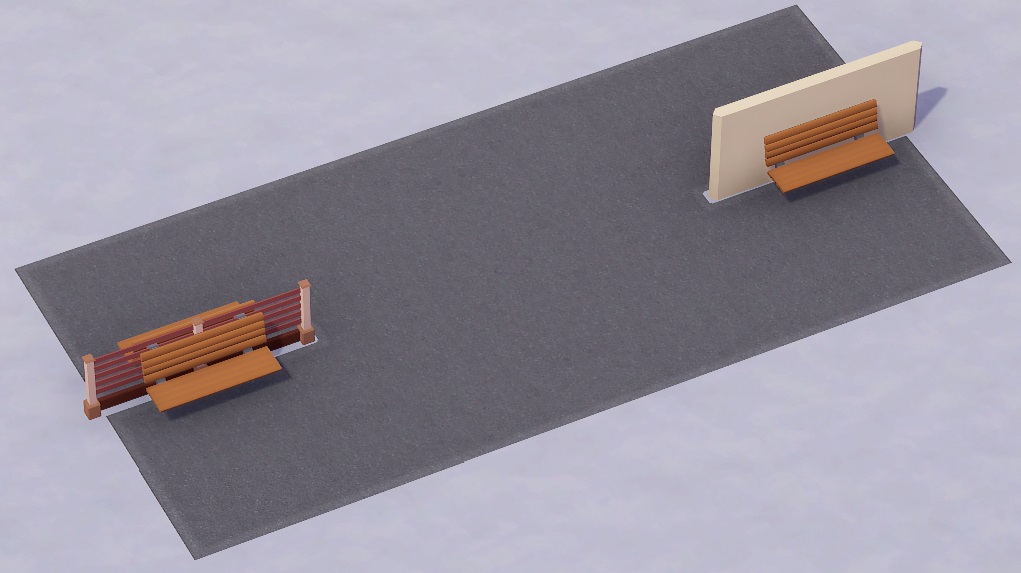
Blocking Paths
Paths can be blocked from connecting to things and other adjacent paths by placing a wall or fence between them (doesn't work with queue paths).
EFFECTS CONTROLLER
Each effects controller allows you to set up one effects display with fireworks, lights, doors, emitters, etc. You need the Booms and Blooms DLC to have access to it. It has two sub-tabs: the first is where most of the customization options are, while the second is for setting what triggers the display to begin.
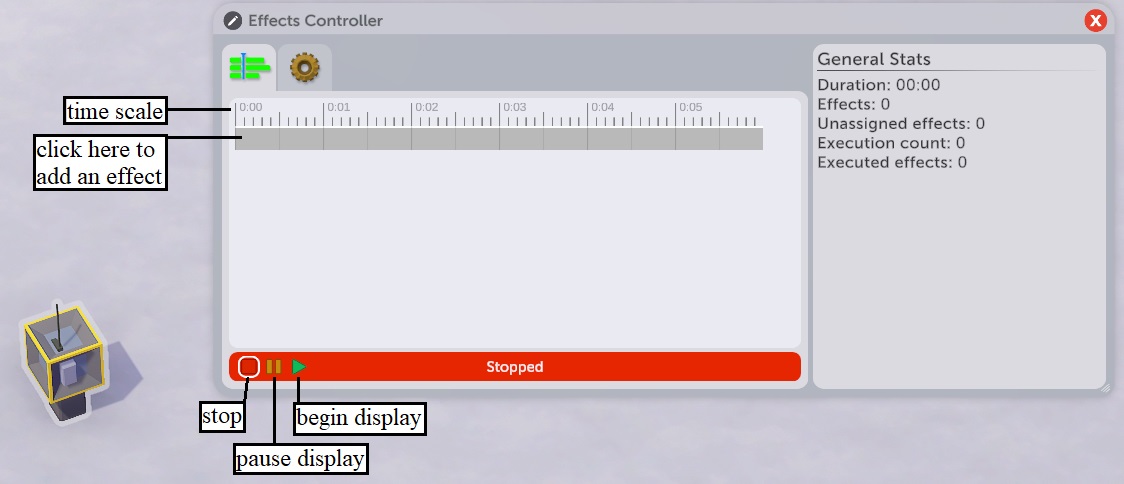
Effects controller window before adding any effects to it.
As you can see in the above picture, when no effects are selected, you can see some statistics for the controller related to the length of its display, number of effects under its control, effects you have added that have yet to be assigned to an object, the number of times it has been triggered (either manually or from an automatic trigger), and the total number of effects that have been executed. Once you have clicked in the grey area to add an effect you will need to assign an object to it.
Assigning Objects to effects

Once you have added an effect, you will need to assign an object to it that can be triggered to perform an action, such as a firework launcher or emitter. All deco objects in the deco tab that are in the effects category are triggerable, as are the doors and gates in the Taste of Adventure DLC. To assign an object, make sure 'assign object' is selected (your cursor should look like a pipette), then click on a triggerable in-game object.
Fireworks
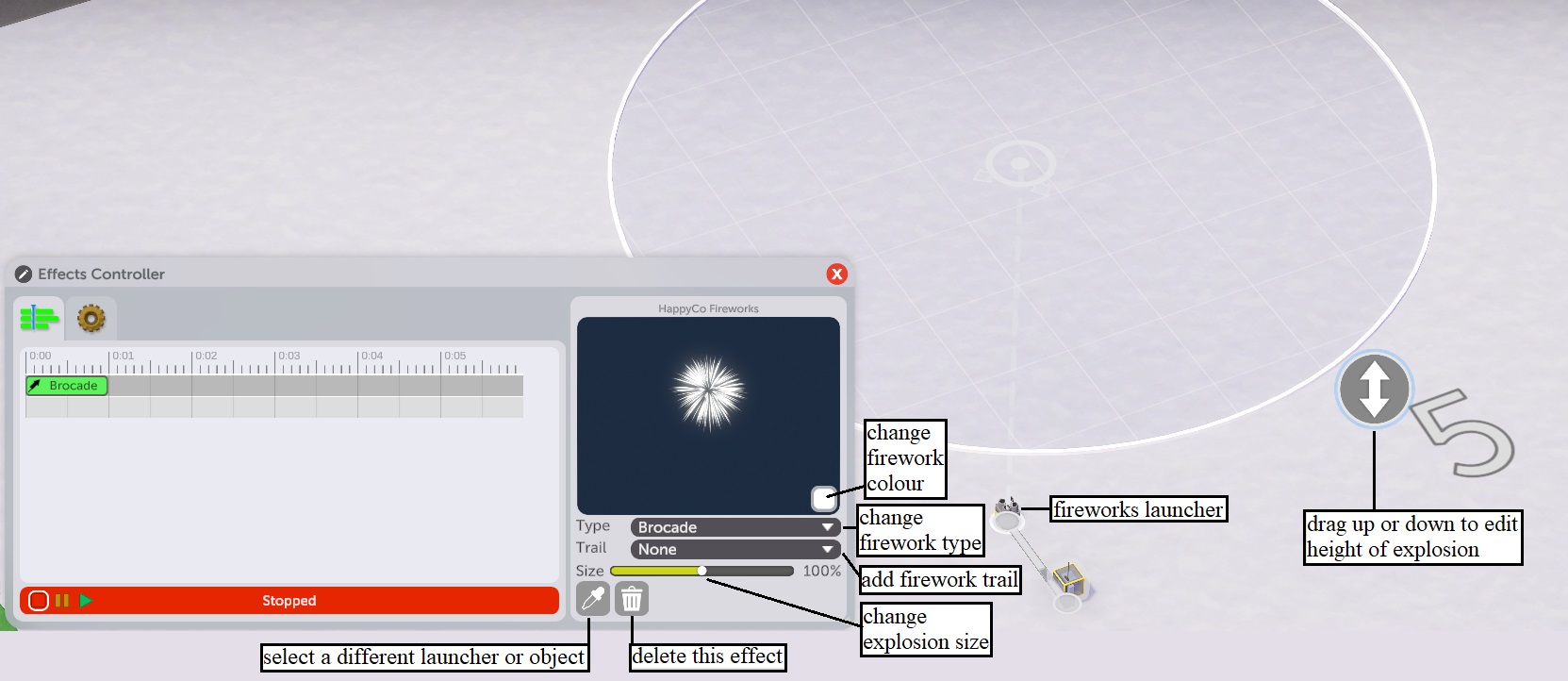
If you select a firework launcher, you will be presented with these options to customize its fireworks.
Other Effects
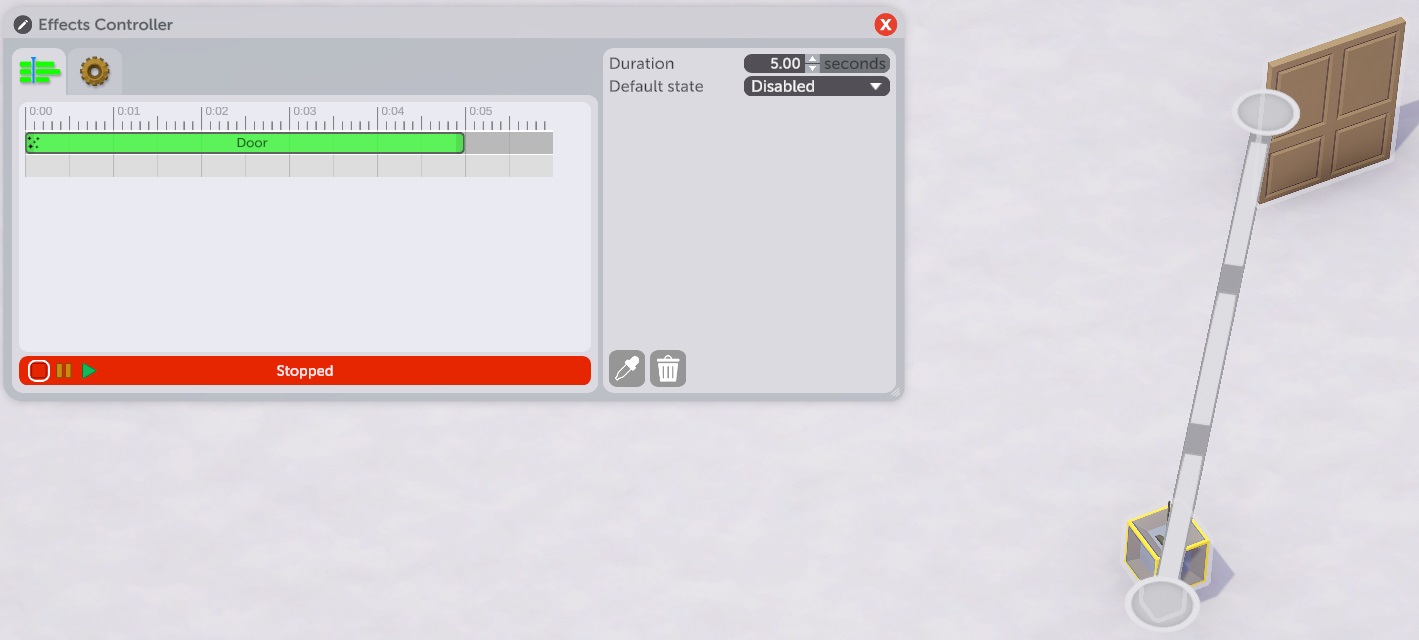
If you select something other than a firework, you will be given these options to change the duration of the effect (how long a door remains open/closed, how long a water jet shoots water, etc.), and whether it is active/enabled by default or not (eg. if the door in the picture was enabled by default, it would always be open except when being triggered by the effects controller). Some emitters (fire jet, smoke emitter, water jet) allow you to customize how big they are when triggered. When speakers are selected, you are given the same customization options for them in the effects controller window that you get if you just click on them normally.
Trigger
The second sub tab in the effects controller window is for setting what triggers its effects.
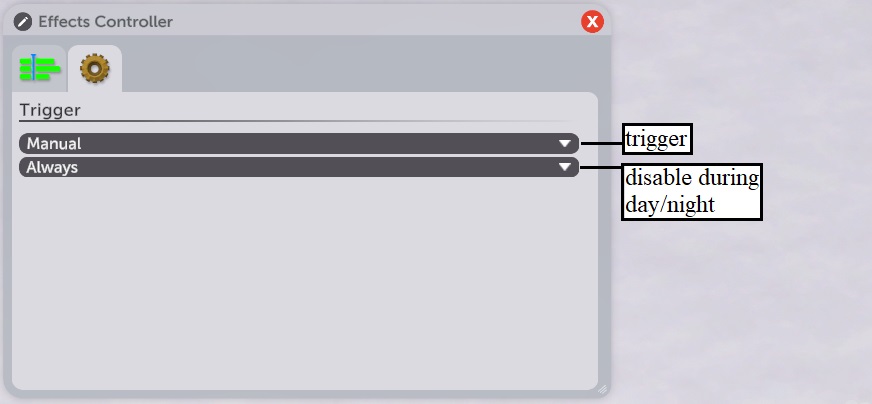
trigger
- options are:
- manual
- this controller's effects will only trigger manually (by you clicking in the effects controller to begin the display)
- time interval
- set this controller's effects to trigger every x minutes
- night change
- set this controller's effects to trigger when nighttime starts if day/night cycle is enabled
- attraction
- set this controller's effects to trigger when a selected flat ride begins its operation cycle
- track segment
- set this controller's effects to trigger when a train passes over a selected track segment
- path
- set this controller's effects to trigger when a guest walks on a selected path tile
- manual
disable during day/night
- click to select whether this controller can be triggered any time, only during the day, or only during the night

An effects controller firing multiple fireworks. The blue line is where the display is currently.
PATHS TAB
This is where you go to build paths for guests to walk on. It can be opened with a hotkey (F5 by default). It has three sub tabs: the first is for regular paths, the second is for queues, and the third is for employee paths.
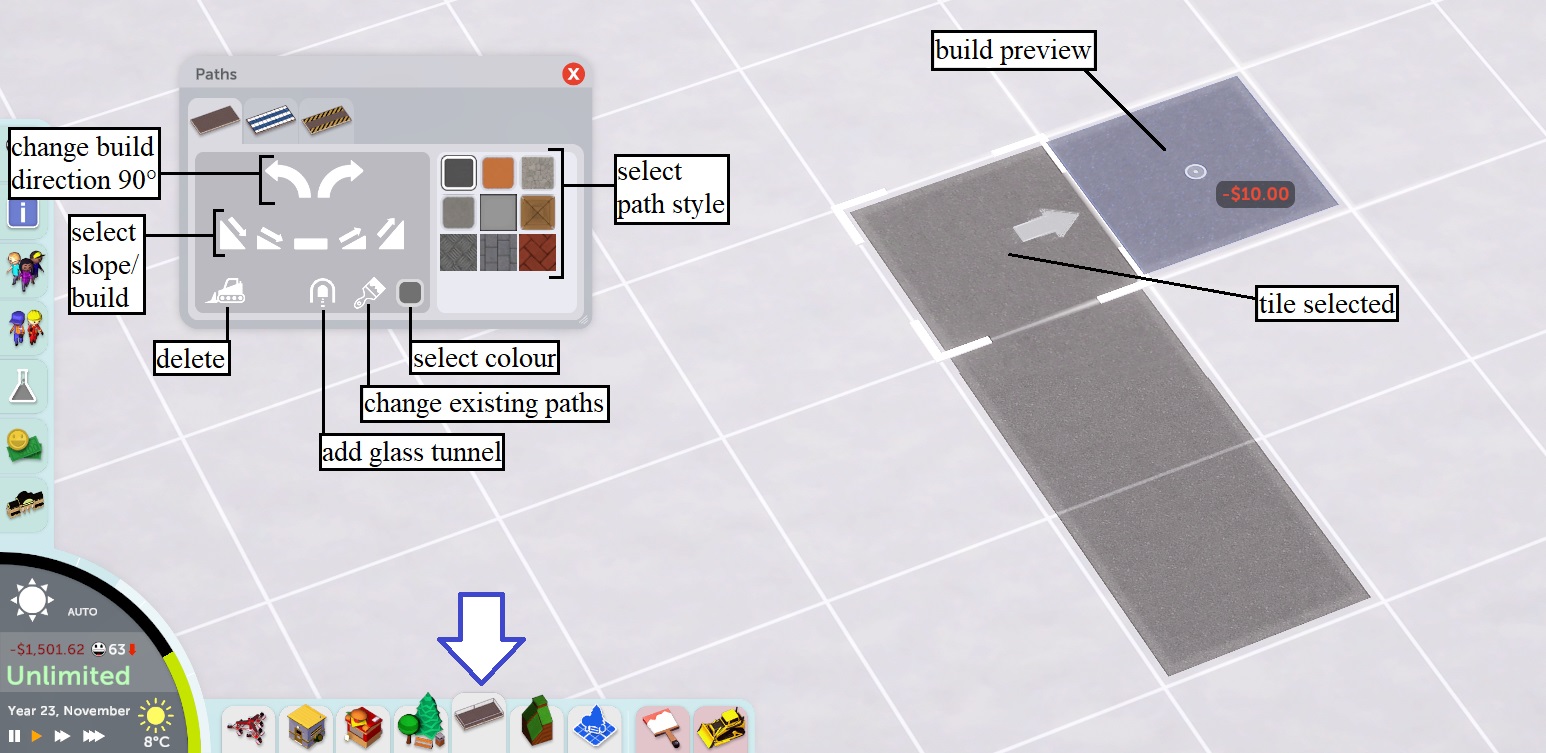
Change build direction 90°
- change the direction in which you are building
select slope/build
- click on these slope icons to build sloped or level path one tile at a time from the selected tile
- alternatively you can just click and drag in the game world to build a bunch of paths all at once
delete
- delete a single tile of path
- alternatively you can right-click and drag along already-placed paths to delete a row of paths all at once
add glass tunnel
- select this to add a glass tunnel to paths you build
change existing paths
- with this selected you can click on any placed path to change it to the style and colour you currently have selected in the paths tab
- cannot be used to change regular path to queue path, employee path to regular path, etc.
select colour
- change the colour of paths you are building (see the brush tab and custom colours section of this guide for more information)
select path style
- change the style of paths you are building
build preview
- preview of what you are about to build
- if it is red that means something is in the way or otherwise preventing you from building it there
- cost of placement is shown here
tile selected
- click anywhere in the game world to select a tile from which to build a path, or click on an existing path or ride entrance/exit to begin building from there
- the selected tile will have a small white arrow indicating which direction you are currently building
Queue Paths
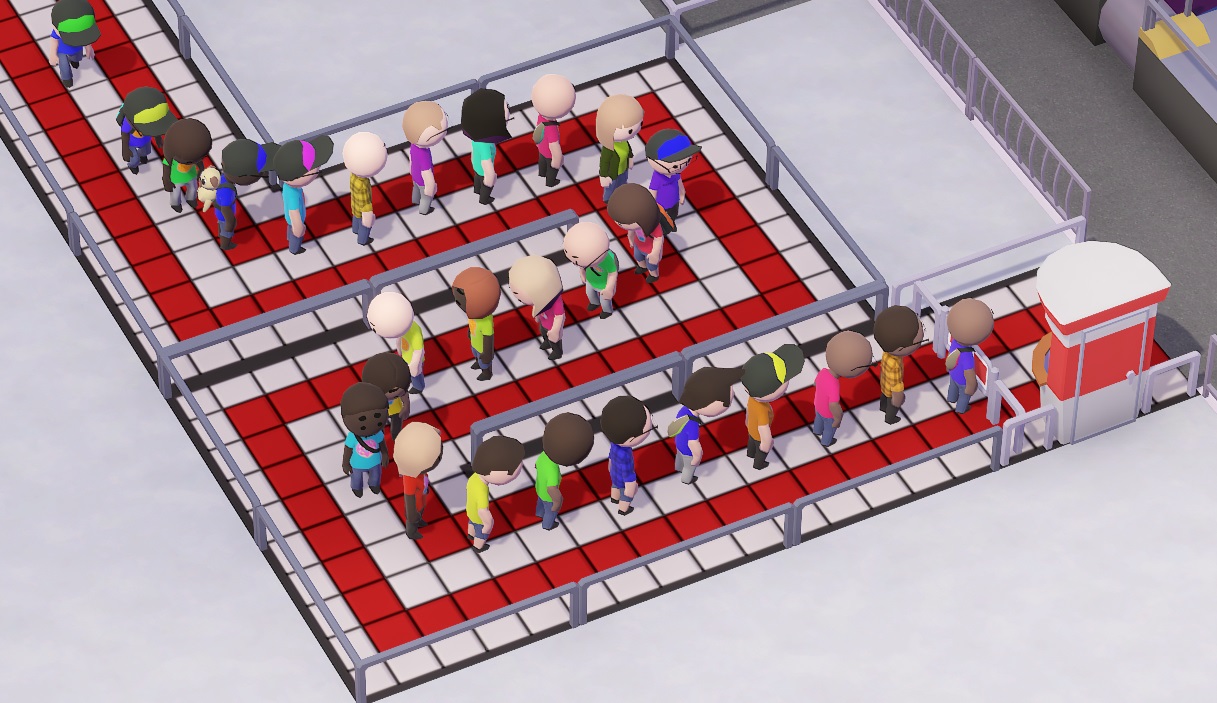
Placement of queue paths work mostly the same as regular paths except that they can be placed in a zigzag manner without connecting into a large open area. They are meant to be placed from the entrances of rides to provide a place for guests to wait in line. They do not need to be placed from exits.
Employee Paths
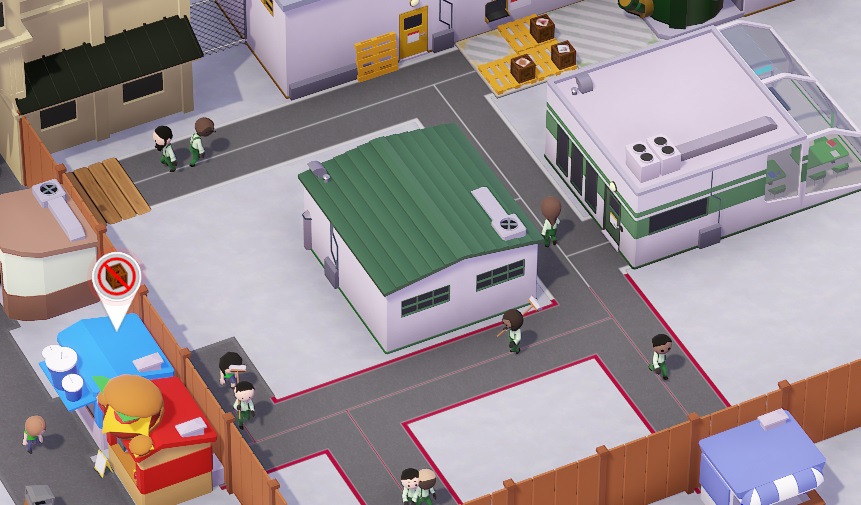
Employee paths can only be used by park staff. They are useful for building "backstage" areas where haulers deliver crates to the backs of shops. Their colour automatically matches the colour of the staff zone in which they are located. Keep in mind that employee paths are a source of bad deco rating.
TERRAFORMING TAB
This tab allows you to edit the terrain. It can be opened with a hotkey (F6 by default). It has four sub-tabs:
- Terraforming
- Terrain
- Water
- Buy Land
Terraforming
This sub-tab allows you to edit the shape of the terrain by creating hills, valleys, cliffs, etc. for a price. In some scenarios, terraforming is disabled, in which case this sub-tab will be unavailable.
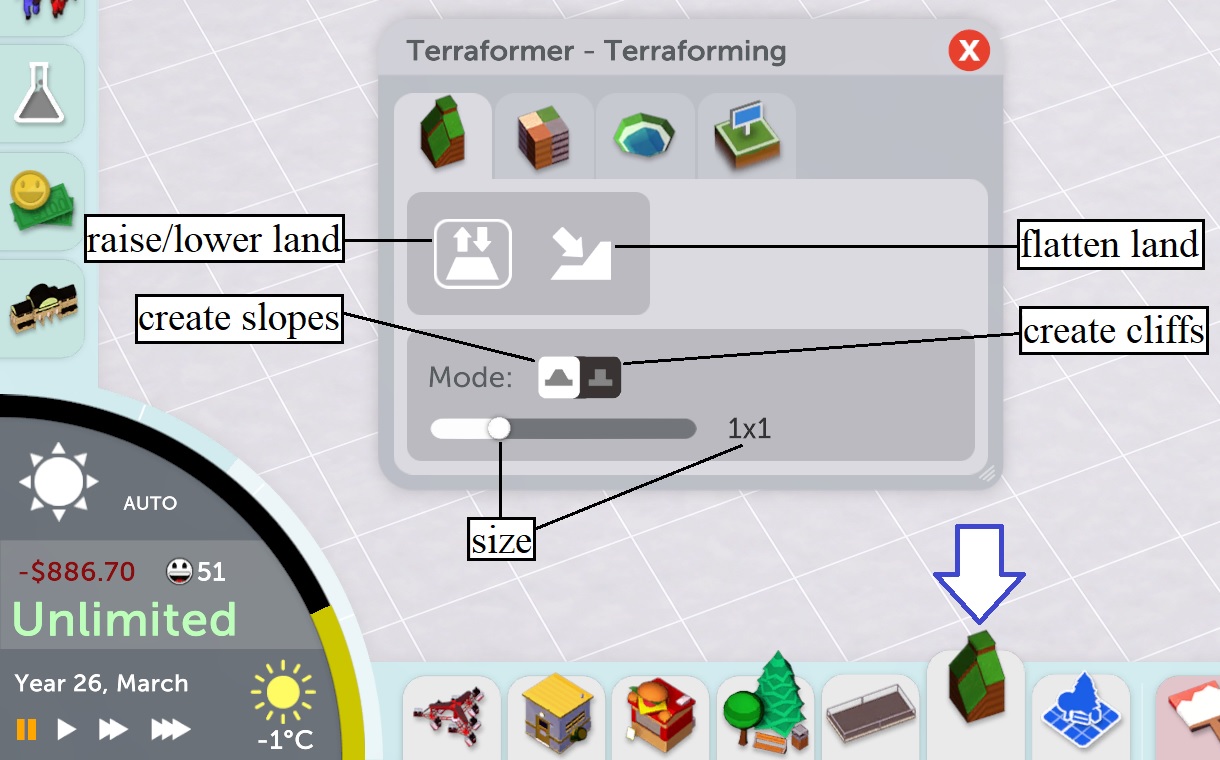
raise/lower land
- with this selected, click on any tile of land in the game world and drag up or down to raise or lower that tile respectively

flatten land
- with this selected, click and drag from any
tile of land to level an area to the height of that tile
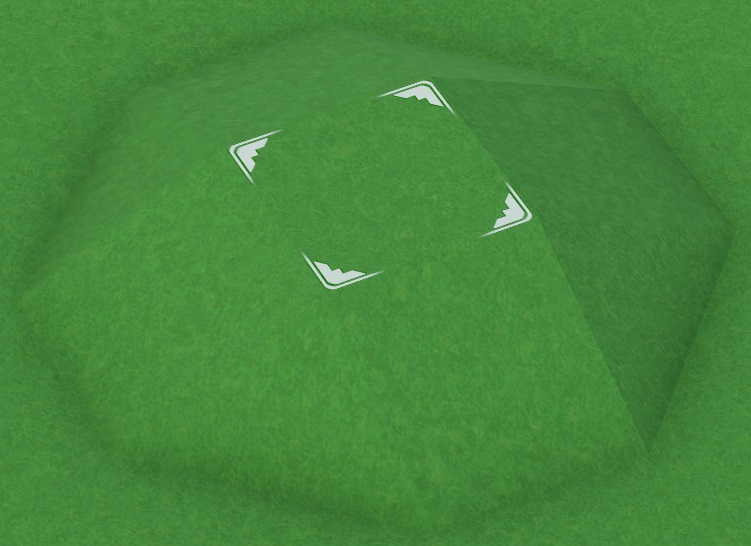
create slopes
- with this selected, tiles adjacent to the one you terraform will be pulled up or down with
it to create slopes- in the picture to the right, the tile highlighted has been pulled up 1/2 of a height unit
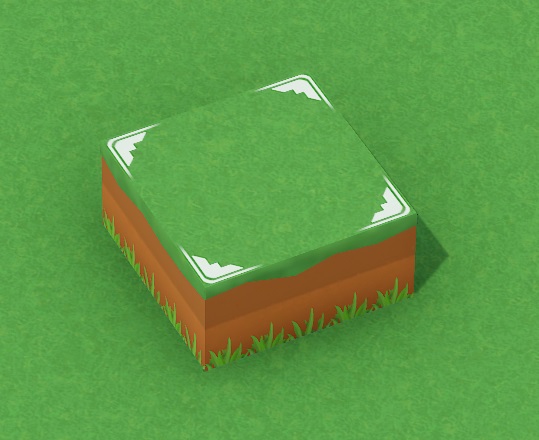
- with this selected, tiles adjacent to the one you terraform will not be affected
- in the picture to the right, the tile highlighted has been pulled up 1/2 of a height unit
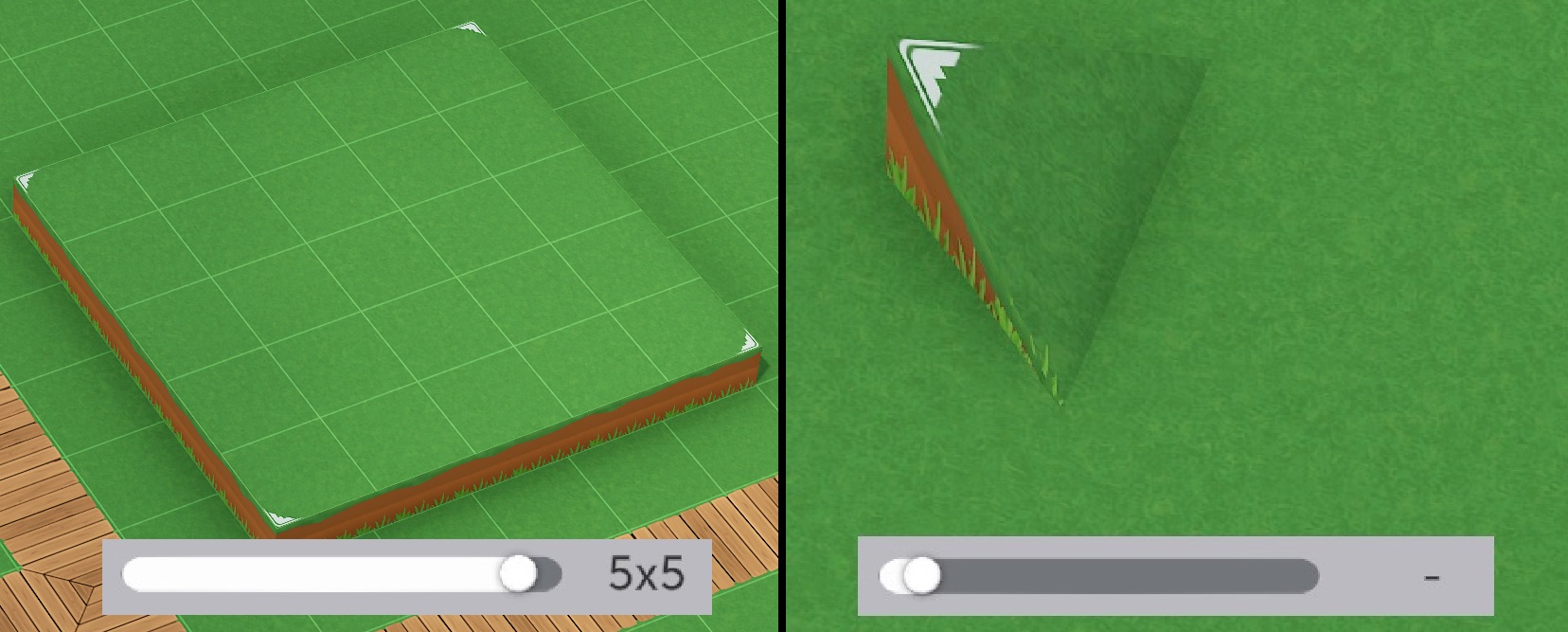
- change the size of the area affected when raising/lowering land
- isn't available while flatten land is selected above
- when set to less than 1×1, you can edit the corners of tiles to create slopes
Terrain
This sub-tab allows you to change the texture of the terrain.
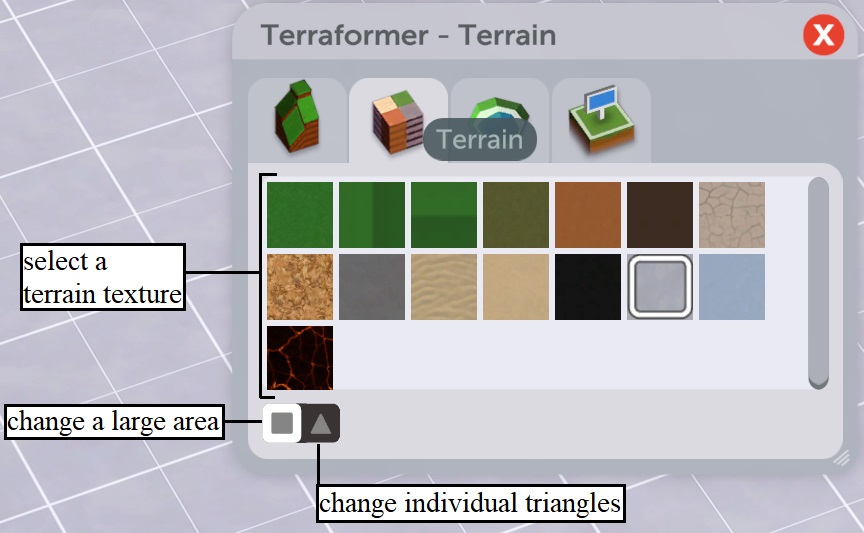
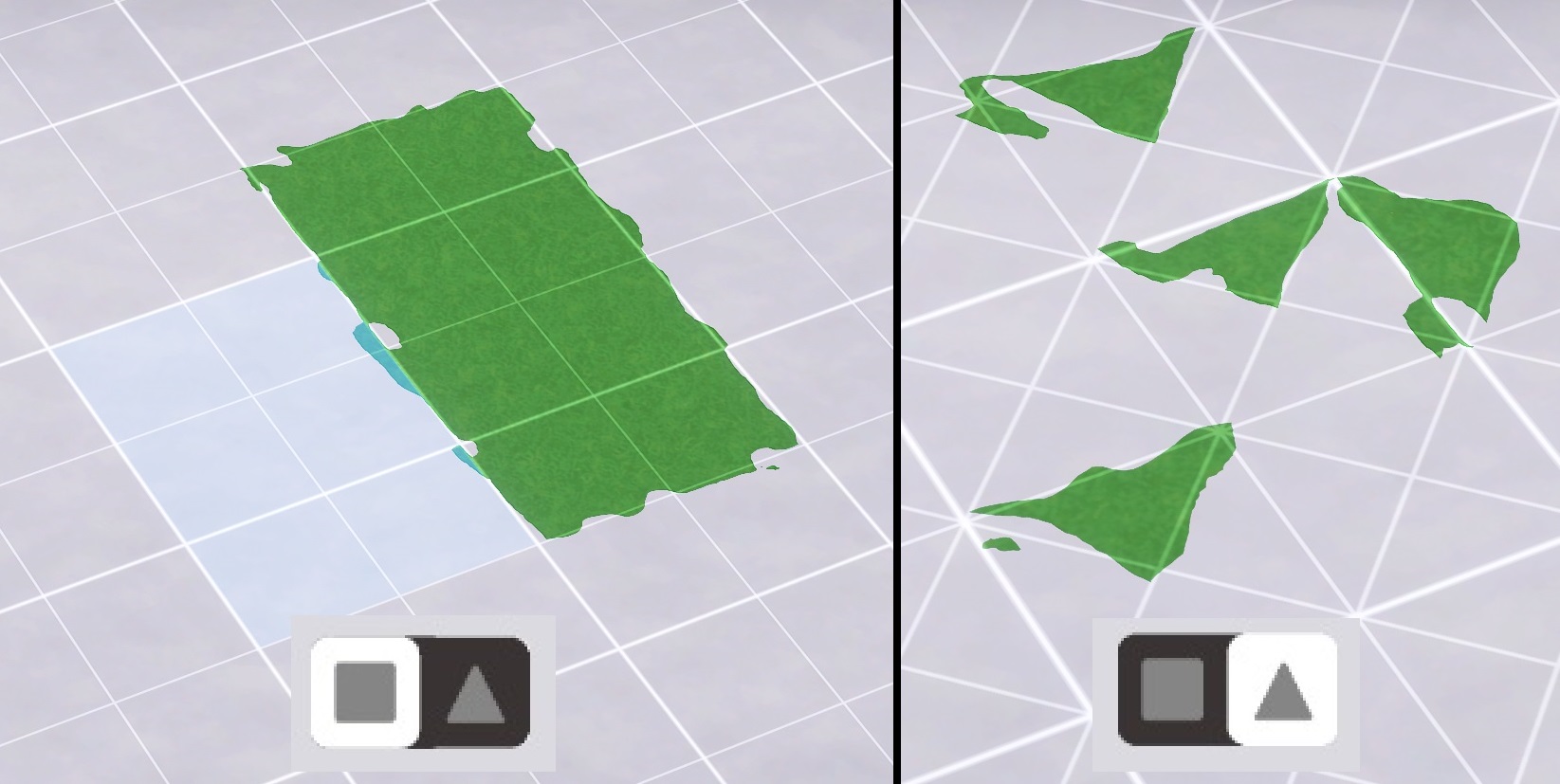
If 'change large area' is selected, you can click and drag across the terrain to change a large rectangular area all at once. If 'change individual triangles' is selected, you will be able to finely change small areas one triangle at a time (each triangle is 1/16 the size of a tile).
Water
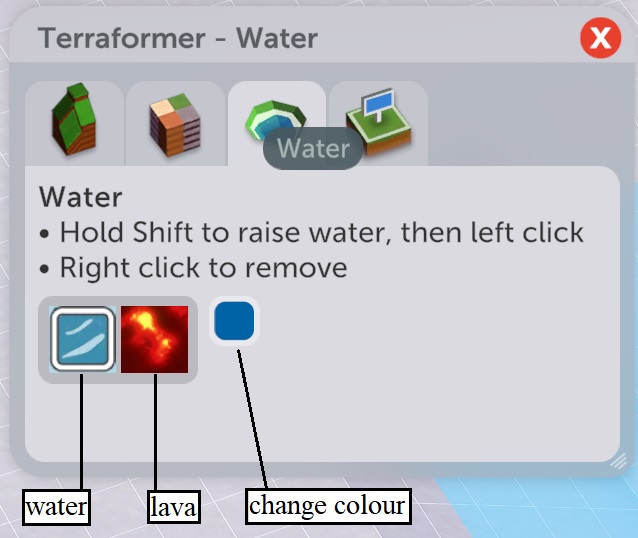
This sub-tab allows you to fill low spots in the terrain (or the entire map if you aren't careful) with water or lava (lava requires Taste of Adventure DLC). As it says in the window, you can right click on any body of water or lava to remove it while this sub-tab is open. You can also change what colour the water you place will be (see the brush tab and custom colours section of this guide for more information). Some scenarios don't allow terraforming, in which case the sub-tab will be unavailable.

With this sub-tab open, hovering over a terrain slope or cliff will show a preview of what you are about to place. If you want, hold left shift and move your mouse up to increase the height of the preview. Click to place the water. Keep in mind that boat rides such as the paddleboats can only be placed on bodies of water that are at 0.5 height increments (1.5, 3.0, 7.5, etc.).
Buy Land
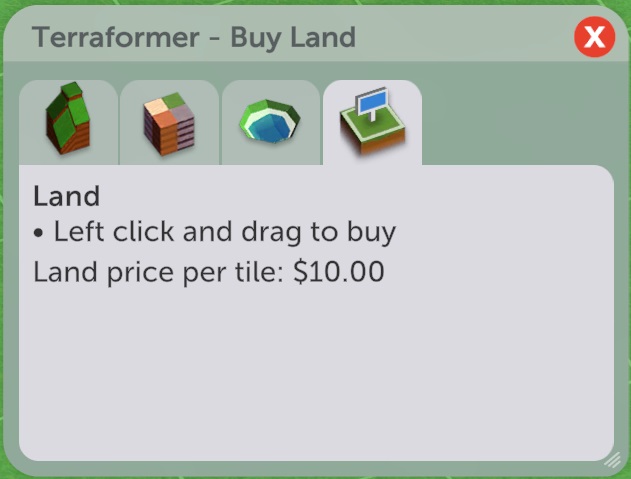
This sub-tab allows you to expand the area you can build on if there is land available to purchase. While this sub-tab is open, click and drag across an area of land for sale to add it to your park. The price of buying land varies depending on the scenario. If no land is available, it will just say "There is no land available for purchase.".
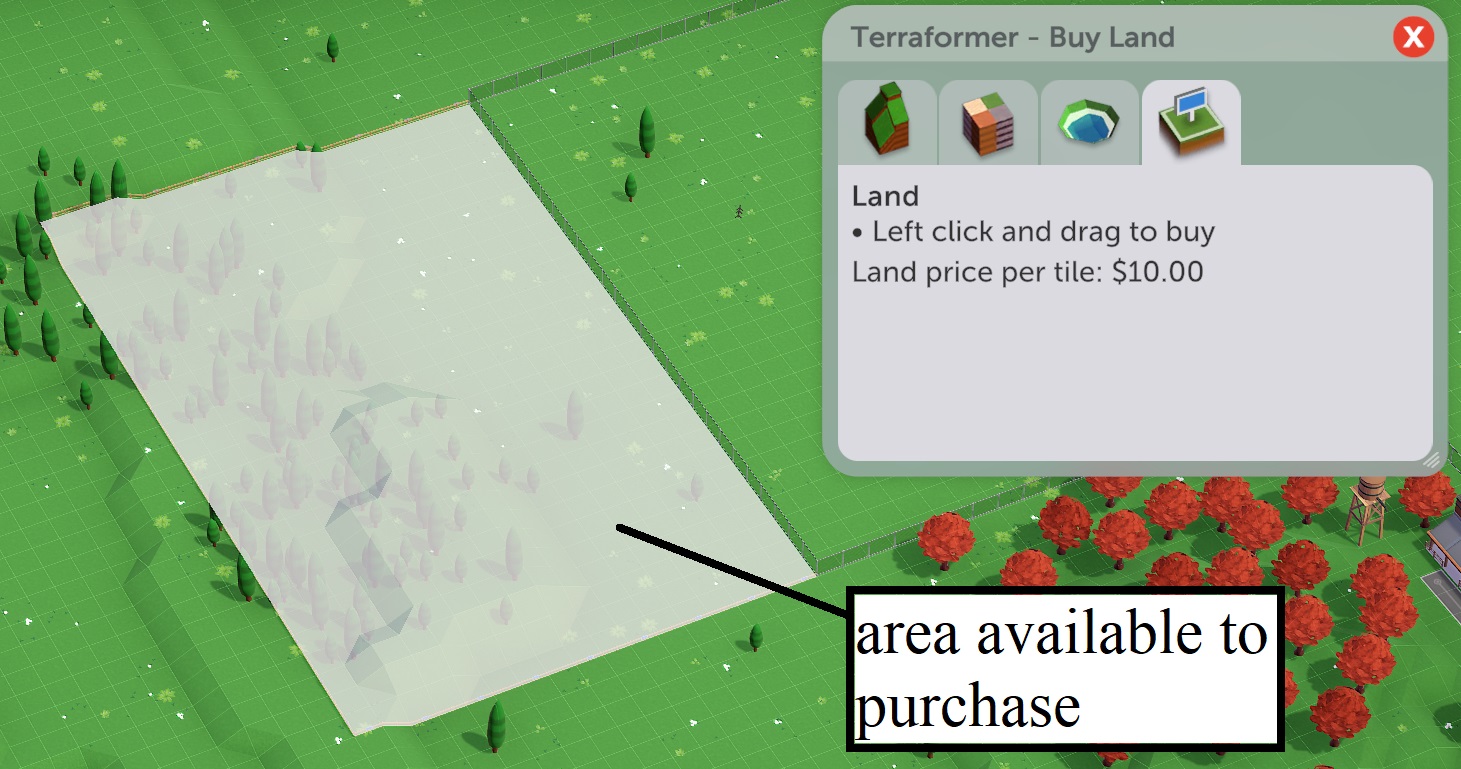
Areas available for purchase are highlighted while the buy land sub-tab is open. These areas are also surrounded by a small wooden fence which is always visible.
BLUEPRINTS TAB
This tab is where you go to place and create blueprints. Blueprints are saved arrangements/designs of rides, scenery, paths, etc. The tab can also be opened with a hotkey (F7 by default).
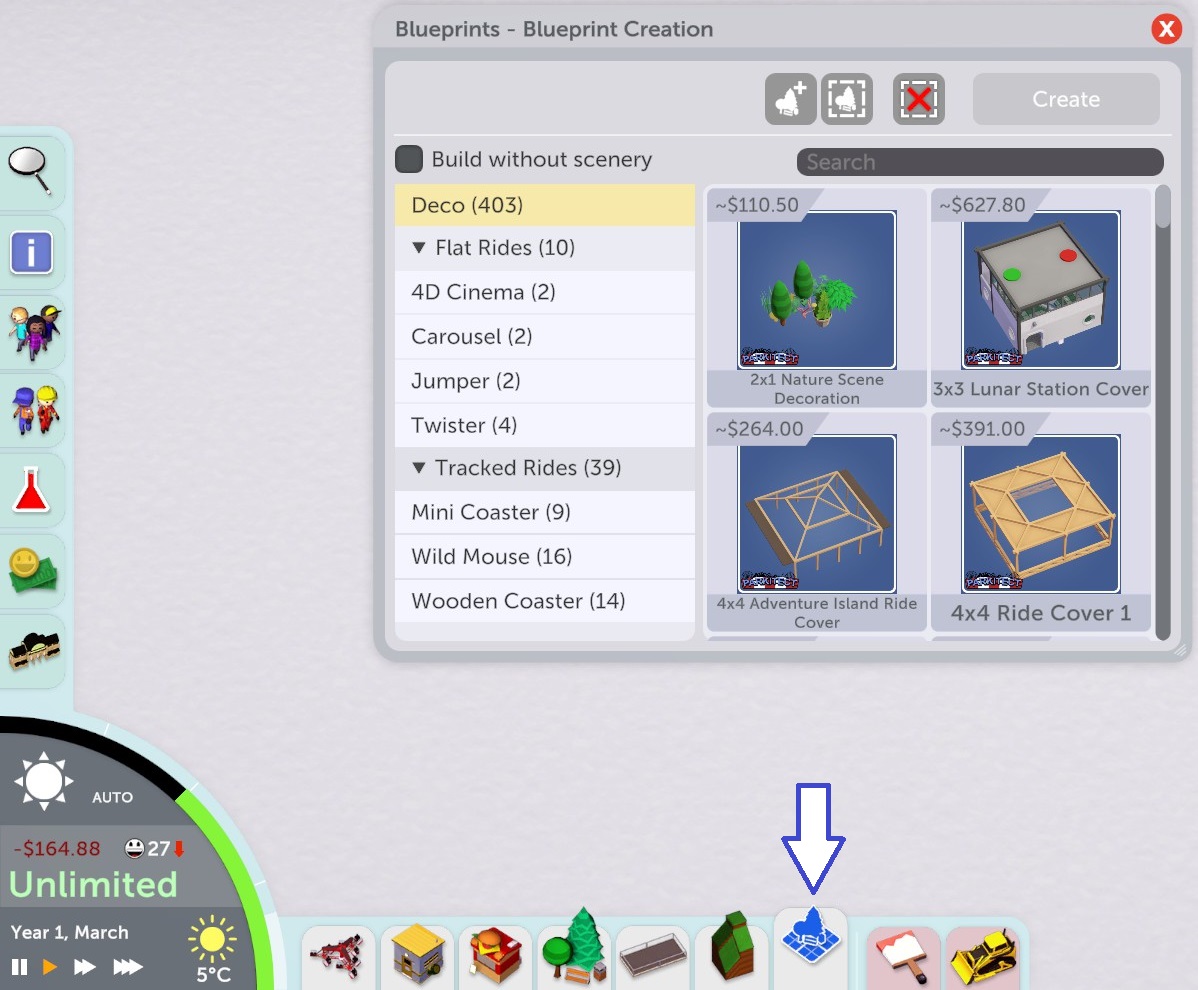
.
Creating Blueprints
To create a blueprint, you must select objects you wish to include in it. Almost all in-game objects, buildings, rides, etc. can be added to blueprints.
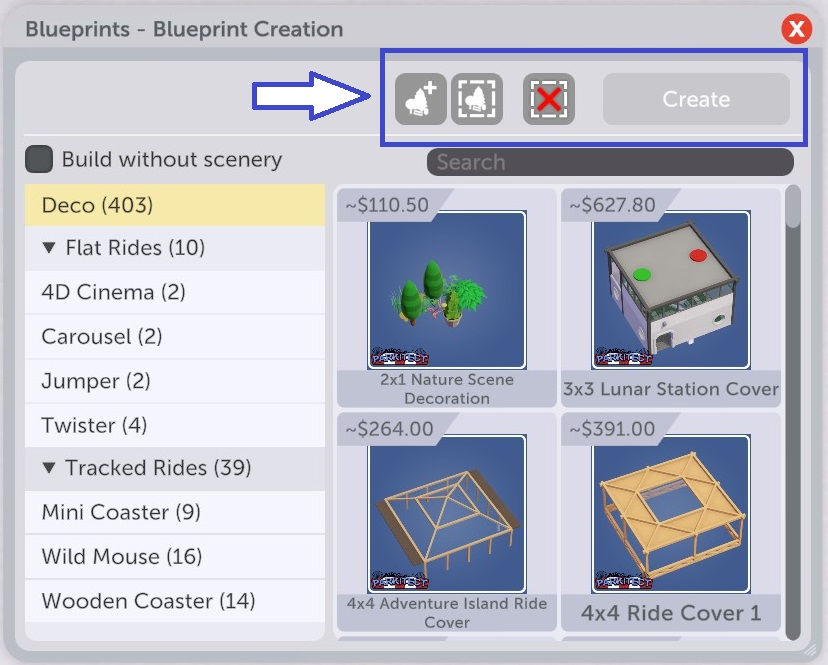

.
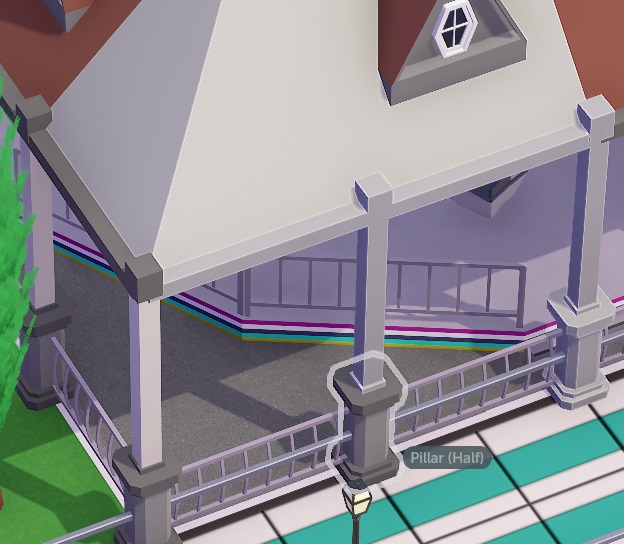
- with this selected, you can click on individual objects to add them, or click and drag and move the cursor around to add all objects
your cursor touches - right click to remove objects that have been added
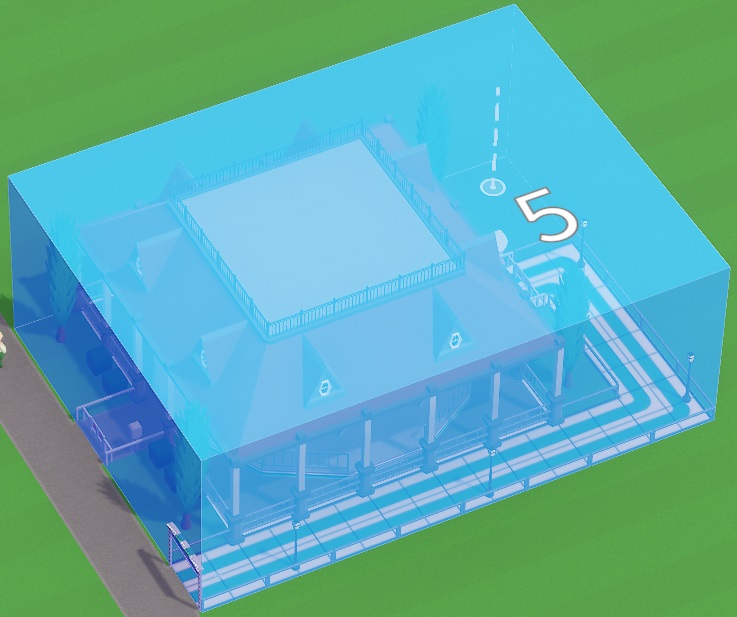
- this allows you to select all objects within a
3. area you specify- click to begin selecting the length
and width of the area you wish to include - move your cursor around until you
have included the entire footprint of what you plan to save as a blueprint
and click - now move the cursor up or down to change the height of the blue area
until all pieces you wish to save are included and click again- everything that was in the blue area will now be selected
- you can now continue selecting/deselecting additional objects with either tool
- doing these same steps but with right click will instead de-select all objects in the blue area
- click to begin selecting the length
de-select all
- click this to cancel/de-select everything you have selected
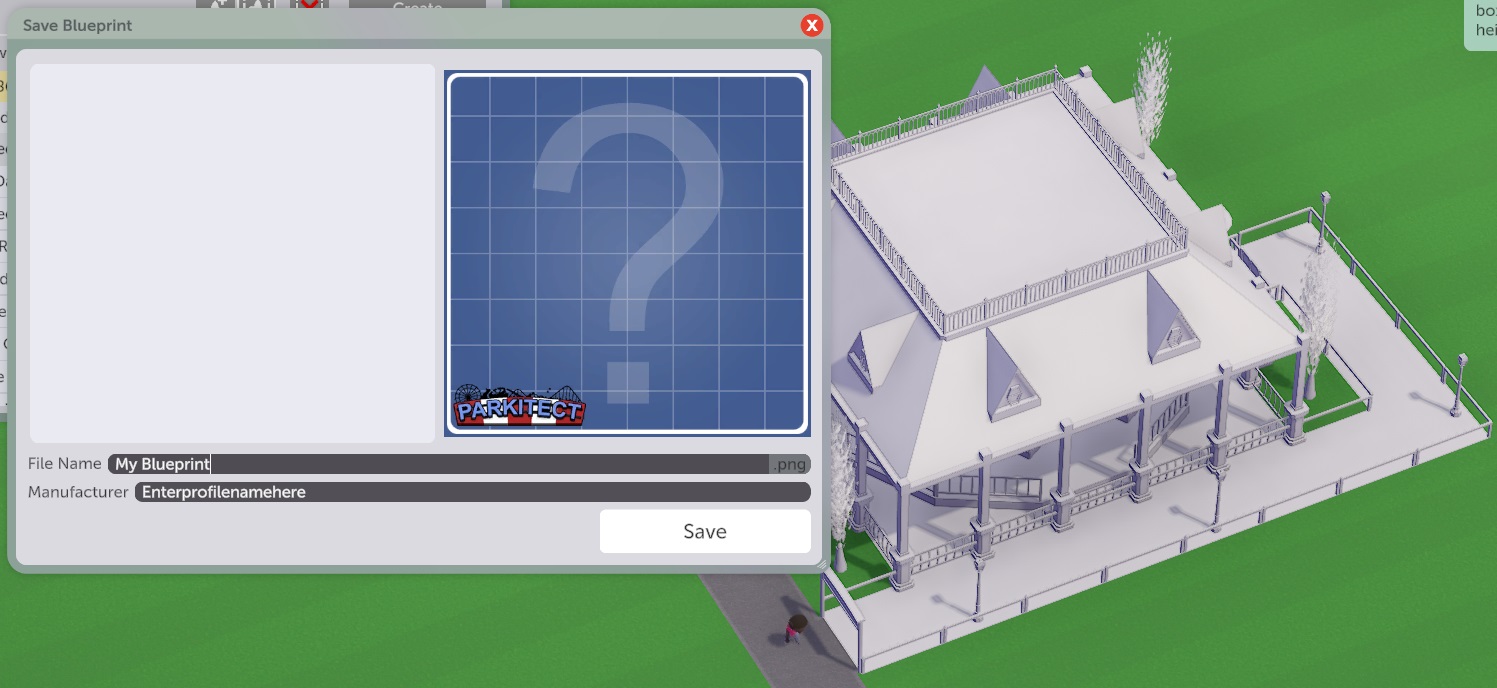
save selection as a blueprint
- once you have selected everything you wish
to include in a blueprint, click on the 'Create' button, enter a name for the blueprint where
it says 'File Name', and click the 'save' button
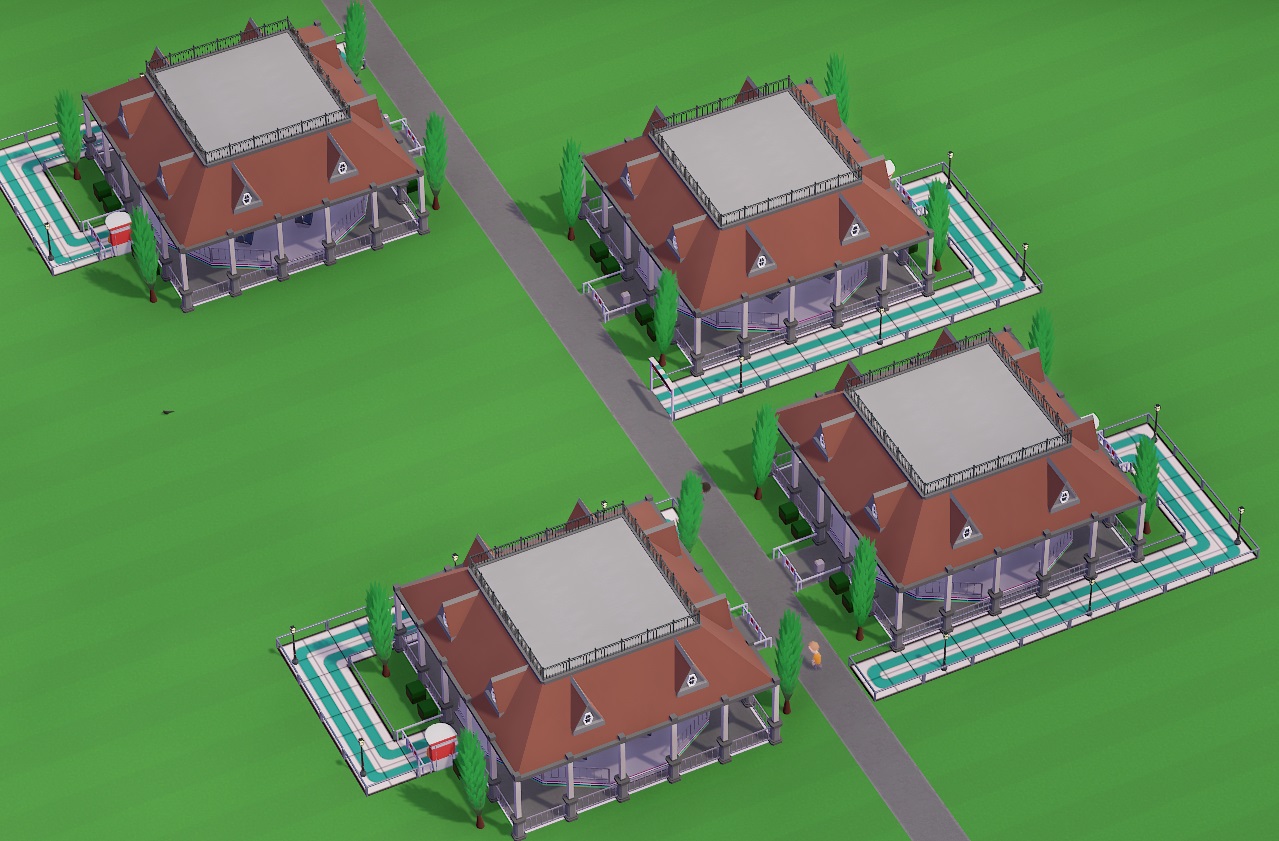
- you will now be able to find the blueprint you just saved in the blueprints tab for you to place as many times as you want
Placing Blueprints
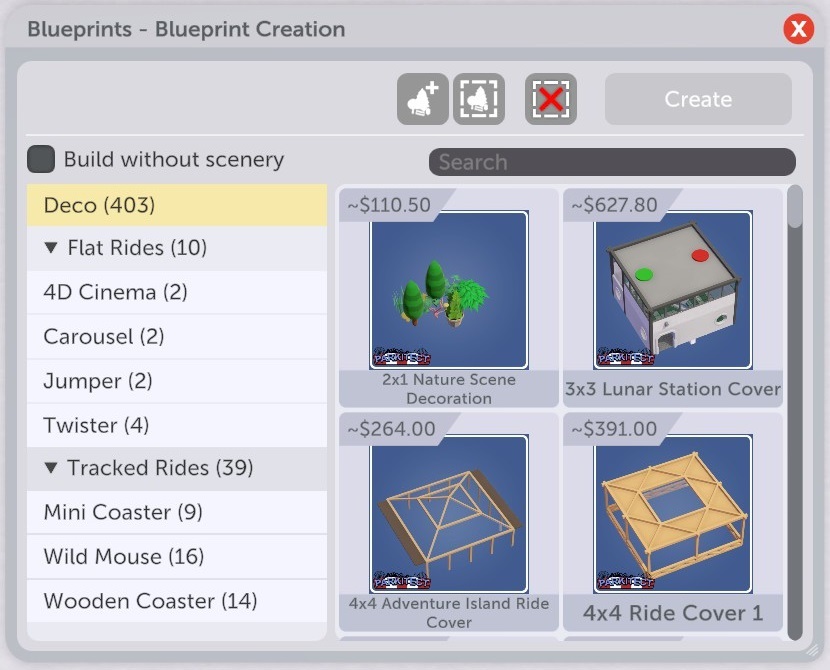
In the blueprints tab all blueprints are divided into three categories:
- deco
- blueprints that contain only deco objects, paths, shops, and/or other buildings such as staff rooms
- also includes blueprints that contain more than one type of ride (eg. a blueprint that contains a wild mouse and a wooden coaster)
- flat rides
- blueprints that contain flat rides
- clicking this category will drop down options allowing you to select to show only blueprints that contain a certain ride type (eg. carousel)
- track rides
- blueprints that contain track rides
- clicking this category will drop down options allowing you to select to show only blueprints that contain a certain ride type (eg. bobsled coaster)
If you tick the box that says 'build without scenery', you can build a track ride design from the blueprints tab without building any of the deco objects it includes.
There is also a search box for if you are looking for a particular blueprint (tip: when saving deco blueprints, I usually include keywords such as 'toilets', 'shops', 'ride cover', etc. so I can use the search box to find all of a particular kind of deco blueprint; for example, if a blueprint I am saving is a fancy washroom building, I will make sure to include the word 'toilets' when naming it, so that I can enter 'toilets' in the search bar and look through all my washroom blueprints).
________________________________________________________________
Placing
While placing blueprints:
- once you click on a blueprint in the blueprints tab, a preview of what you are about to
place will now be attached to your cursor - hold left shift and move your cursor up and down to raise or lower it
- tap left shift to reset height snapping
- press left ctrl to snap its height to whatever in-game object you're cursor is currently hovering over
- press spacebar to rotate it
- click to place it
BRUSH TAB AND CUSTOM COLOURS
Brush Tab
The brush tab allows you to change the colour of any in-game object that supports custom colours. It can be opened from its icon at the bottom of the screen or with a hotkey (F8 by default).
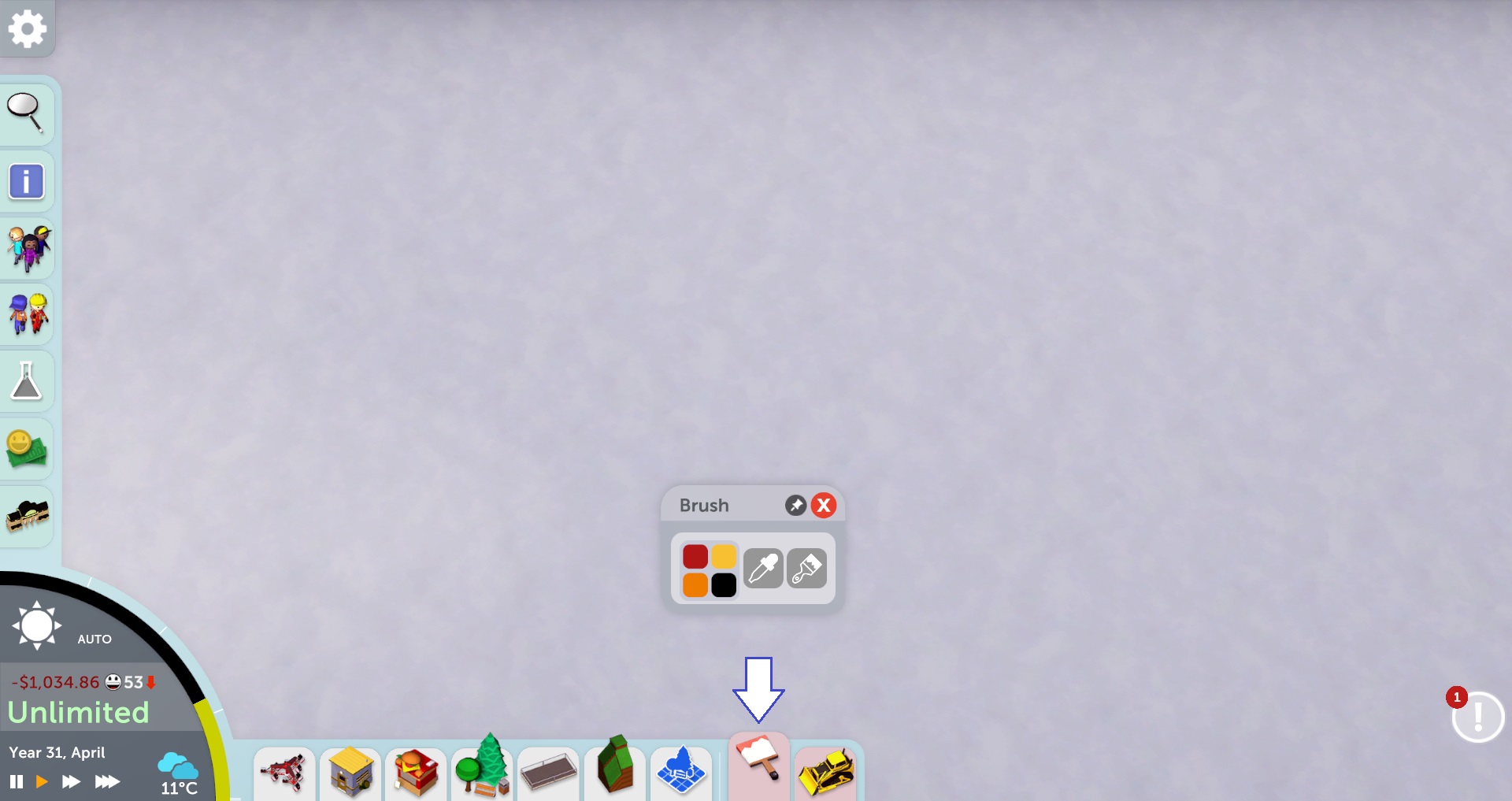
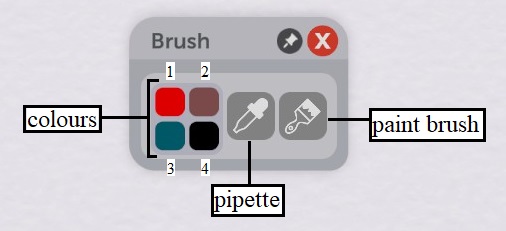
Every recolourable object uses up to four colours. These four colours are a "colour palette". In the picture to the right I have labelled each colour 1-4 as this is how they are ordered internally. Clicking on one of these colours will open the colour picker (more on this in a bit) allowing you to edit this palette.
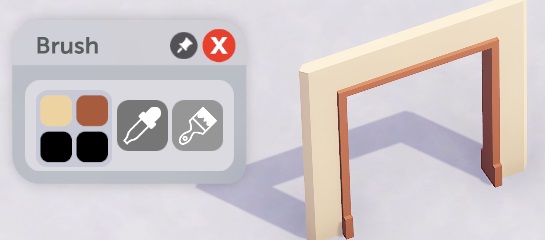
Selecting the pipette allows you to click on any in-game object to select its colours. If the object you click on uses less than four colours, the remaining colours will be black. The pipette can also be selected while this window is open with a hotkey ('P' by default).
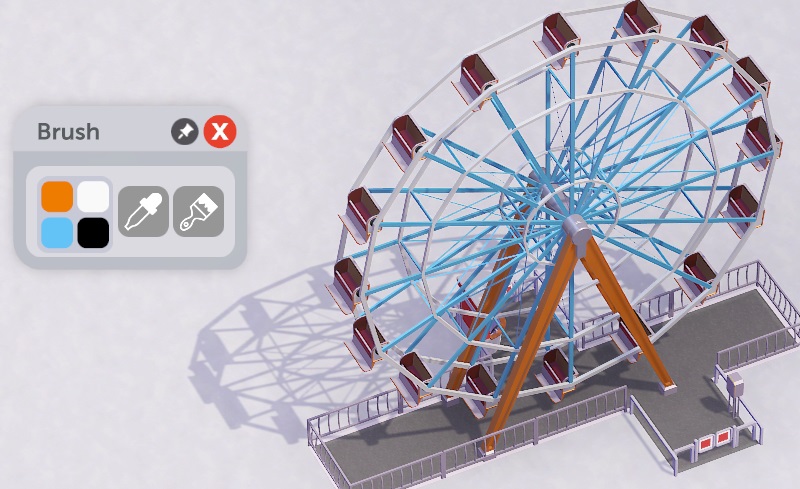
Selecting the paintbrush allows you to recolour any in-game object for free, including individual track segments and coaster cars like in the picture below.
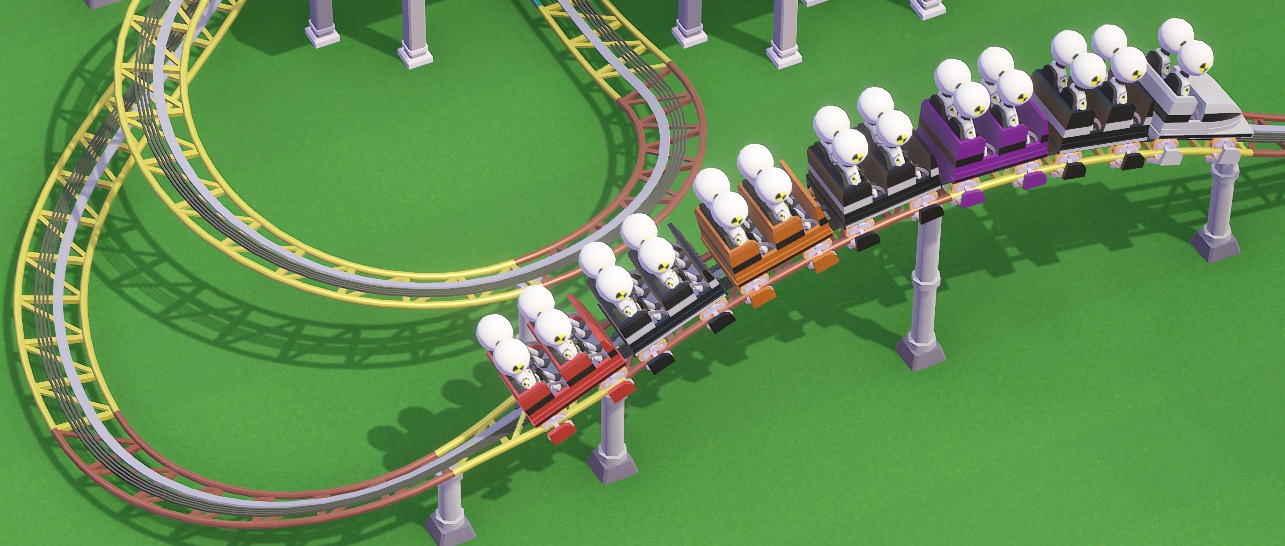
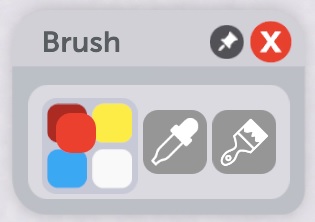
Any colour in any colour palette can be clicked and dragged to another slot in the same palette or a different one in a different open window to swap them. In the picture to the right, red is being dragged; if I dropped it in the yellow slot, their current locations would be swapped. Holding left Alt. while doing this copies the dragged colour into the new slot rather than swapping the two; useful for making every colour in a palette identical.
Colour Picker
This window will come up whenever a custom colour is clicked on. It allows you to select from fifty different colours while in colour swatch mode, or almost any colour imaginable when in advanced mode.
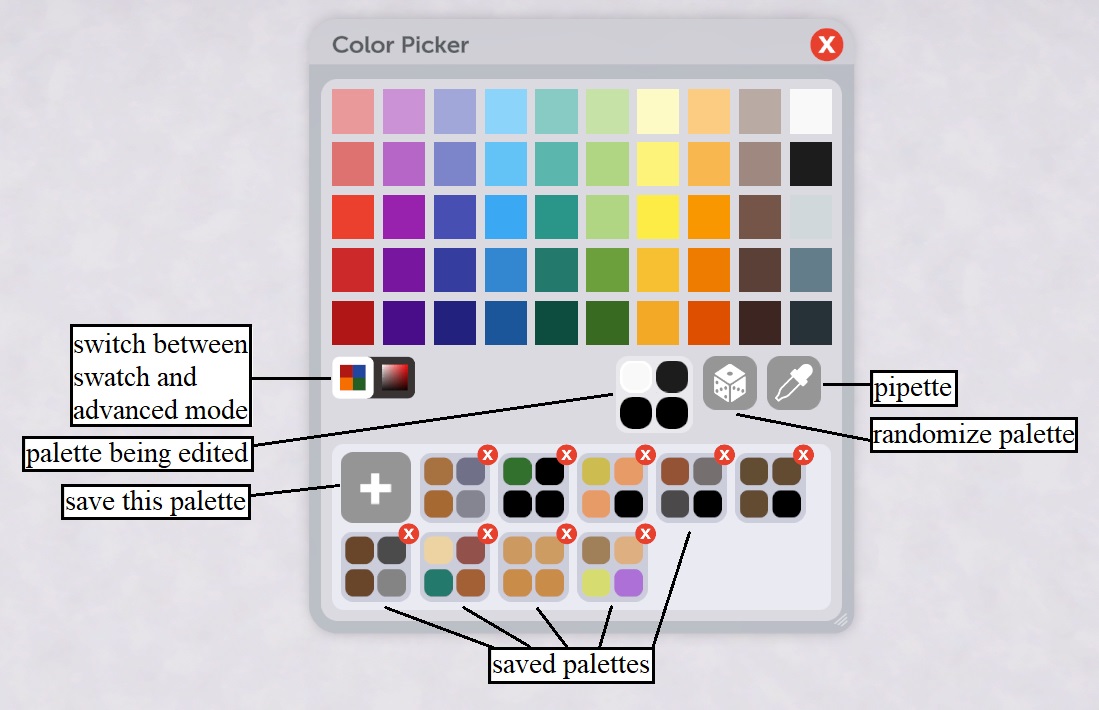
switch between swatch and advanced mode
- in this picture it is in swatch mode (more on advanced mode in a bit)
palette being edited
- click on any of the four colours to select it for editing
save this palette
- save the palette being edited as it is for later use
saved palettes
- click on one to use it
- click on a saved palette's red x to delete it
pipette
- works the same as the pipette in the brush tab and can also be selected with a hotkey ('P' by default) while the colour picker is open
randomize palette
- randomize all four colours in the palette being edited
heavily favours bright, vibrant colours
________________________________________________________________
Advanced Mode
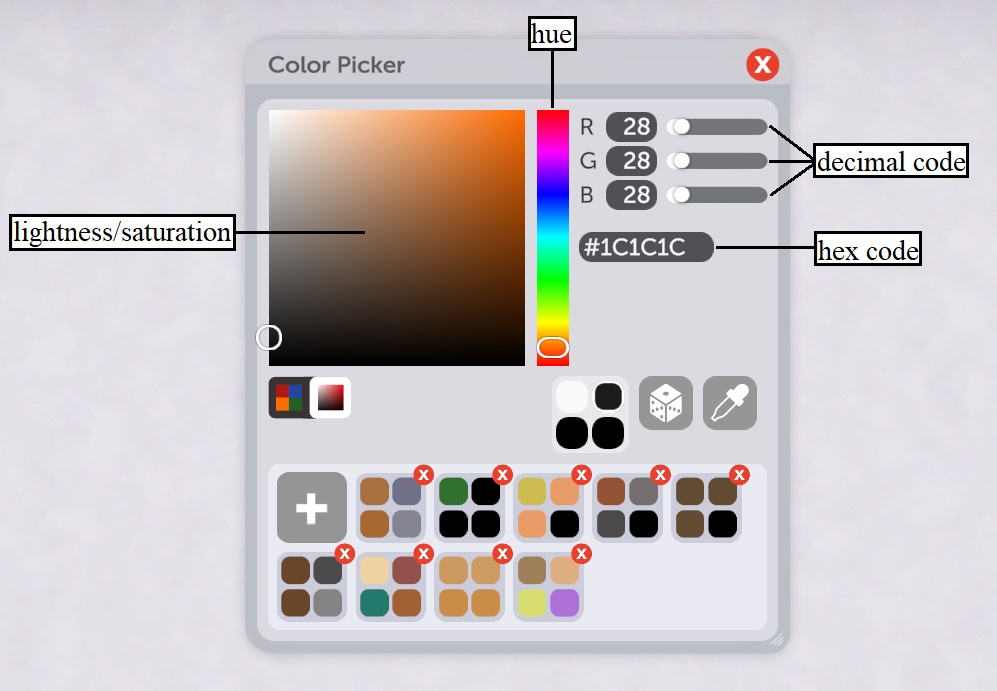
lightness/saturation
- drag the white circle around this area to adjust how light/dark/saturated a colour is
- drag it all the way to the left side to get whites, greys, and blacks
hue
- drag the white oval up and down to smoothly adjust the colour
decimal code
- adjust individual RGB values
- enter 999 in any one to make a coloured object glow
hex code
- I don't know
- enter in a random value and see what happens?
BULLDOZER TAB
This tab allows you to select multiple objects and then delete them all at once. It can also be brought up with a hotkey (F9 by default). The way you select objects is identical to the blueprints tab. Once you have selected all objects you wish to delete, click the green checkmark to confirm. Click the red X to cancel.
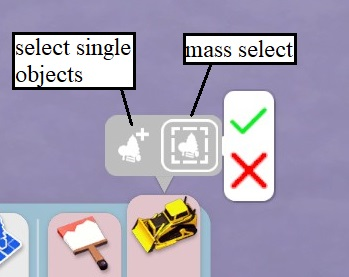
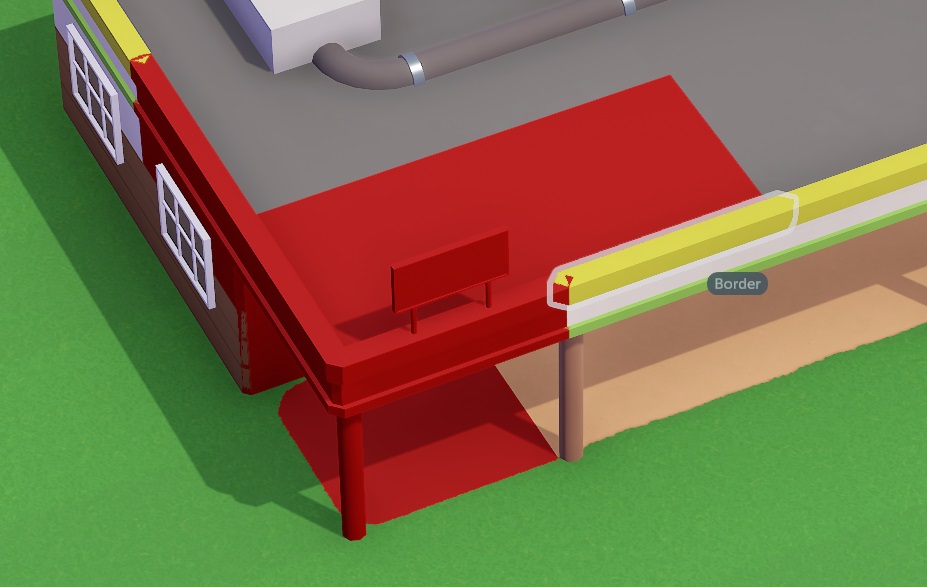
- with this selected, you can click on individual objects to add them, or click and drag and move the cursor around to add all objects
your cursor touches - right click to de-select objects that have
been selected
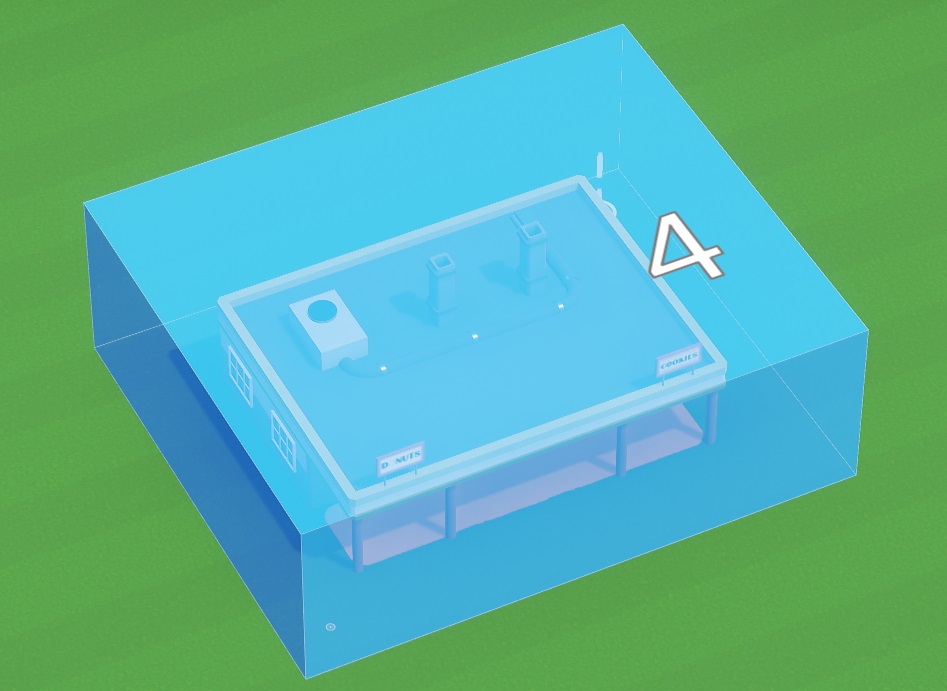
- this allows you to select all objects within a
3. area you specify- click to begin selecting the length
and width of the area you wish to include - move your cursor around until you
have included the entire footprint of what you plan to delete and click - now move the cursor up or down to change the height of the blue area
until all pieces you wish to delete are included and click again- everything that was in the blue area will now be selected
- you can now continue selecting/deselecting additional objects with either tool
- doing these same steps but with right click will instead de-select all objects in the blue area
- click to begin selecting the length
NOTIFICATIONS
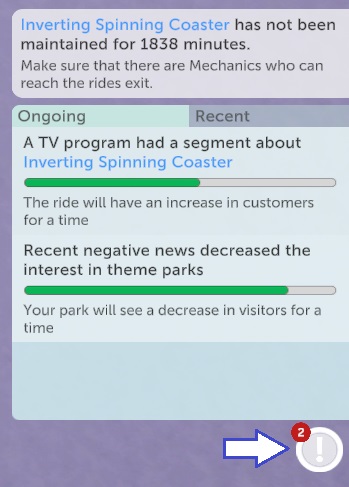
You may notice notifications along the right side of the screen every now and then informing you of special events (eg. a ride went viral and will have more customers for a while, a crash in a nearby park is scaring away customers), park issues (eg. breakdowns, staff problems), etc. clicking on a notification will often open a window with relevant information about it.
Clicking the white circle with the exclamation mark in the lower right of the screen will open up a small tab allowing you to view ongoing special events and recent notifications.
The progress bars for special events indicate how much longer their effects will last.
P.S. -If you have a ride in your park that hasn't been maintained for 1838 minutes you've got some serious problems.
SCENARIO EDITOR

When selecting 'scenario editor' in the main menu, there are two options: one to edit a scenario (either one of your own or one included with the game), the other to create a new scenario.
Create Scenario
If 'new scenario' is chosen in the main menu, the scenario editor will open up with this window, which allows you to enter in information before randomly generating terrain based on what you specified. It has four sub tabs for customizing land size, landscape (hills, amount of water, etc.), terrain type (grass, sand, etc.), and trees. Once you are ready, click the 'generate' button to randomly generate a landscape. You can do this a few times if you aren't happy with the result. Once you are happy, click the 'finish' button to move on.
________________________________________________________________
Park Size Settings
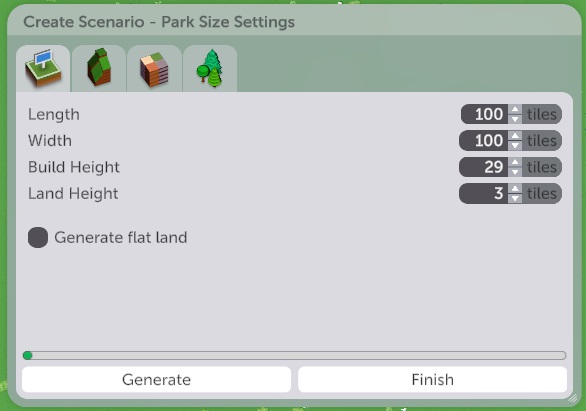
Length and Width
- adjust the number of tiles long and wide the land area generated is
Build Height
- set the maximum overall height at which ride stations, flat rides, deco objects, and paths can be built
- coaster track can go higher than this
Land Height
- set the general height of the land to be generated
- if you set for a very hilly landscape to generate the average land height will probably be higher than this
Generate flat land
- ticking this box will hide the other three sub-tabs and allows you to generate a completely flat, open landscape
________________________________________________________________
Landscape settings
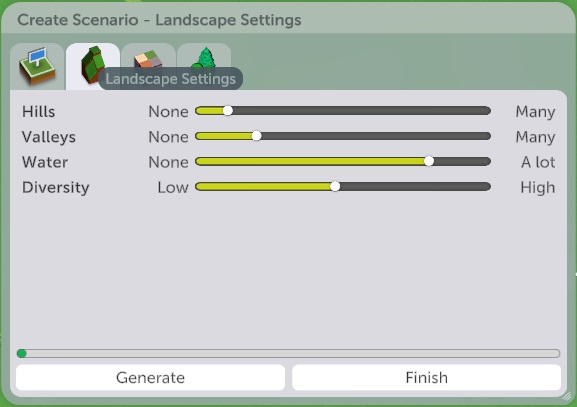
Hills
- set how hilly the landscape should be
- slide right for a more hilly landscape
- all the way left generates a completely flat landscape
Valleys
- set how many low areas generate, often with water
- all the way left generates a completely flat landscape
Water
- set how much water should generate
- water requires valleys to generate, so if valleys is set too low, no water may generate regardless of what this setting is
- setting water and valleys higher and hills lower (but not all the way left) will generate more water and vice versa
Diversity
- set how varied the landscape is
- more left will generate much smoother terrain (maybe just one large, shallow sloped hill)
- more right will generate rougher terrain with many small, steep hills
________________________________________________________________
Terrain Type Settings
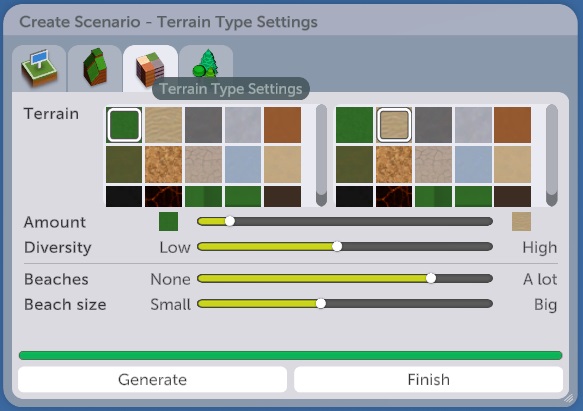
Terrain
- set what two terrain textures should generate
Amount
- how much of each terrain texture should generate
- setting this further right towards the secondary texture will often cause generation to take a long time
Diversity
- further left will generate fewer but larger areas of the secondary terrain texture
- too far left will often cause the secondary texture to not generate at all
- further right will generate more but smaller areas of the secondary texture
- further right will often cause generation to take a long time
Beaches
- set how many water areas generate sand around them
- all the way right will generate beaches around all water
- all the way left won't generate any beaches
Beach size
- further left for narrower beaches
- further right for wider beaches with sand that reaches further inland from the water
________________________________________________________________
Trees Settings
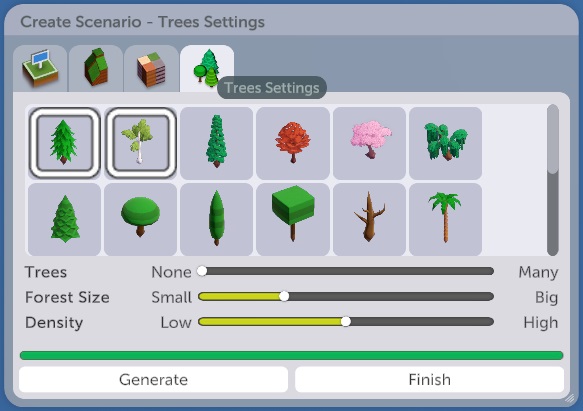
Select what tree types you wish to generate. Below that there are three settings. Trees seem to be generated in two steps: first, a few trees are generated evenly distributed around the map, then denser forested areas are generated.
- set how many trees should generate
- slide left for fewer trees, right for more
- sliding further right will often cause generation to take a long time
- sliding all the way left will prevent any trees from generating at all (including forests)
Forest Size
- set how large forests of trees should be
- further left will generate small clusters of trees, further right will generate larger clusters
- all the way right will often not generate forests at all, or cover most of the map, possibly taking a long time to generate
Density
- set how dense forests should be
- all the way left won't generate forests at all
- all the way right may cause generation to take a long time
Making the scenario
Building and placing things works the same in the scenario editor as it does during regular gameplay, except that you can place things anywhere on the map. While in the scenario editor the scenario editor tools tab is available.
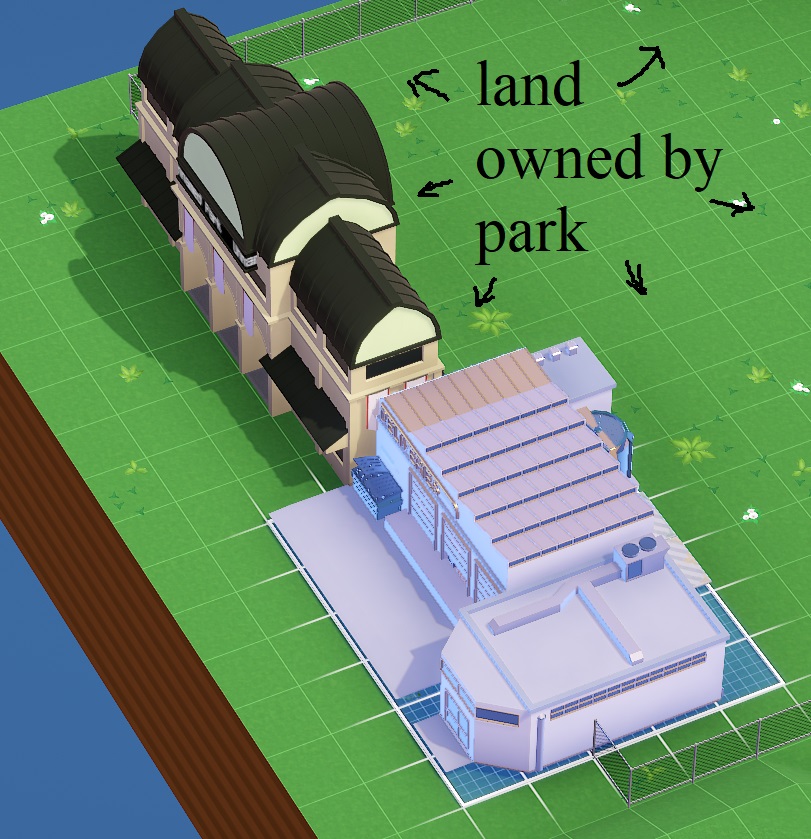
Before saving a scenario you must place:
- at least one park entrance
- a deliveries building or a deliveries pad and a trash dump
- these are available in the park utilities tab while in the scenario editor
- the deliveries building and park entrance must be placed on the borders of the park (on the perimeter fence separating owned and unowned land, as shown in the picture to the left; make sure it is facing the right way, if you can't place it, try rotating it twice).
Once you save a scenario (this is done the same way as saving any park), it will be available for you to play through in sandbox.
SCENARIO EDITOR: SCENARIO EDITOR TOOLS TAB
This is where you go to set up the parameters of the scenario among other things. It has nine sub-tabs:
- Park Borders
- Guest Spawns
- Indestructible Objects
- Ugly Objects
- General Settings
- Guest Settings
- Research
- Goals
- Climate
Park Borders
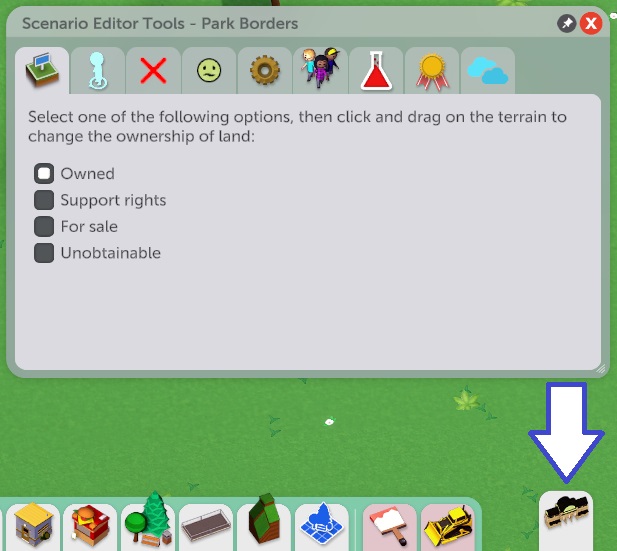
This sub-tab is where you go to define what land the park owns, what land is available to purchase, and what land has support rights.
- click and drag across the terrain with this selected to define what land the park owns
- right-click and drag to define land that is unobtainable
Support Rights
- click and drag across the terrain with this selected to define what land has support rights
- support rights areas allow rides, paths, etc. to be built 1.5 height units or higher above the terrain
- right-click and drag to remove support rights
For Sale
- click and drag across the terrain with this selected to define what land is available to purchase
- right-click and drag to make land unobtainable
Unobtainable
- click and drag across the terrain with this selected to define land that is unobtainable
Guest Spawns
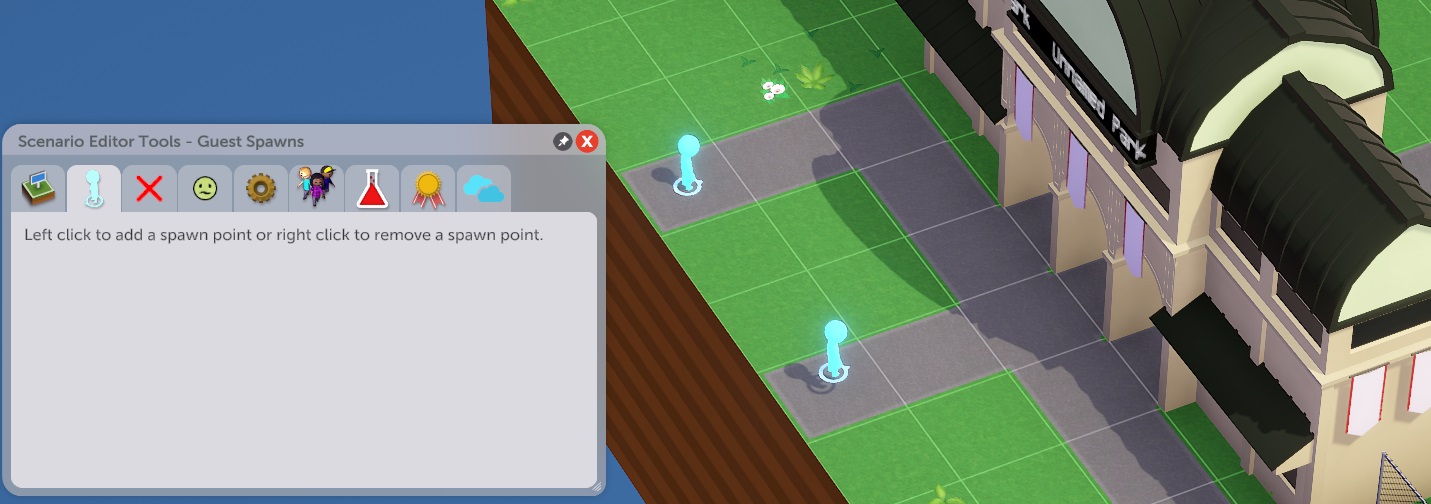
With this sub tab open you can place guest spawn points. These are where guests appear before entering the park. They are usually (but not always) at the edge of the map, and should always be placed on paths. Make sure there are paths connecting the spawn to the park entrance! You should also keep the path between the spawn and the entrance as simple as possible, otherwise guests may turn around and head back to the spawn without ever entering the park. The number of spawn points you place has no effect on the total spawn rate of guests.
Indestructible Objects
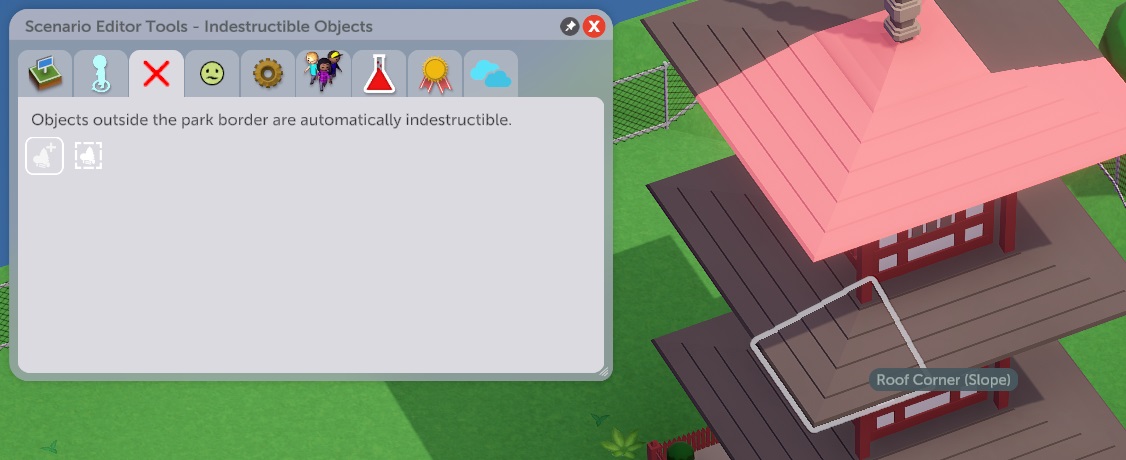
This sub-tab allows you to select objects that cannot be deleted when playing the scenario. For selecting and deselecting objects it has individual and mass-select tools that work exactly the same as the blueprints and bulldozer tabs. Any objects that have been selected will be highlighted with a bright pink colour while this sub-tab is open.
Ugly Objects
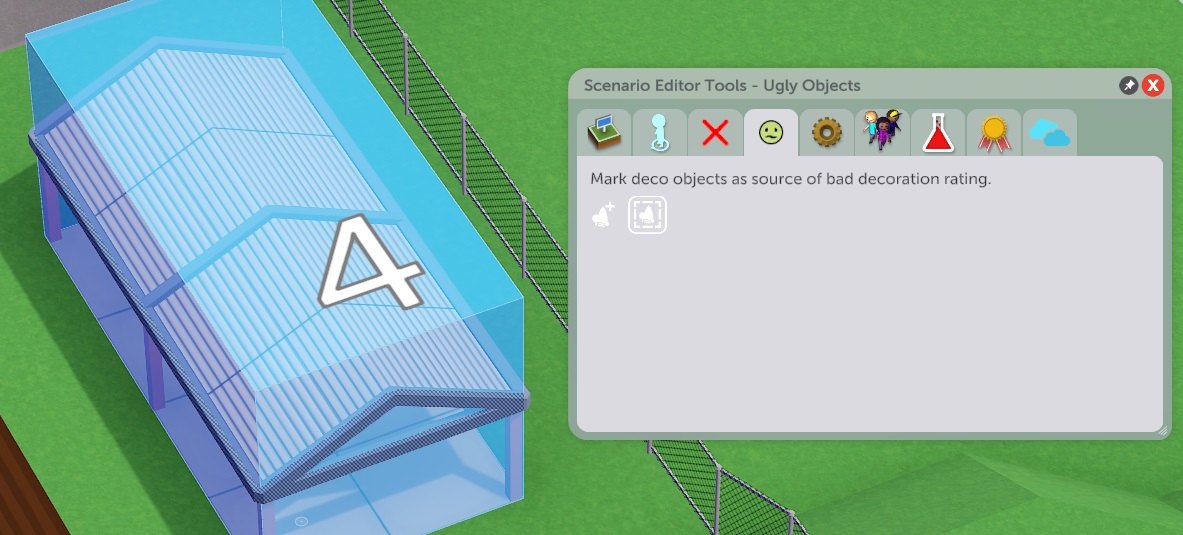
This sub-tab allows you to mark deco objects as sources of bad deco rating for an extra challenge. This should usually be done only to objects just outside of the park or that have been marked as indestructible, otherwise players could just easily demolish them to remove the bad deco rating. For selecting and deselecting objects it has individual and mass-select tools that work exactly the same as the blueprints and bulldozer tabs. Any objects that have been selected will be highlighted with a bright pink colour while this sub-tab is open.
General Settings
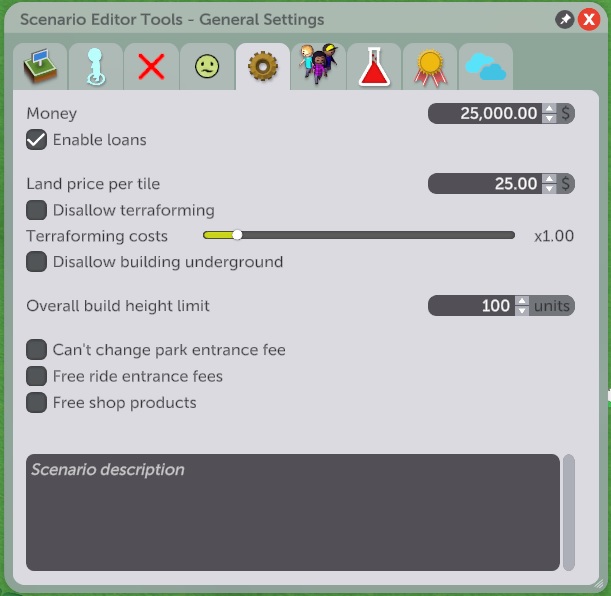
Money
- change how much money you start off with when playing this scenario (in the picture it is set at $25,000.00)
Enable loans
- untick this box to disable loans in this scenario
Land price per tile
- how much it will cost to buy each tile of land in this scenario (in the picture it is set at $25.00)
Disallow terraforming
- tick this box to disable terraforming
- changing terrain textures will still be allowed
Terraforming costs
- increase/decrease the cost of terraforming in this scenario
Disallow building underground
- tick this box to disallow building underground in this scenario
Overall build height limit
- how many tiles above the ground you can build in this scenario (in the picture it is set at 100 units)
- unlike the build height that is set when generating the map, this also limits the height of all ride track, and is based on the height above the terrain rather than the bottom of the world
Can't charge park entry fee
- lock the entry fee at whatever price you set in the scenario editor (click on the park entrance to set the entry fee)
Free ride entry fees
- tick this box to disallow charging for guests to ride rides
Free shop products
- tick this box to disallow charging for shop products (food/drink, souvenirs, etc.)
Scenario description
- click in this area to enter a description of this scenario that will display when it is selected in the main menu
Guest Settings
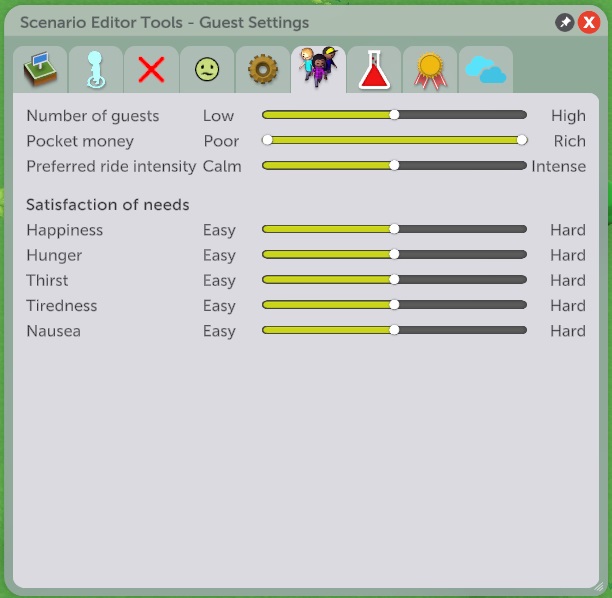
Number of guests
- change how easy it is to attract large
numbers of guests - slide right to increase the rate of guests spawning
Pocket Money
- set the range of possible amounts of money guests can arrive at the park with
- this range goes from $50 to $200
- this means that if both dots are slid
all the way left, all guests will arrive
with exactly $50, and if they are
both all the way right, all guests will
arrive with exactly $200
- this means that if both dots are slid
- this range goes from $50 to $200
- with both points at opposite ends, guests will arrive with all sorts of money amounts in their pockets that fall between the dots
Preferred ride intensity
- set the ride intensity that guests arriving in this park generally prefer
- even if you set it all the way one way there will still be a few odd guests that like the opposite
- further left will mean more guests won't like high intensity rides
- further right will mean more guests won't like low intensity rides
- leaving it in the middle will mean guests average intensity preference is medium
Satisfaction of needs: Happiness, Hunger, Thirst, Tiredness, Nausea
- individually set how easy it is to satisfy each of these needs of guests
- for example: for a desert map you may make it harder to satisfy thirst
- setting happiness harder will make guests lose happiness more easily
- setting hunger harder will make guests get hungry faster
- setting thirst harder will make guests get thirsty faster
- setting tiredness harder will make guests get tired faster and require benches to rest more often
- setting nausea harder will make guests get sick on rides more easily
Research
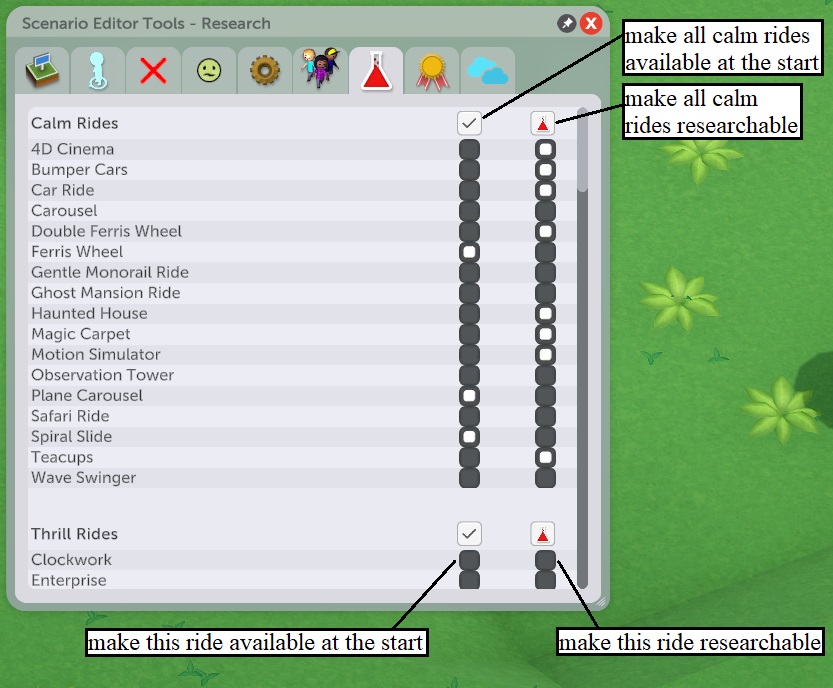
This sub-tab allows you to choose what rides, shops, scenery, decorations, and statistics are available from the start, what can be researched, and what is unavailable. Every single ride and shop is listed here, as well as groups of scenery items (fantasy, industrial structures, spooky props, etc.).
SCENARIO EDITOR: SCENARIO EDITOR TOOLS TAB– cont.
Goals
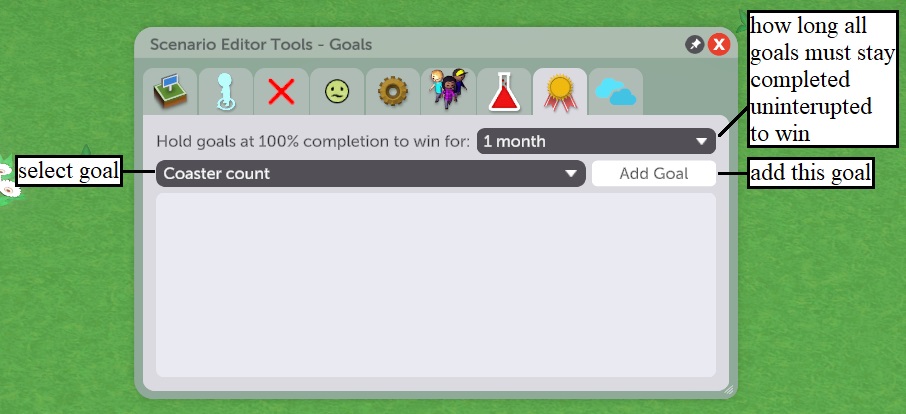
Scenario goals are added individually by selecting a goal (deco rating, no loan debts, etc.), then clicking the 'Add Goal' button. You can also set how long all the goals must be held simultaneously at completion to win (this only applies to non-optional goals).

Once a goal is added most can be further customized.
Making a goal optional means that you can win the scenario without completing that goal. Optional goals are meant to be an additional challenge, or you can add rewards for completing them to incentivize players.
Climate
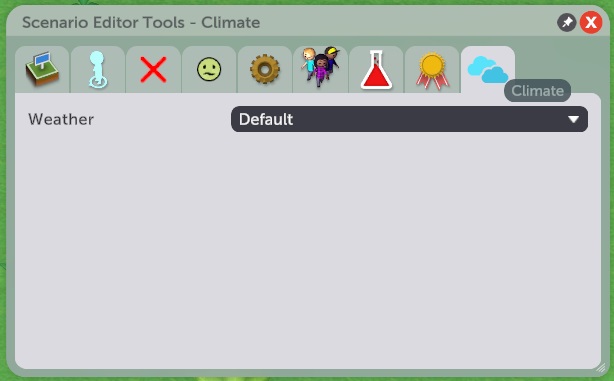
This sub-tab allows you to set the climate of this park (rains a lot, hot most of the year, etc.). It has a single drop-down list which allows you to choose from three preset climates (default, high temperatures, and rainy), or you can choose to use custom weather (see below).
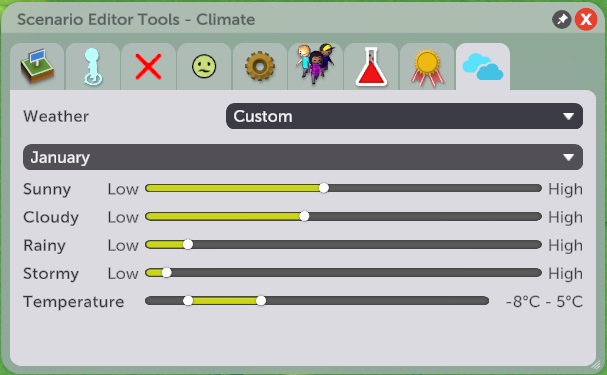
If you choose custom weather, you will be able to customize the weather for each month of the year.
- slide right to increase frequency of sunny weather in this month
Cloudy
- slide right to increase frequency of cloudy weather in this month
Rainy
- slide right to increase frequency of rainy weather in this month
Stormy
- slide right to increase frequency of thunderstorms in this month
Temperature
- set the range within which the temperature will always be during this month
- in the picture the temperature range is -8° to 5° for the month of January
I hope you enjoy the Guide we share about Parkitect – The Ultimate Guide in-game UI; if you think we forget to add or we should add more information, please let us know via commenting below! See you soon!
Can Mine Train Roller Coasters Be High Intensity Parkitect
Source: https://steamlists.com/parkitect-the-ultimate-guide-in-game-ui/
Belum ada Komentar untuk "Can Mine Train Roller Coasters Be High Intensity Parkitect"
Posting Komentar